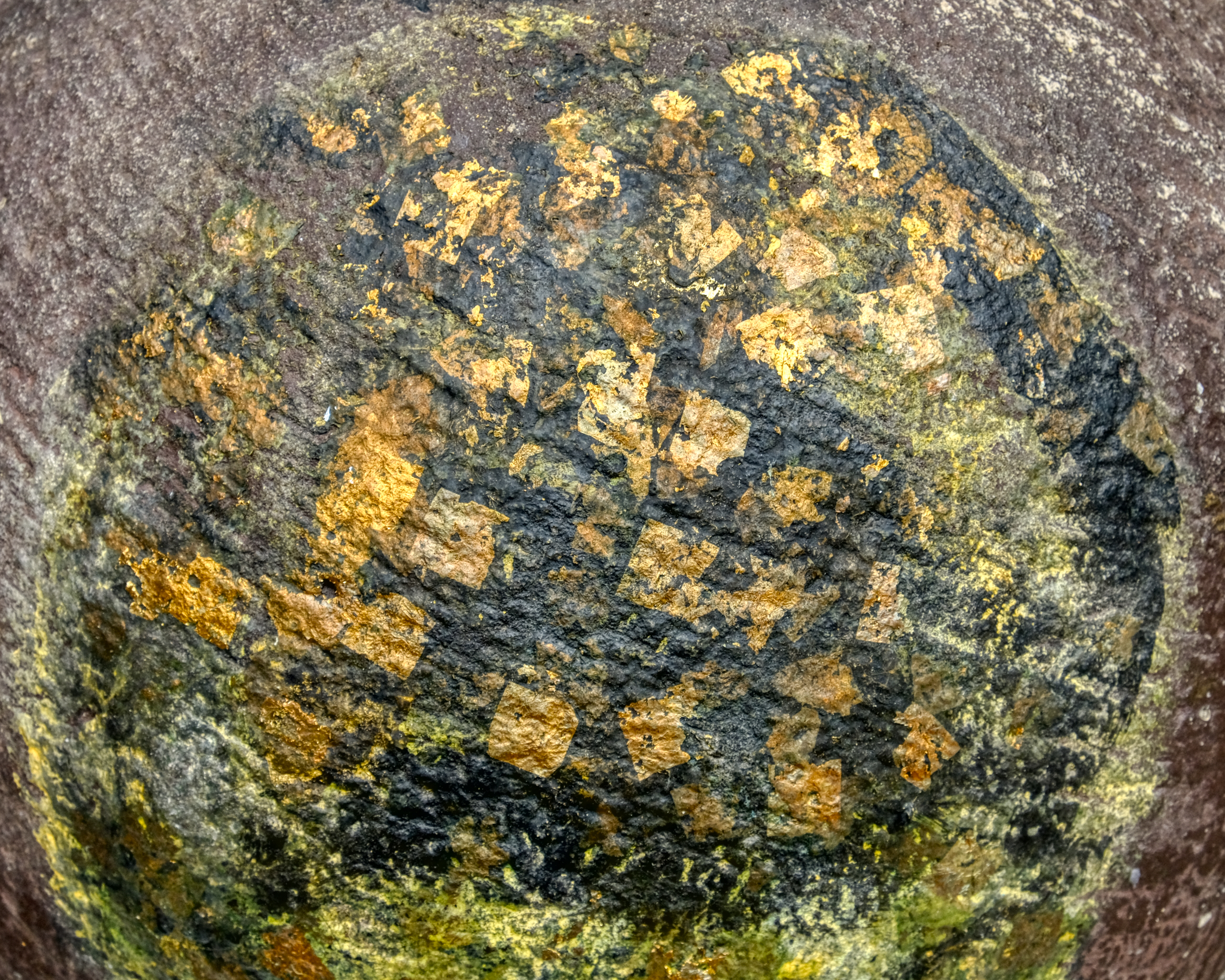My most current blog entry:
Entries in Thailand (82)
Loei, Chiang Khan, and the Mekong River
 Wednesday, October 26, 2022 at 12:57PM
Wednesday, October 26, 2022 at 12:57PM 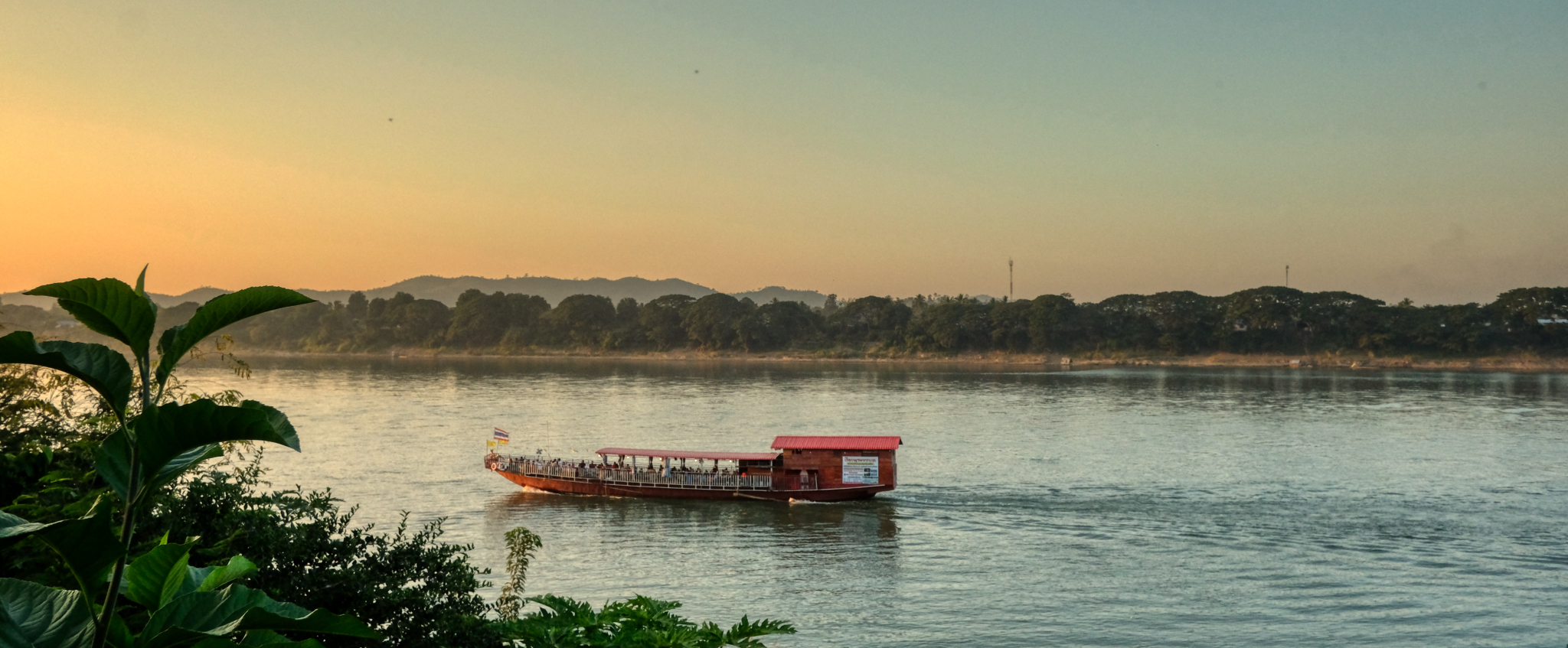
Back in December 2020, just as COVID 19 was bursting on the international scene and choking Thailand's tourist industry, the Thai government came up with a brilliant scheme to give vouchers to Thai residents for discounts at Thai resorts and restaurants in 'tourist areas' to spur more 'in country' tourism by Thais. It worked . . . we took a road trip north to Loei, Chiang Khan, and the Mekong River.
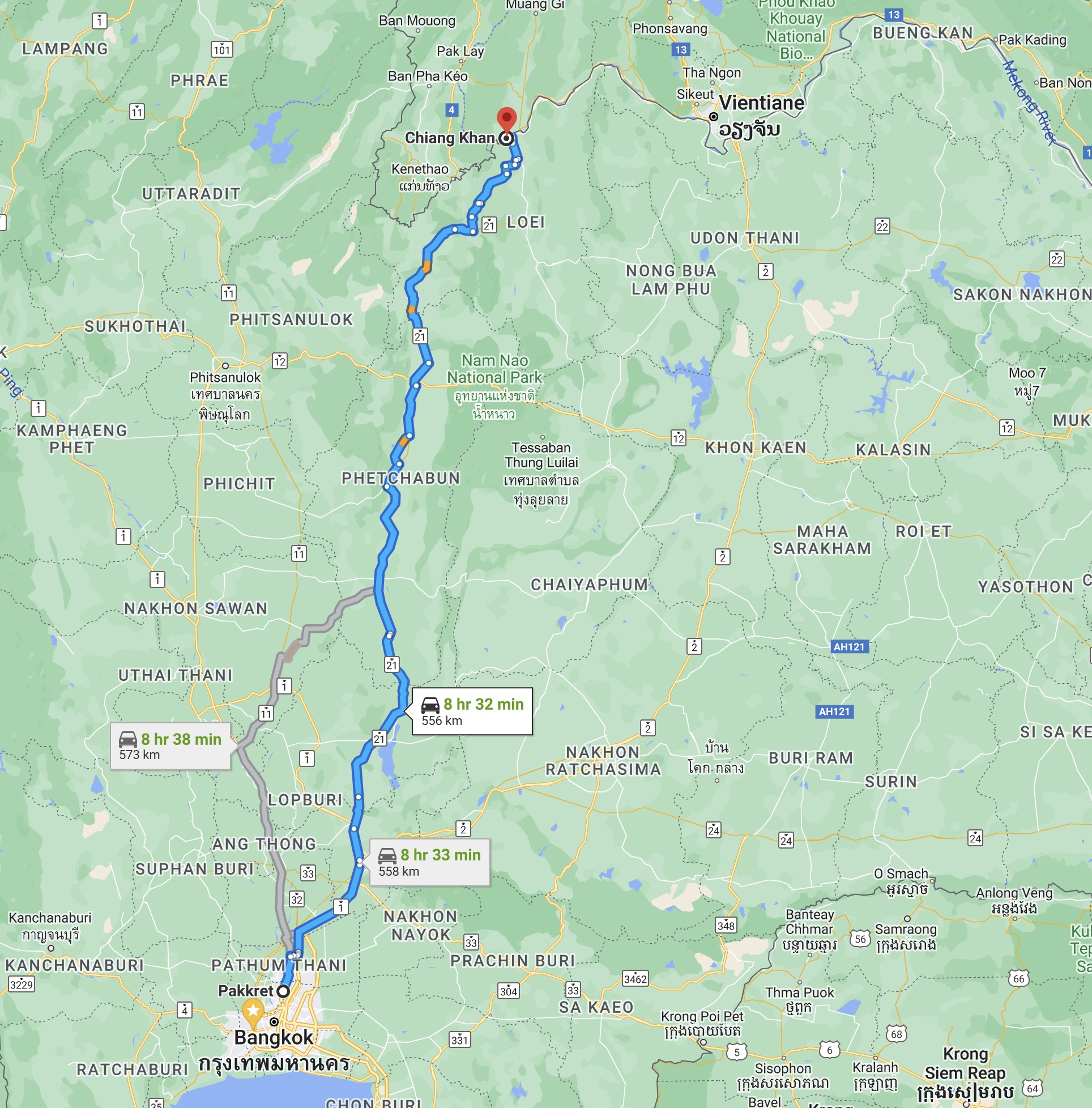 Our route had us drive straight through to Loei from our home in a northern suburb of Bangkok.
Our route had us drive straight through to Loei from our home in a northern suburb of Bangkok.
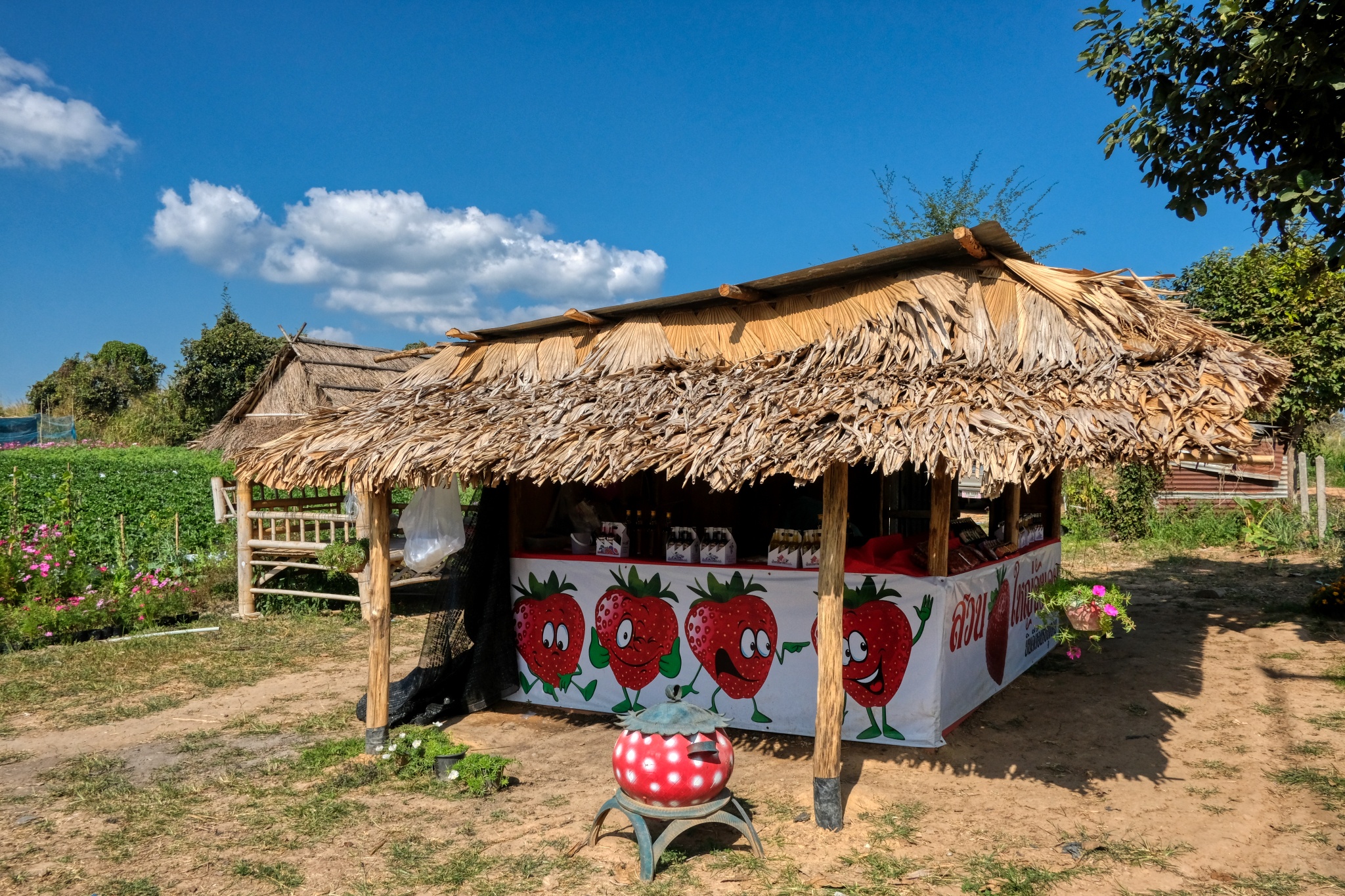 The majority of the drive north to Loei was on modern, divided expressway. However, as we neared Loei the road reverted to a 2-lane country road. We were lured into this strawberry stand with the promise of delicious fruit.
The majority of the drive north to Loei was on modern, divided expressway. However, as we neared Loei the road reverted to a 2-lane country road. We were lured into this strawberry stand with the promise of delicious fruit.
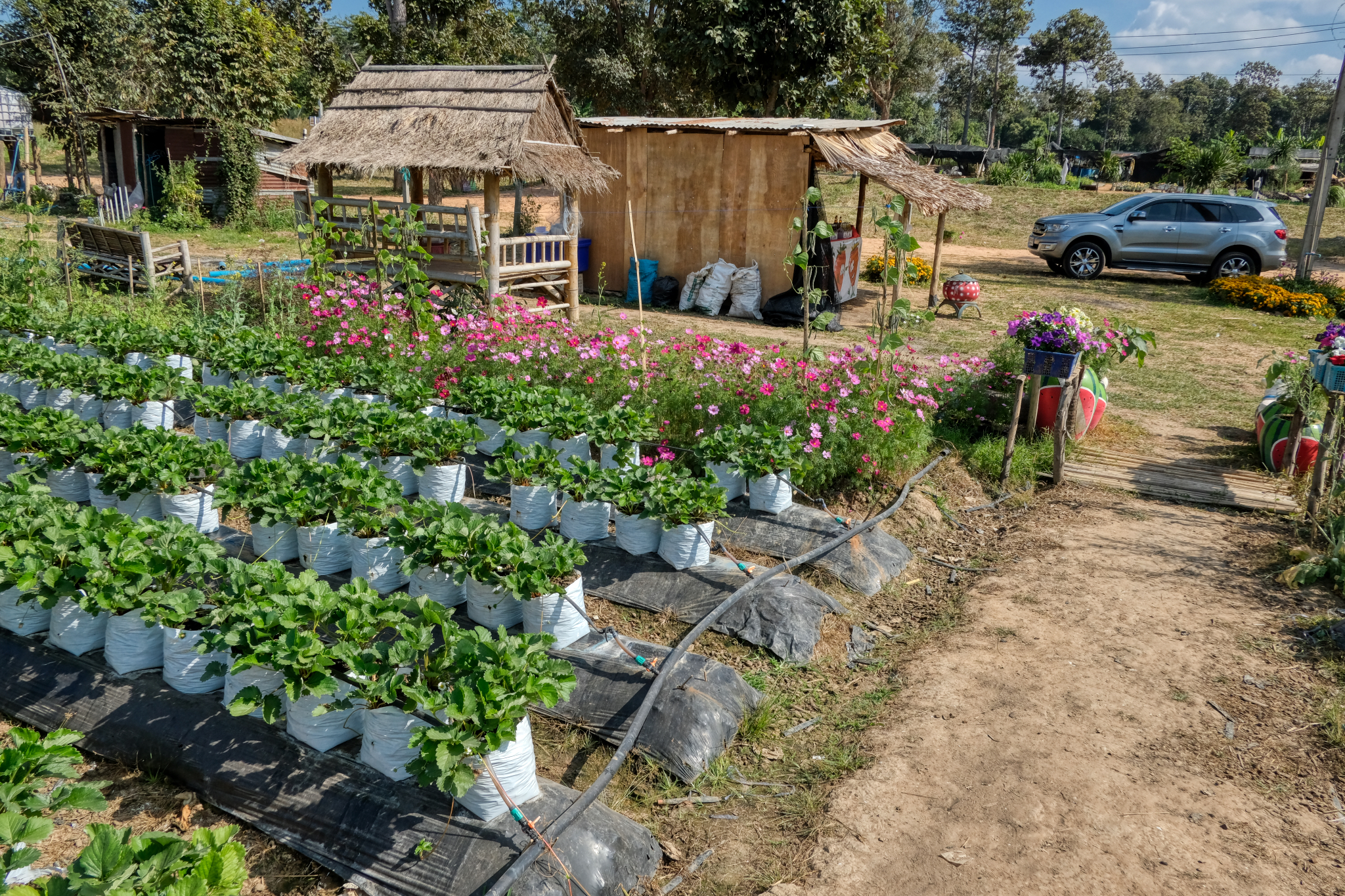 They were growing their own strawberries here . . . but they were asking a very high price for them. We declined to purchase any strawberries here.
They were growing their own strawberries here . . . but they were asking a very high price for them. We declined to purchase any strawberries here.
________________________________
LOEI
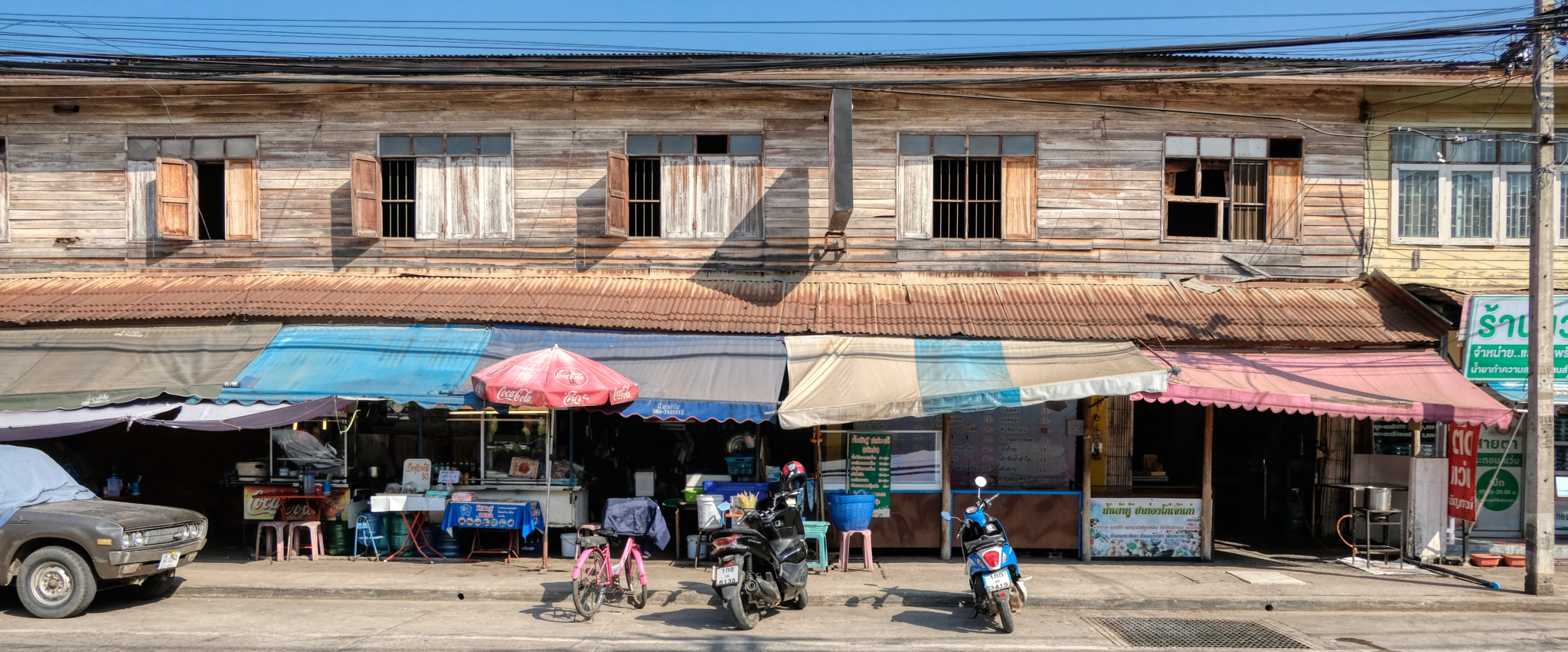 This is the old Loei I came to see . . .
This is the old Loei I came to see . . .
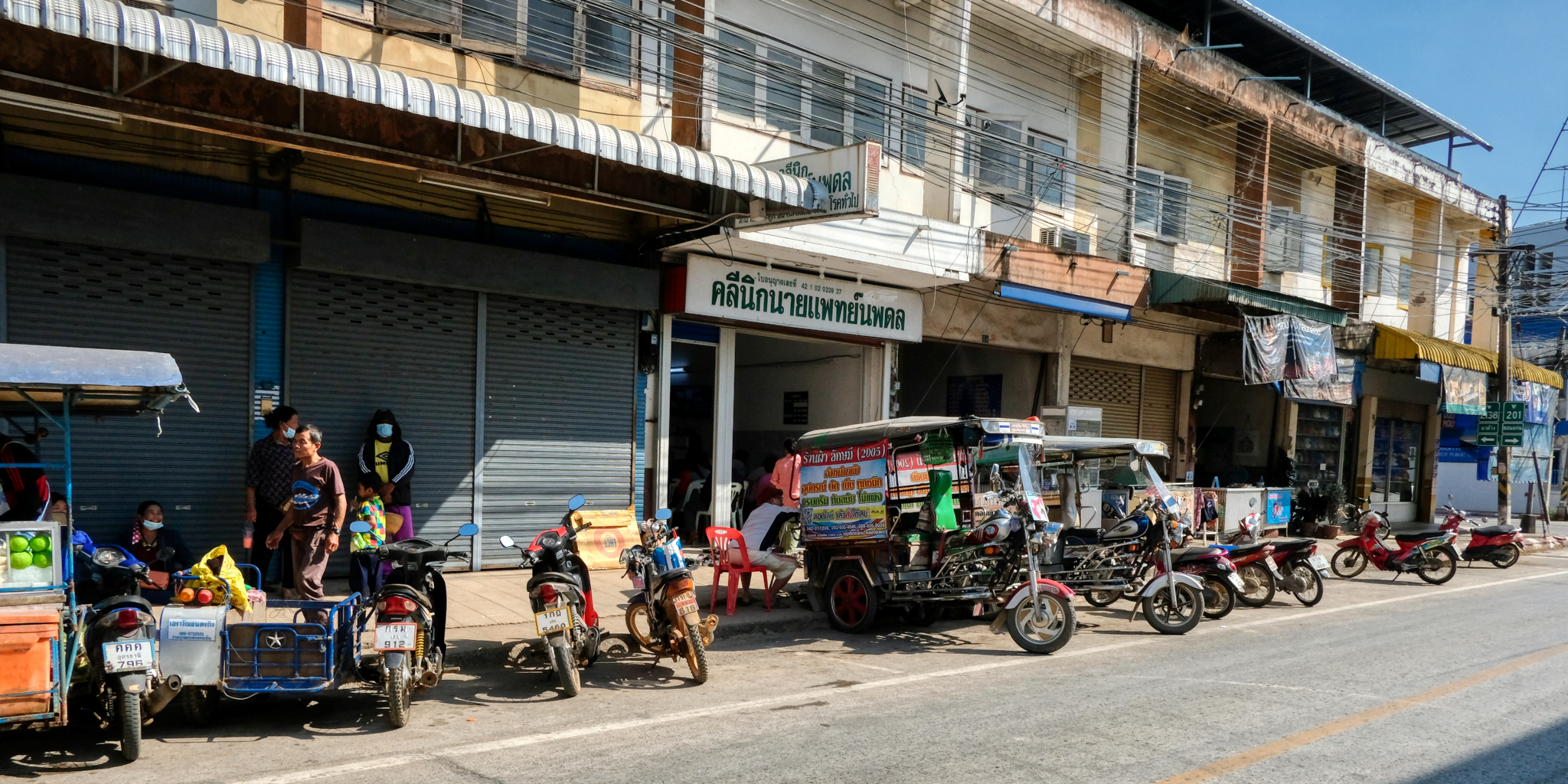 Loei is a provincial market town in the north of Thailand. It is still "old Thailand" in Loei. I last visited here about 20 years ago . . . and yes, it has changed a great deal.
Loei is a provincial market town in the north of Thailand. It is still "old Thailand" in Loei. I last visited here about 20 years ago . . . and yes, it has changed a great deal.
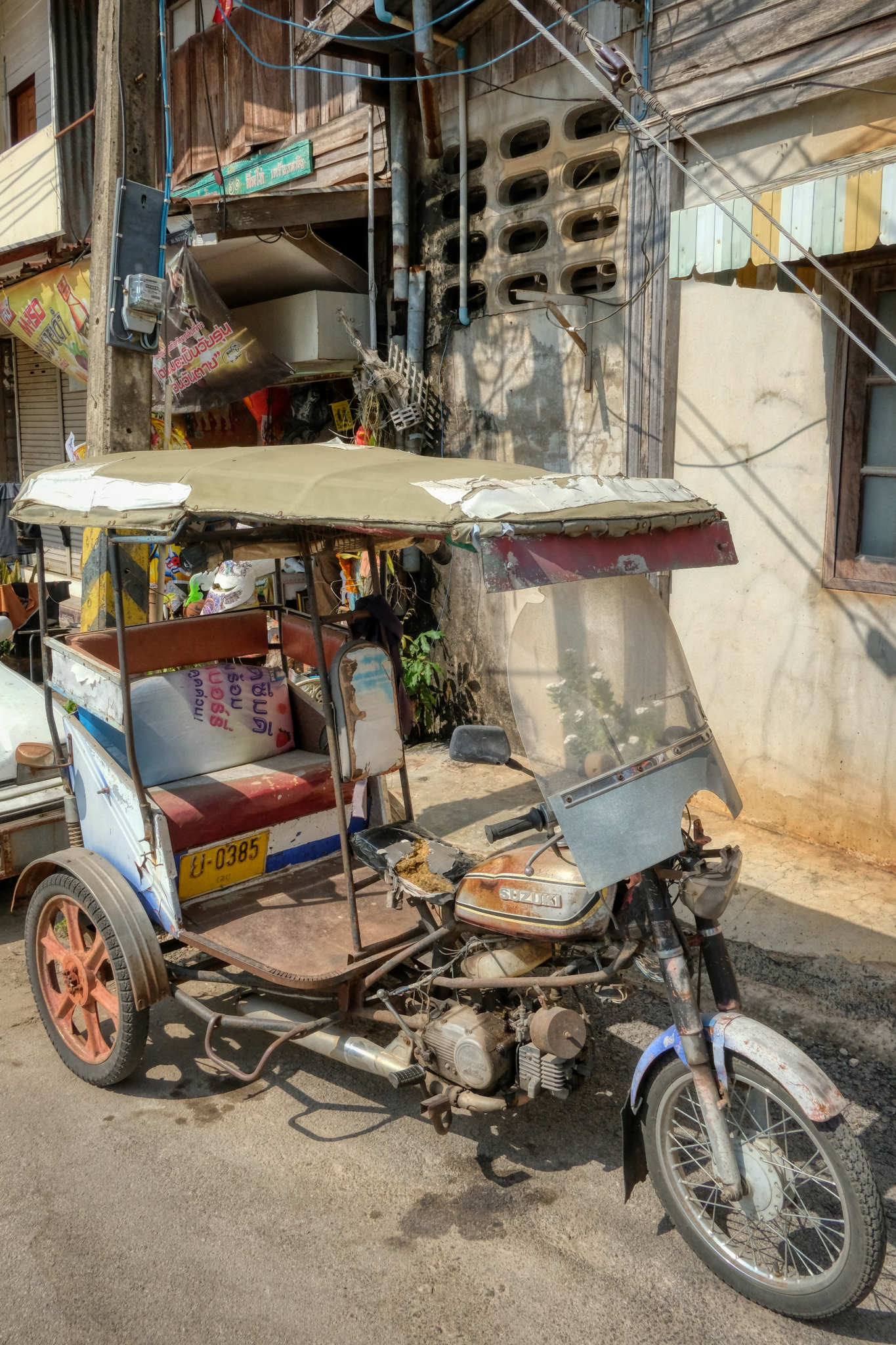 But there is still a lot of the old Thailand I know and love in Loei.
But there is still a lot of the old Thailand I know and love in Loei.
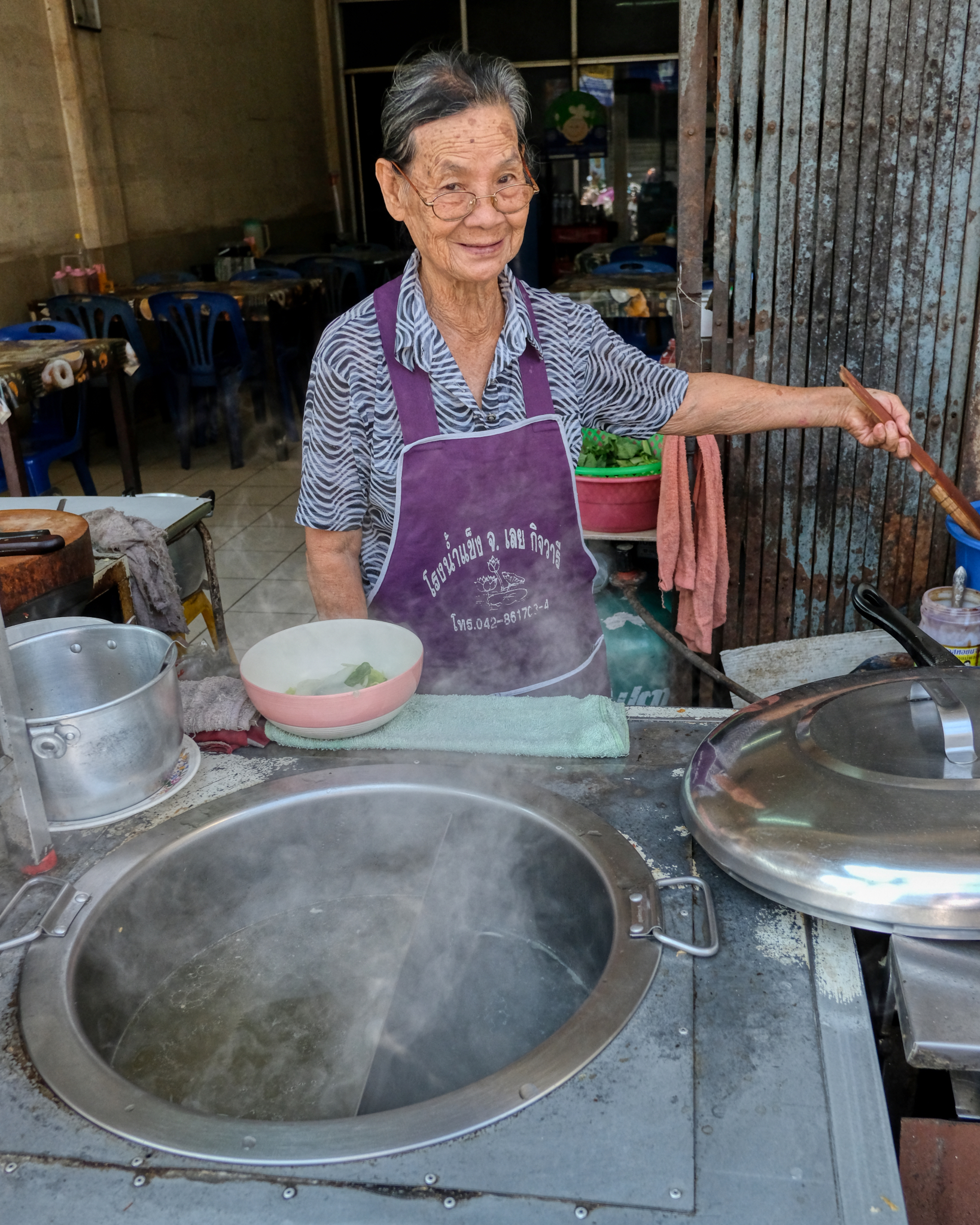 The street food in Loei is excellent . . . and the people friendly.
The street food in Loei is excellent . . . and the people friendly.
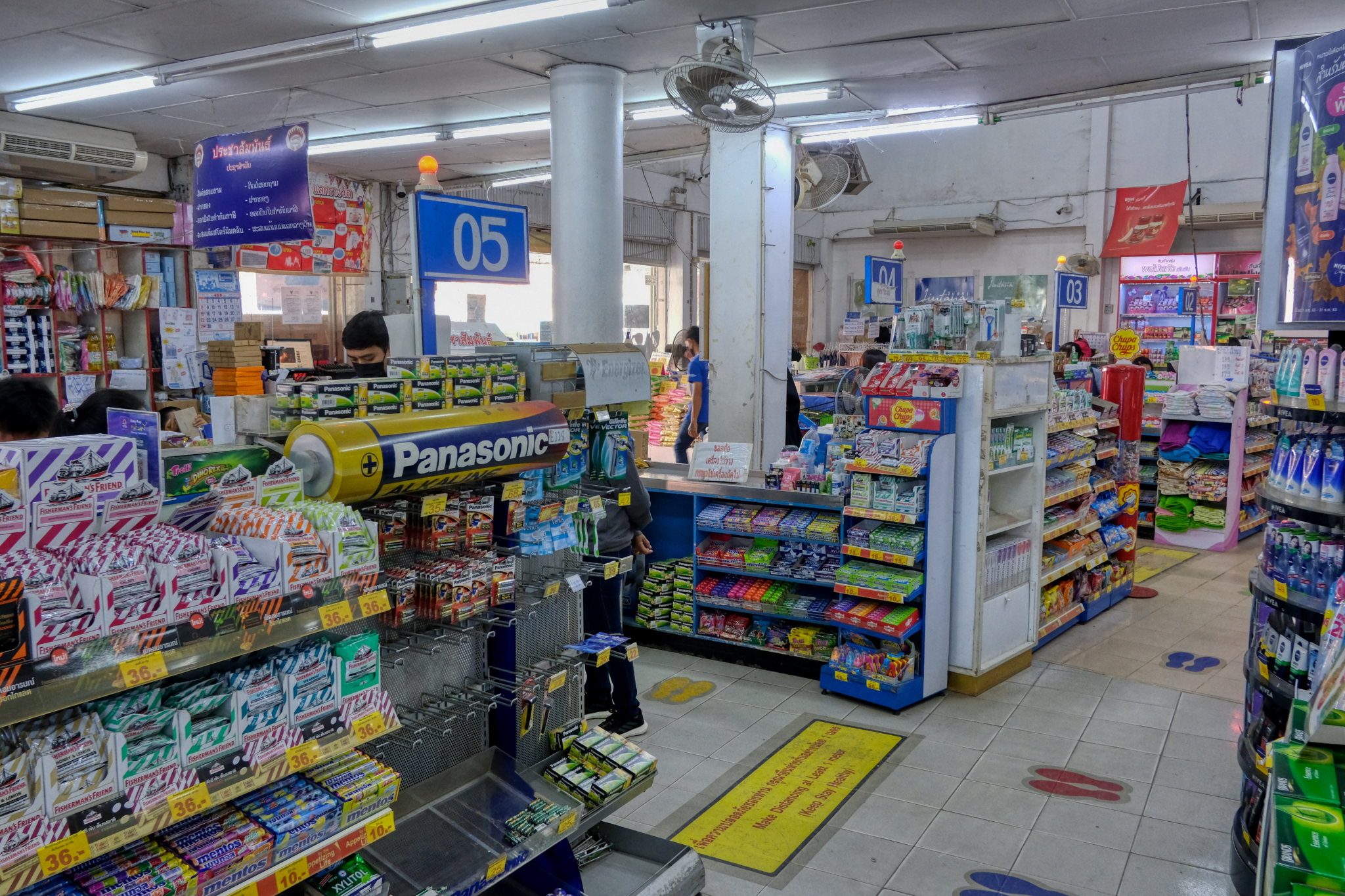 The old downtown of Loei still has locally-owned department stores and "supermarkets" like this one.
The old downtown of Loei still has locally-owned department stores and "supermarkets" like this one.
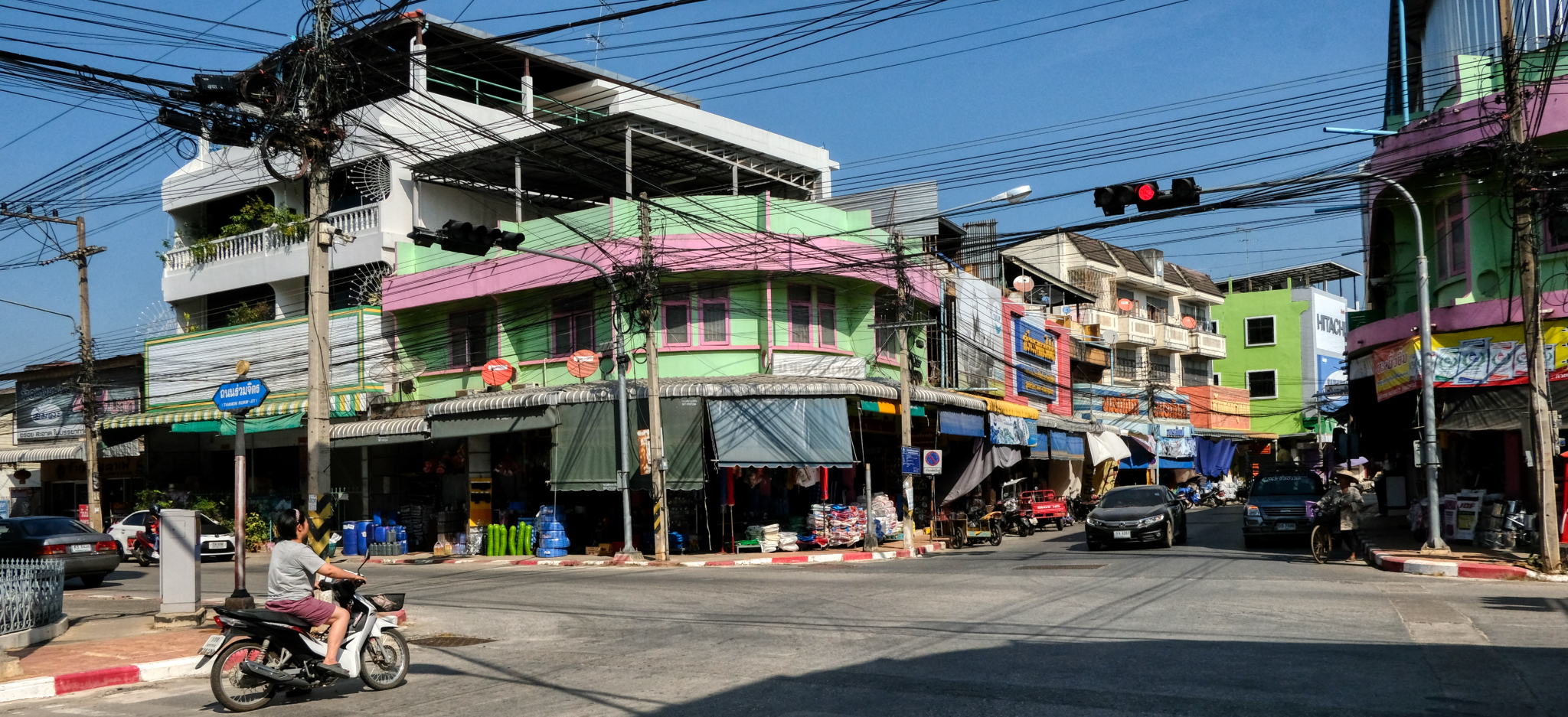 A street corner in downtown Loei. I love snooping around in these old Thai market towns.
A street corner in downtown Loei. I love snooping around in these old Thai market towns.
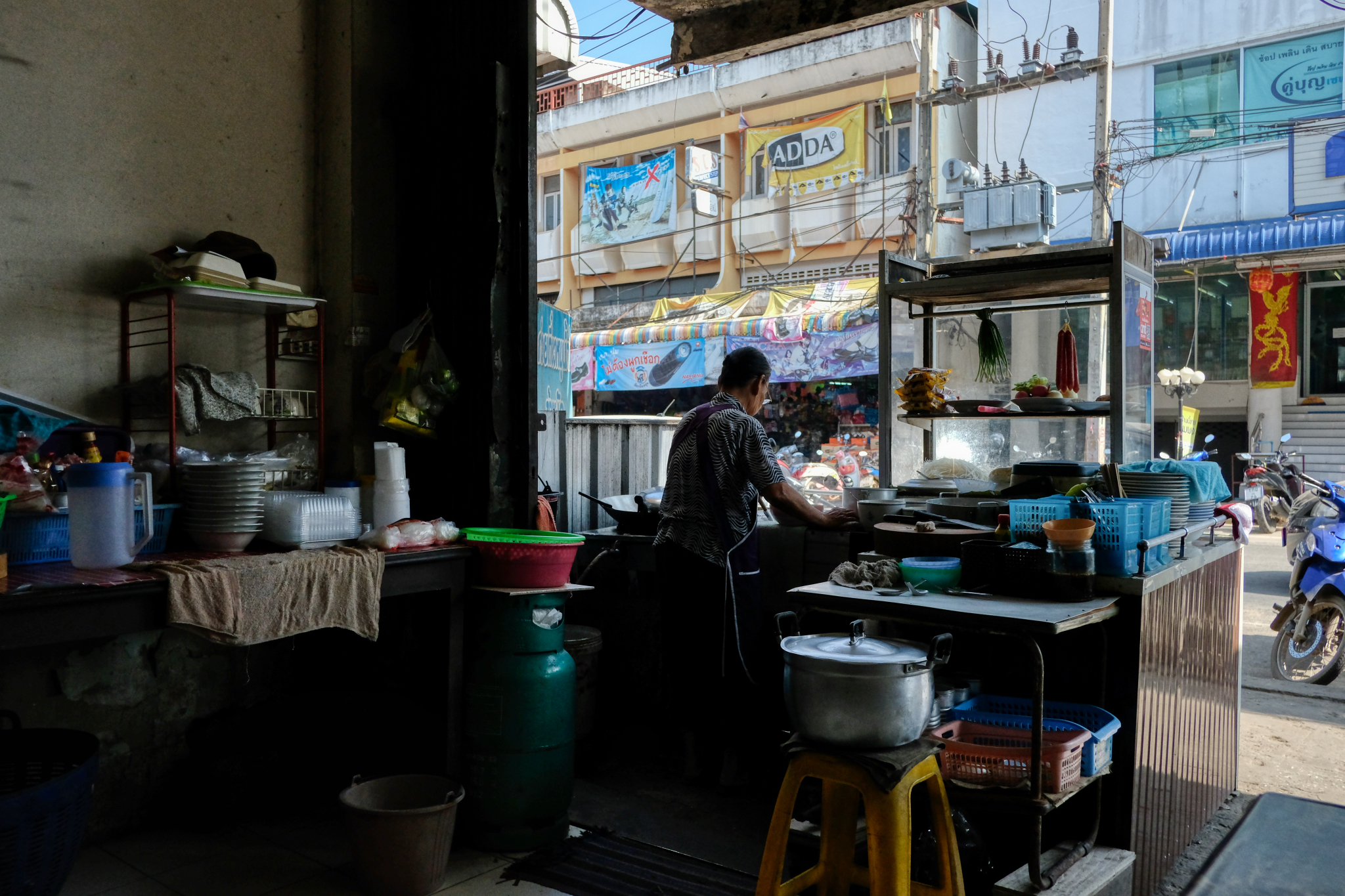 We stopped in this hole-in-the-wall restaurant for delicious noodle soup.
We stopped in this hole-in-the-wall restaurant for delicious noodle soup.
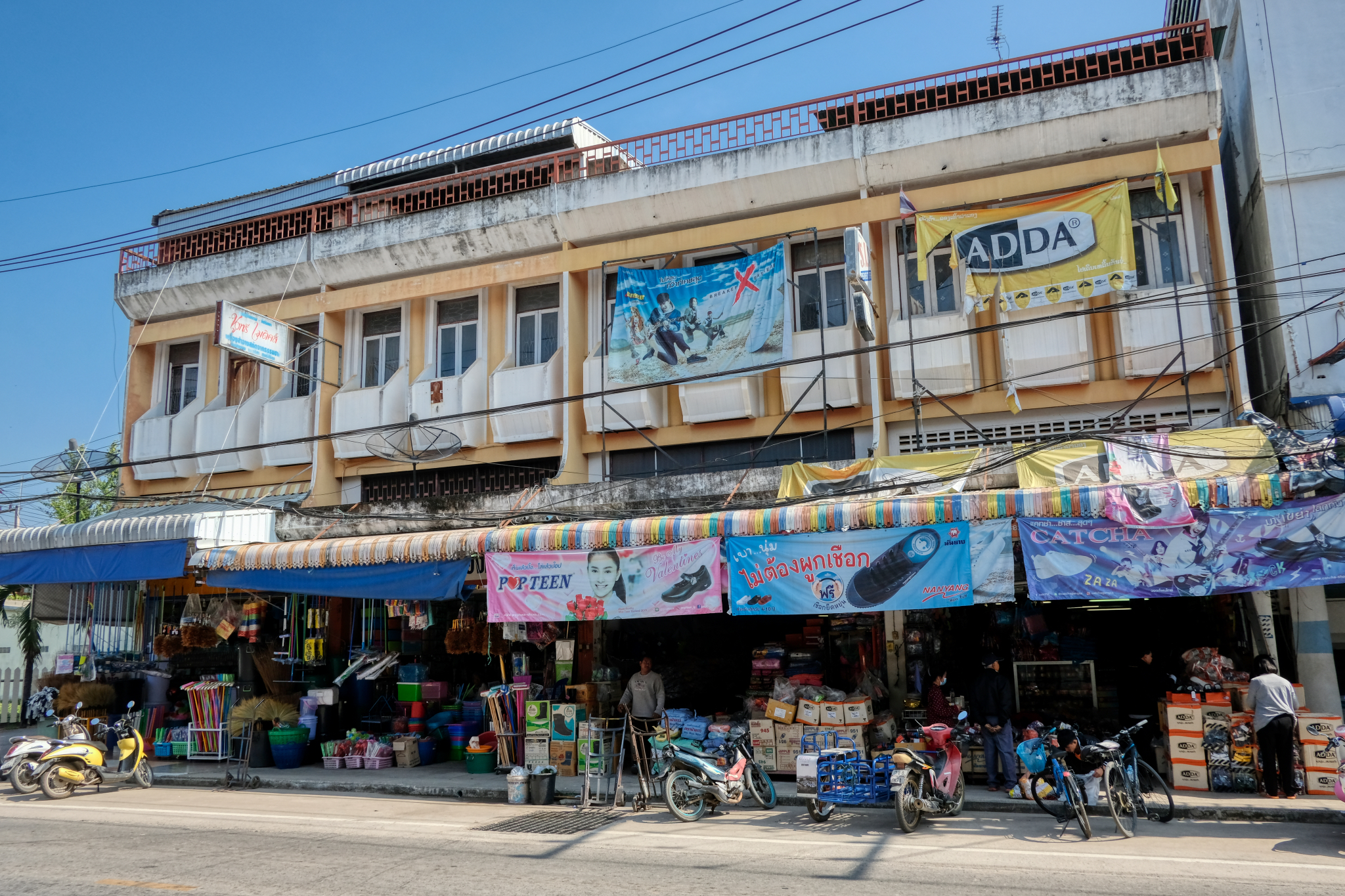 A busy market town serving a large agricultural community.
A busy market town serving a large agricultural community.
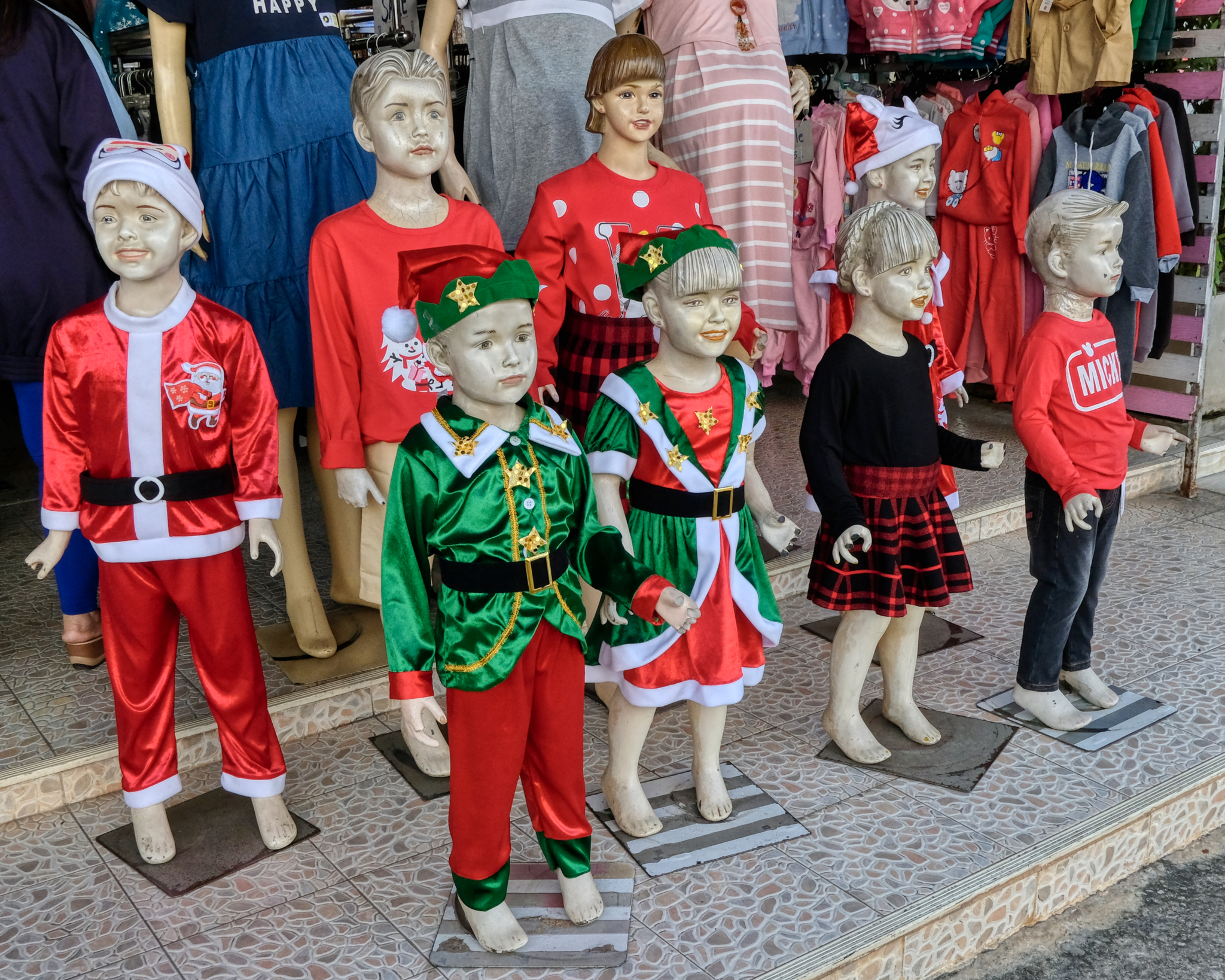 The things you see in Thailand! Yes, it was Christmas season even in Loei, Thailand. They celebrate everything here!
The things you see in Thailand! Yes, it was Christmas season even in Loei, Thailand. They celebrate everything here!
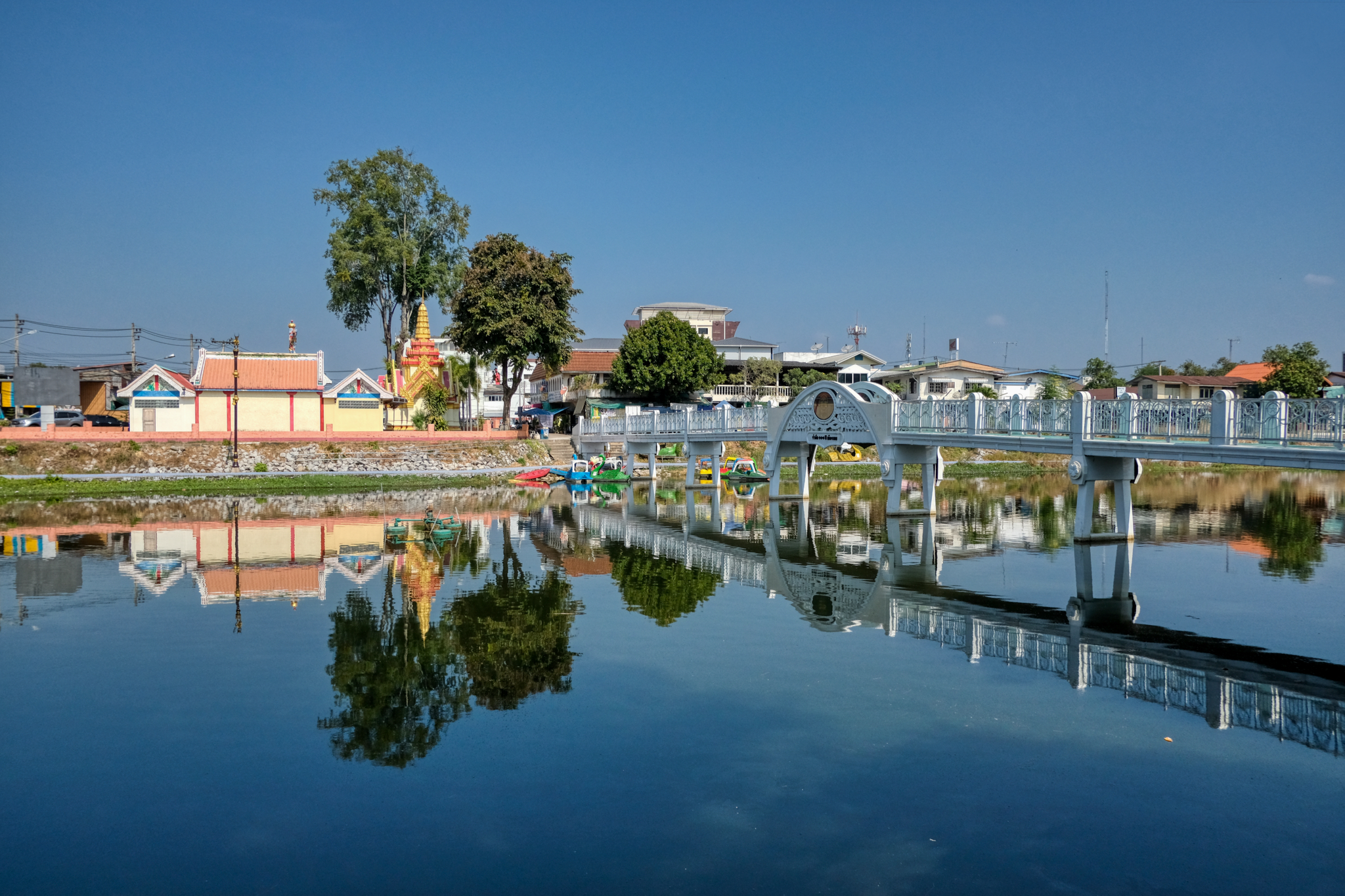 We walked through the downtown and found the banks of the Loei River. The bridge led to a beautiful city park.
We walked through the downtown and found the banks of the Loei River. The bridge led to a beautiful city park.
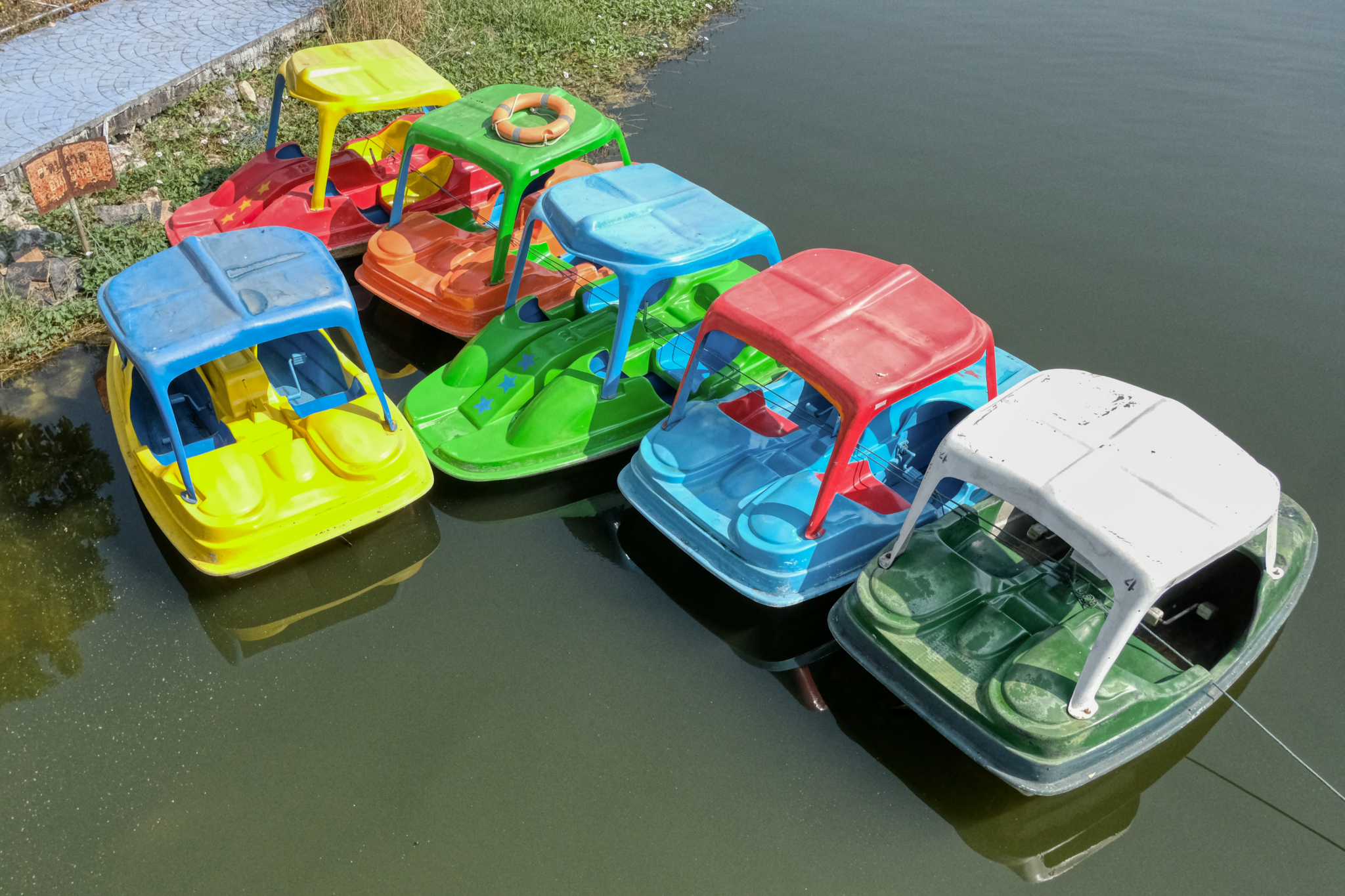 There was fun to be had in Loei.
There was fun to be had in Loei.
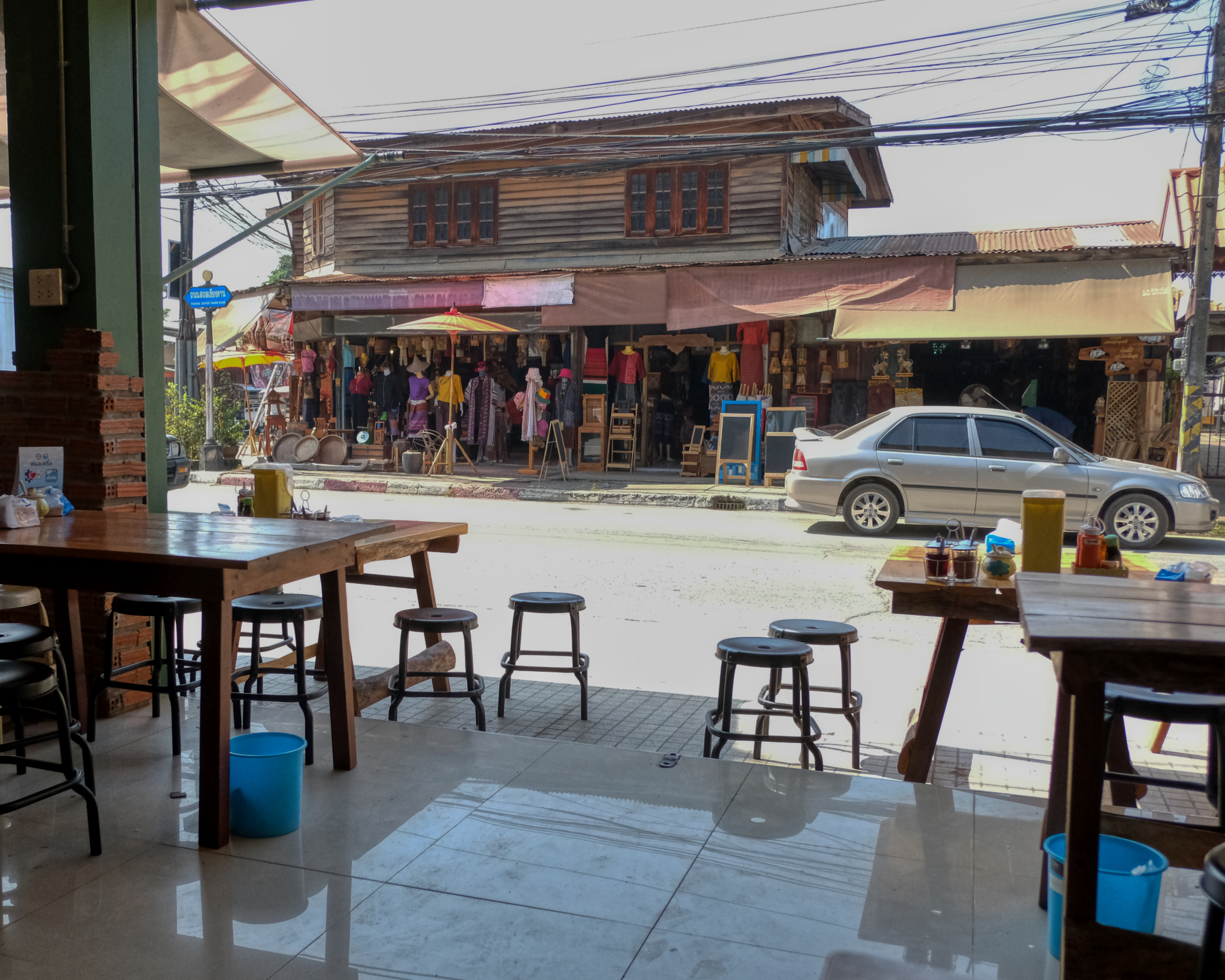 I sat across the street in a hipster coffee shop while my wife shopped in a fine traditional Thai textile shop across the street.
I sat across the street in a hipster coffee shop while my wife shopped in a fine traditional Thai textile shop across the street.
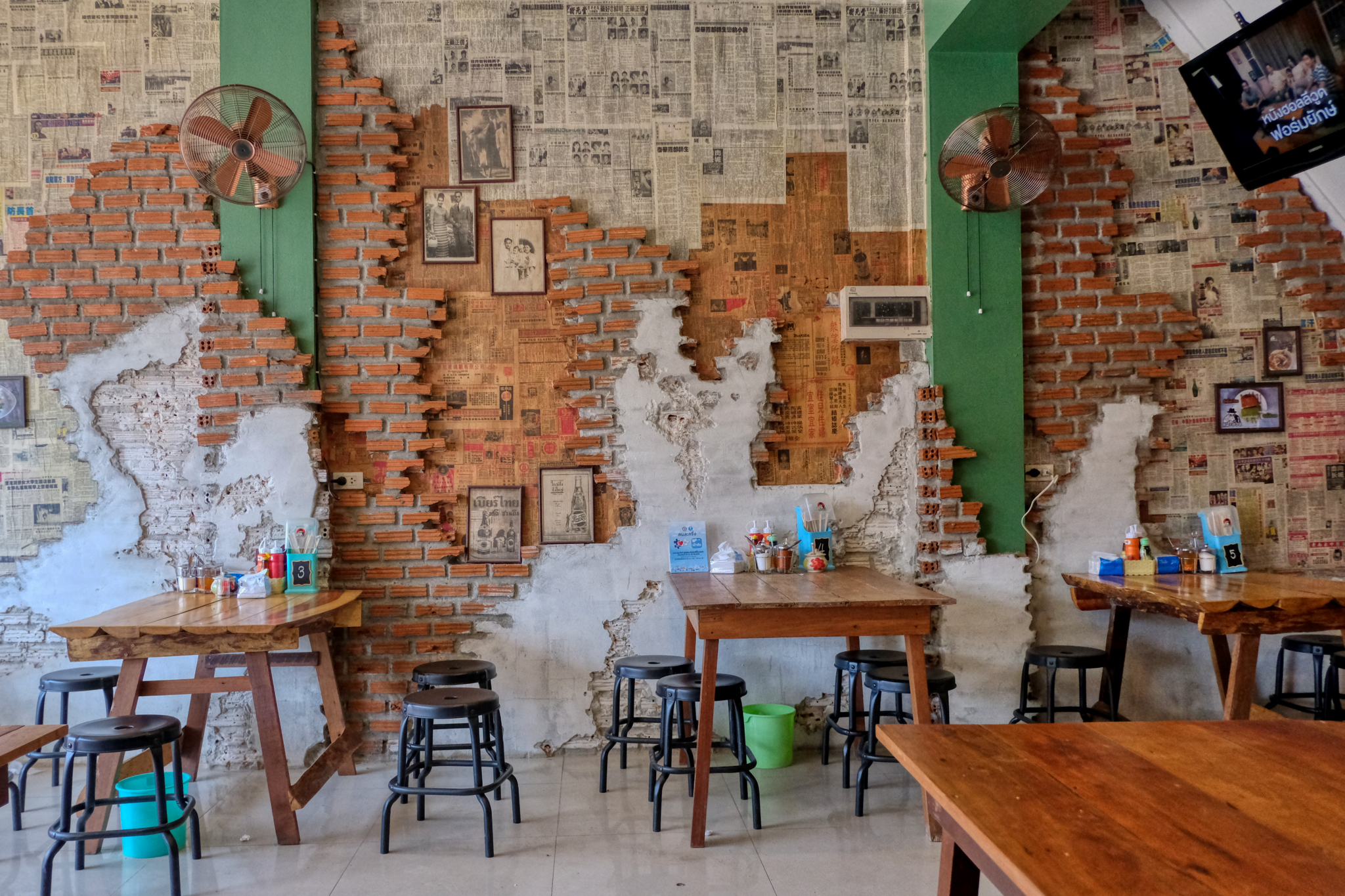 Yes, the hipster cool coffee shop can be found throughout the entire planet . . . even in the remote old market town of Loei.
Yes, the hipster cool coffee shop can be found throughout the entire planet . . . even in the remote old market town of Loei.
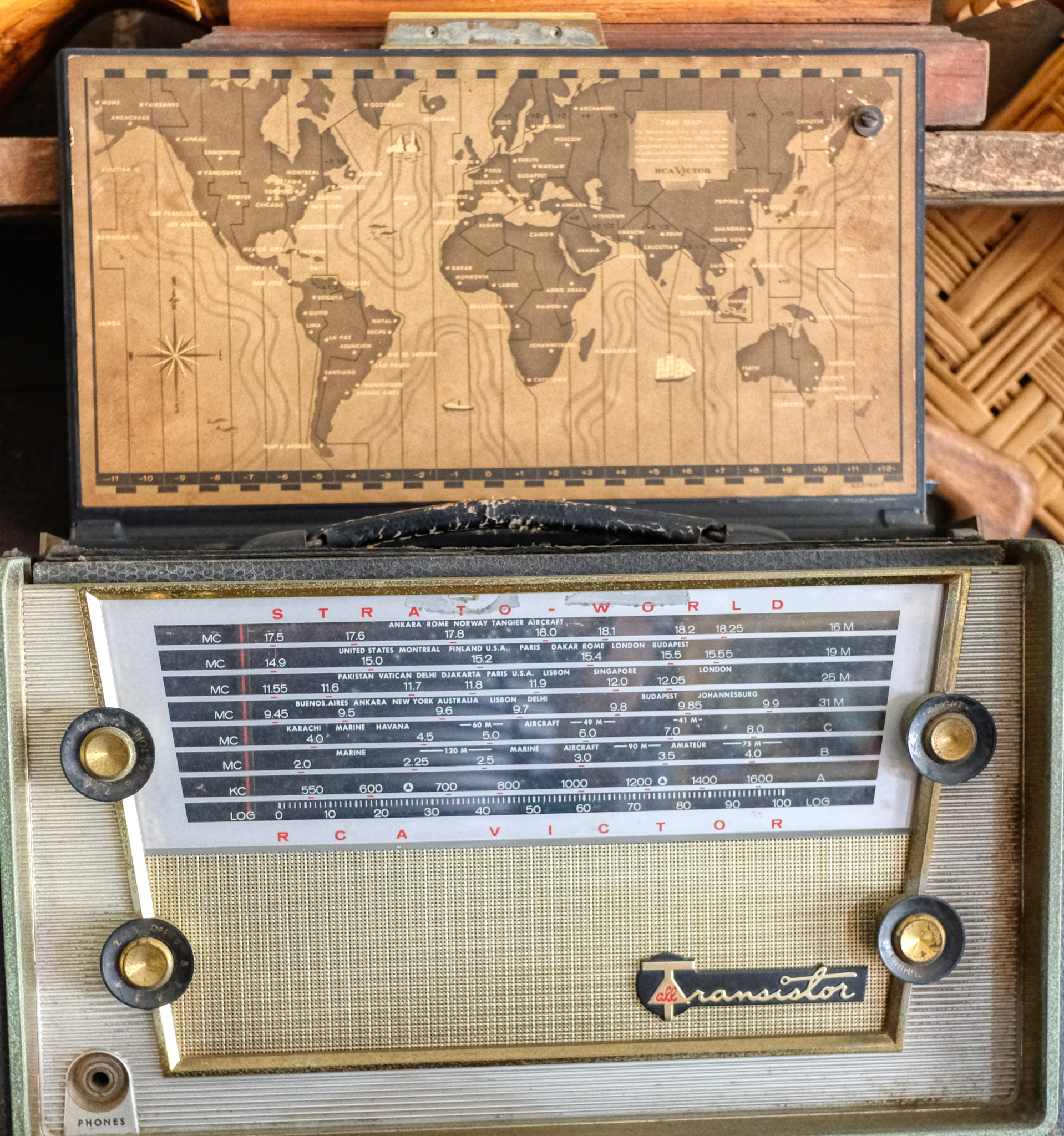 Always interesting old stuff to be found in old Thai village stores.
Always interesting old stuff to be found in old Thai village stores.
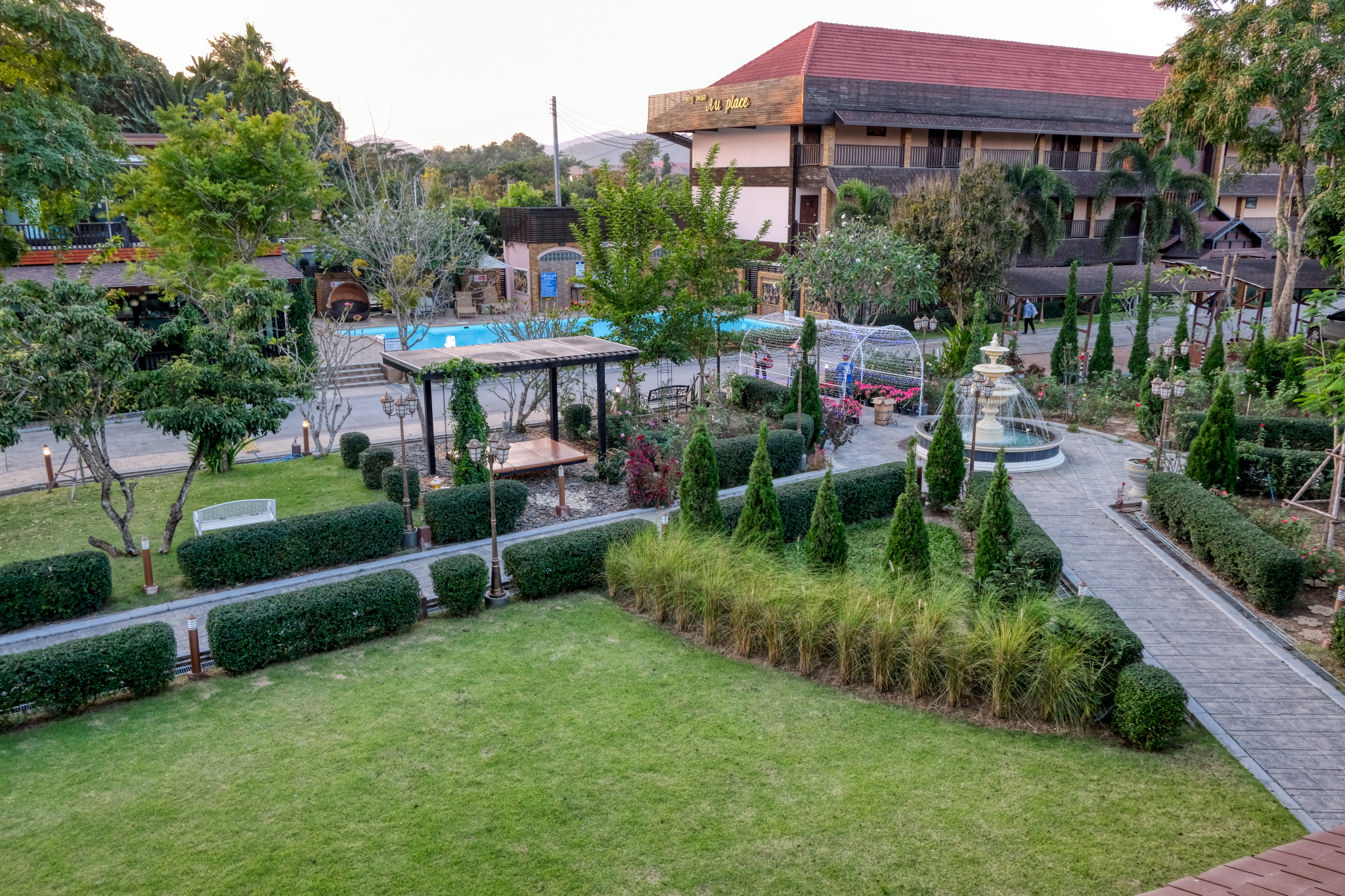 Our very good, and very cheap Au Place Hotel in Loei.
Our very good, and very cheap Au Place Hotel in Loei.
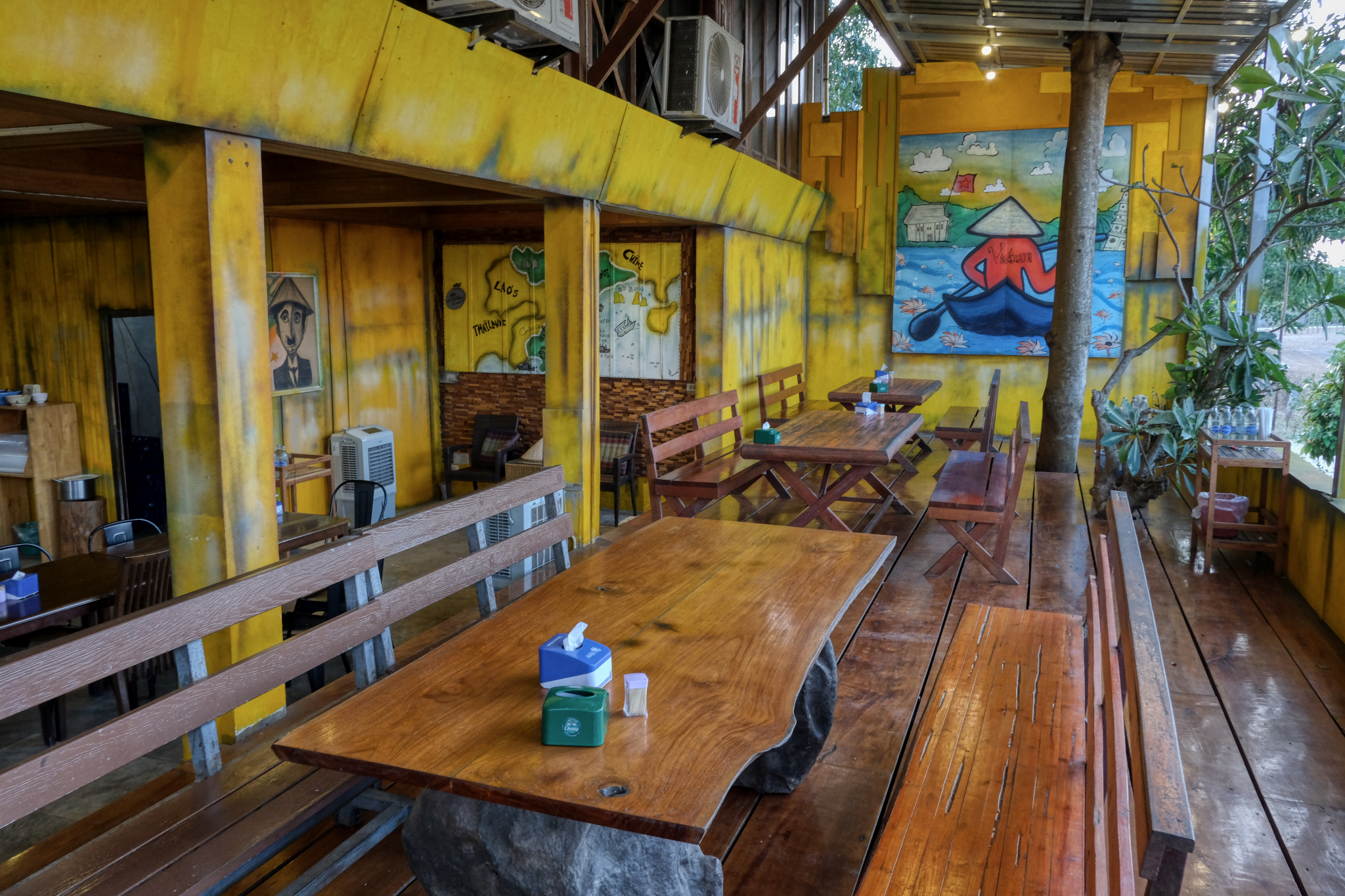 Just a half block away from the hotel on a rural street we found this stylish Vietnamese restaurant.
Just a half block away from the hotel on a rural street we found this stylish Vietnamese restaurant.
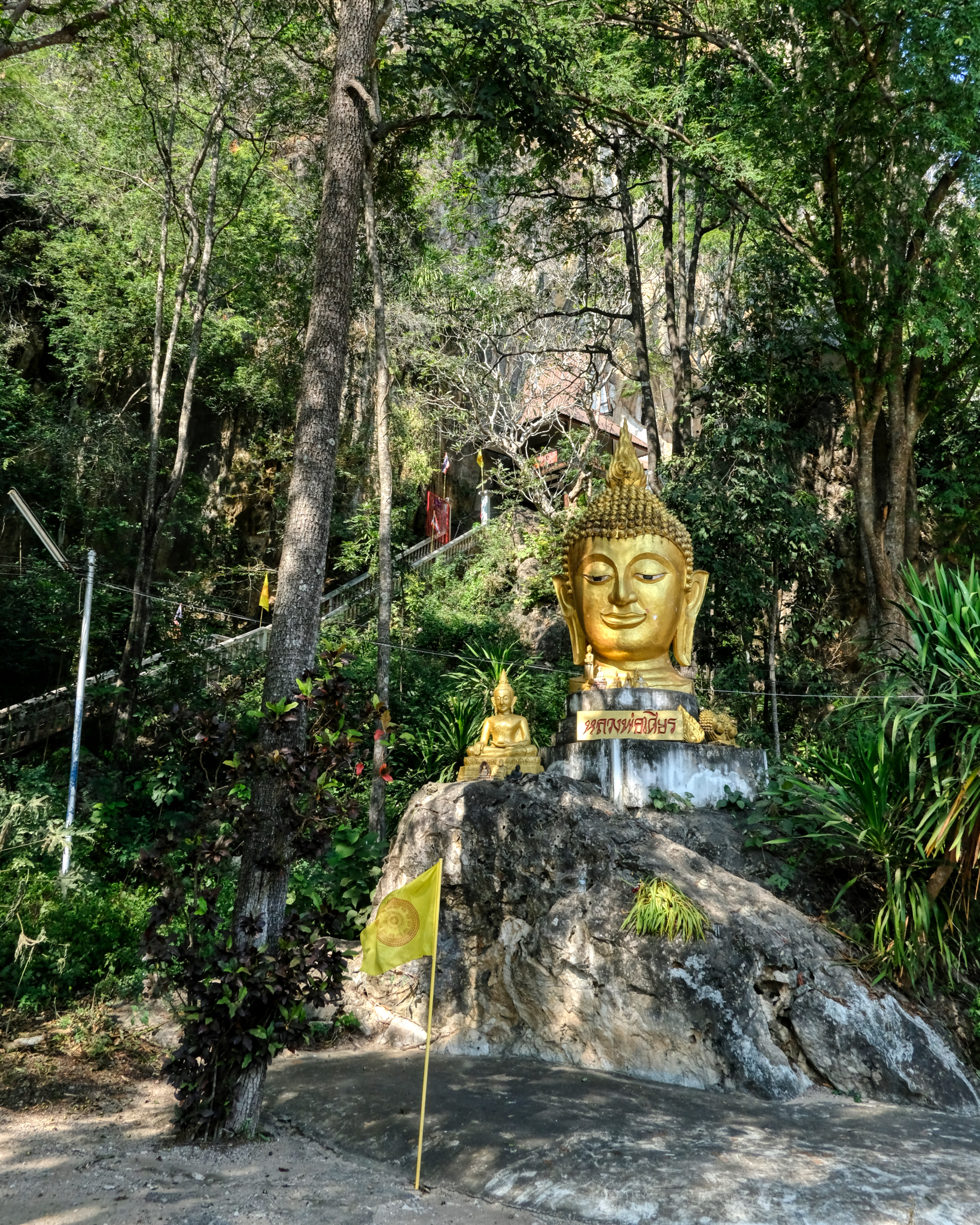 We spent a couple nights in Loei and would venture out into the countryside in search of interesting things to see. We found this amazing Buddhist Temple (Wat).
We spent a couple nights in Loei and would venture out into the countryside in search of interesting things to see. We found this amazing Buddhist Temple (Wat).
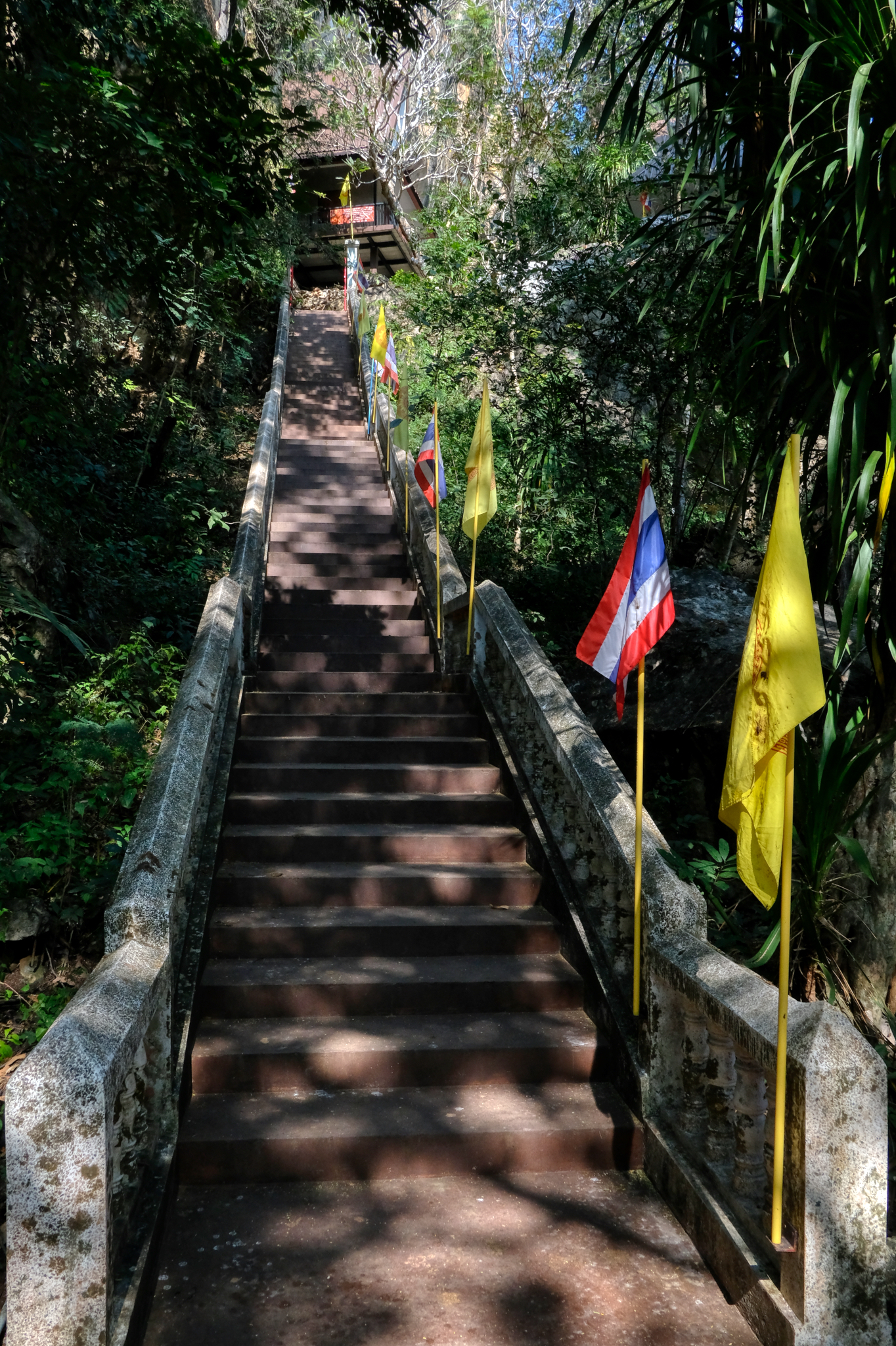 There were caves with Buddhas to explore at this wat.
There were caves with Buddhas to explore at this wat.
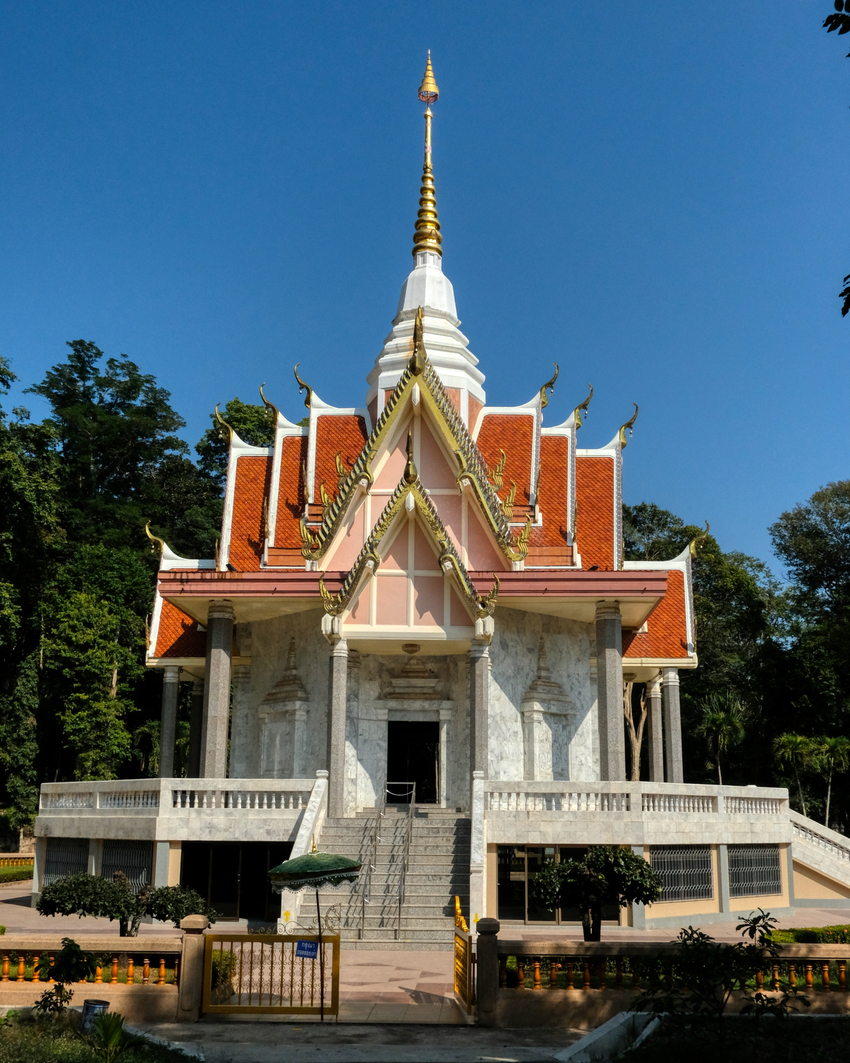 There was this very beautiful marble temple on the wat grounds.
There was this very beautiful marble temple on the wat grounds.
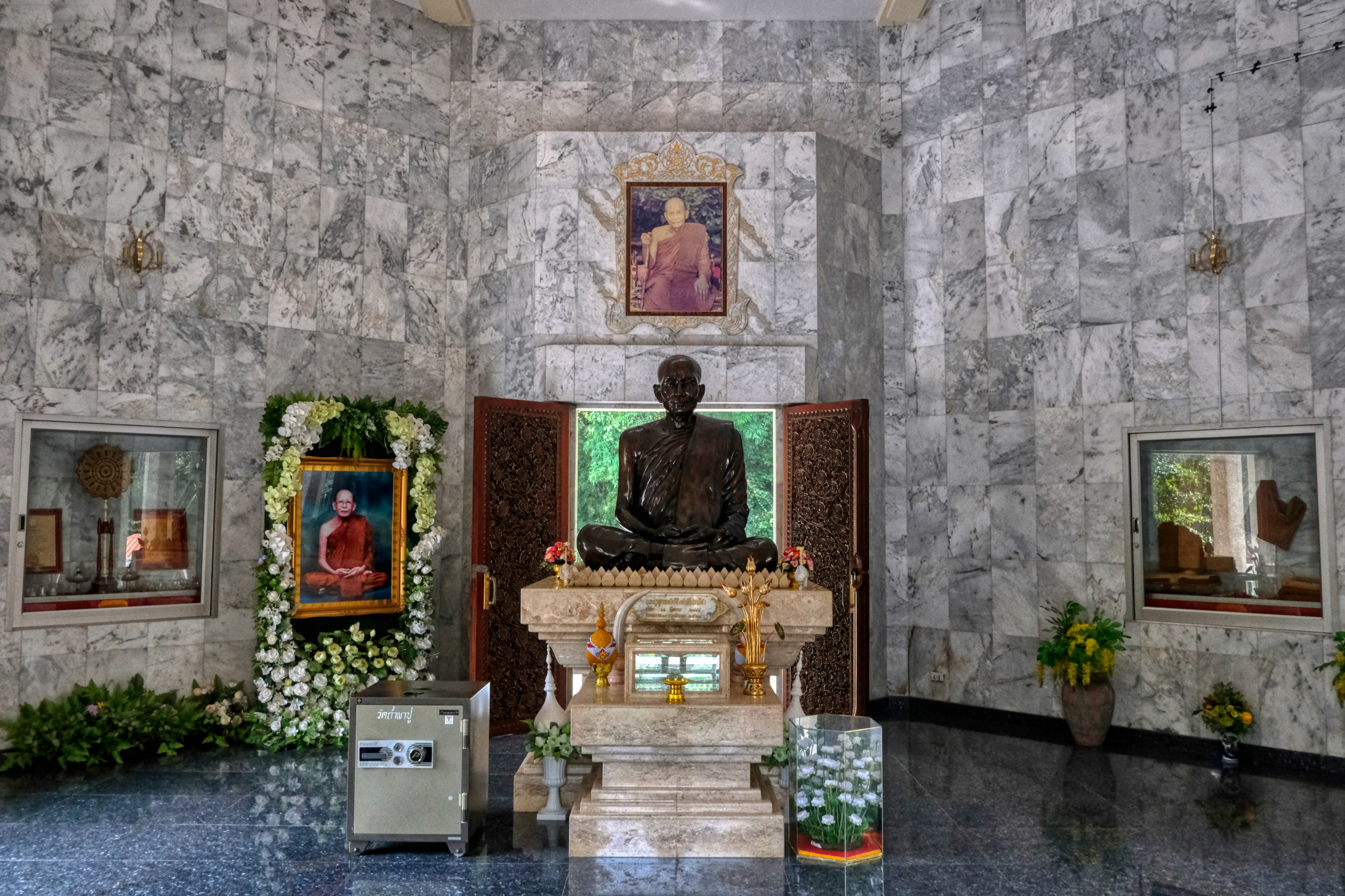 The marble temple was very interesting inside.
The marble temple was very interesting inside.
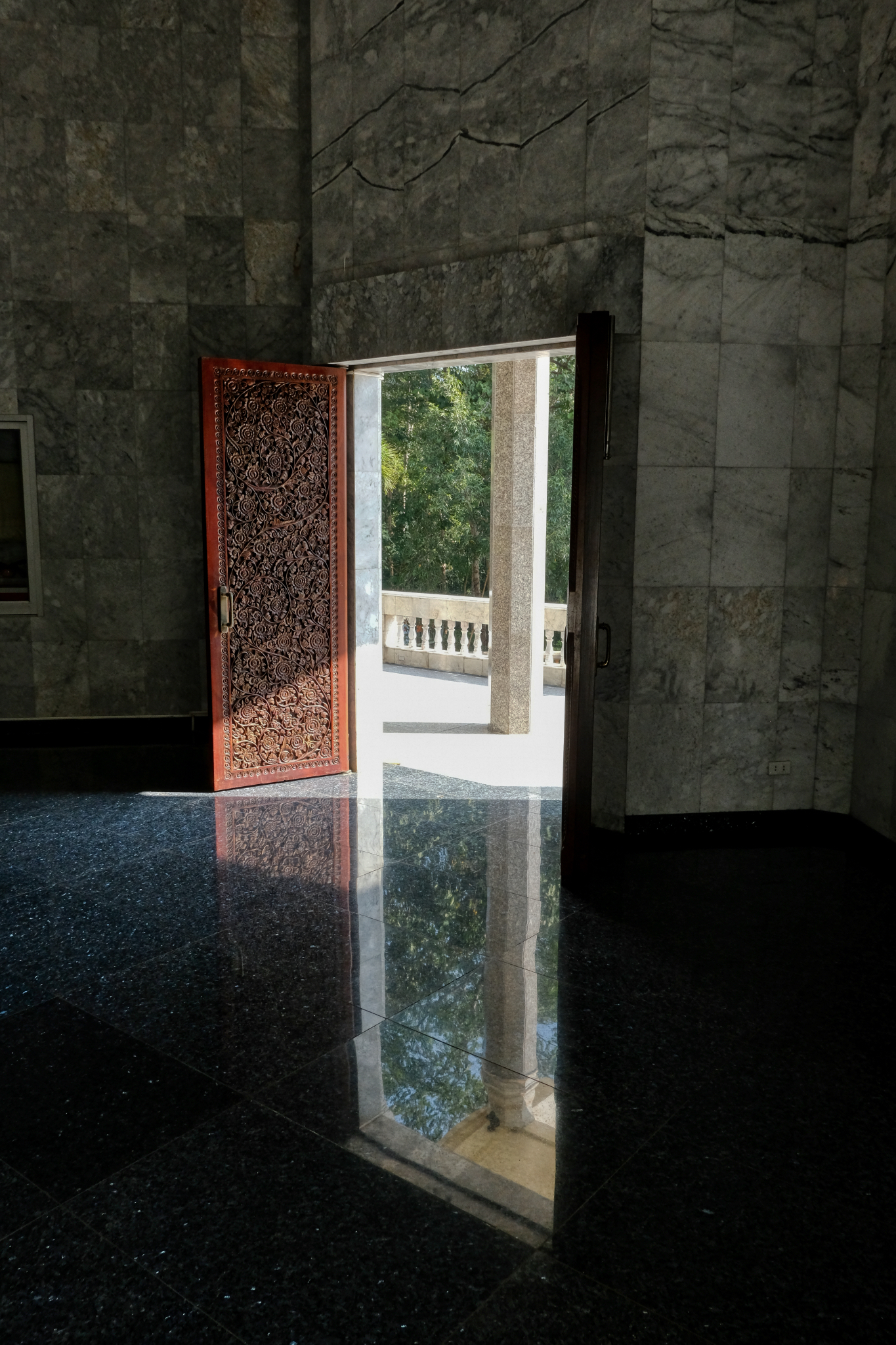 Marvelous light and reflection inside the marble wat.
Marvelous light and reflection inside the marble wat.
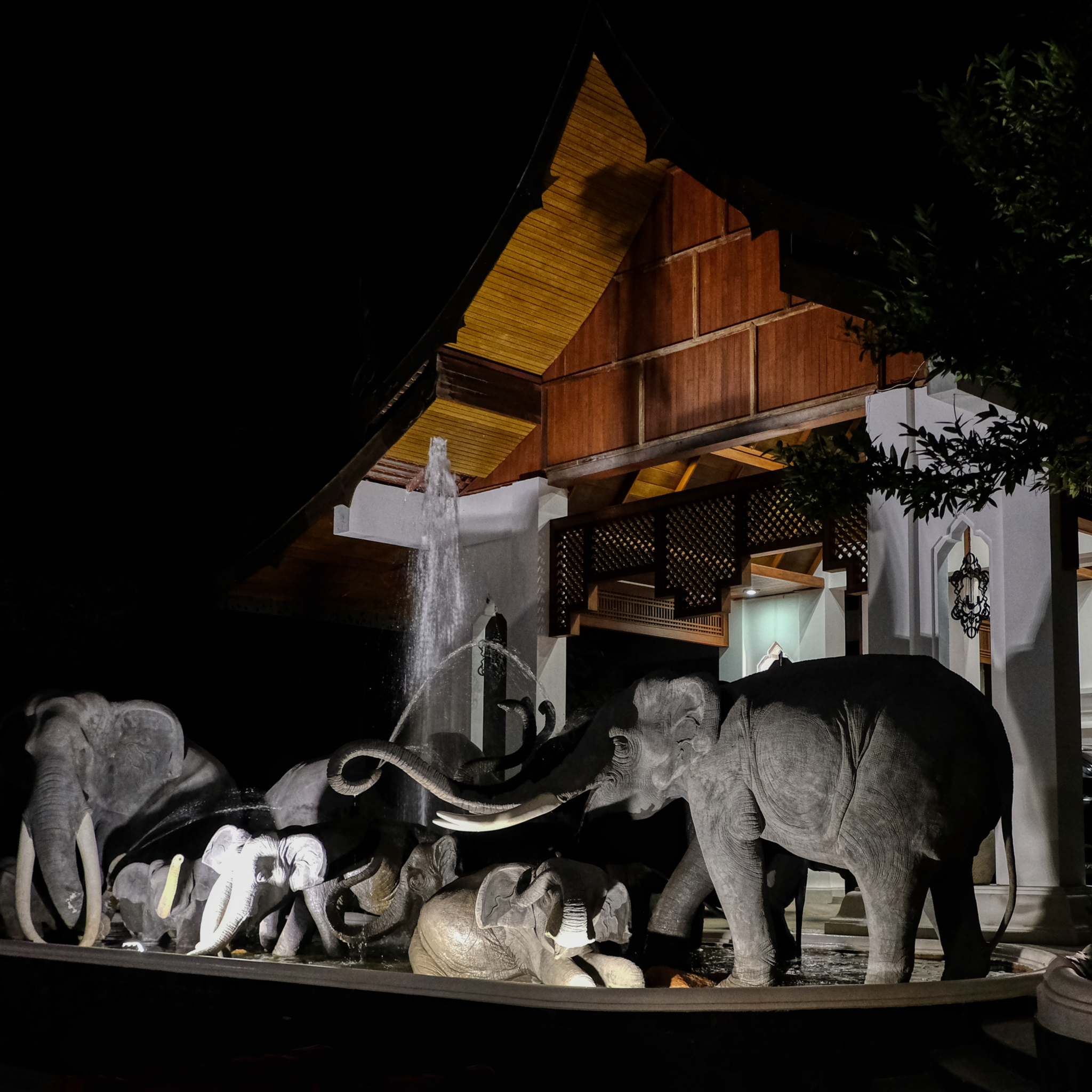 We found this marvelous restaurant for our dinner on the second night in Loei.
We found this marvelous restaurant for our dinner on the second night in Loei.
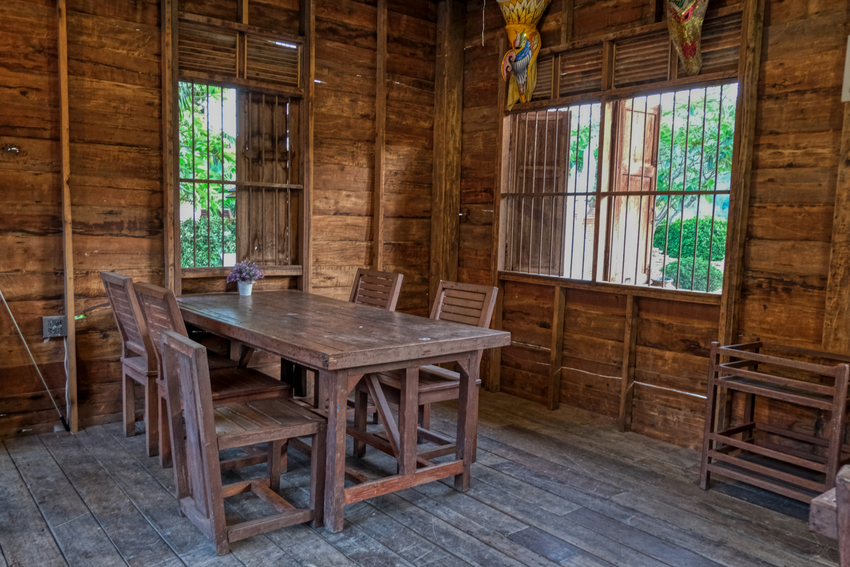 The "elephant restaurant' interior dining area.
The "elephant restaurant' interior dining area.
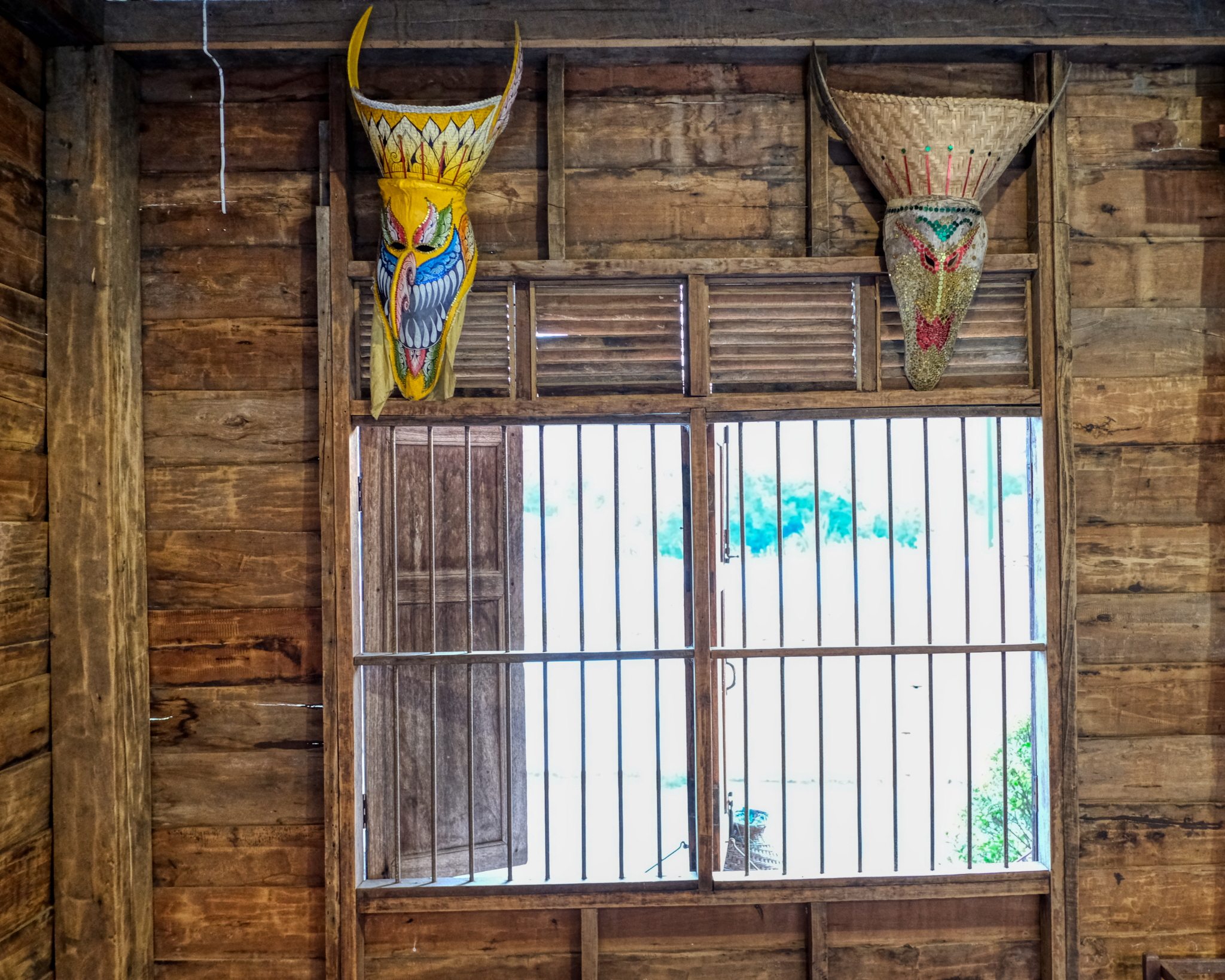 We had a fine meal in this old wooden room with traditional spirit masks hanging around.
We had a fine meal in this old wooden room with traditional spirit masks hanging around.
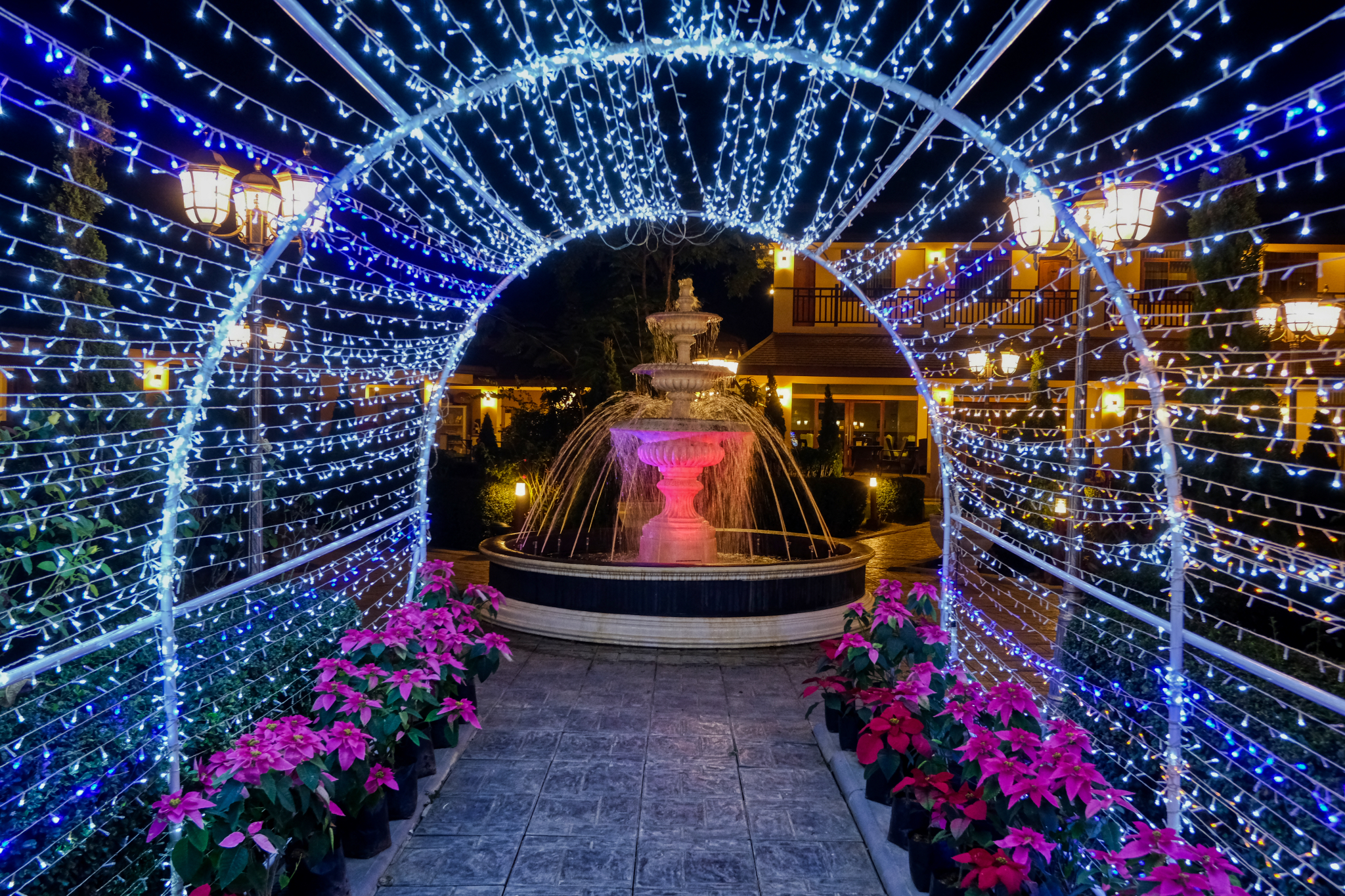 Back at our hotel . . . they had the grounds lit up like a carnival!!!
Back at our hotel . . . they had the grounds lit up like a carnival!!!
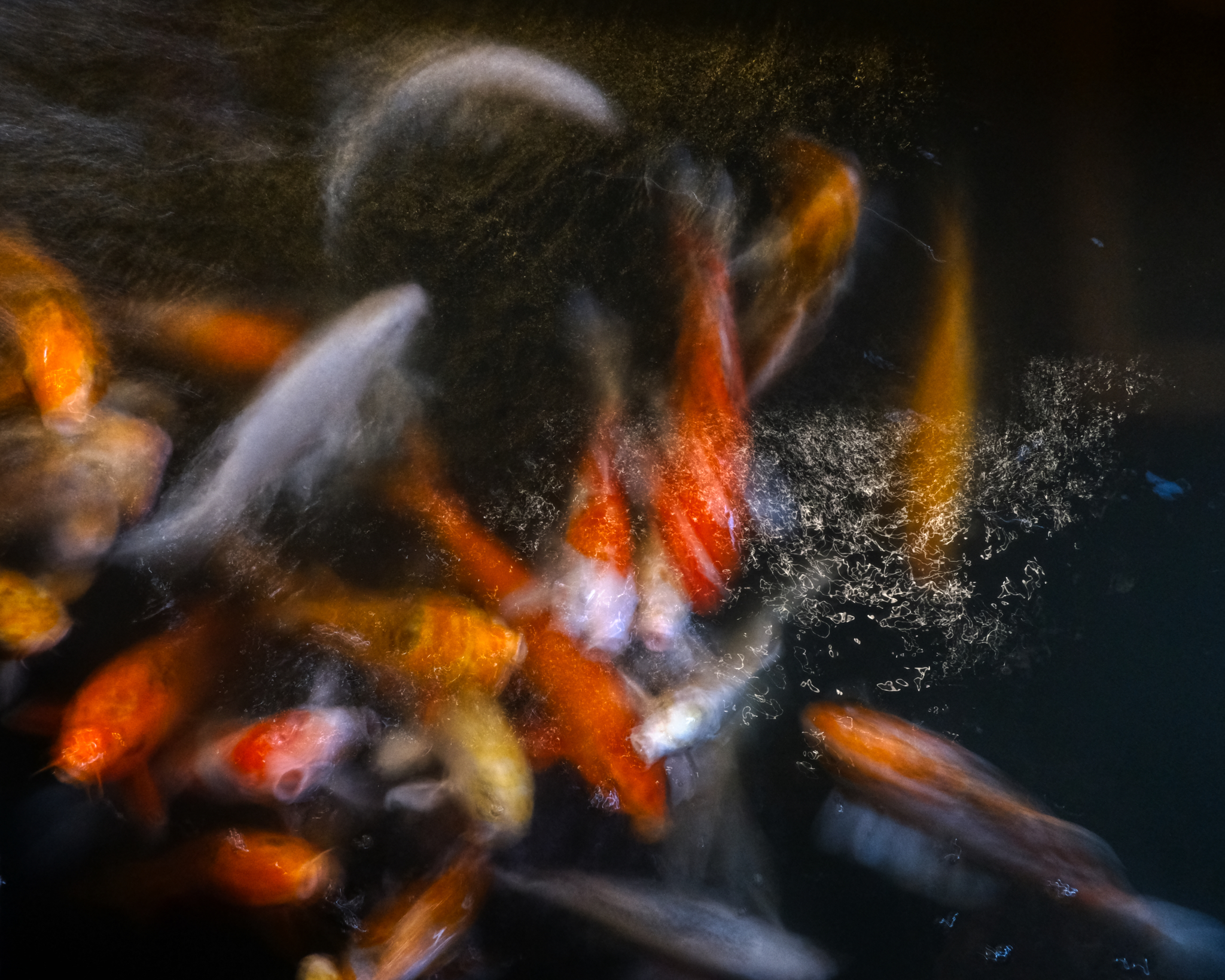 The next morning we said good-bye to Loei and hit the road for then short drive north to the town of Chiang Khan along the Mekong River.
The next morning we said good-bye to Loei and hit the road for then short drive north to the town of Chiang Khan along the Mekong River.
--------------------------------------------
CHIANG KHAN
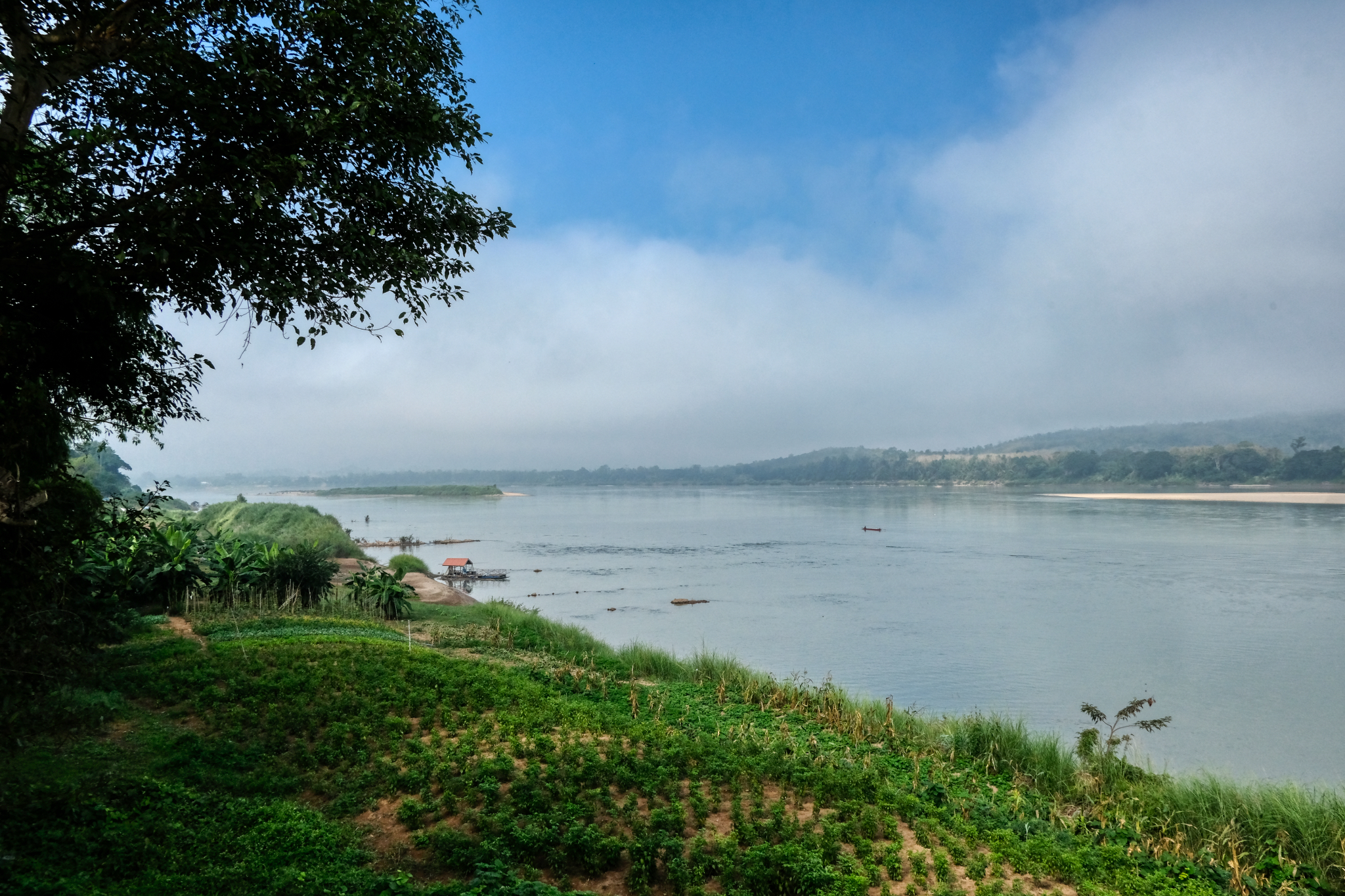 We stopped at a riverside resort as soon as we arrived at the river . . . and this was out first view of the mighty Mekong River.
We stopped at a riverside resort as soon as we arrived at the river . . . and this was out first view of the mighty Mekong River.
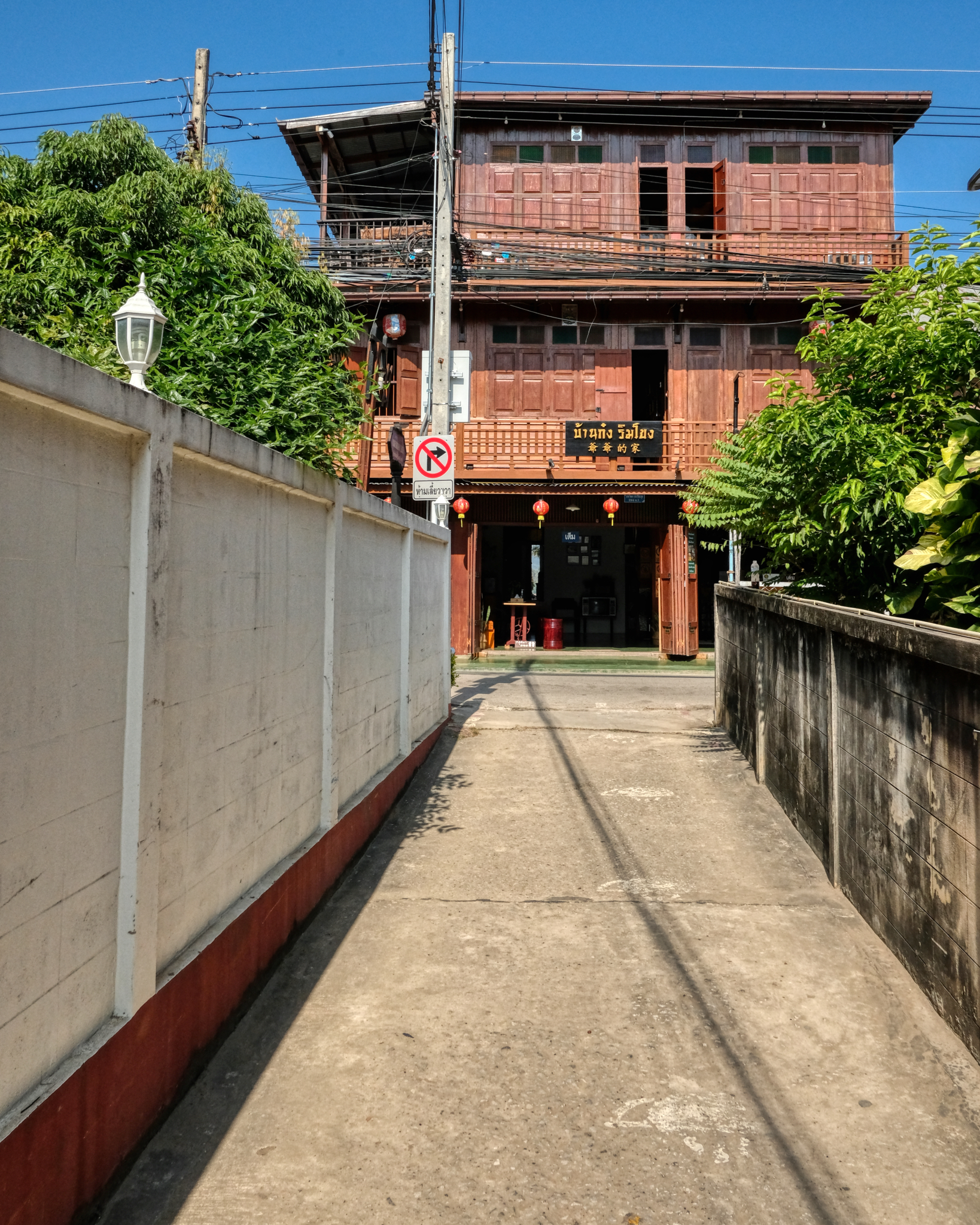 We quickly found our charming old wooden guest house.
We quickly found our charming old wooden guest house.
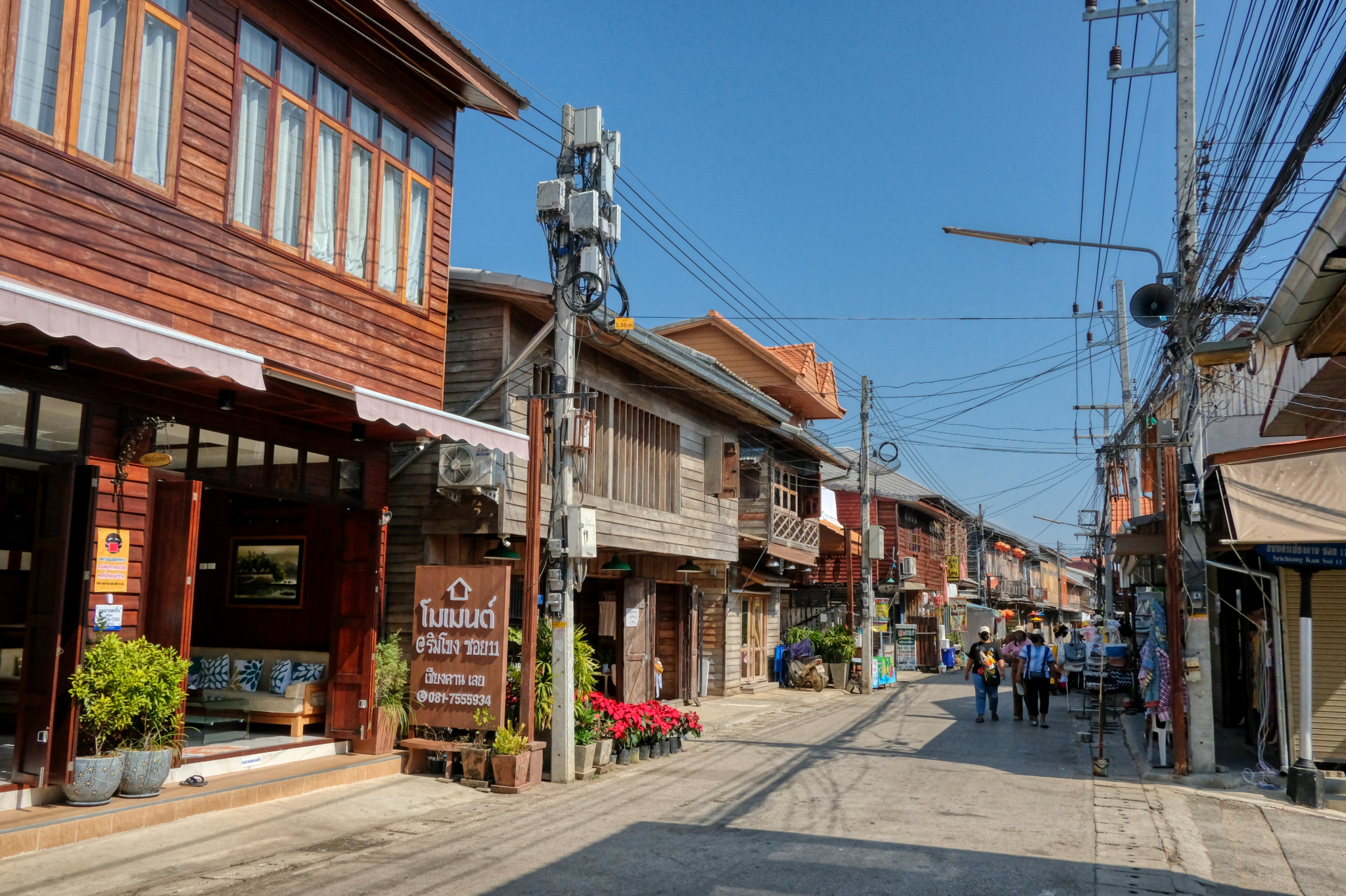 Our guest house was right on a kind of 'walking street' through the riverside village. The Mekong River is directly behind the row of houses and shops to the left.
Our guest house was right on a kind of 'walking street' through the riverside village. The Mekong River is directly behind the row of houses and shops to the left.
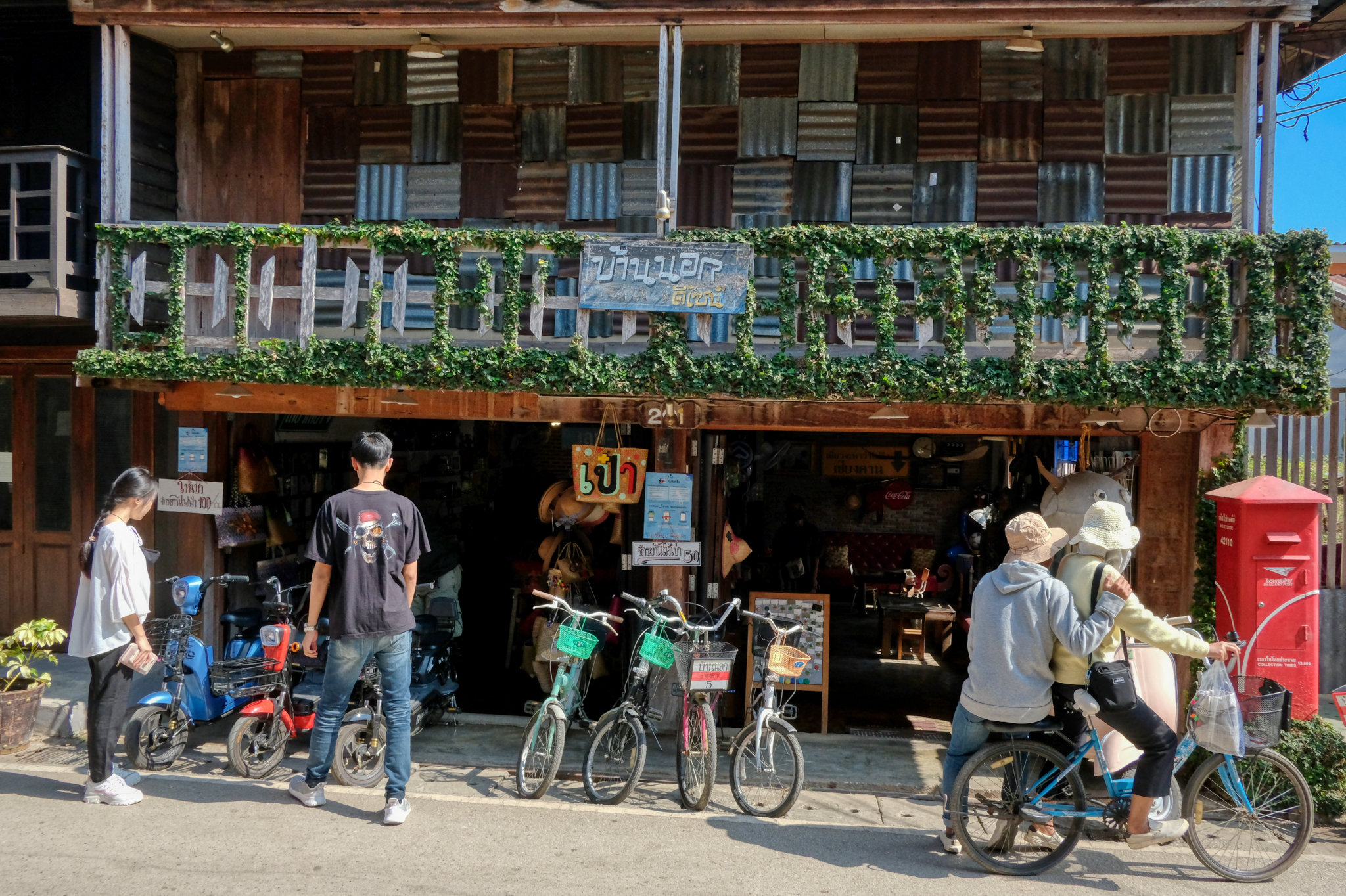 Chiang Khan is a lovely and funky old Thai town with interesting shops and bike rentals.
Chiang Khan is a lovely and funky old Thai town with interesting shops and bike rentals.
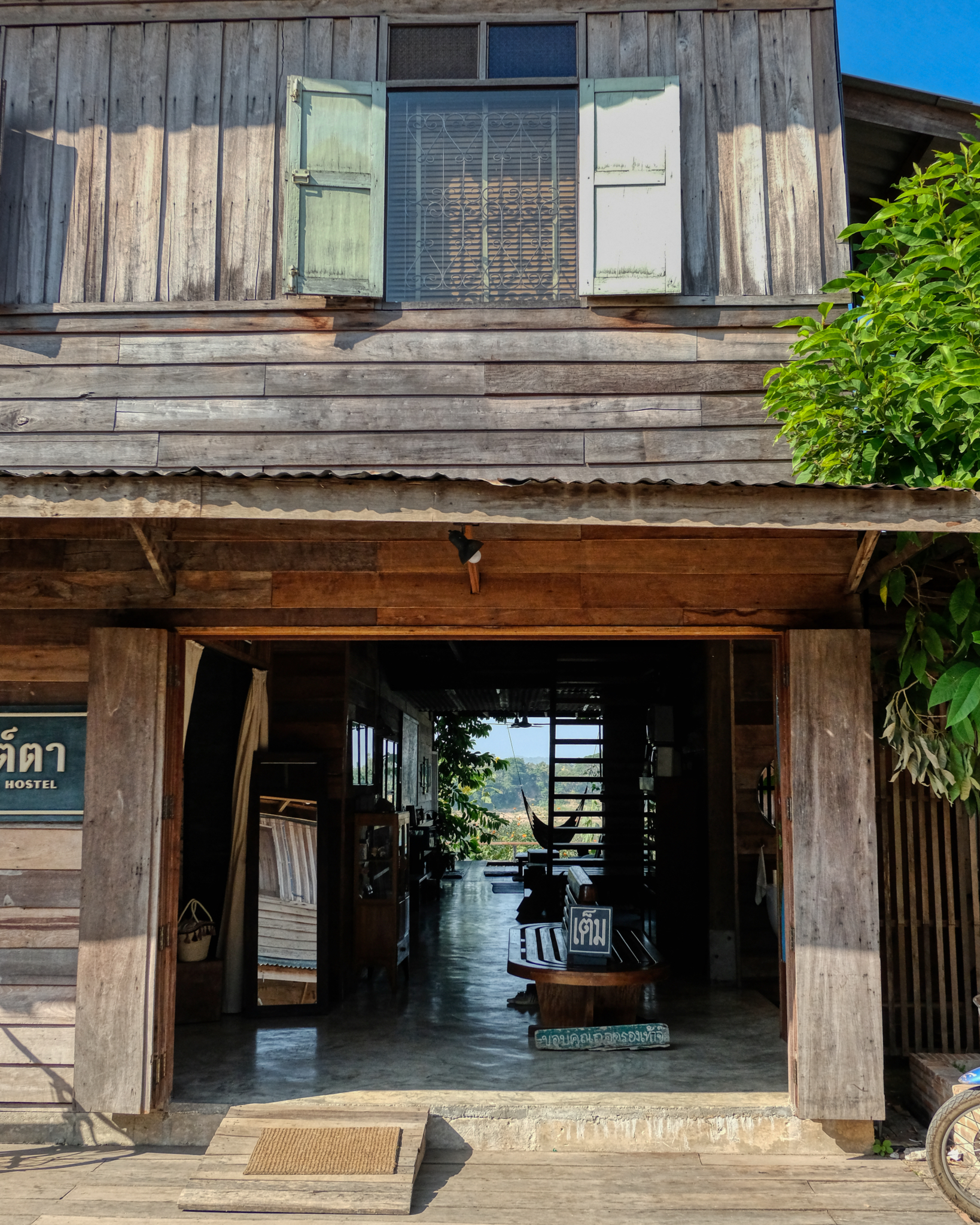 With both front and rear doors open, you can look right through this hostel to the river behind it.
With both front and rear doors open, you can look right through this hostel to the river behind it.
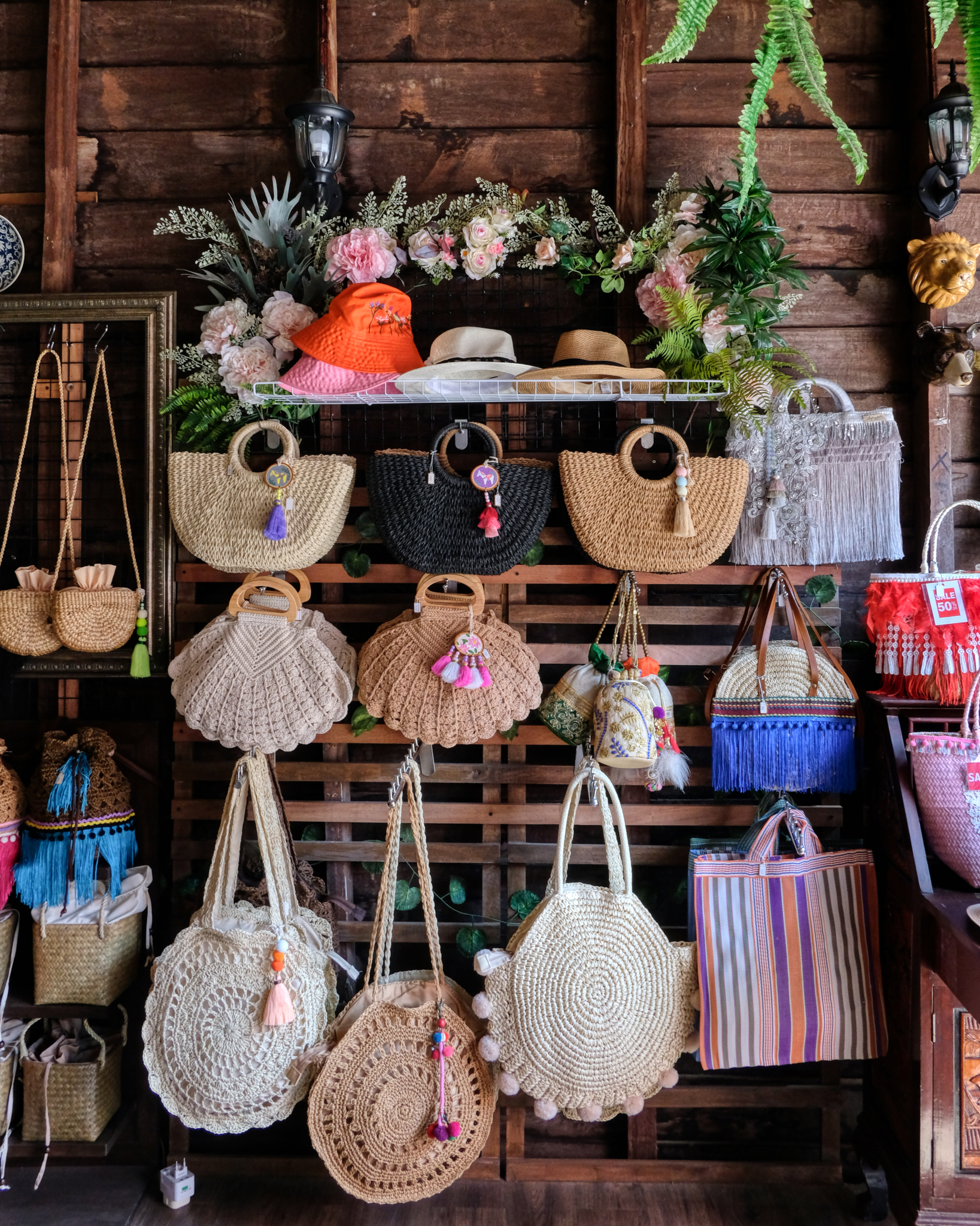 The many shops lining the walking street had ample supplies of local handicrafts to meet the tourist demand.
The many shops lining the walking street had ample supplies of local handicrafts to meet the tourist demand.
 A guest house with street side 'beer chairs' . . . perfect for people watching. I couldn't help but notice the Brew Dog Punk IPA bottle . . . from Aberdeen, Scotland, my former residence.
A guest house with street side 'beer chairs' . . . perfect for people watching. I couldn't help but notice the Brew Dog Punk IPA bottle . . . from Aberdeen, Scotland, my former residence.
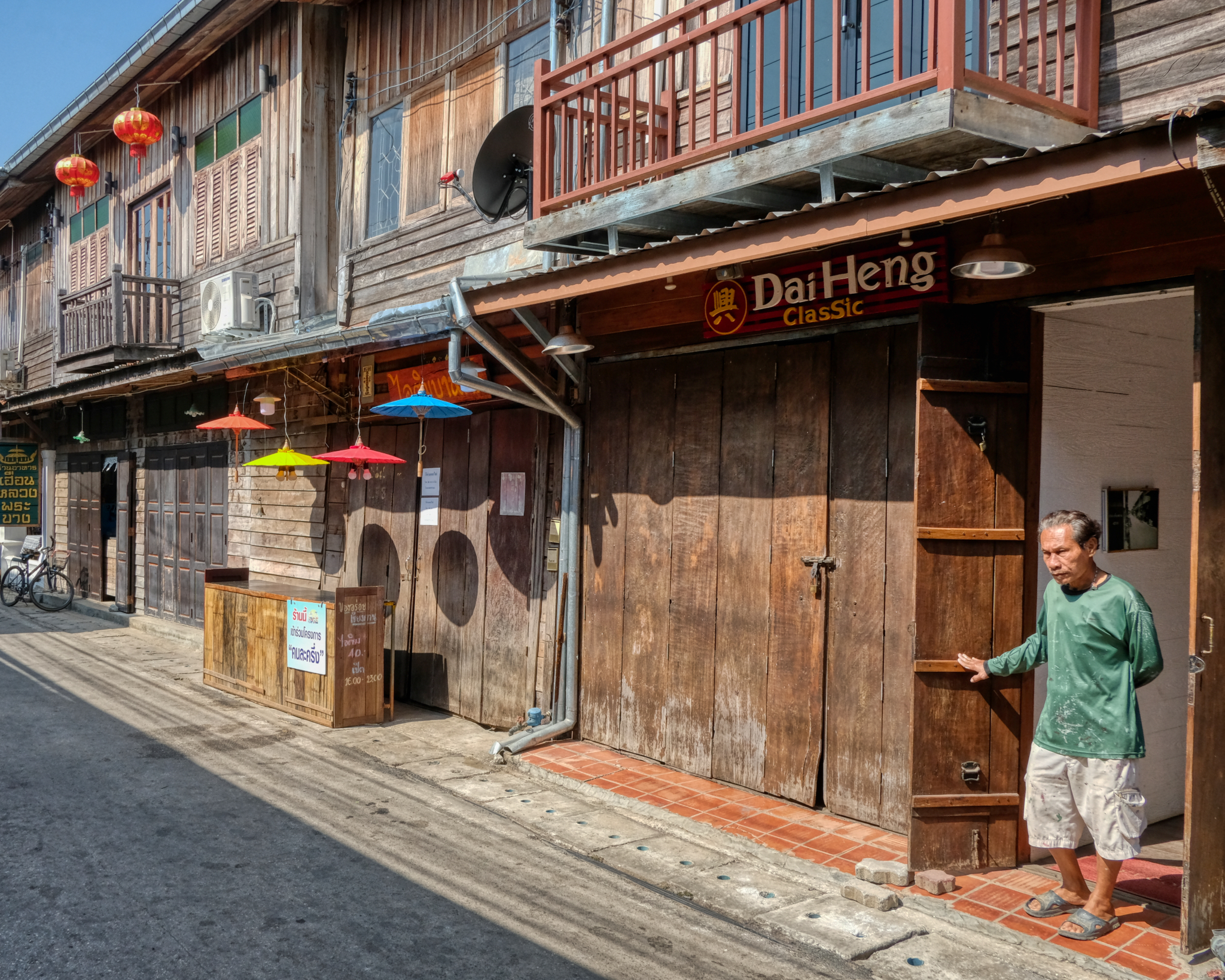 Such an interesting and photogenic little town.
Such an interesting and photogenic little town.
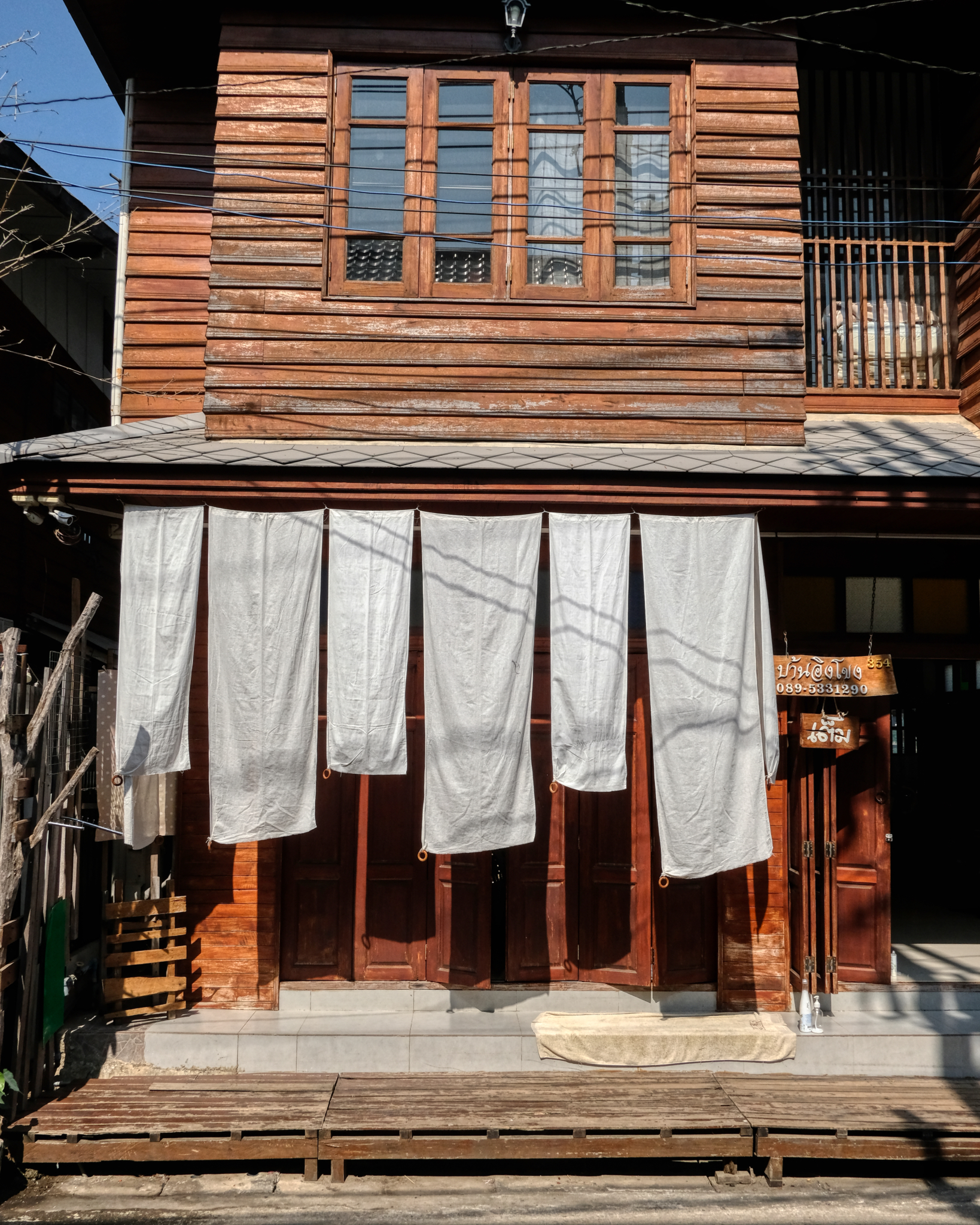 Some shops hung fabric against the harsh afternoon sun.
Some shops hung fabric against the harsh afternoon sun.
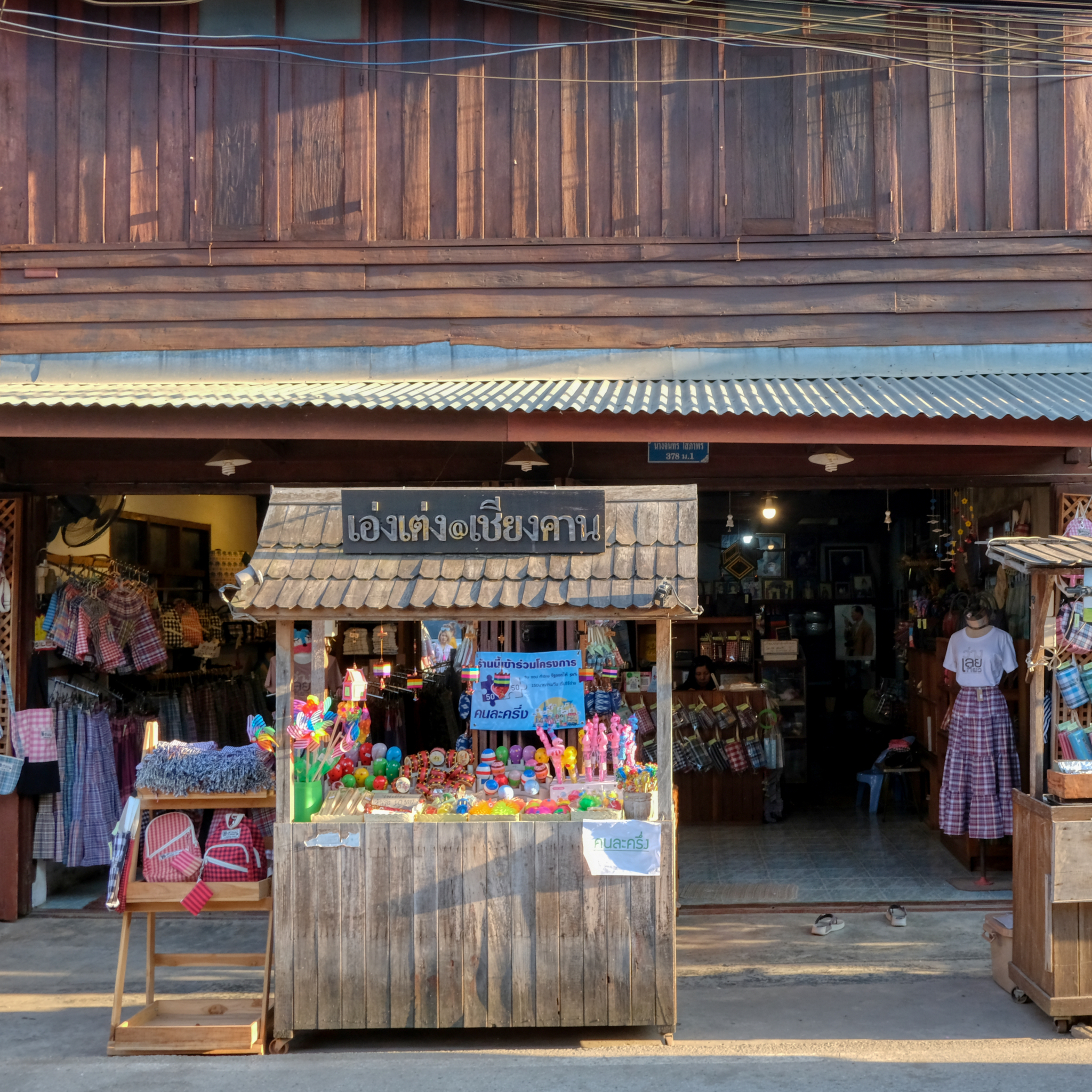 Each shop-front seems to have its own personality, and the photographs are like portraits.
Each shop-front seems to have its own personality, and the photographs are like portraits.
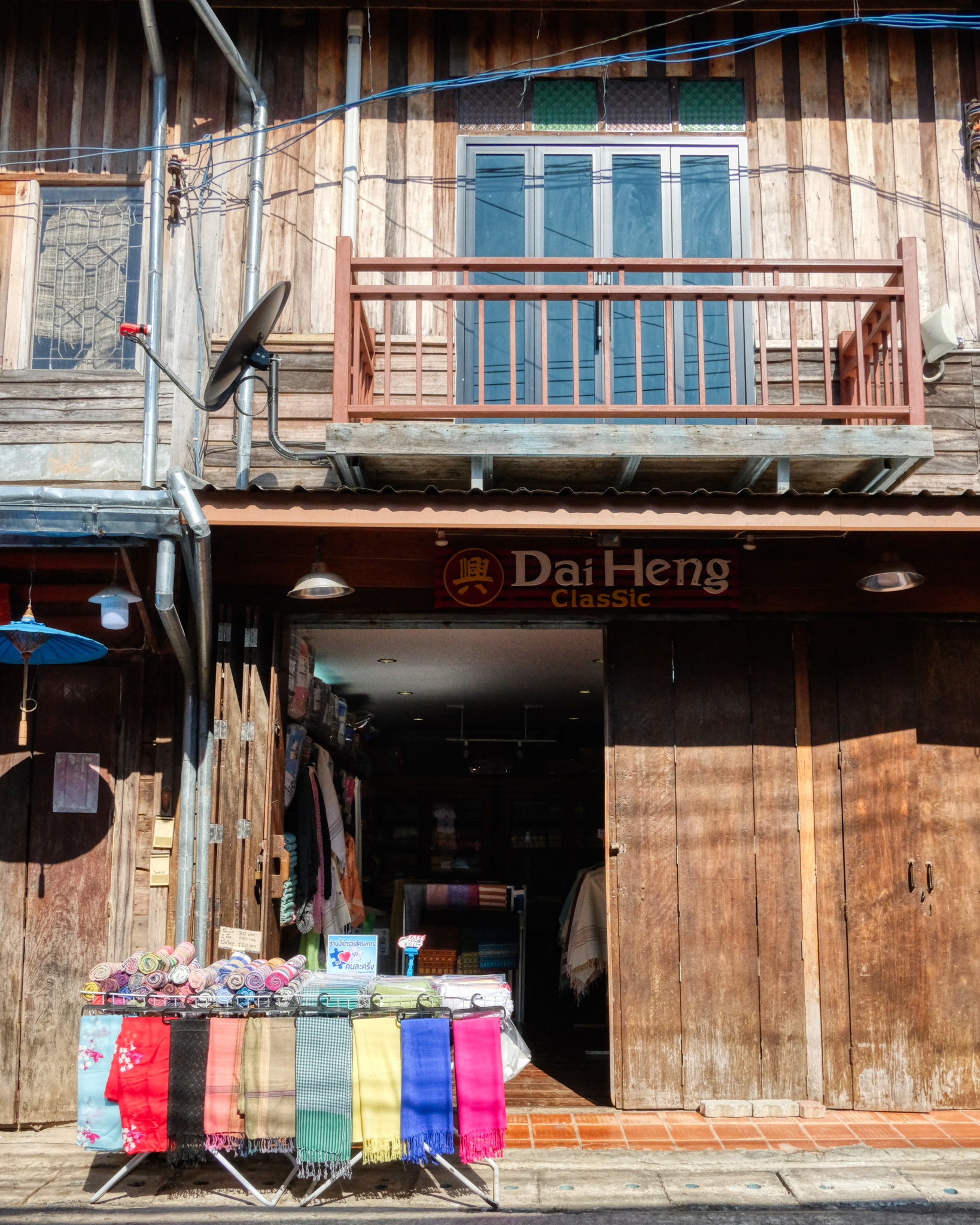 Beautiful local, high quality traditional textiles.
Beautiful local, high quality traditional textiles.
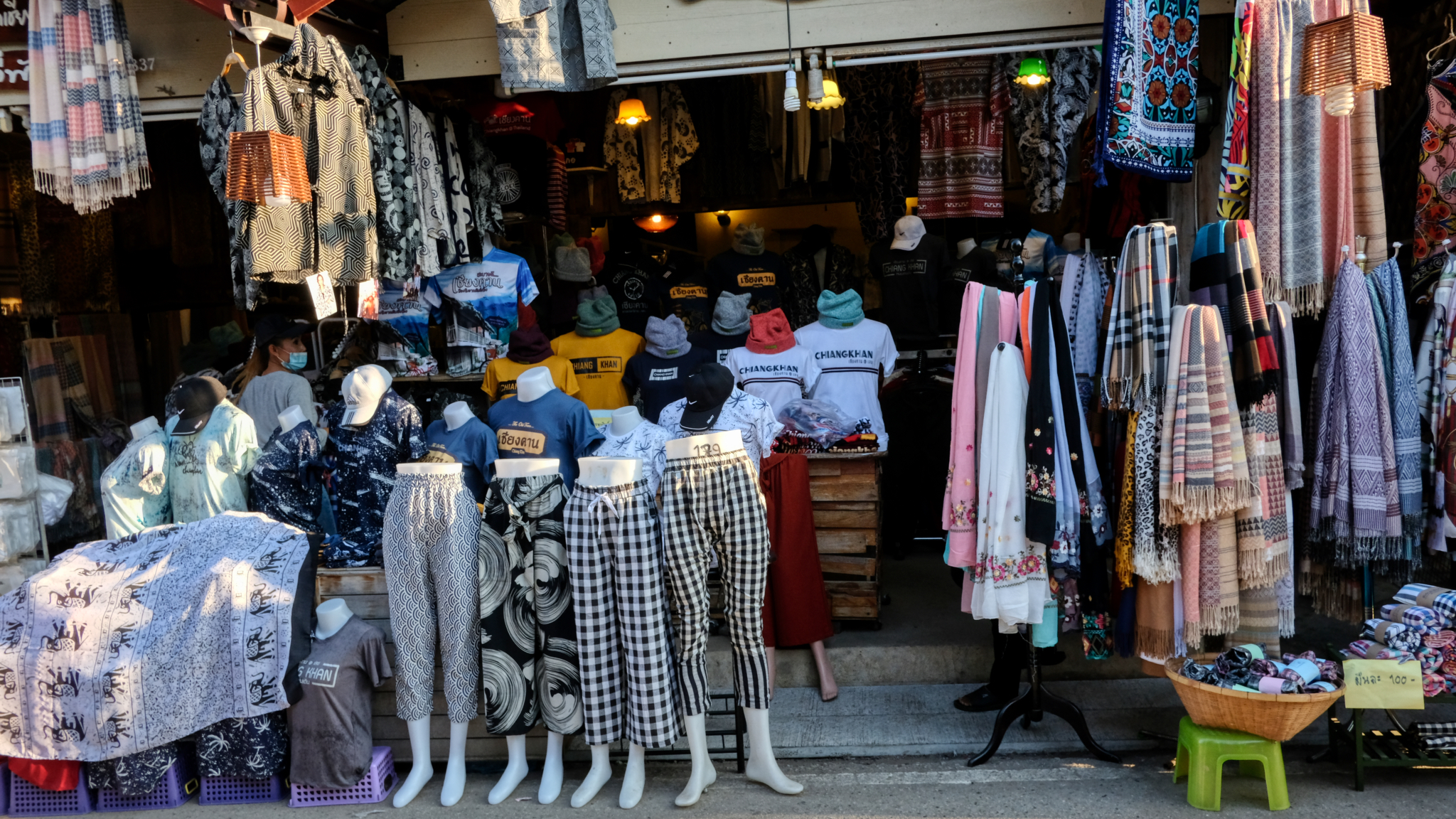 There were also many shops selling the usual array of souvenir 'touristwear.'
There were also many shops selling the usual array of souvenir 'touristwear.'
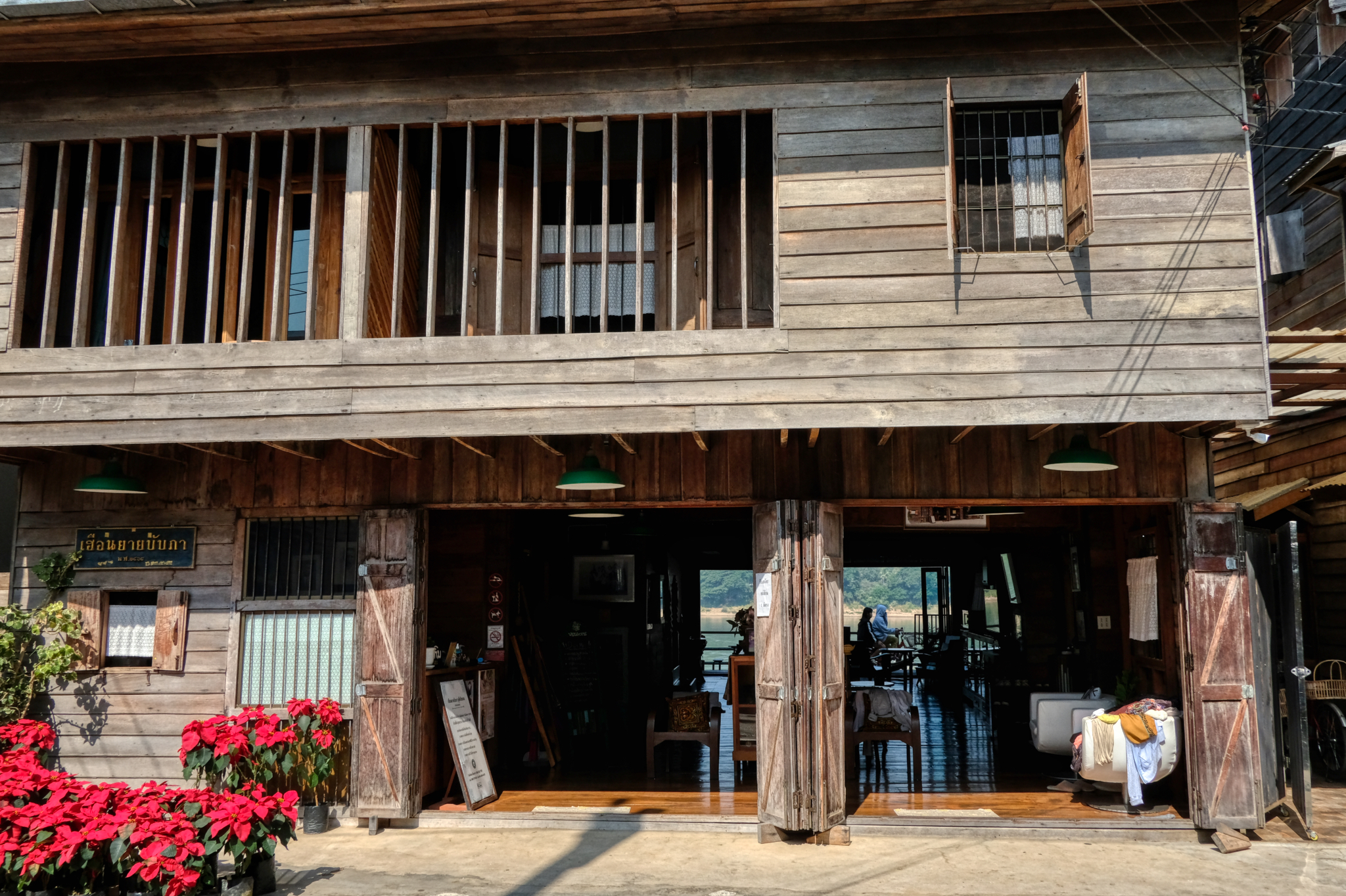 There is no shortage of restaurants and places to buy good, expensive coffee.
There is no shortage of restaurants and places to buy good, expensive coffee.
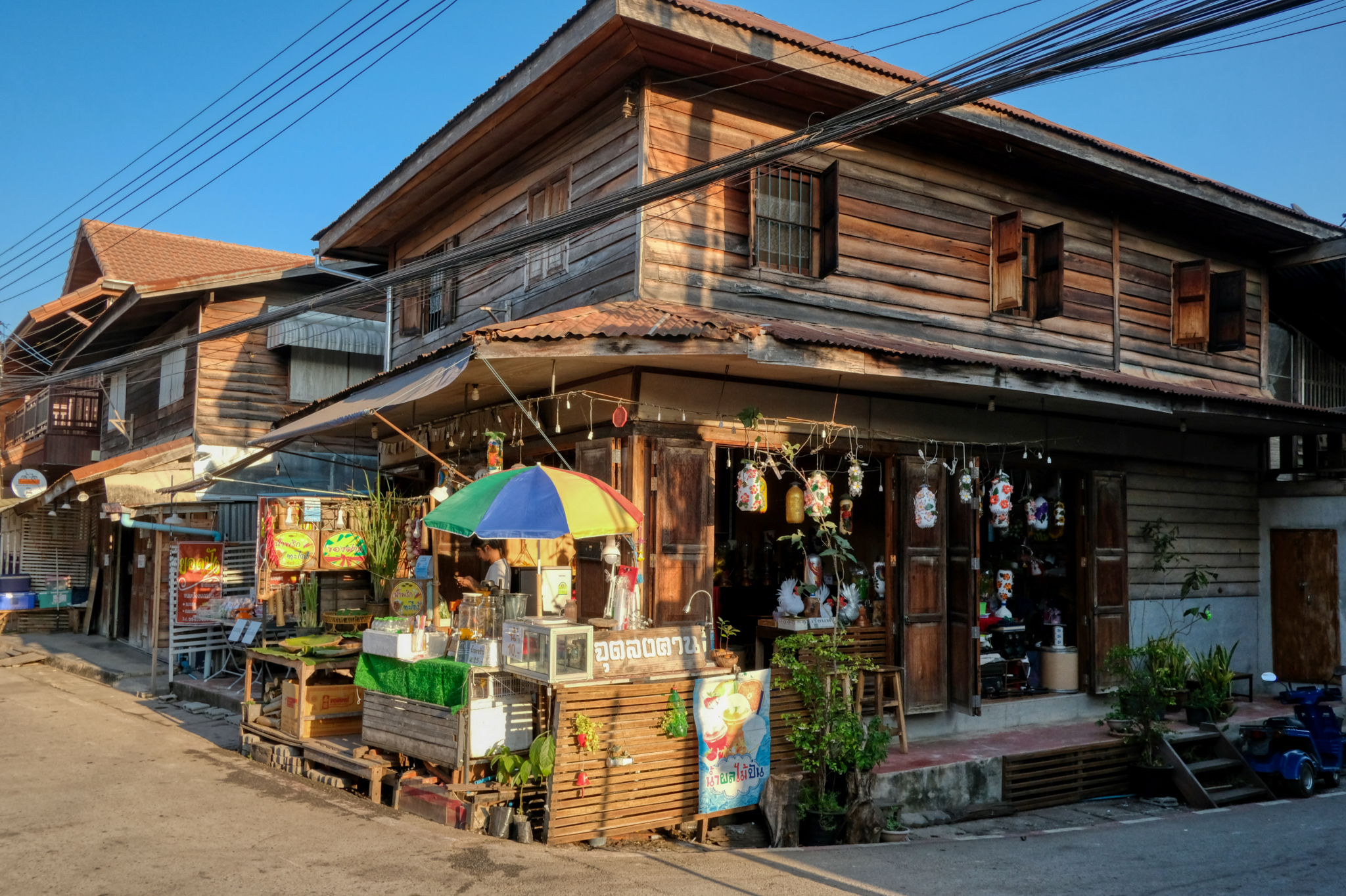 I love photographing these old wooden shops . . . anywhere in the world . . . but Chiang Khan had hundreds of them, and all with amazing shapes, features, colors, and textures.
I love photographing these old wooden shops . . . anywhere in the world . . . but Chiang Khan had hundreds of them, and all with amazing shapes, features, colors, and textures.
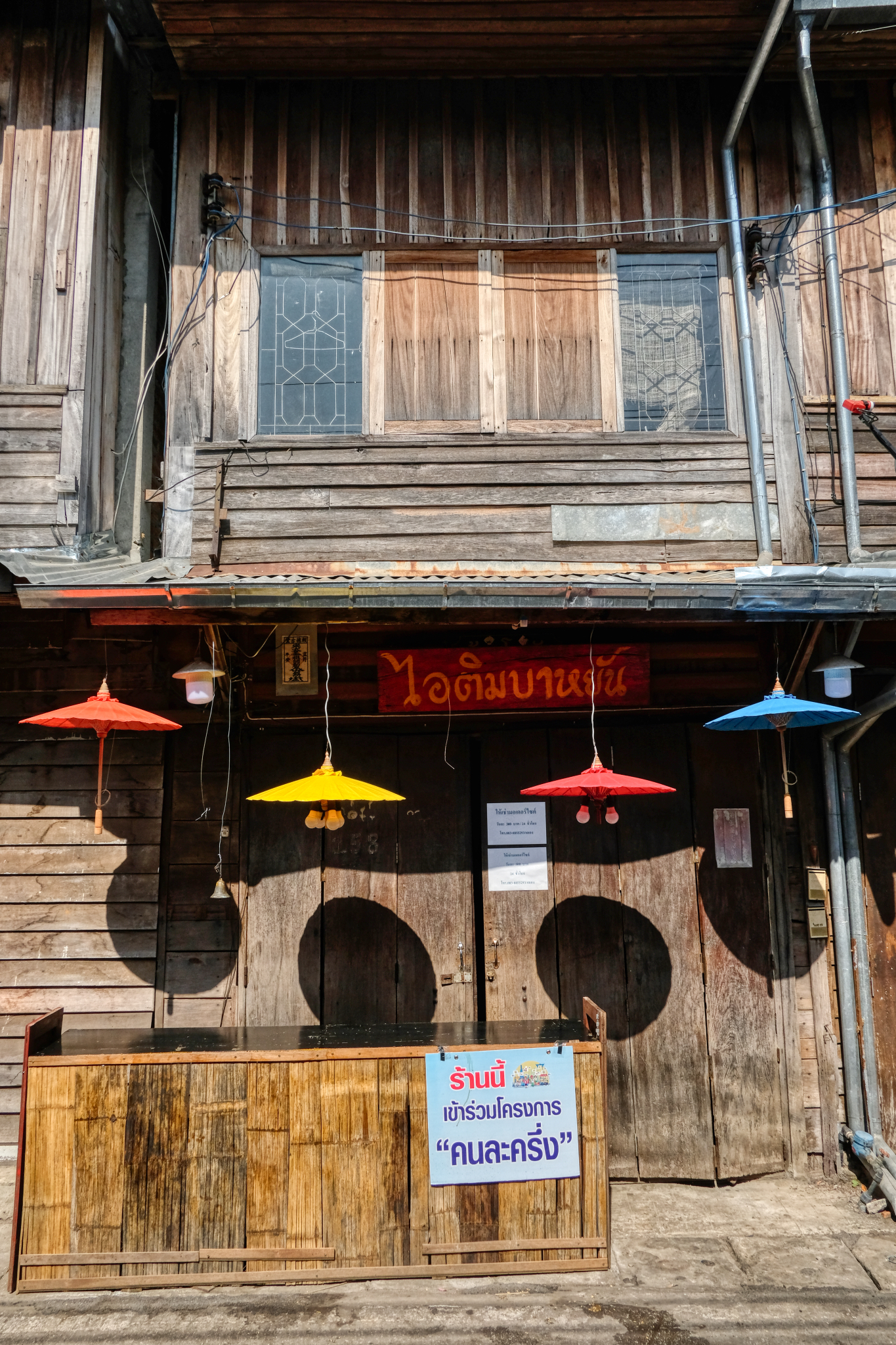 A beautiful shop-front portrait. The harsh afternoon sunlight actually enhances this photo by accentuating the wood grain and colors.
A beautiful shop-front portrait. The harsh afternoon sunlight actually enhances this photo by accentuating the wood grain and colors.
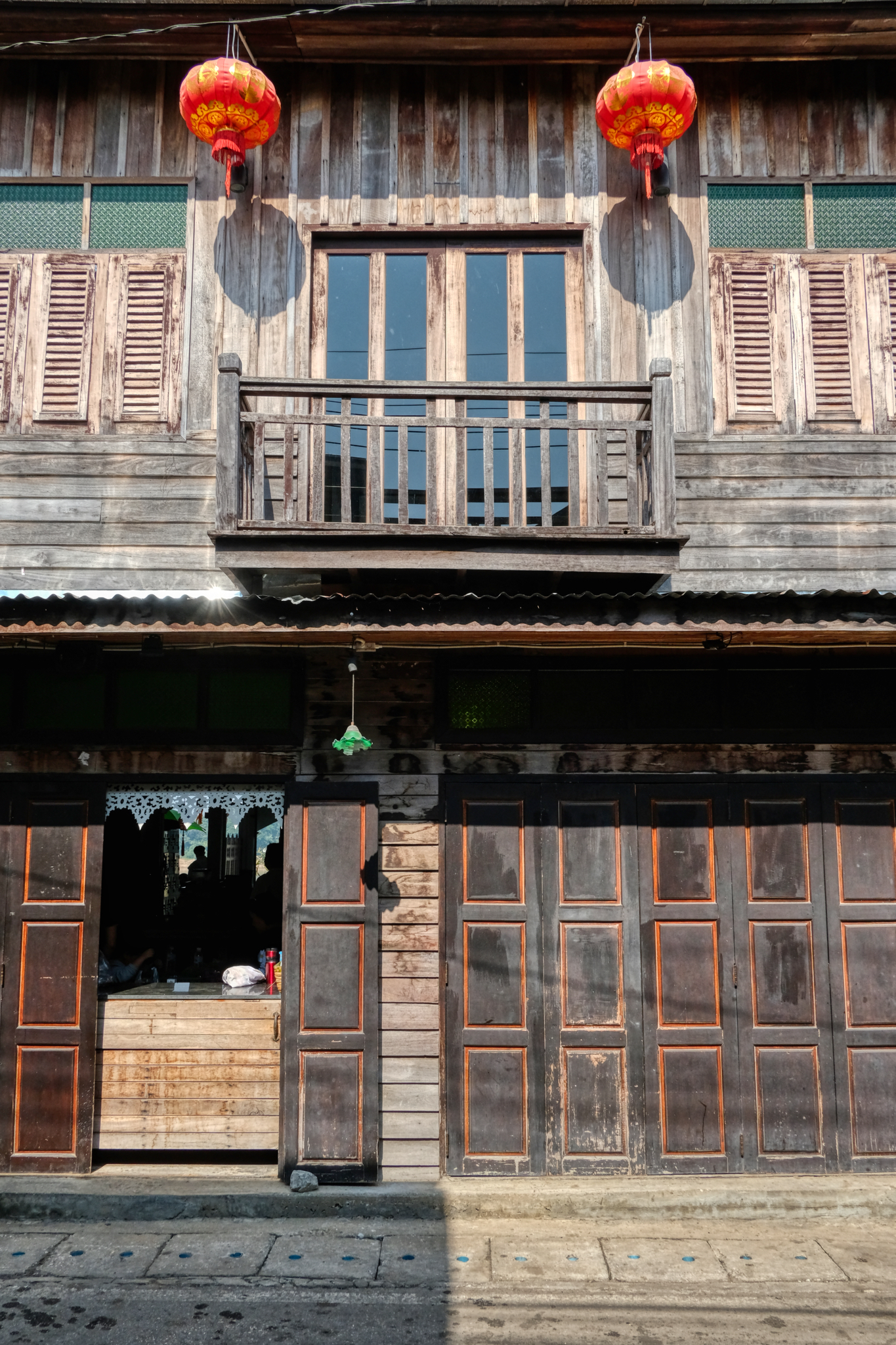 Another fabulous paneled storefront with Chinese lanterns. Lovely.
Another fabulous paneled storefront with Chinese lanterns. Lovely.
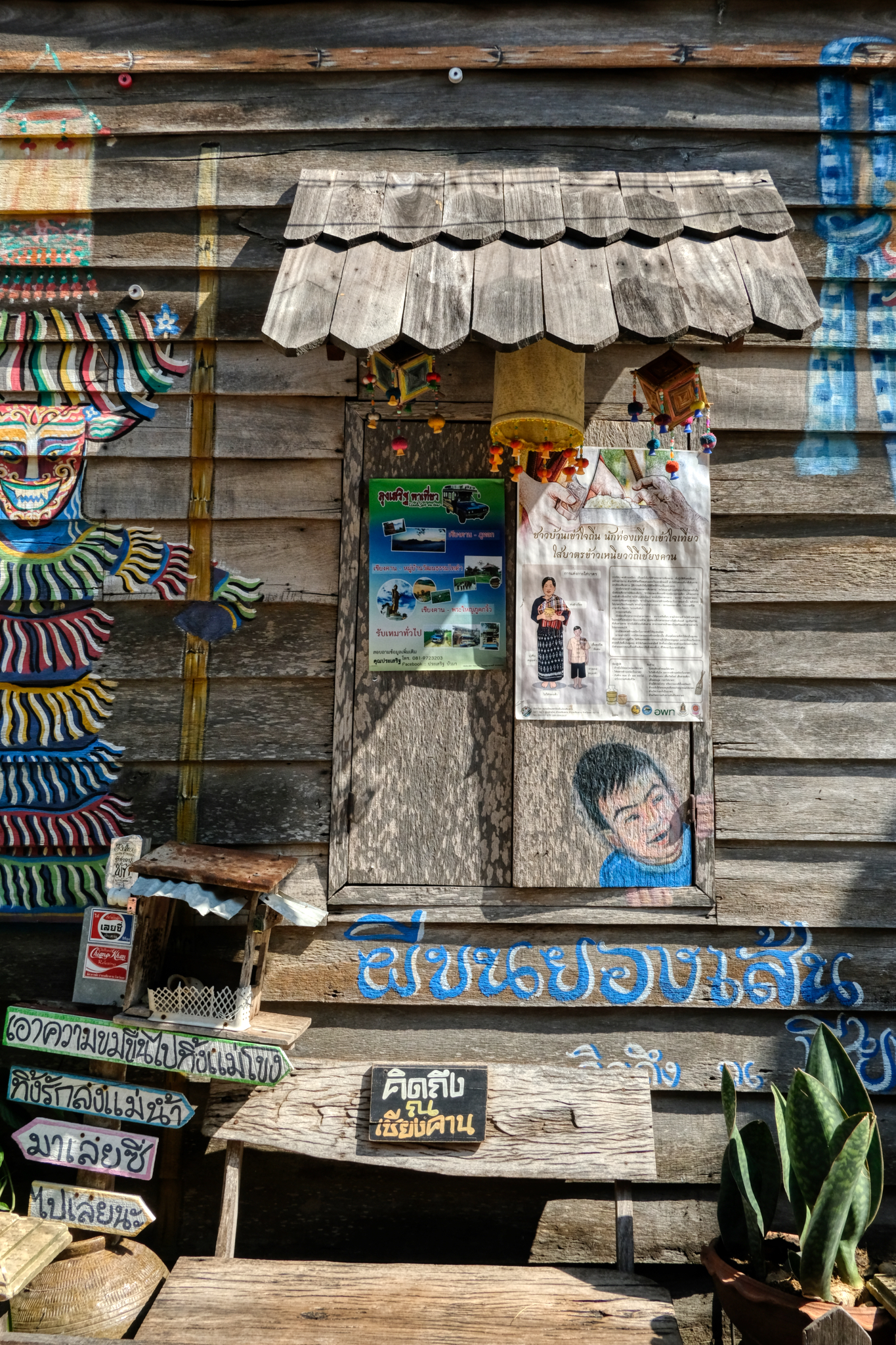 Just so much to see, notice, and photograph in this sweet little riverside town.
Just so much to see, notice, and photograph in this sweet little riverside town.
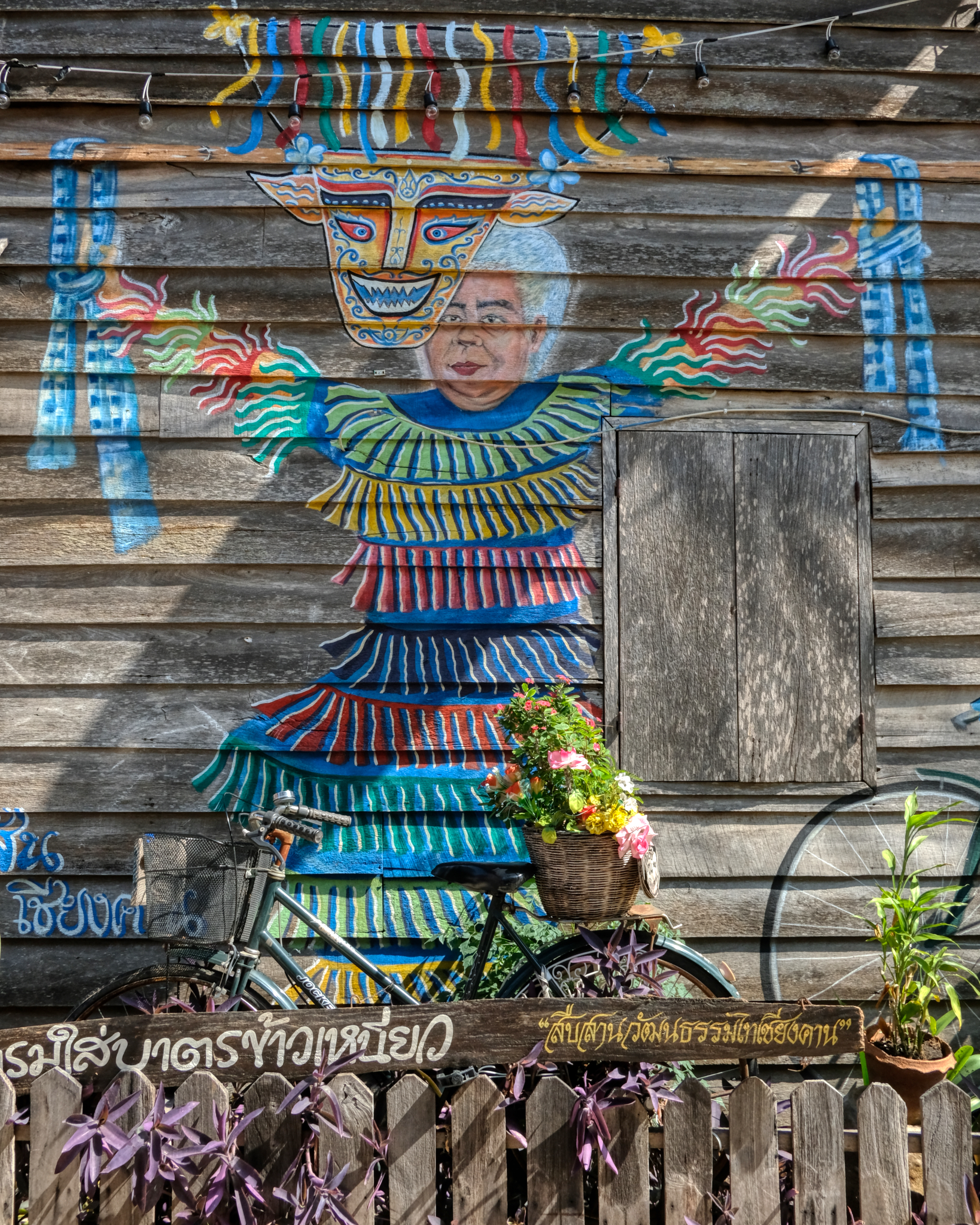 There was also some very nice chalk public art here and there.
There was also some very nice chalk public art here and there.
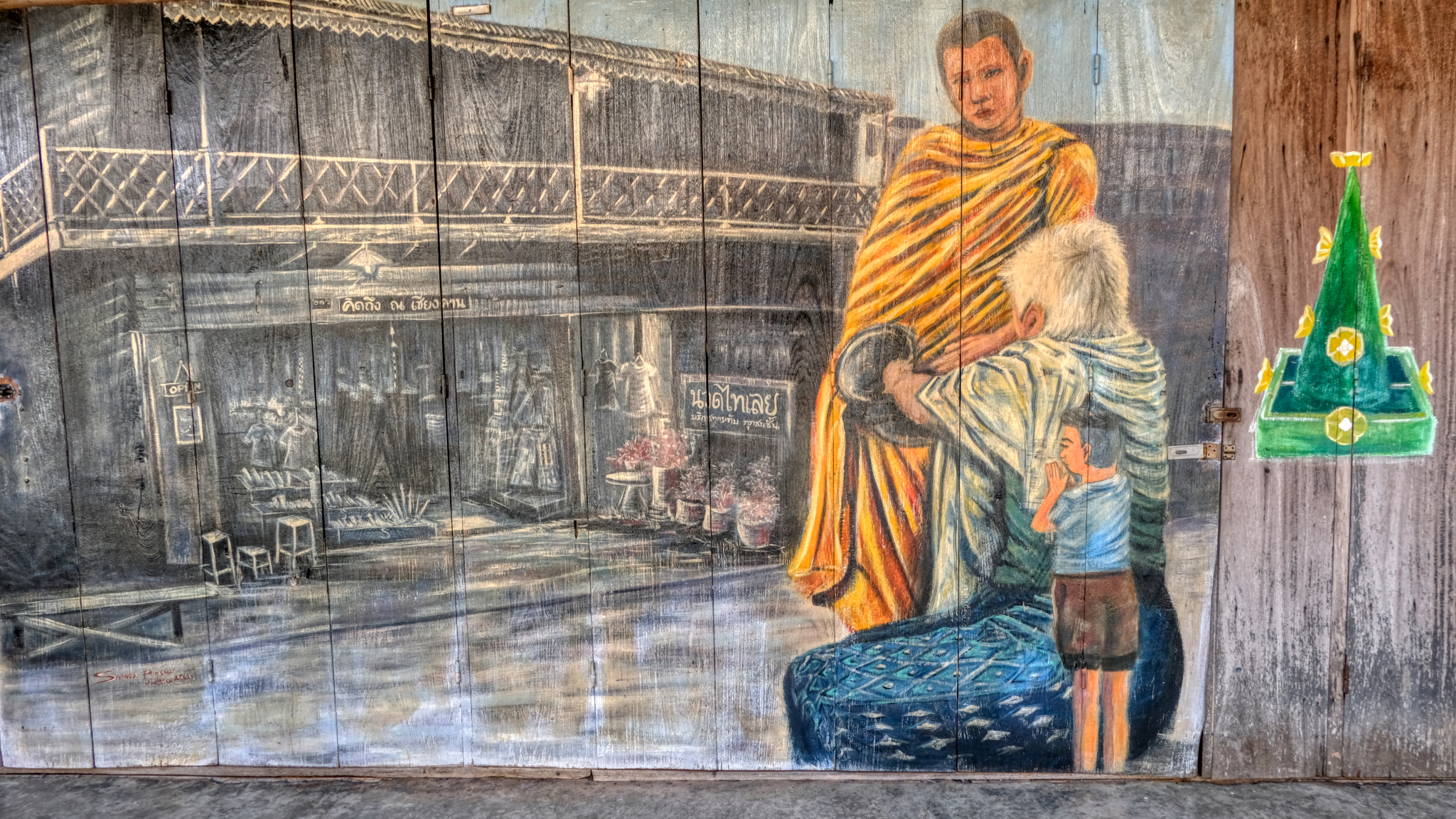 Sweet chalk street art.
Sweet chalk street art.
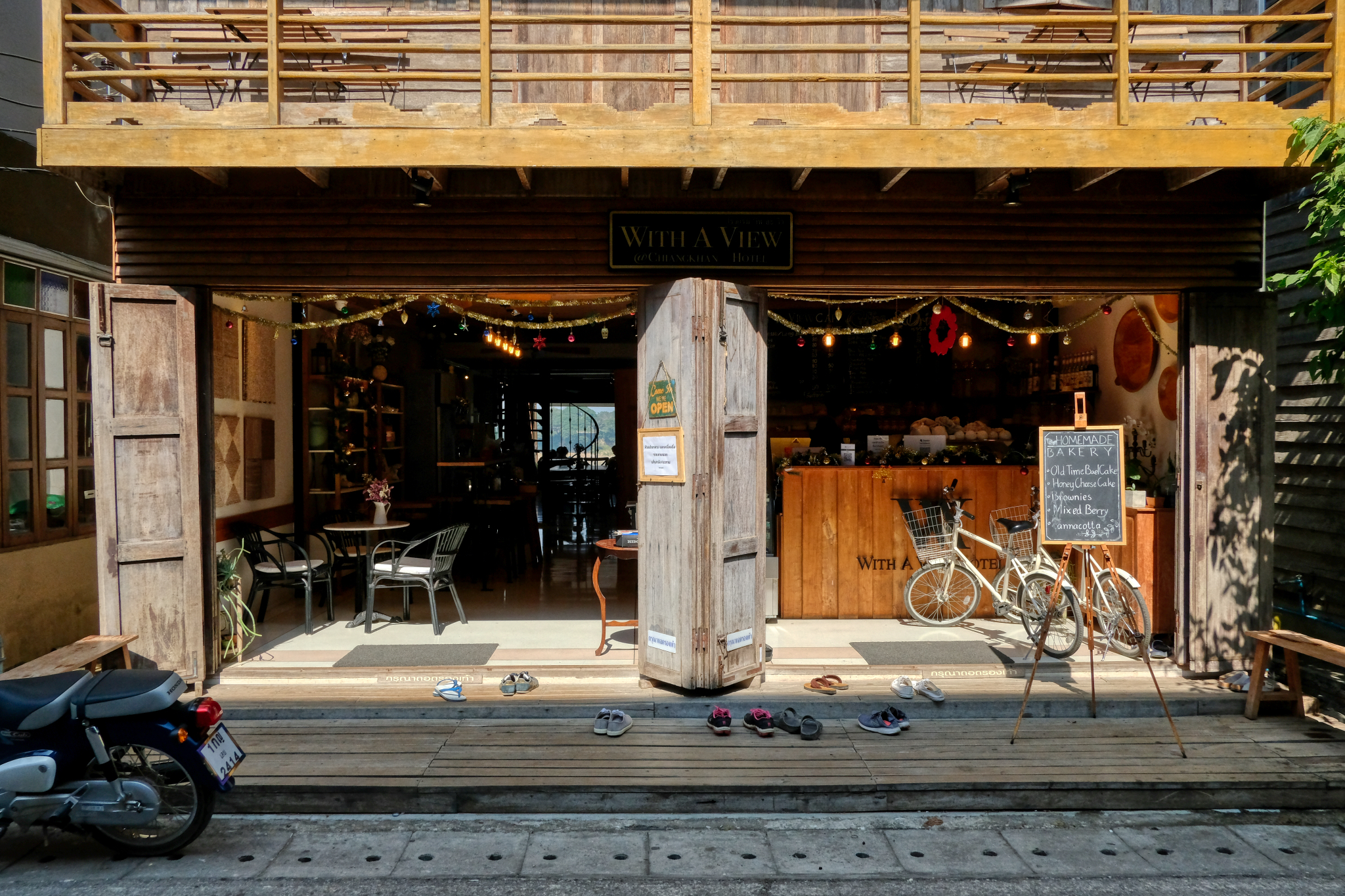 A very inviting bakery . . . delicious too!
A very inviting bakery . . . delicious too!
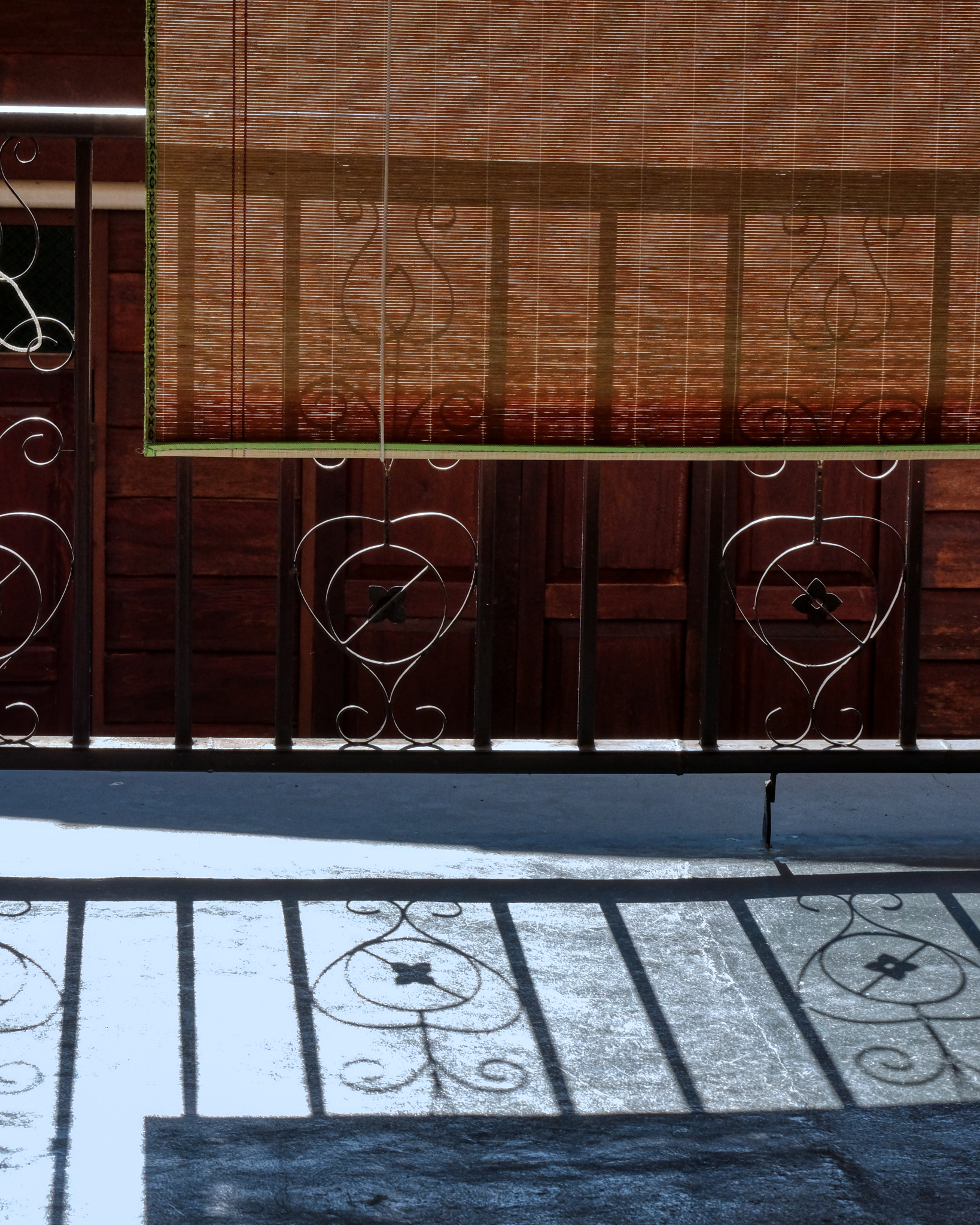 Thai aesthetics are always fascinating and gorgeous. It's all in the details. Here, a detail of the interior of our guesthouse.
Thai aesthetics are always fascinating and gorgeous. It's all in the details. Here, a detail of the interior of our guesthouse.
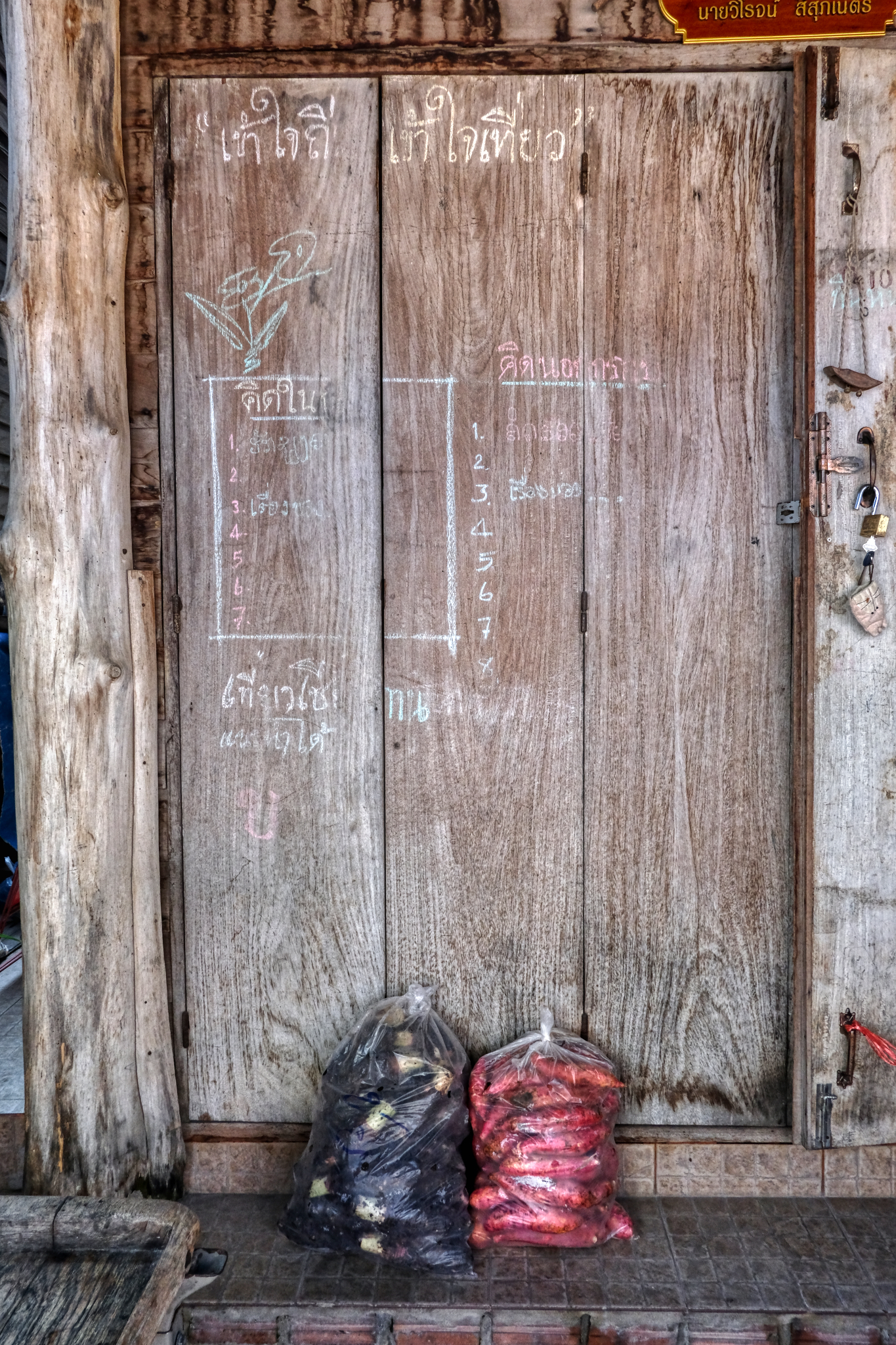 When walking around such these richly aesthetic places with a camera in hand, I am prone to take these kinds of "still life" photographs: pleasing arrangements of objects in fascinating light.
When walking around such these richly aesthetic places with a camera in hand, I am prone to take these kinds of "still life" photographs: pleasing arrangements of objects in fascinating light.
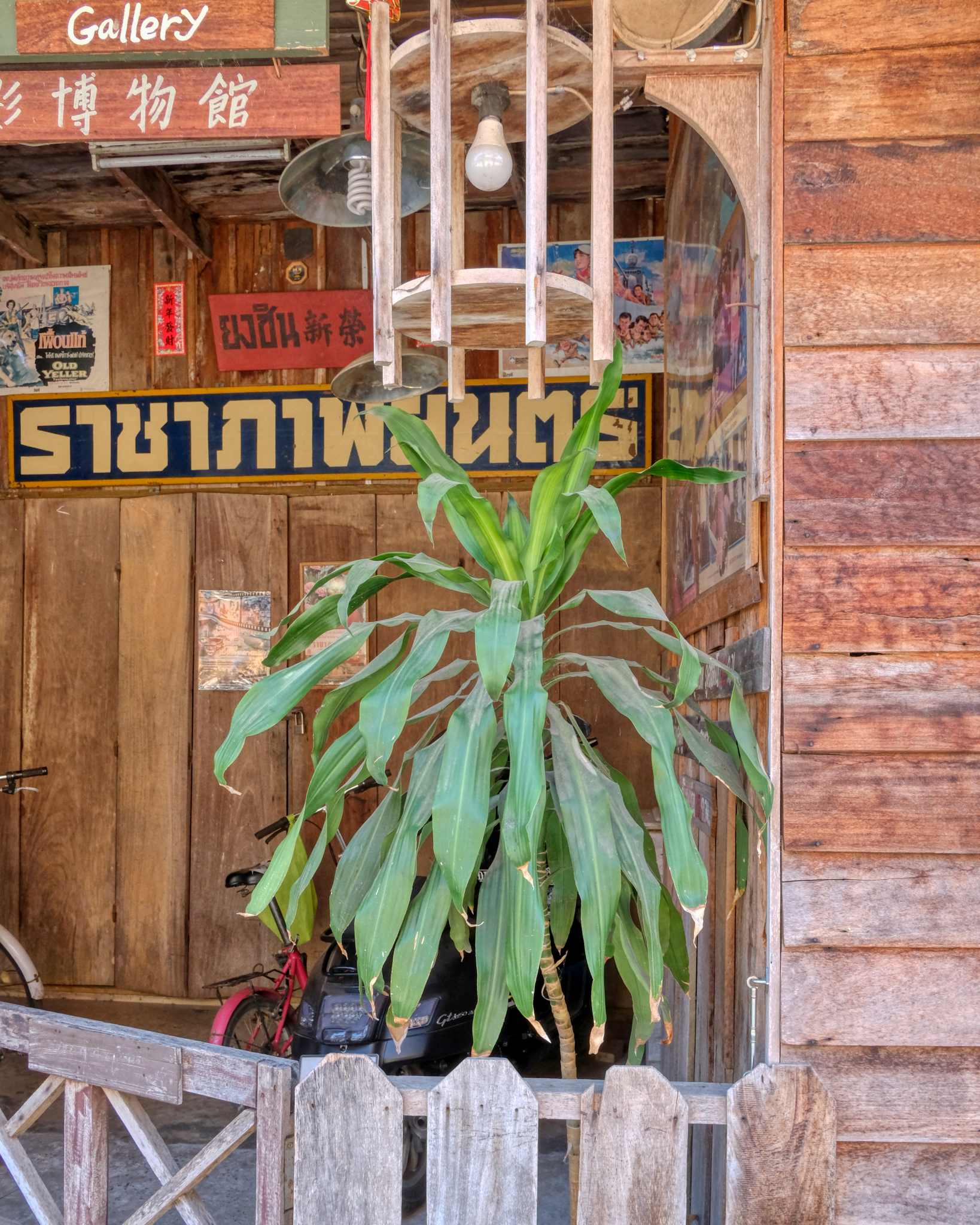 Another "still life" of an old art gallery.
Another "still life" of an old art gallery.
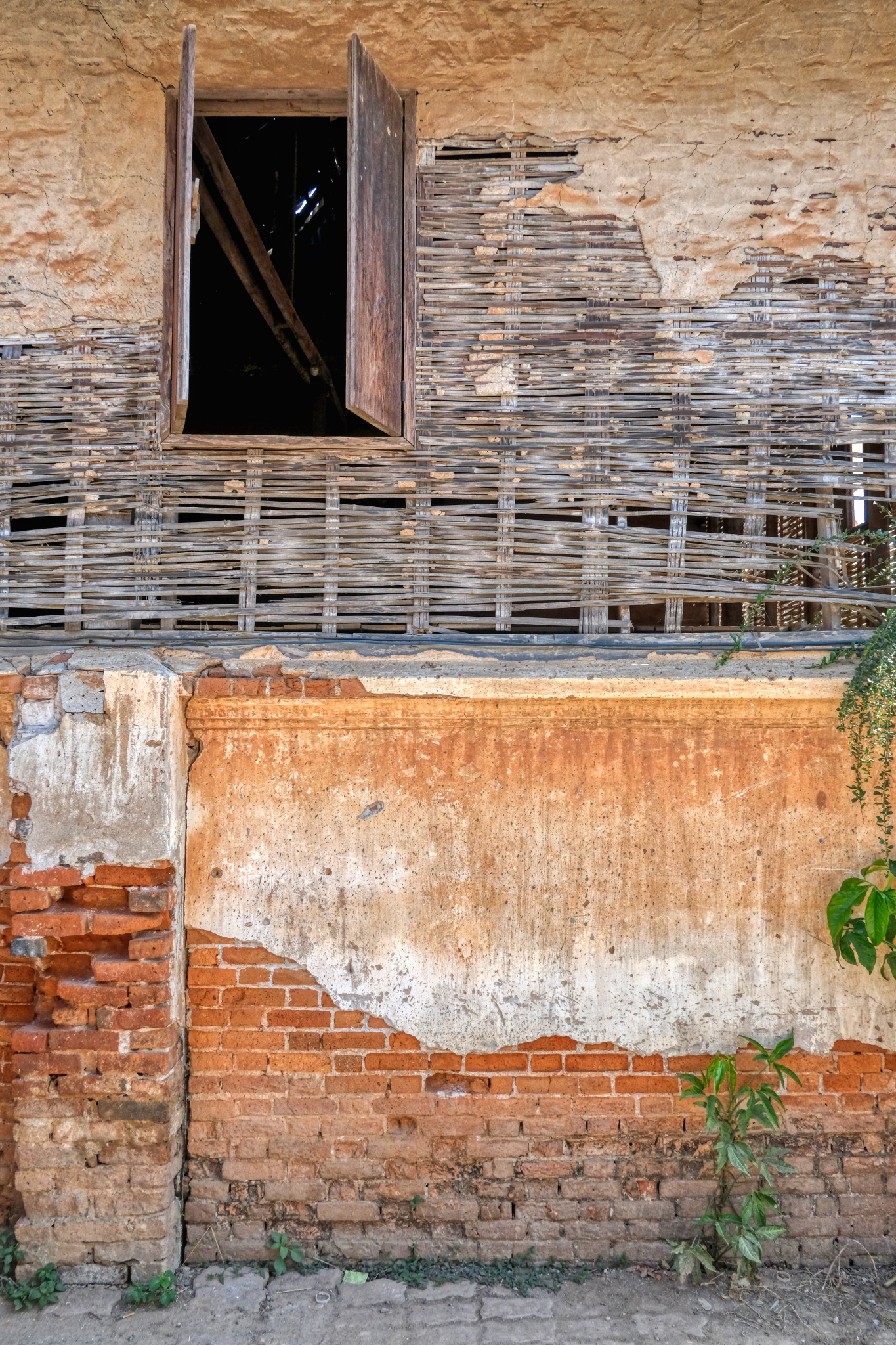 A very old wall revealing ancient building techniques.
A very old wall revealing ancient building techniques.
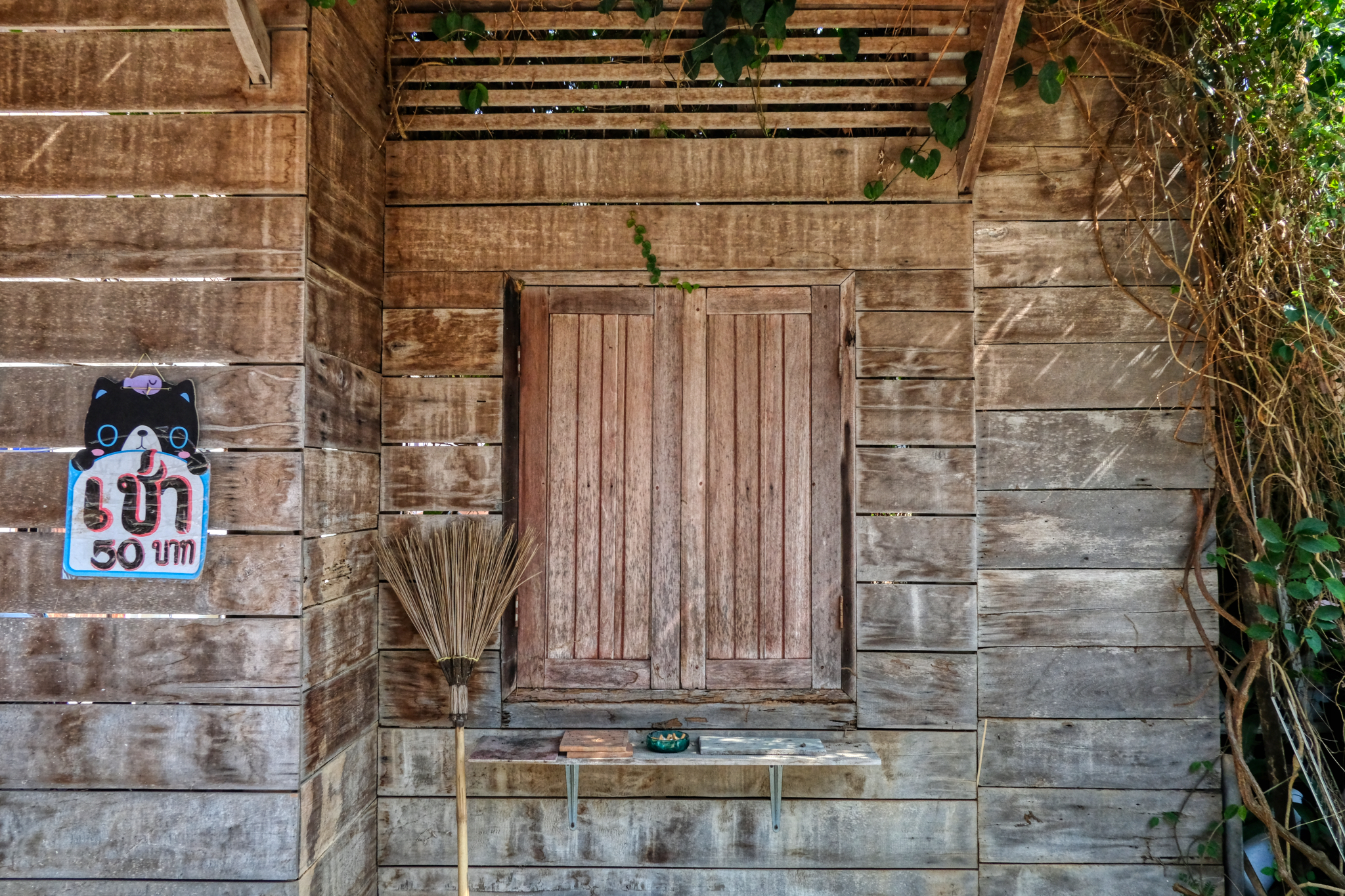 Wooden wall with broom and ash tray.
Wooden wall with broom and ash tray.
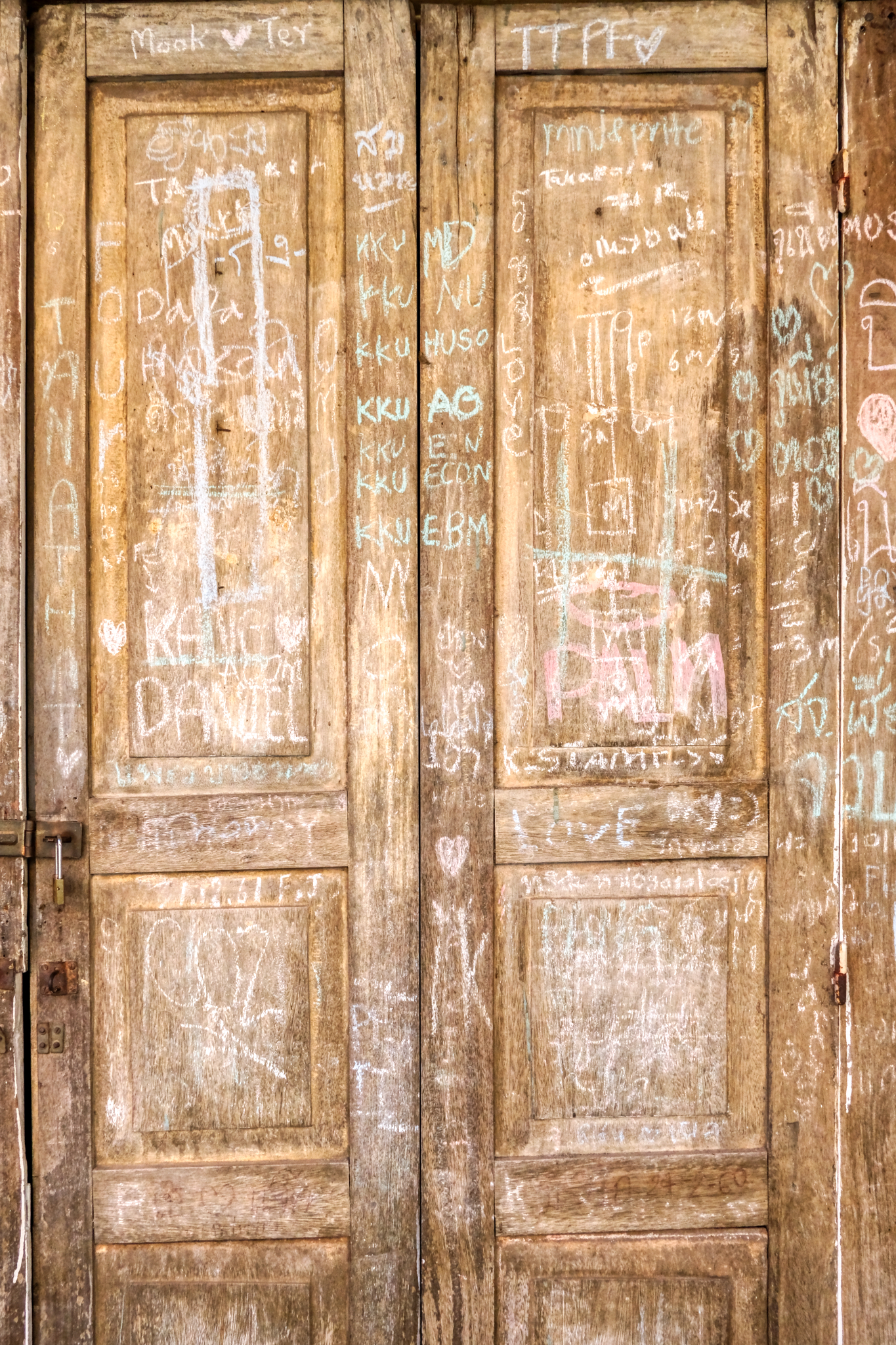 Chalk graffiti on old panel shop doors . . . there is a story here.
Chalk graffiti on old panel shop doors . . . there is a story here.
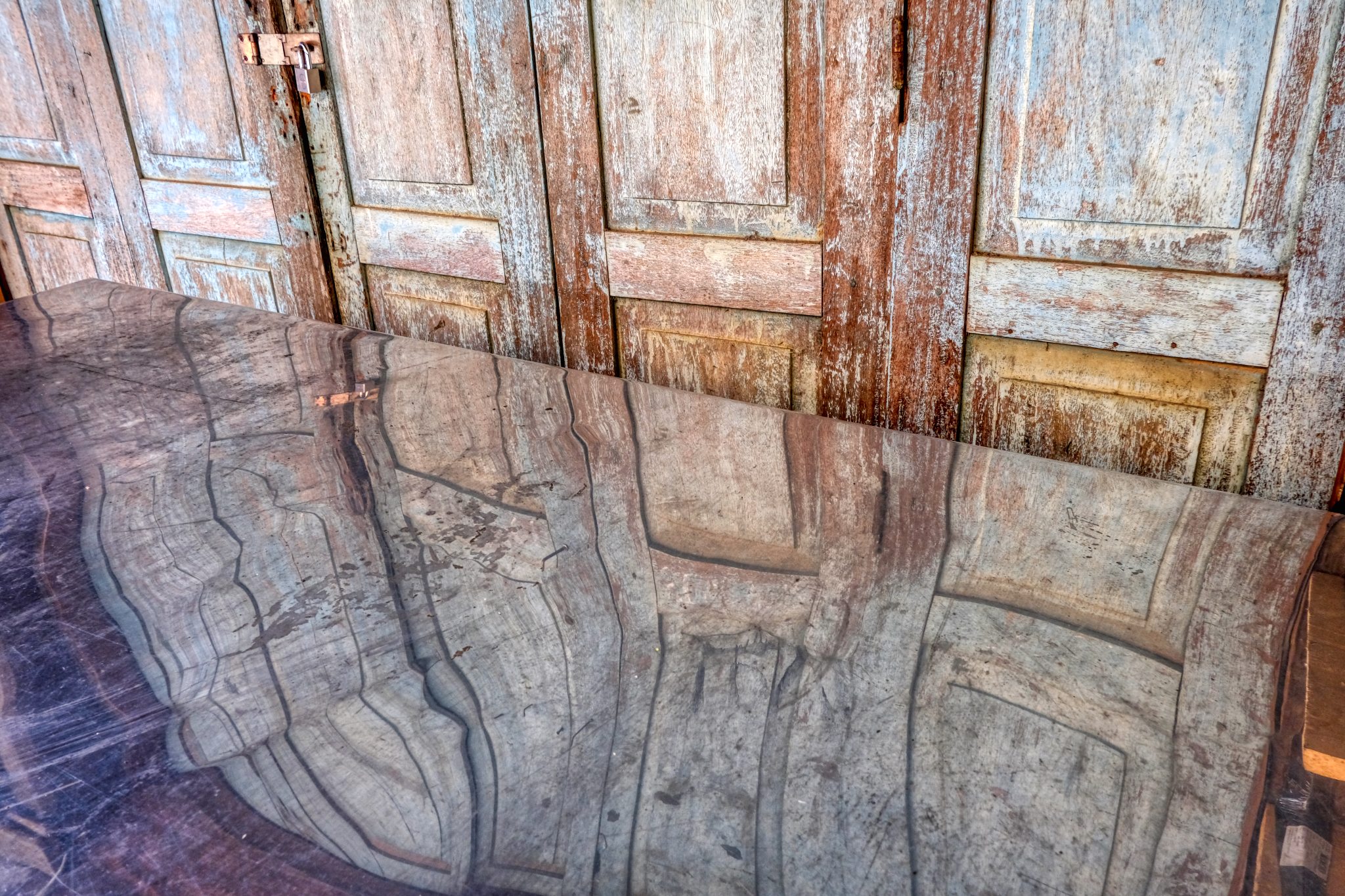 Old panel shop doors reflected in a stainless steel table. Nice. These "still life" photo opportunities were endless in Chiang Khan.
Old panel shop doors reflected in a stainless steel table. Nice. These "still life" photo opportunities were endless in Chiang Khan.
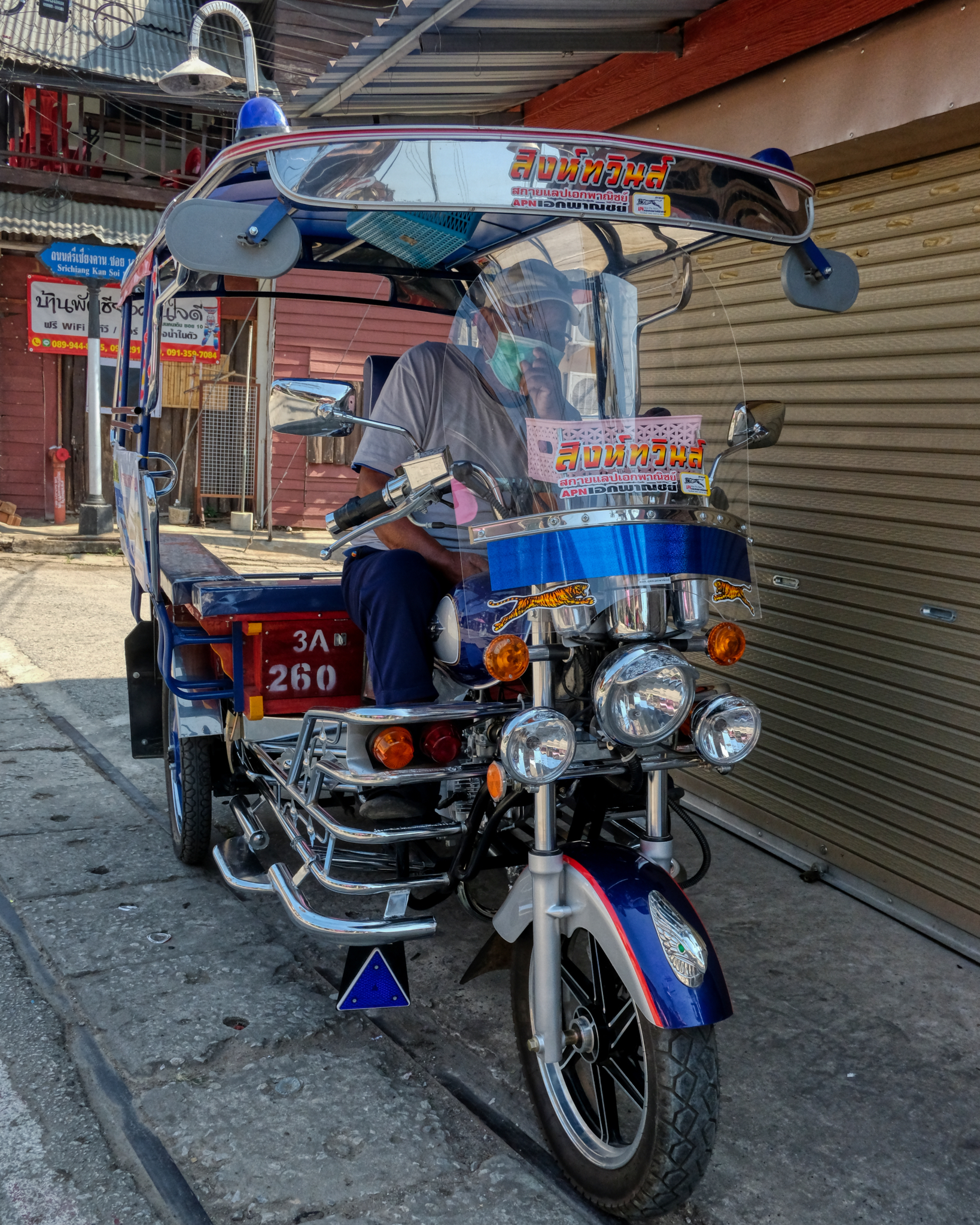 A very nice tuk-tuk, although I never saw anybody riding in one . . . everybody walked around the little town.
A very nice tuk-tuk, although I never saw anybody riding in one . . . everybody walked around the little town.
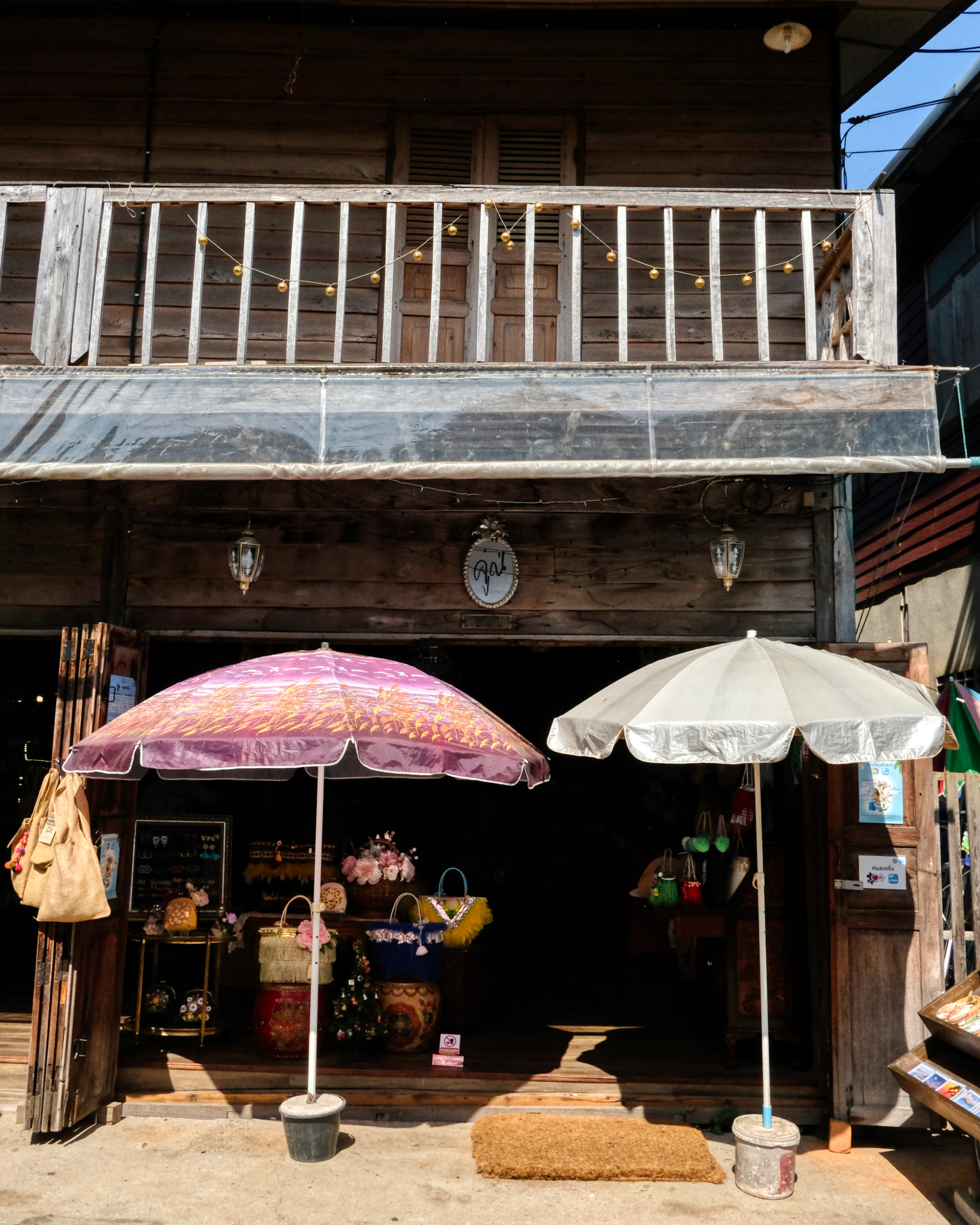 We were getting tired and sore walking around the sweet town . . . deciding what to do next . . .
We were getting tired and sore walking around the sweet town . . . deciding what to do next . . .
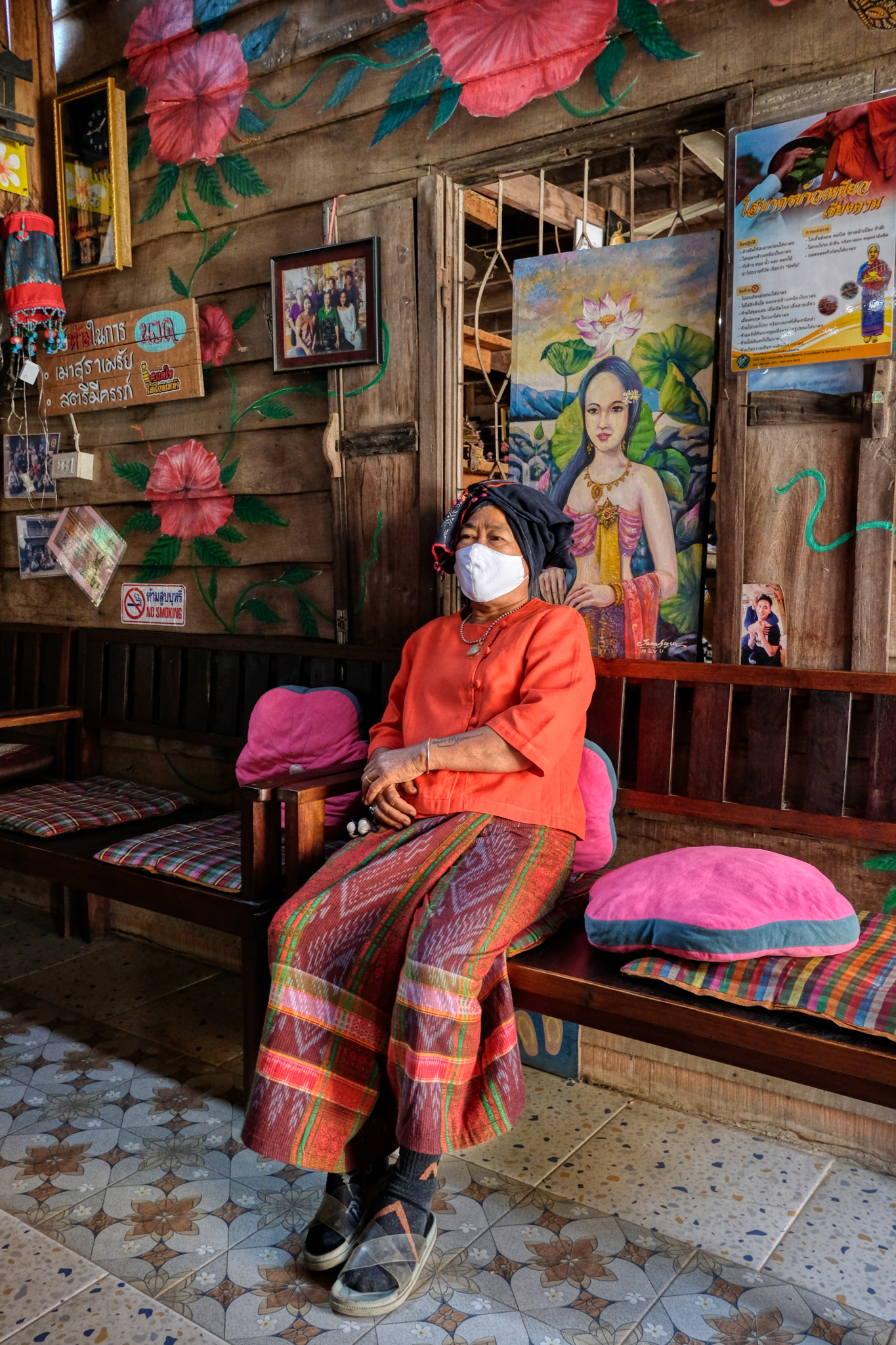 Massage! That's what's next!! The massage shop owner was very kind.
Massage! That's what's next!! The massage shop owner was very kind.
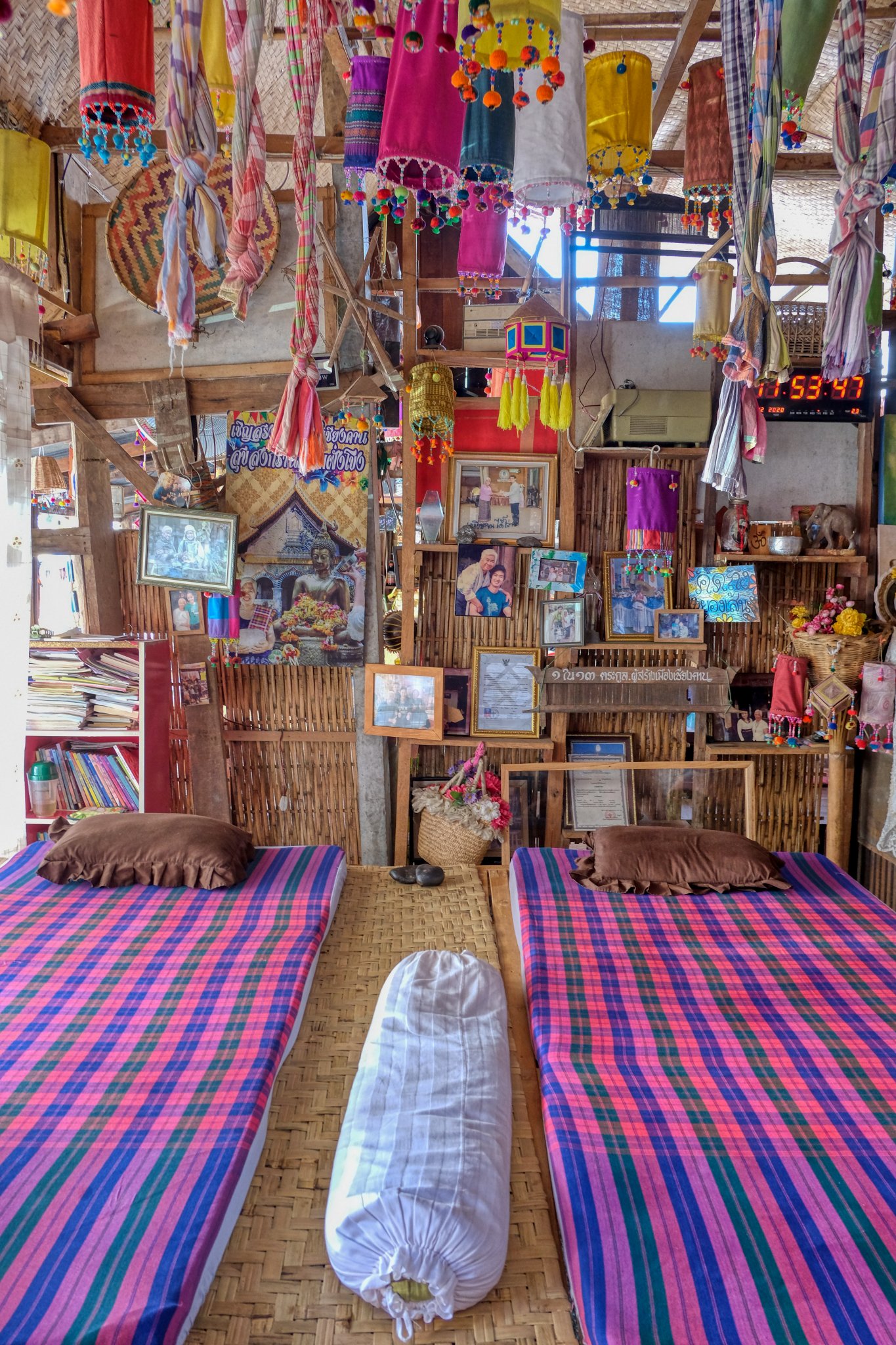 a 2 1/2 hour Thai massage will cure whatever ails you, that's for sure! This street side massage room was so beautiful. Just breathtaking!
a 2 1/2 hour Thai massage will cure whatever ails you, that's for sure! This street side massage room was so beautiful. Just breathtaking!
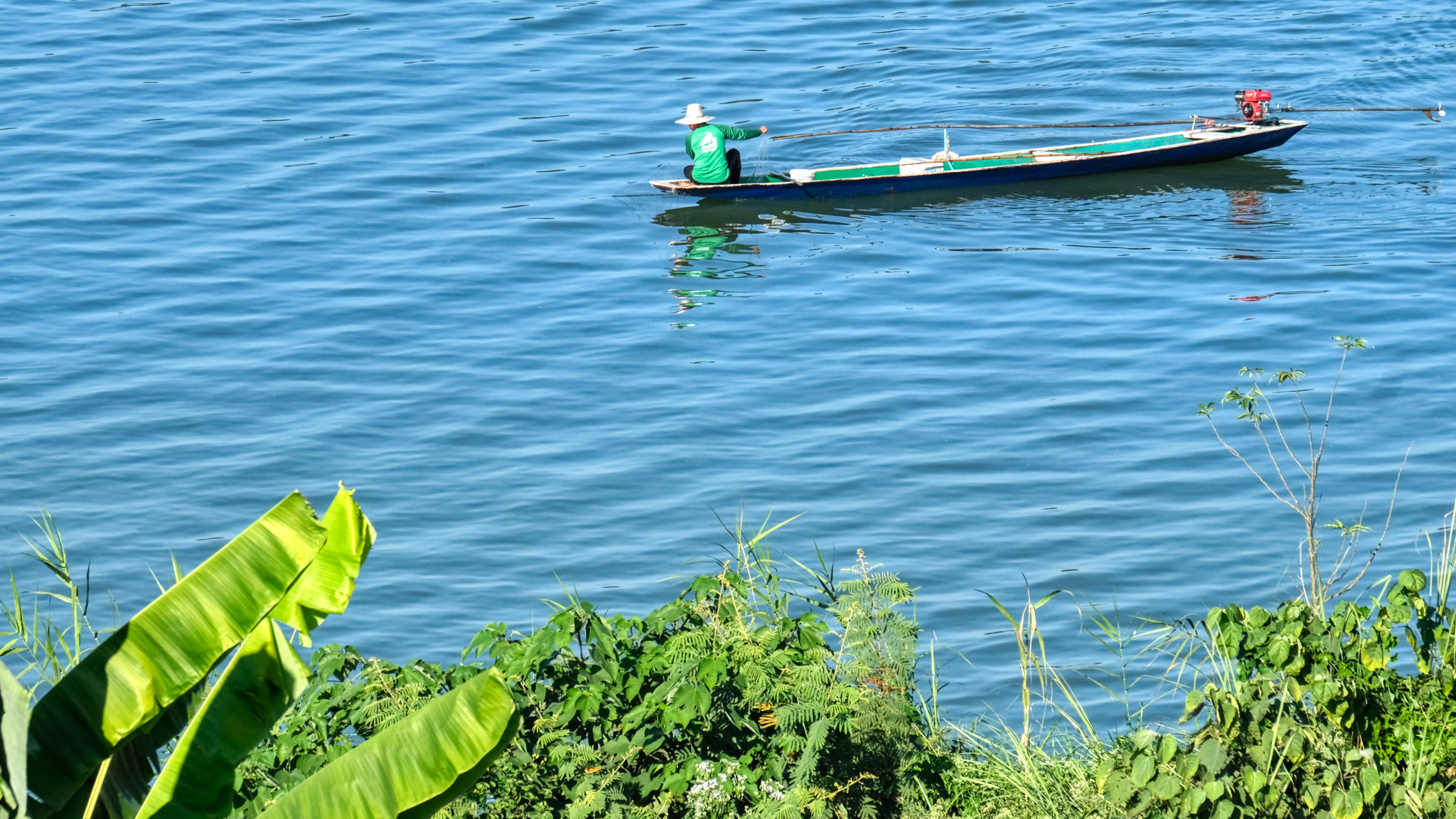 We spent part of our days walking along a path next to the Mekong River.
We spent part of our days walking along a path next to the Mekong River.
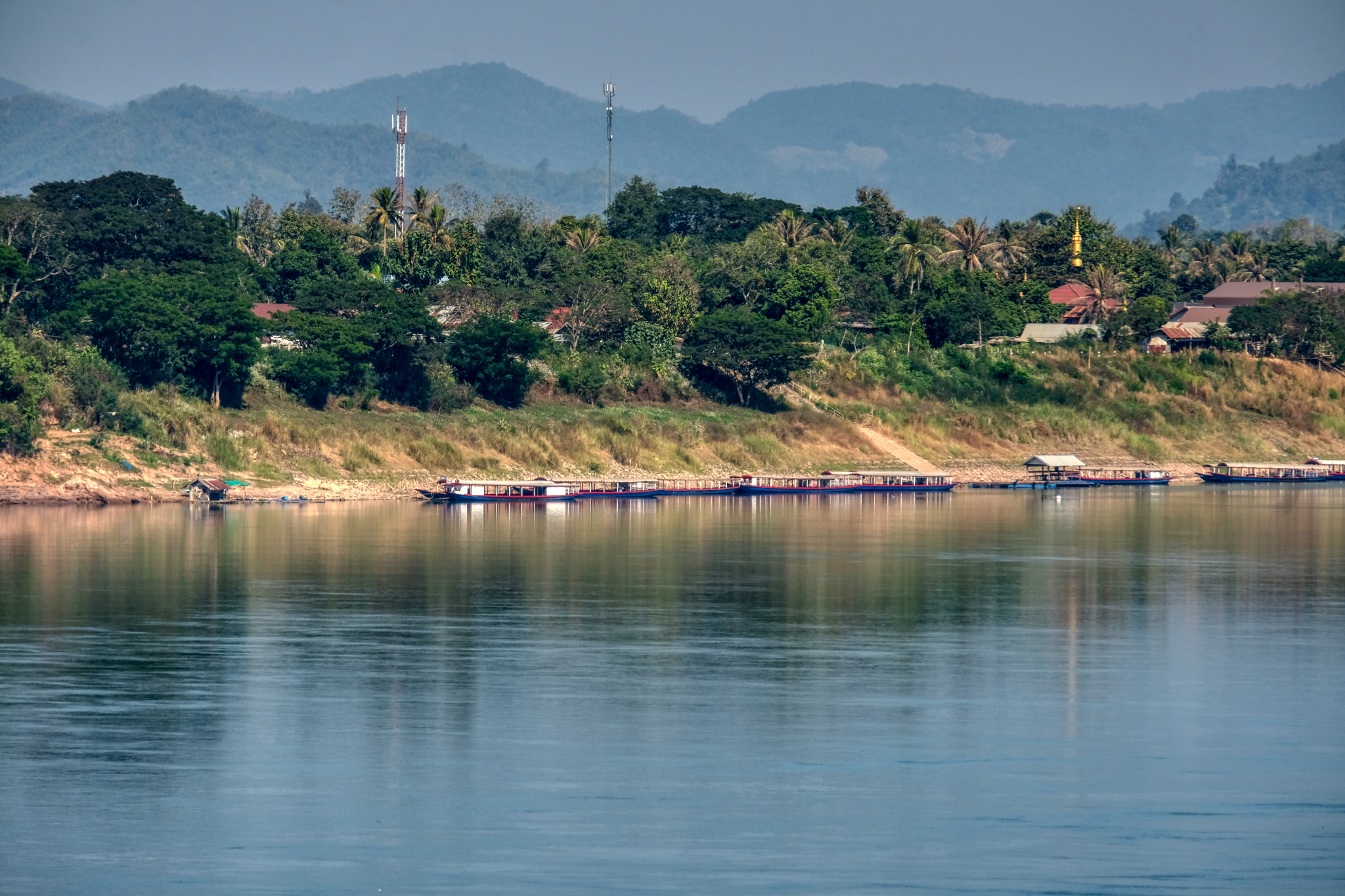 Looking across the Mekong toward the 'wild side' of Laos.
Looking across the Mekong toward the 'wild side' of Laos.
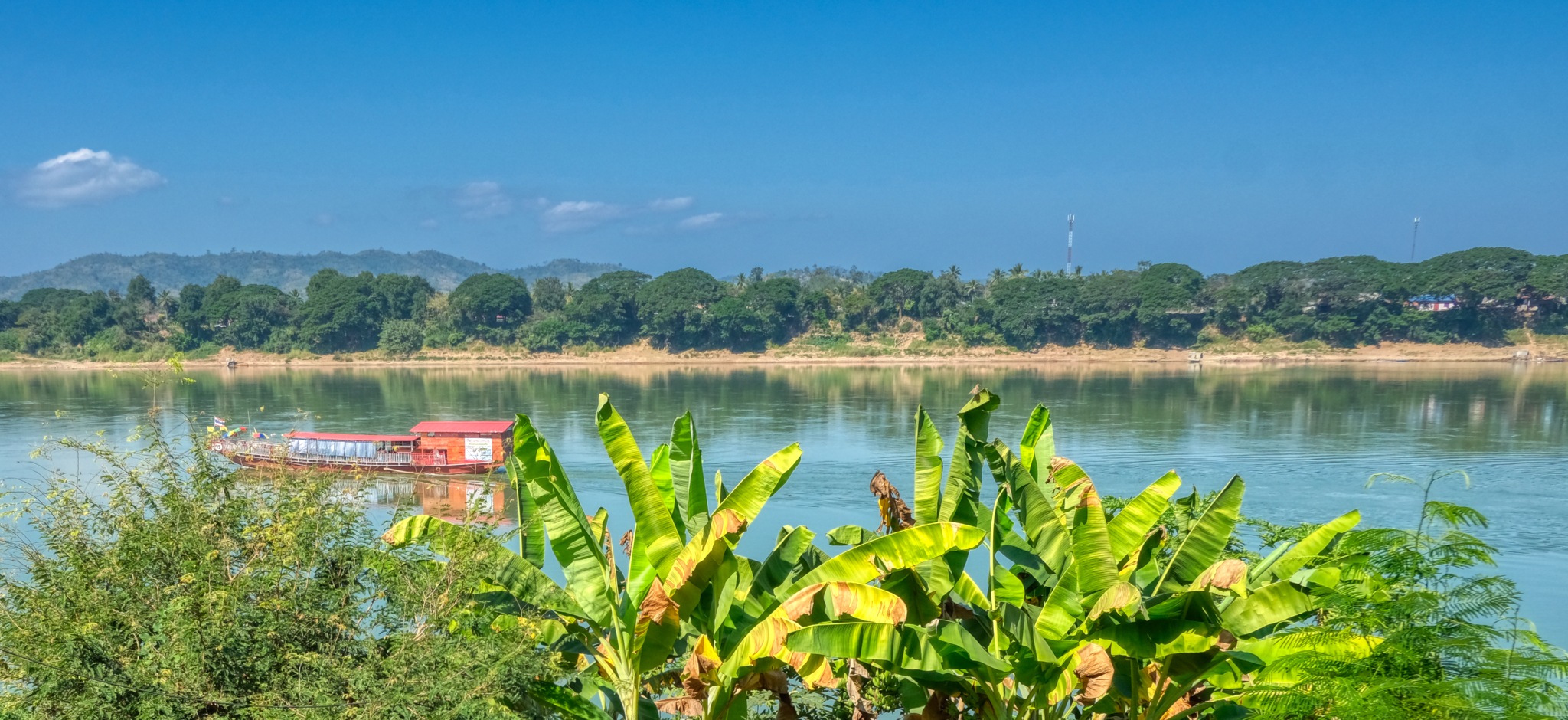 Riverboat ferry both local people and tourists up and down the river.
Riverboat ferry both local people and tourists up and down the river.
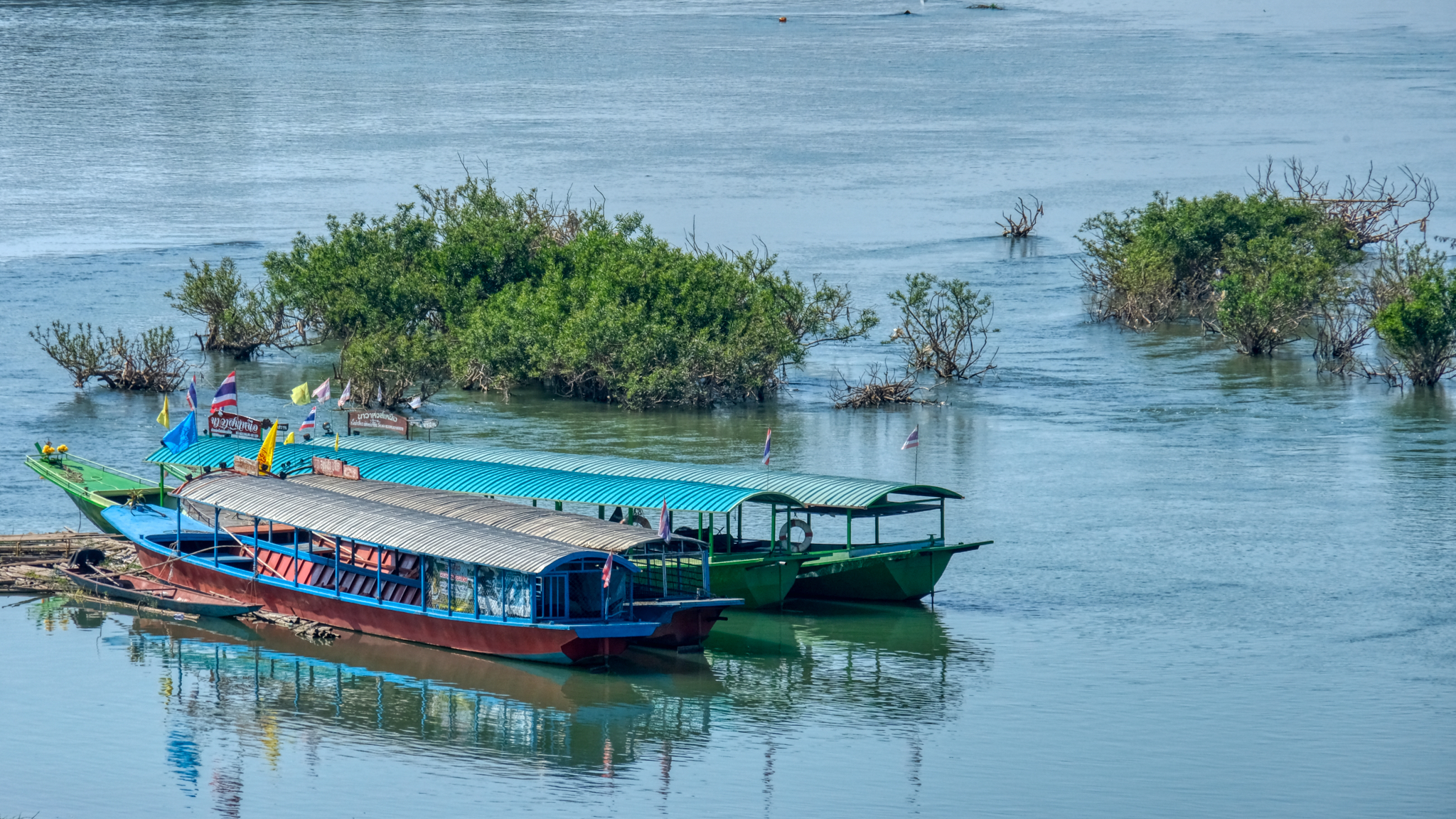 Mekong River boats at the ready.
Mekong River boats at the ready.
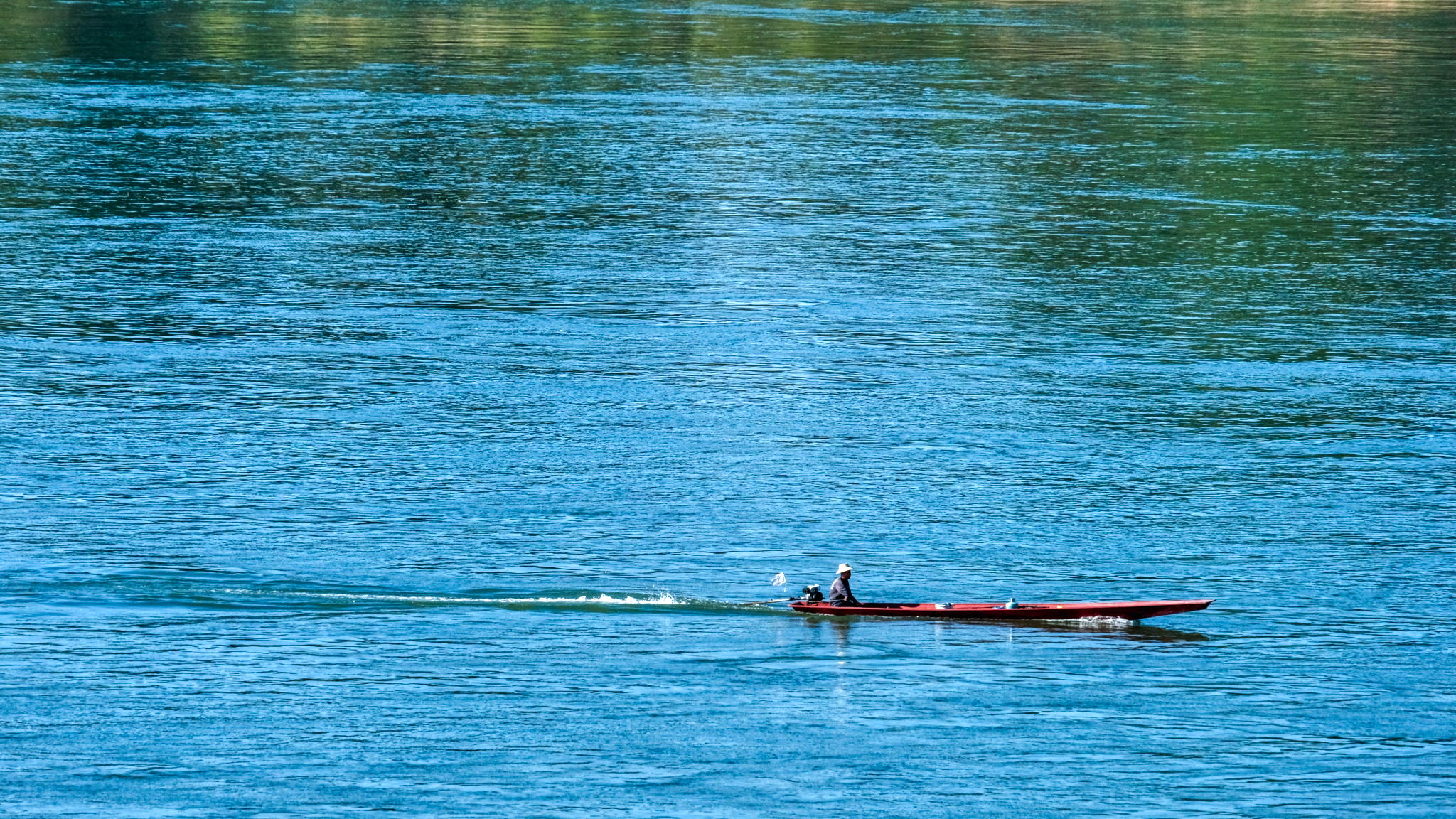 A fisherman going home. Surprisingly, I did not see very many fishermen out on the river.
A fisherman going home. Surprisingly, I did not see very many fishermen out on the river.
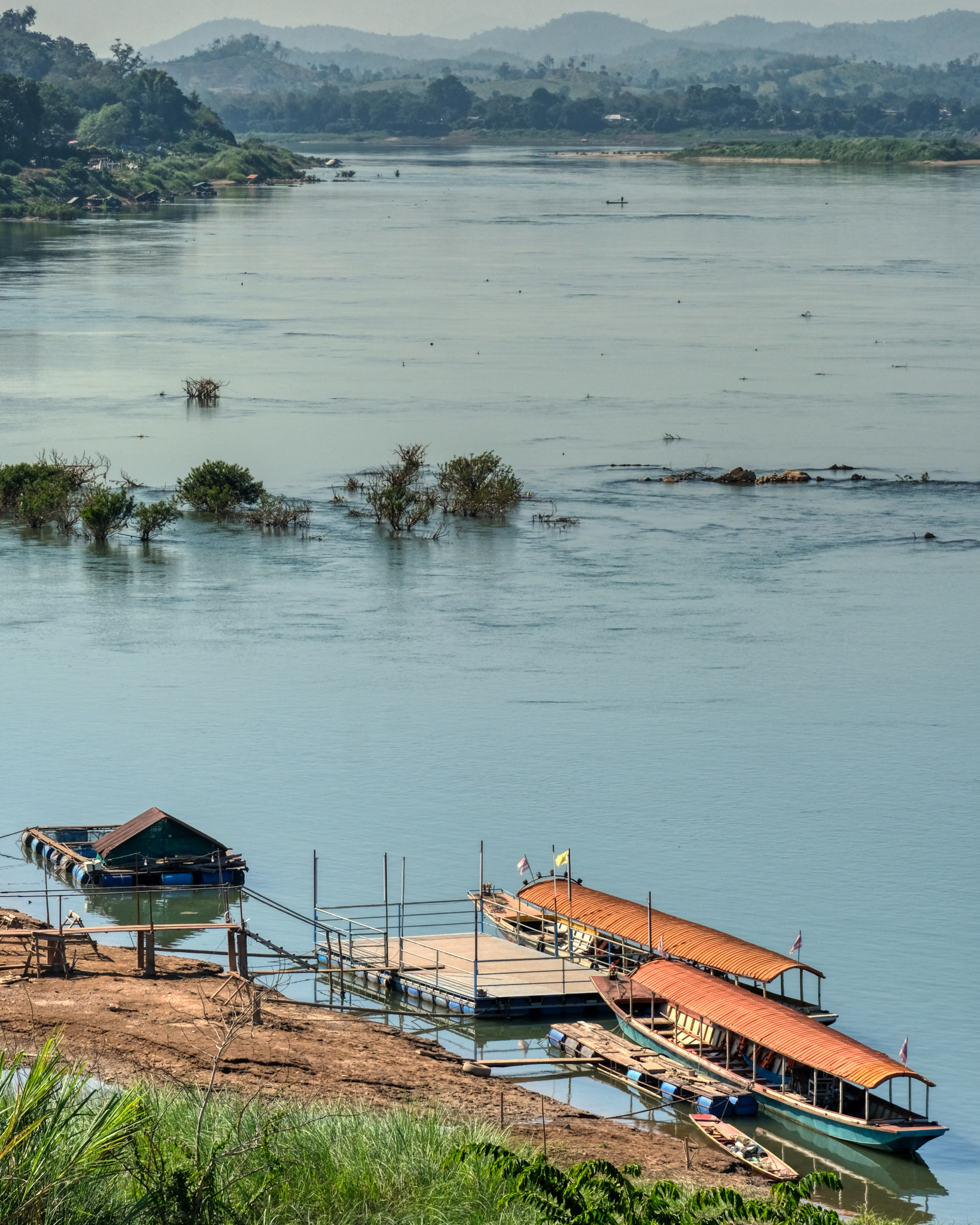 The fiew upriver toward the smoky Lao hills from Chiang Khan.
The fiew upriver toward the smoky Lao hills from Chiang Khan.
 When the sun set we headed to the night market street.
When the sun set we headed to the night market street.
CHIANG KHAN by NIGHT
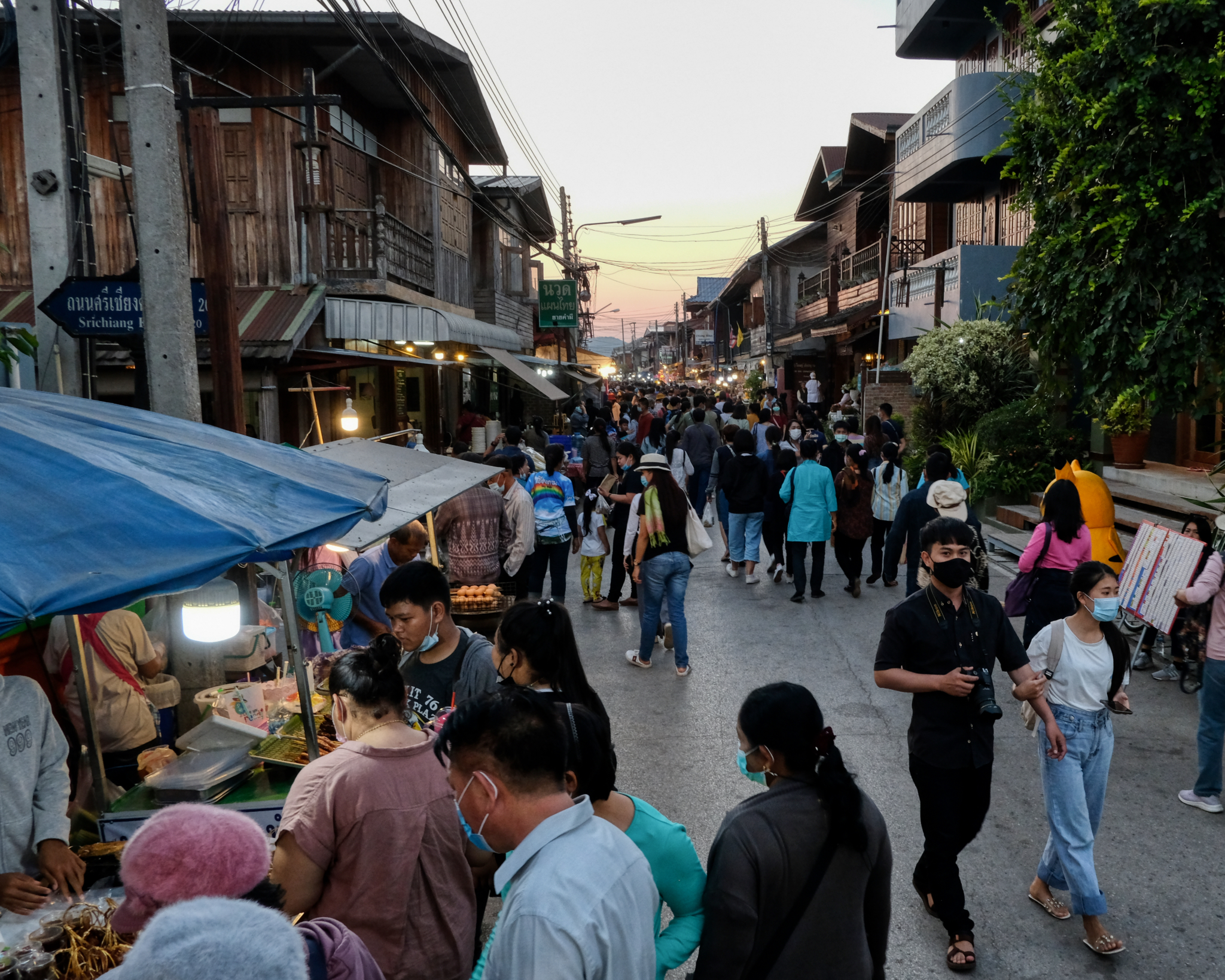 As the light faded, and the heat dissipated, it seemed that every Thai tourist in town left their guesthouse and headed to the main walking street.
As the light faded, and the heat dissipated, it seemed that every Thai tourist in town left their guesthouse and headed to the main walking street.
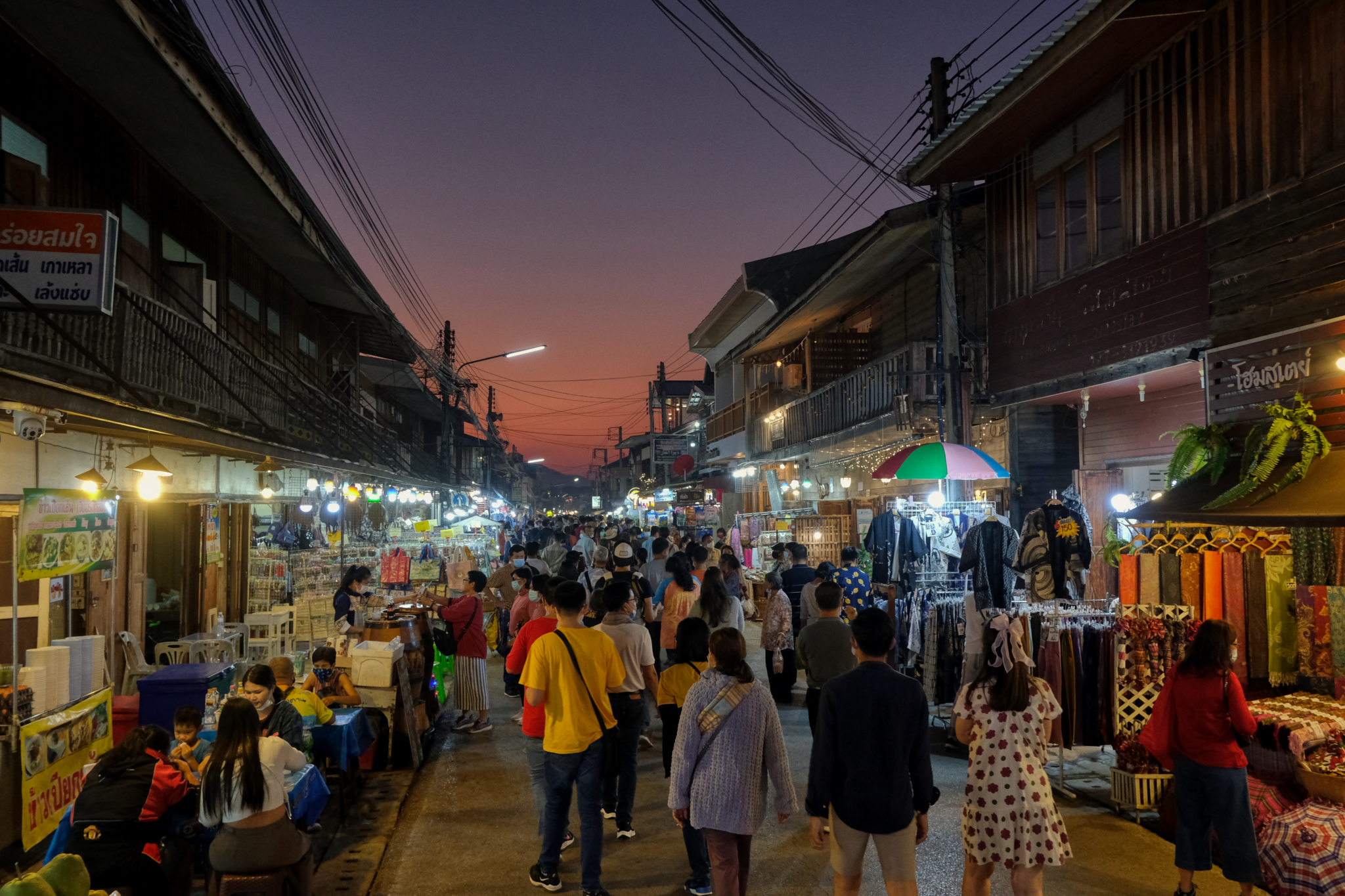 The darker it got, the bigger the crowd under the colorful, and fading sky.
The darker it got, the bigger the crowd under the colorful, and fading sky.
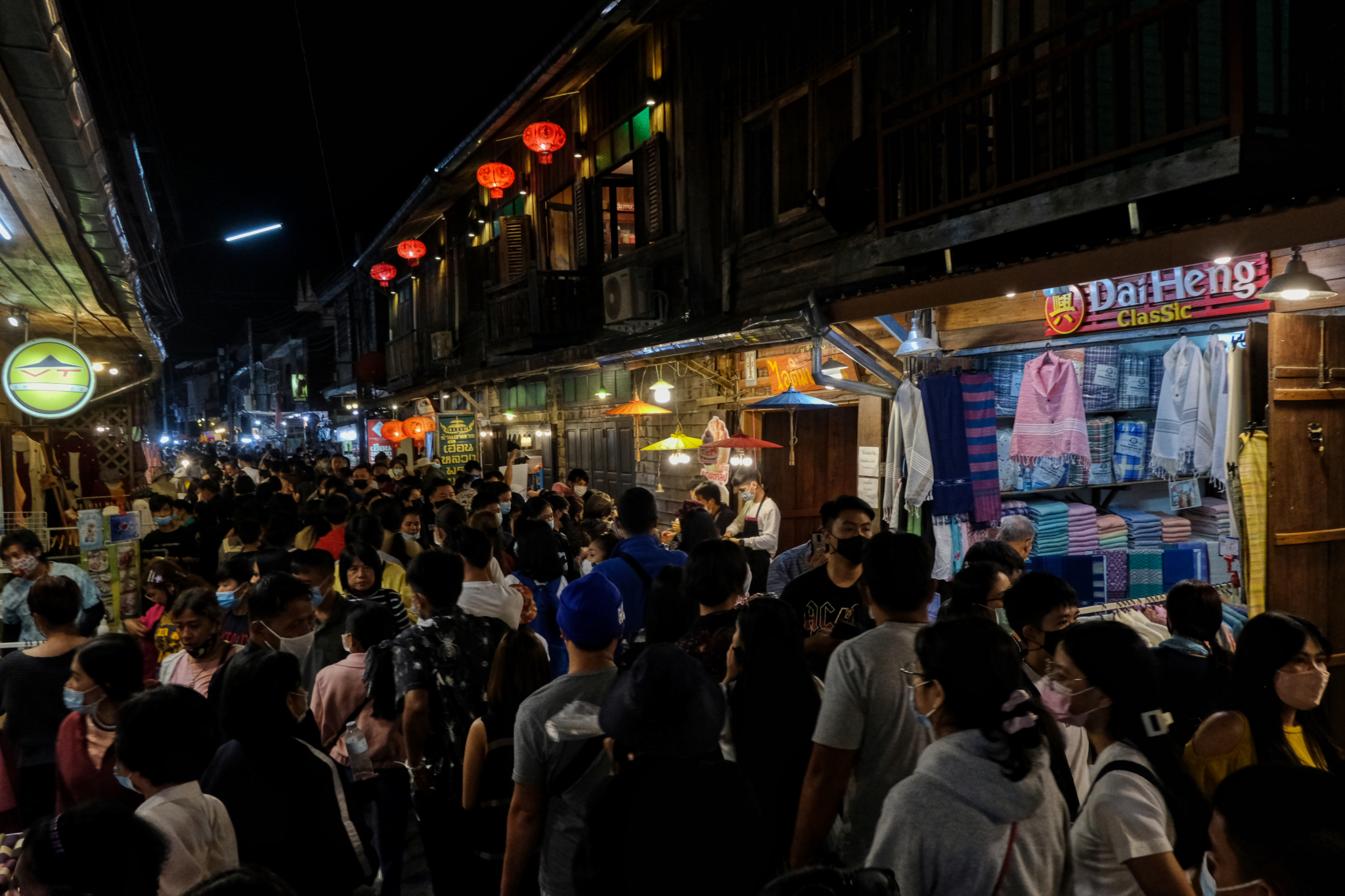 At last the sun had fully set.
At last the sun had fully set.
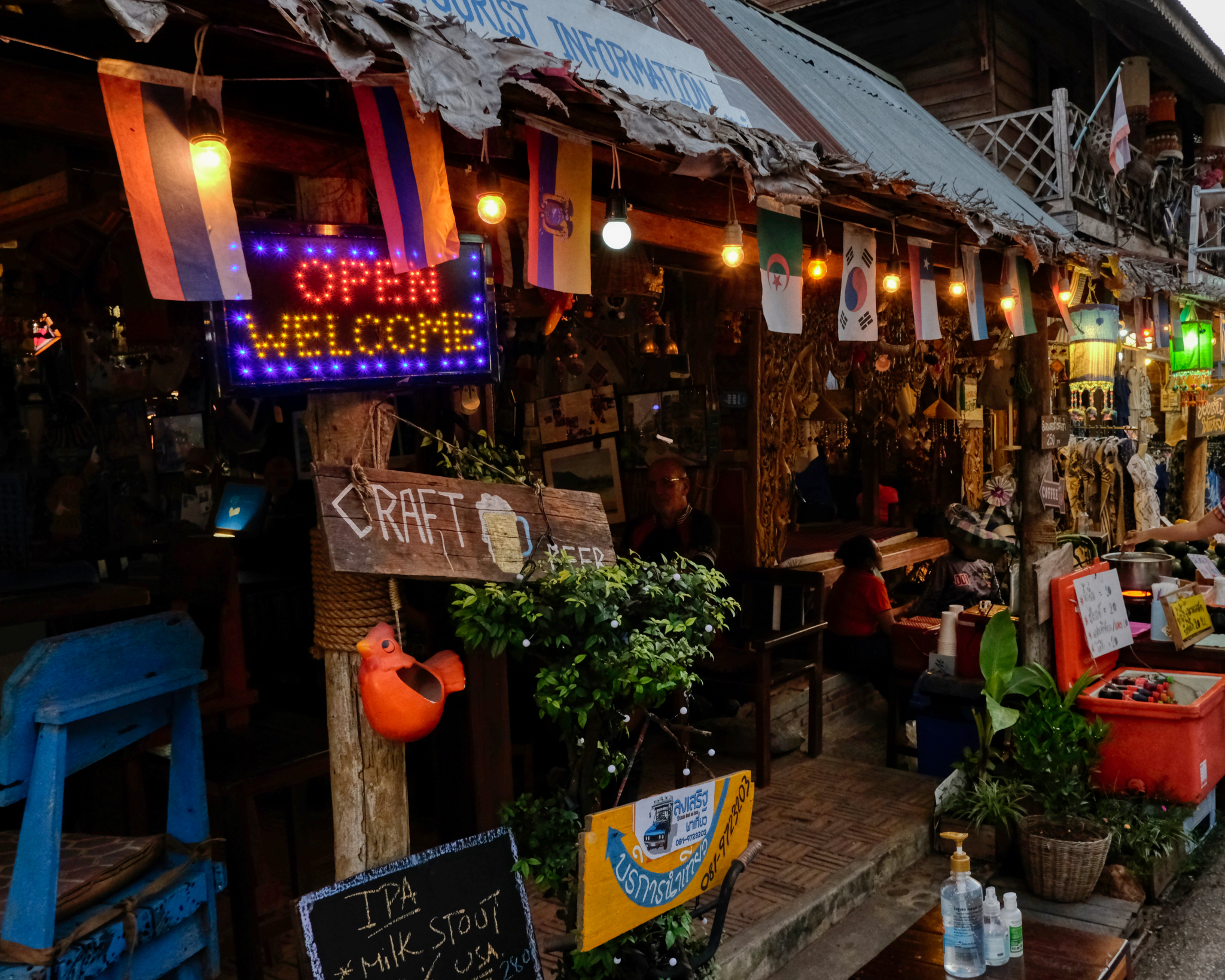 Many of the shops, restaurants, and bars that were closed in the afternoon opened for the throngs that came out at night. This craft beer joint was a welcome stop for me.
Many of the shops, restaurants, and bars that were closed in the afternoon opened for the throngs that came out at night. This craft beer joint was a welcome stop for me.
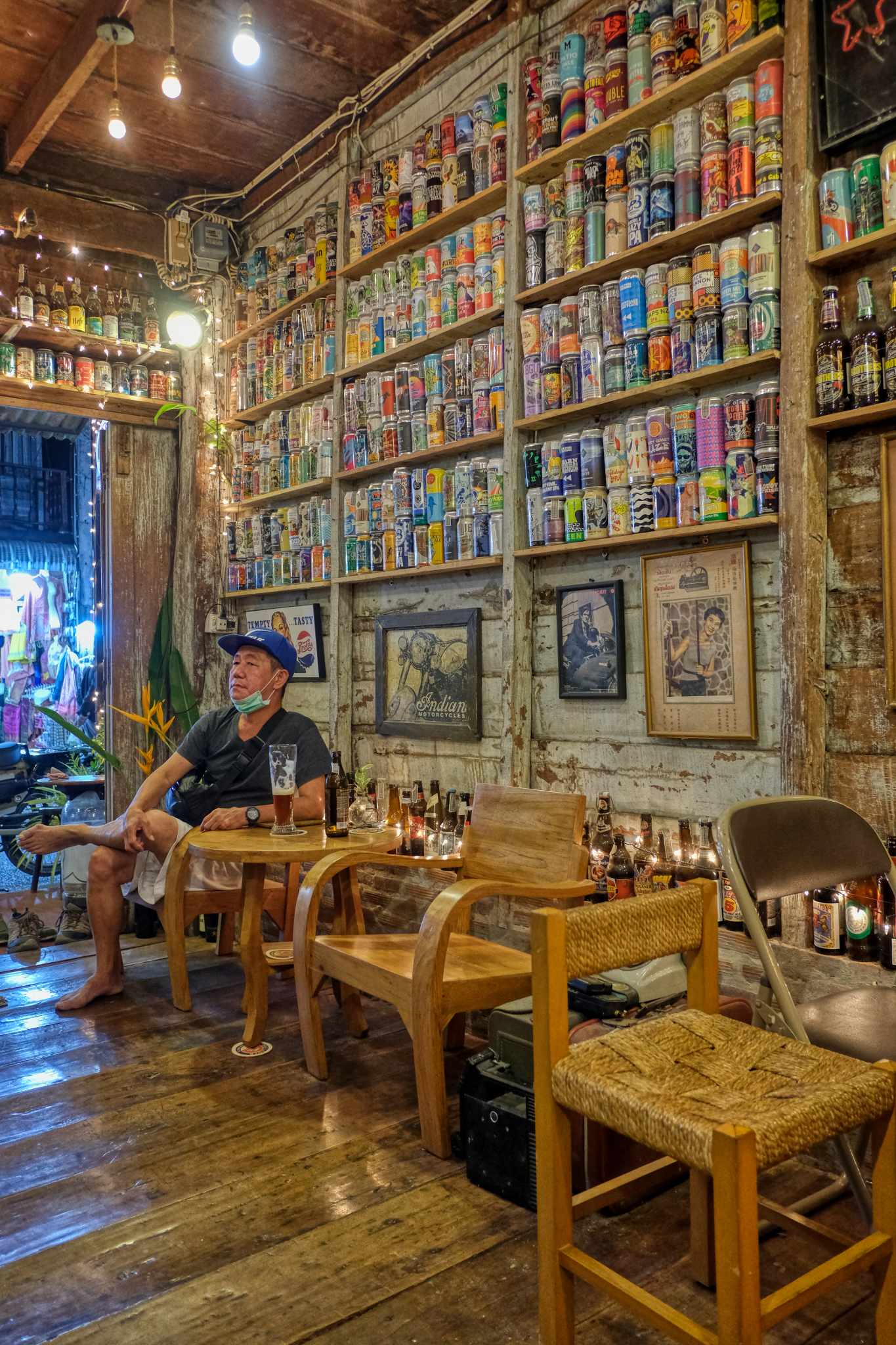 The interior of the craft beer hall.
The interior of the craft beer hall.
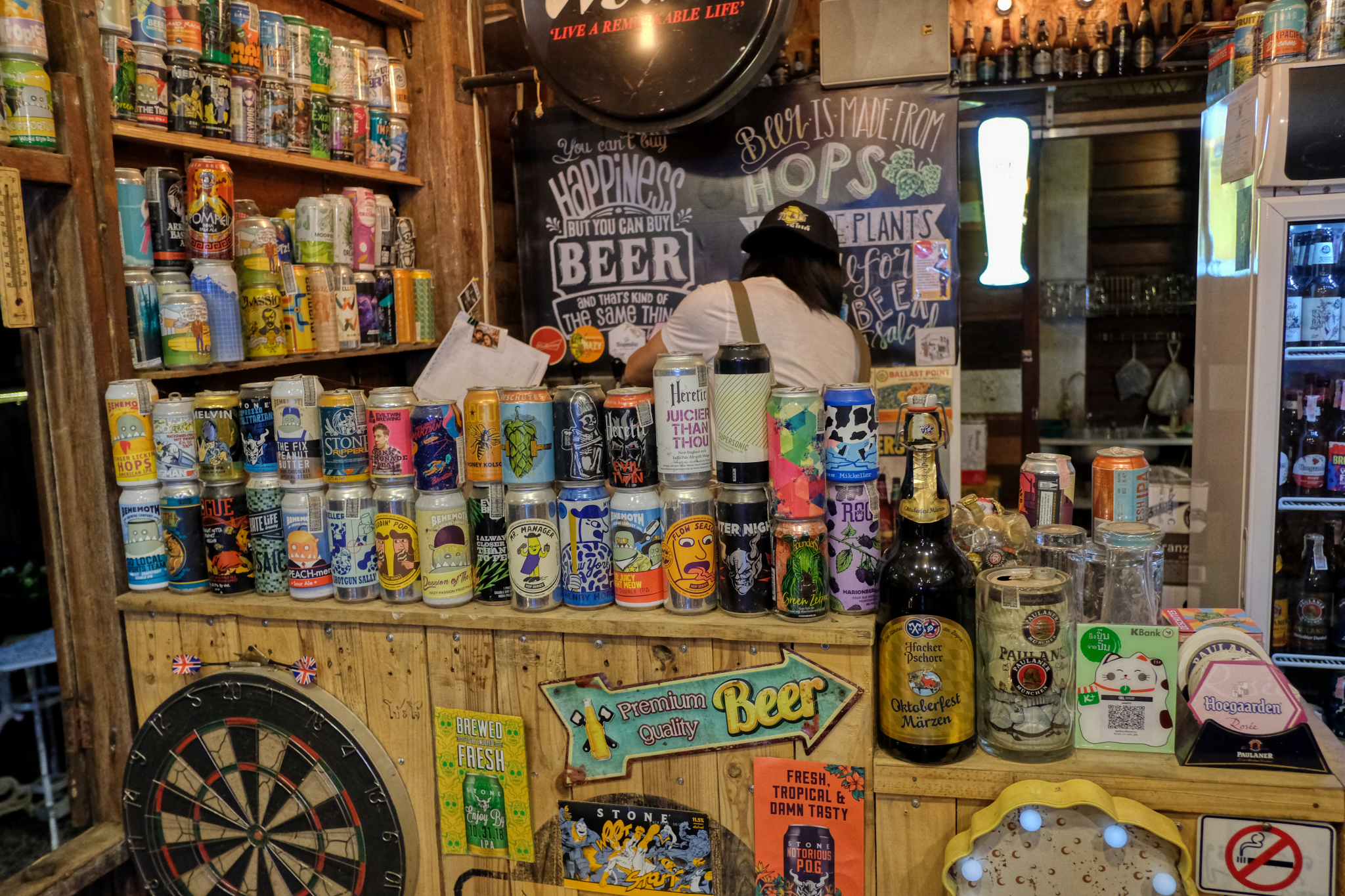 The Thai hippies who ran the craft beer hall had a fantastic collection of beers and ales to choose from.
The Thai hippies who ran the craft beer hall had a fantastic collection of beers and ales to choose from.
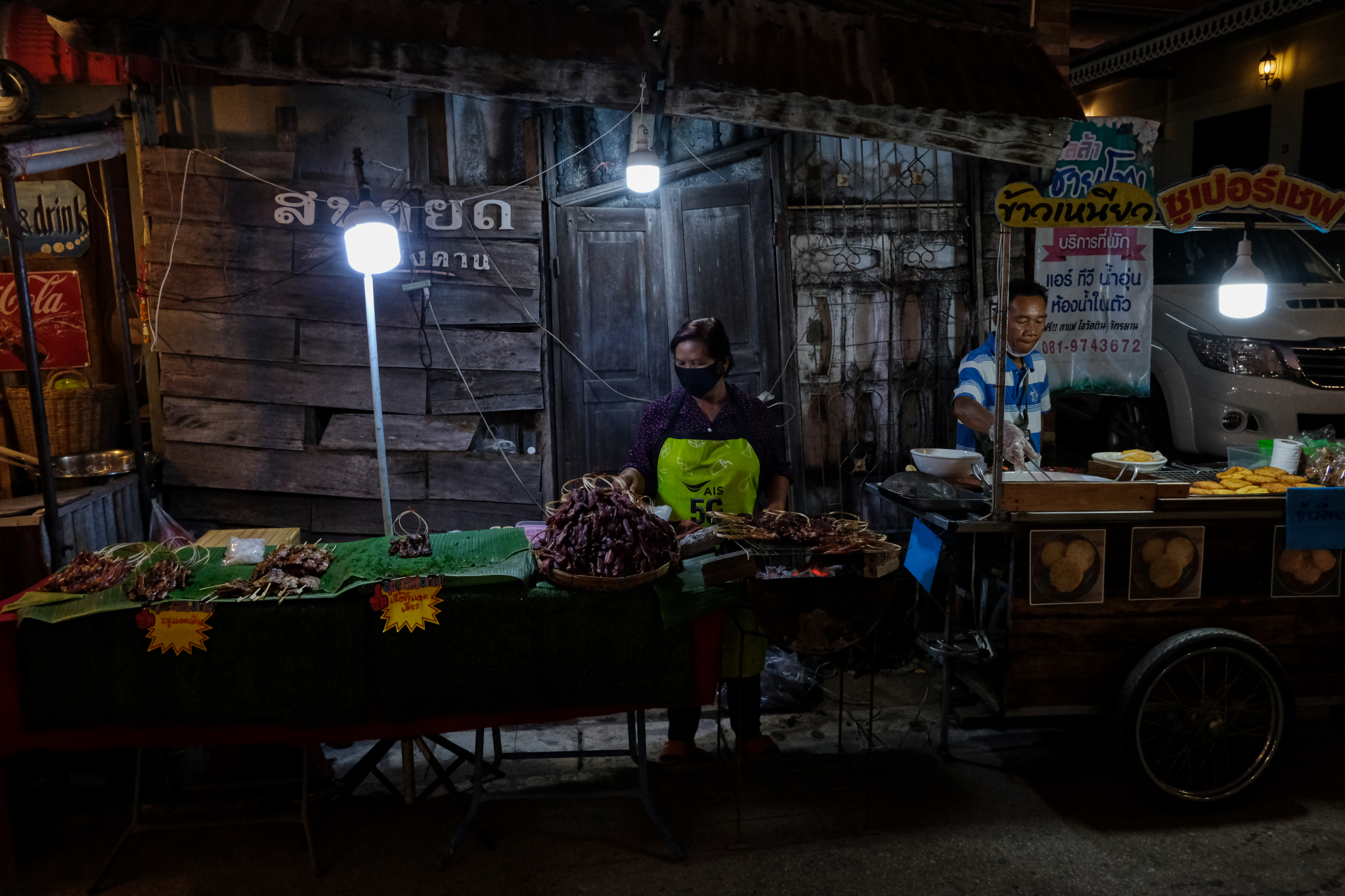 The town became even more photogenic at night. BBQ beef street hawkers.
The town became even more photogenic at night. BBQ beef street hawkers.
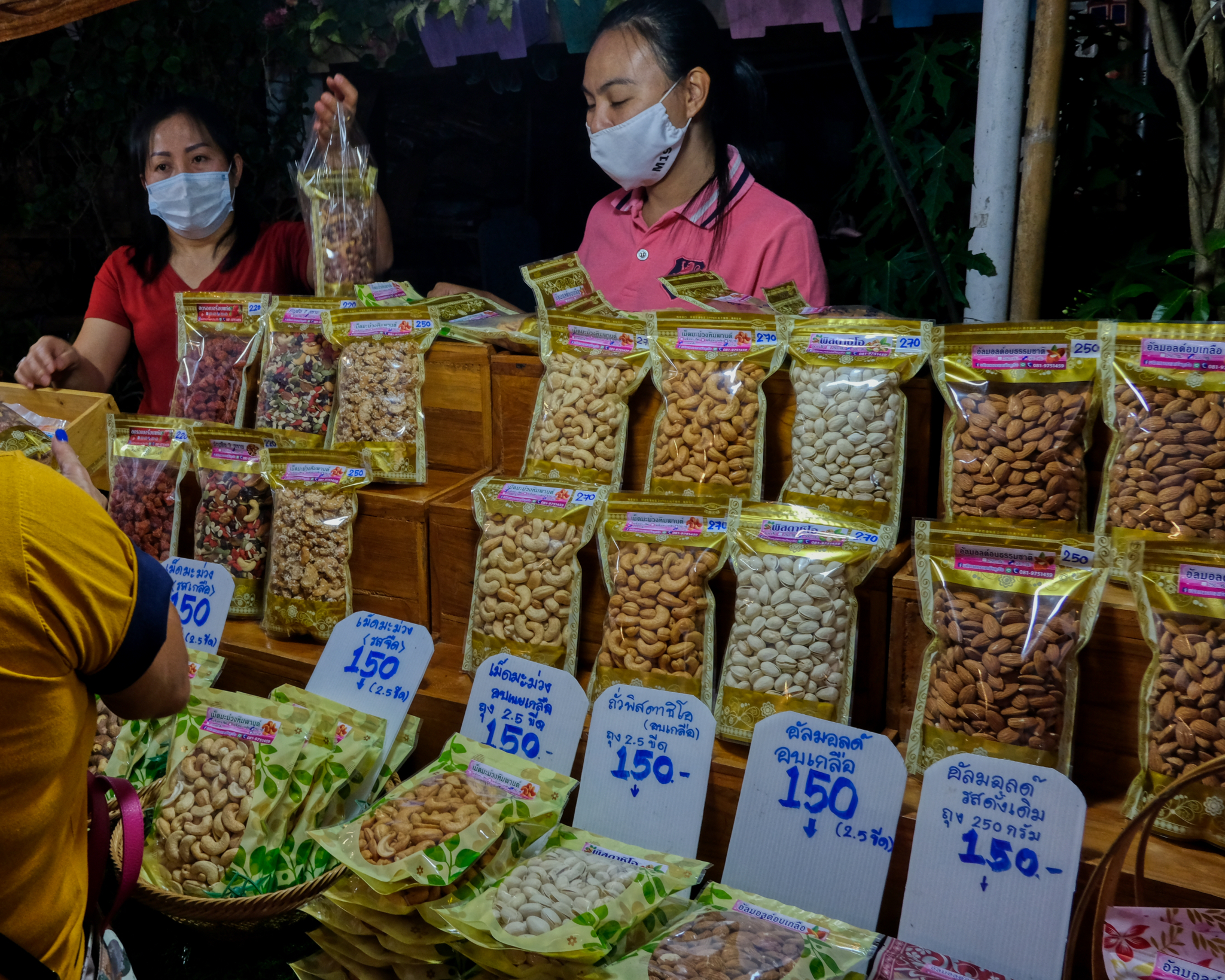 The many stalls set up along the night street became a 'night market' - a favorite of Thai people and visitors to Thailand. There was a wide variety of things for sale. Nuts! I love nuts!
The many stalls set up along the night street became a 'night market' - a favorite of Thai people and visitors to Thailand. There was a wide variety of things for sale. Nuts! I love nuts!
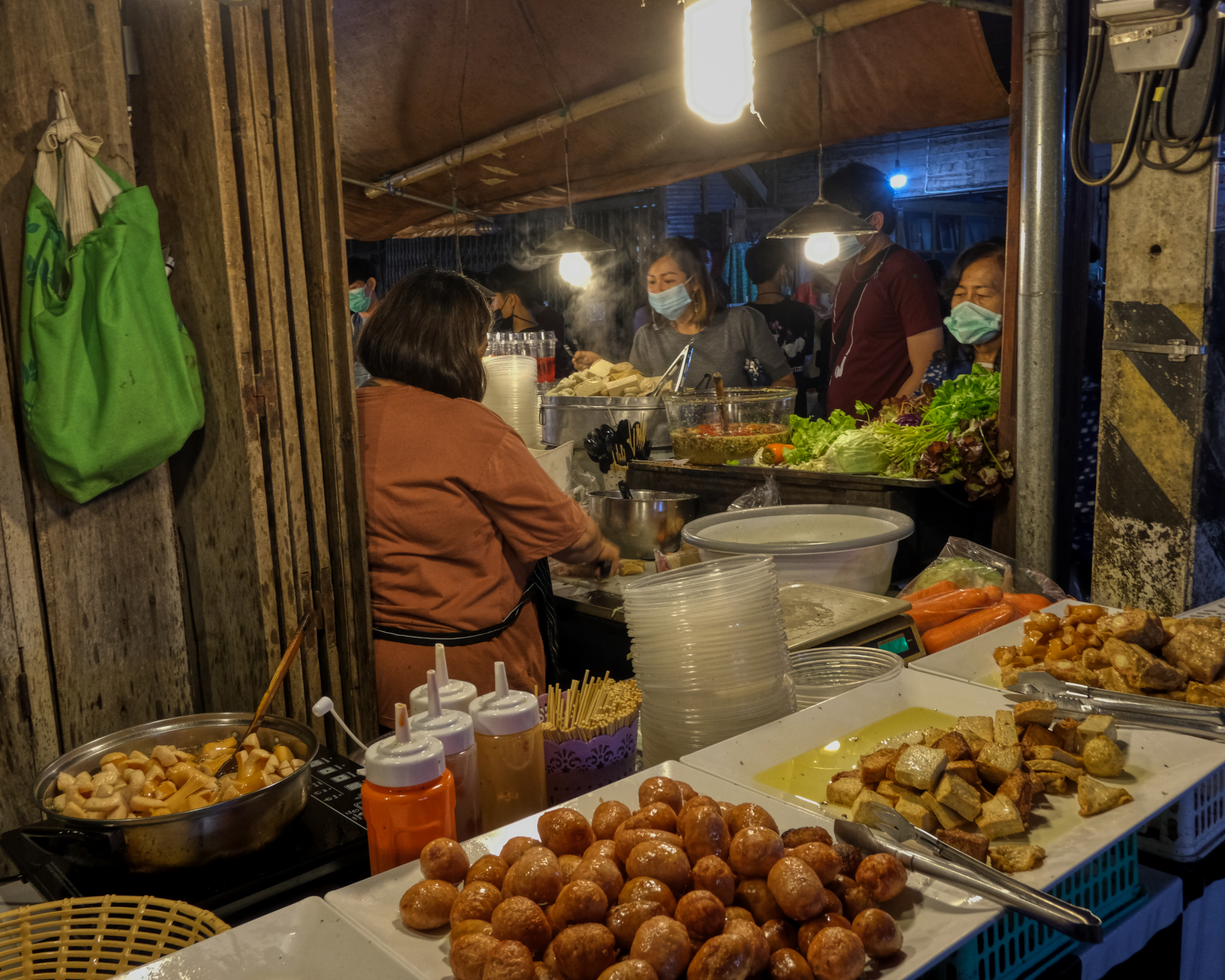 All the night market visitors brought their appetites . . . and were rewarded with a wide variety of delicious Thai specialties to eat.
All the night market visitors brought their appetites . . . and were rewarded with a wide variety of delicious Thai specialties to eat.
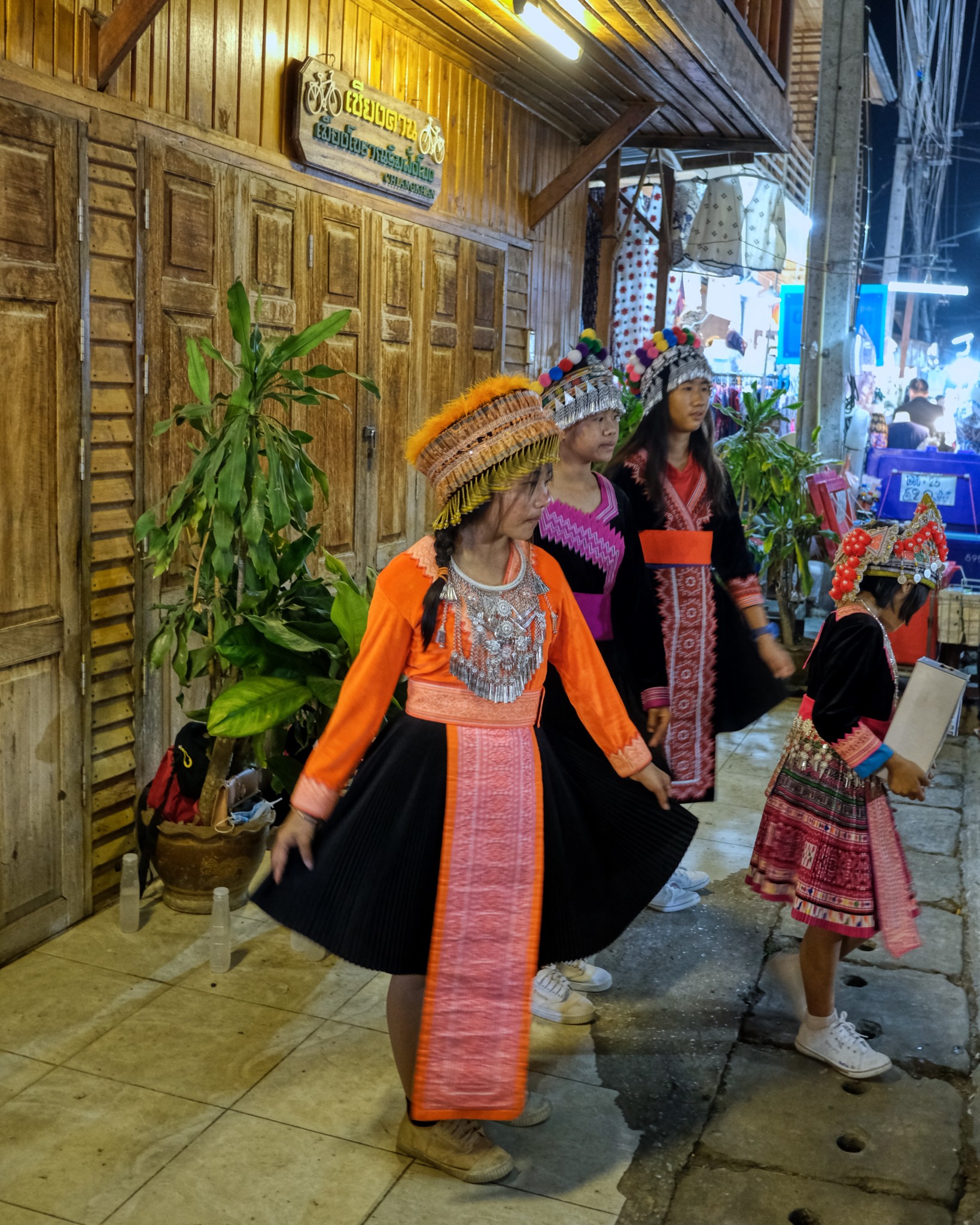 Street performers in their traditional 'hill tribe' costumes entertained the gathered crowds.
Street performers in their traditional 'hill tribe' costumes entertained the gathered crowds.
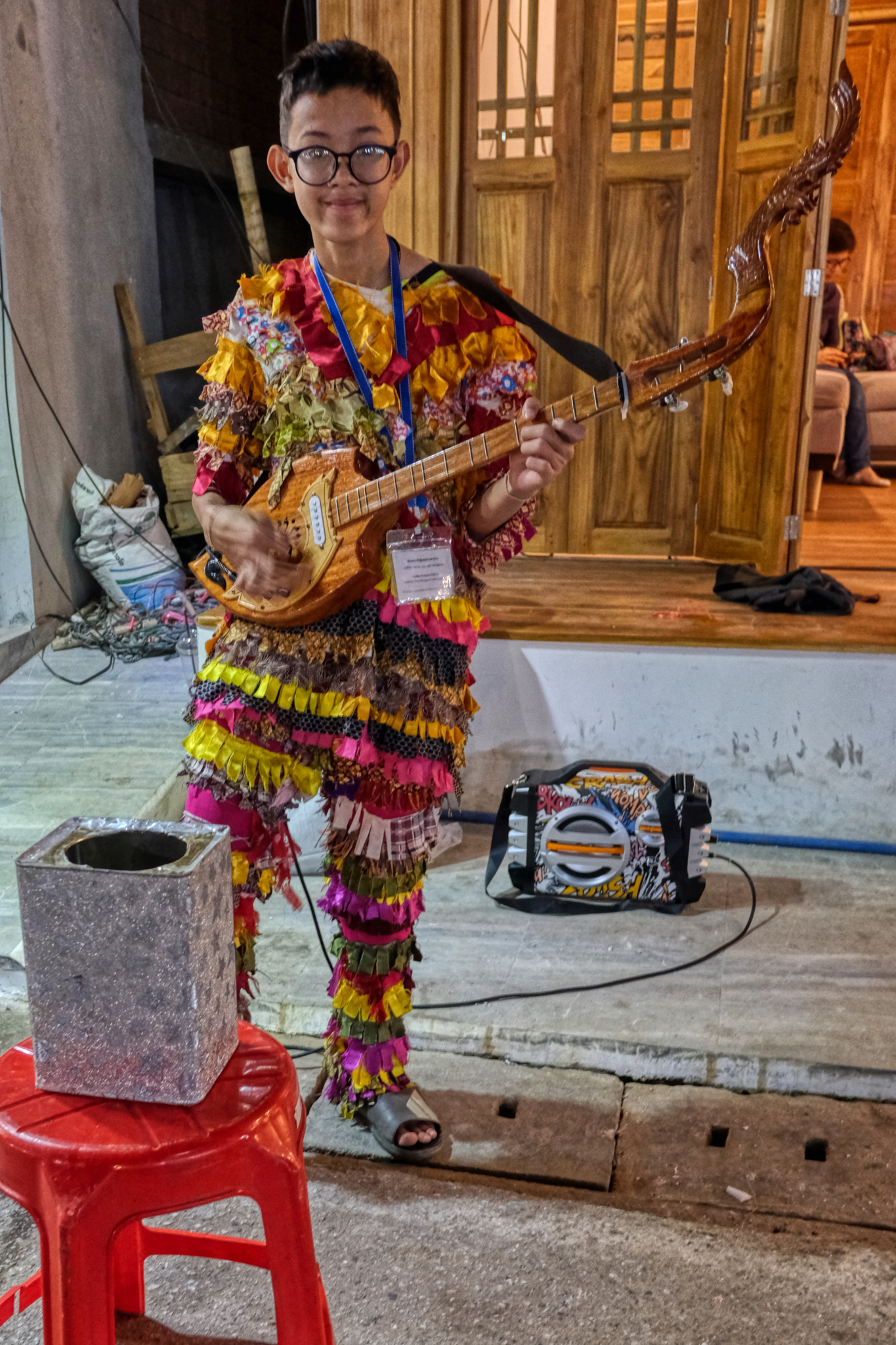 My favorite street performer was this young busker playing electrified traditional old Thai music in a homemade outfit. Cool.
My favorite street performer was this young busker playing electrified traditional old Thai music in a homemade outfit. Cool.
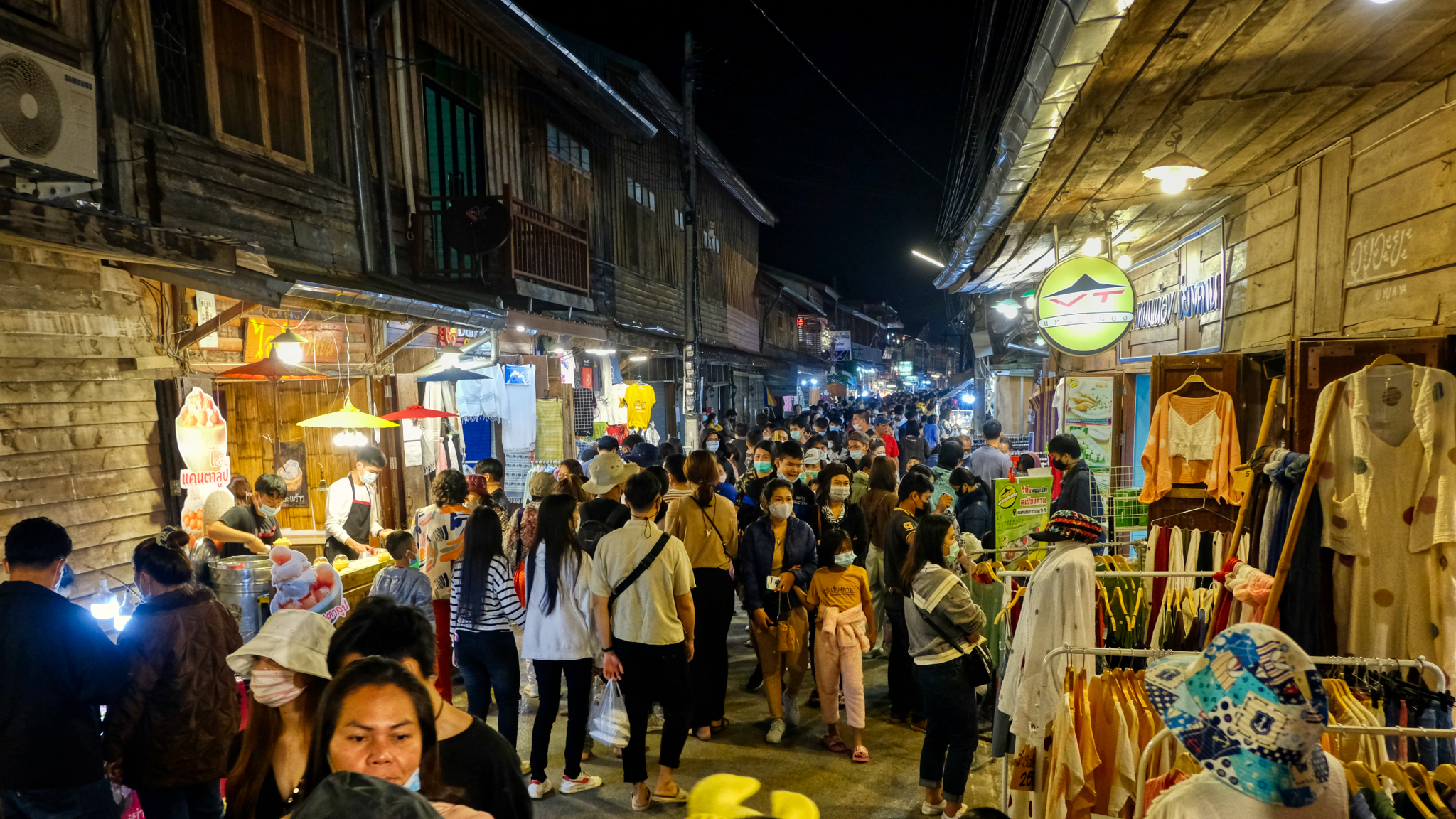 We enjoyed out nights walking along the Chiang Khan night market street.
We enjoyed out nights walking along the Chiang Khan night market street.
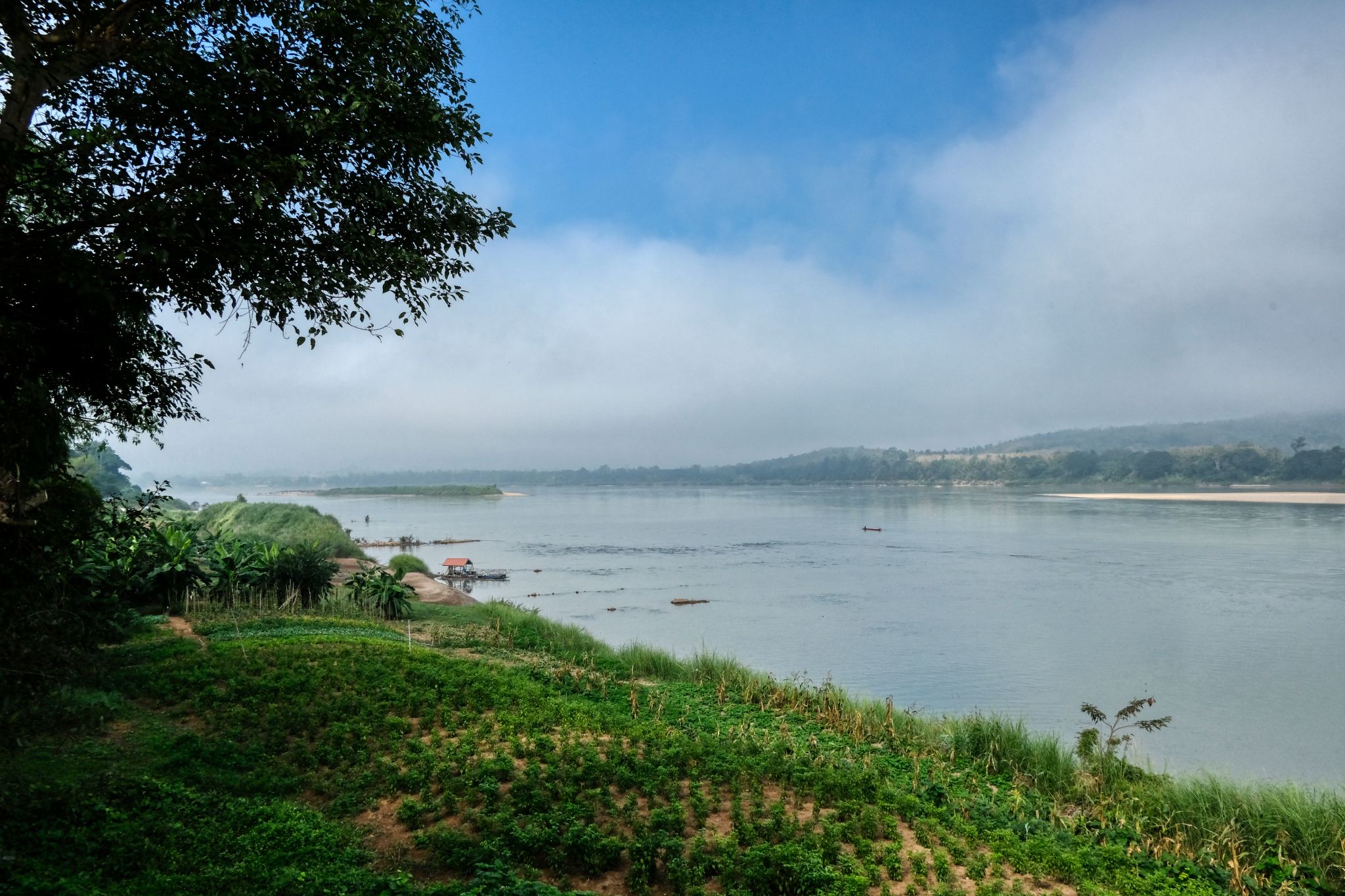 After two nights in Chiang Khan we woke up early and said good-bye to the river and headed south.
After two nights in Chiang Khan we woke up early and said good-bye to the river and headed south.
Khon Kaen
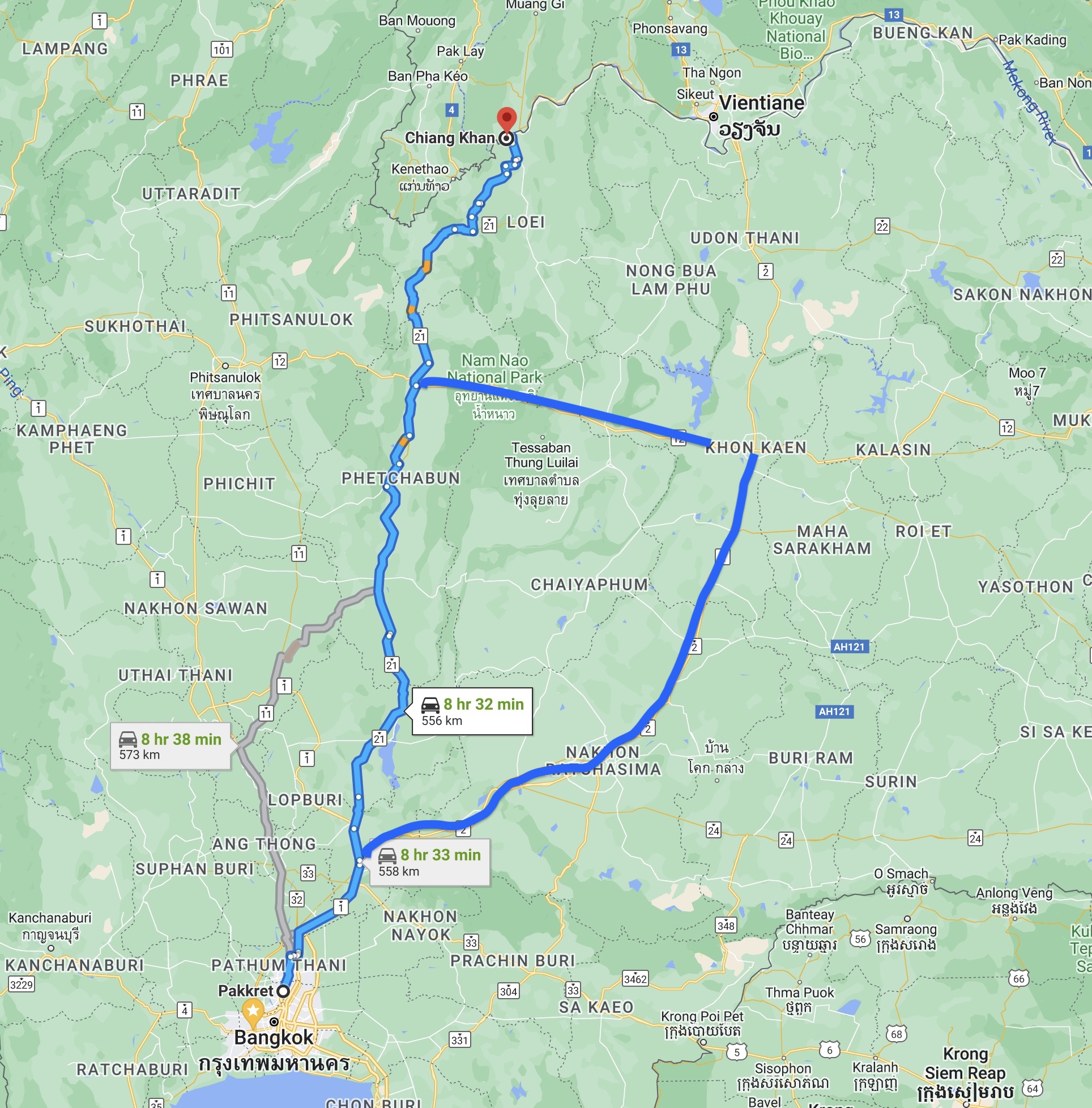 We were about 30 minutes out of Chiang Khan and decided to take a different route home to Bangkok. Neither of us had ever been to Khon Kaen . . . so why not?
We were about 30 minutes out of Chiang Khan and decided to take a different route home to Bangkok. Neither of us had ever been to Khon Kaen . . . so why not?
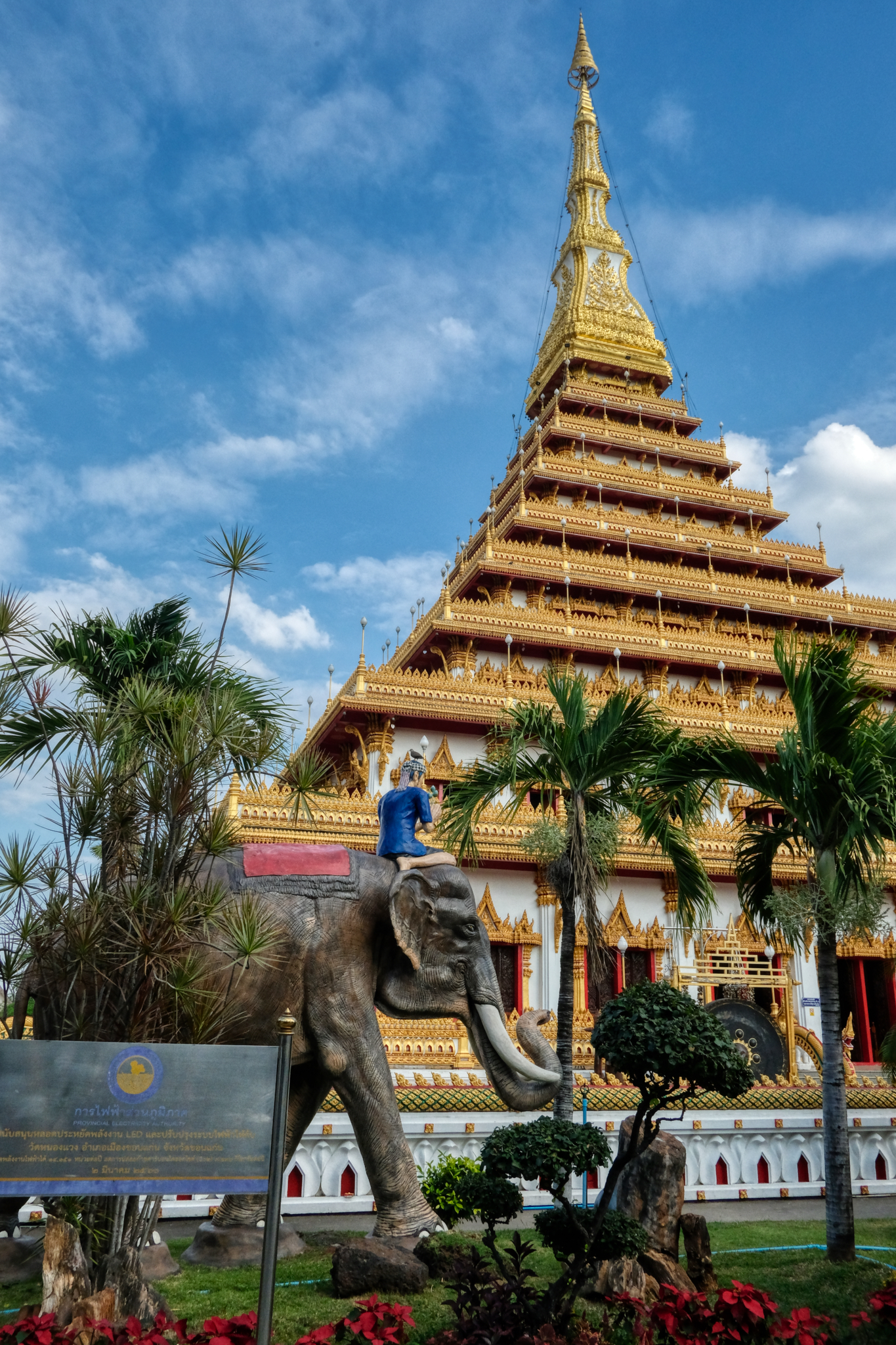 We didn't do too much sightseeing . . . just drove around town . . . found a great restaurant on Google . . . and found this magnificent wat to go in . . .
We didn't do too much sightseeing . . . just drove around town . . . found a great restaurant on Google . . . and found this magnificent wat to go in . . .
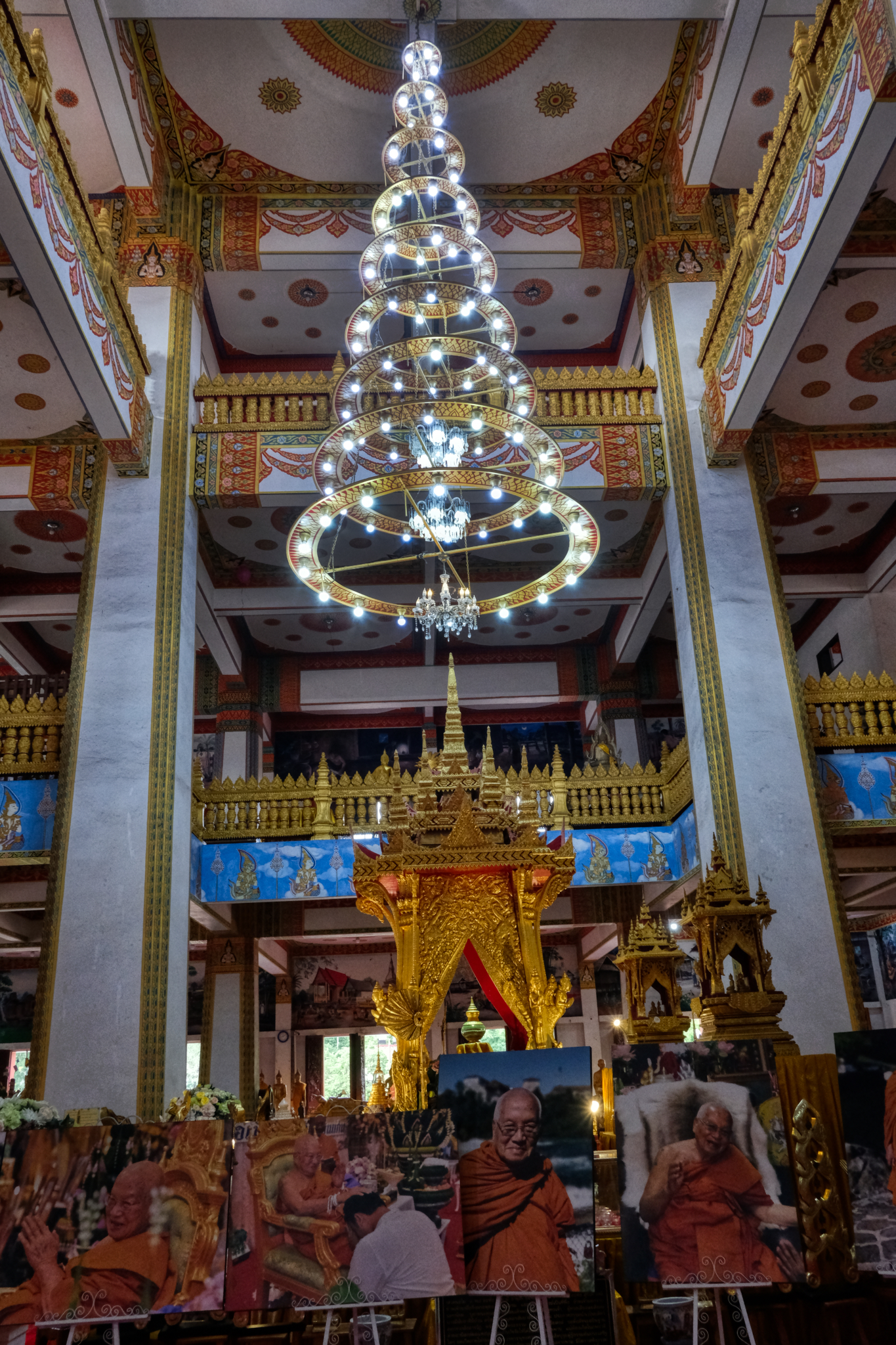 We were very glad we went inside.
We were very glad we went inside.
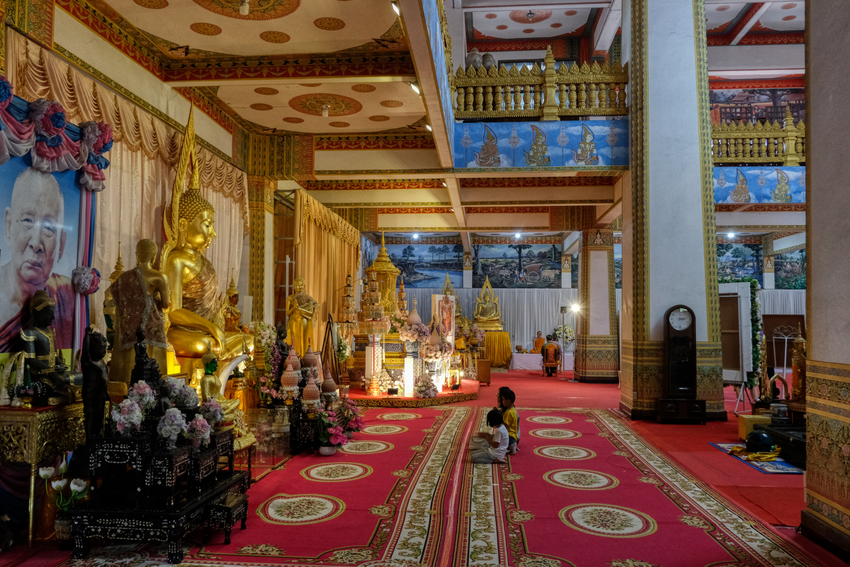 There are many different altars in the large inner space . . . each with a group of people paying respects.
There are many different altars in the large inner space . . . each with a group of people paying respects.
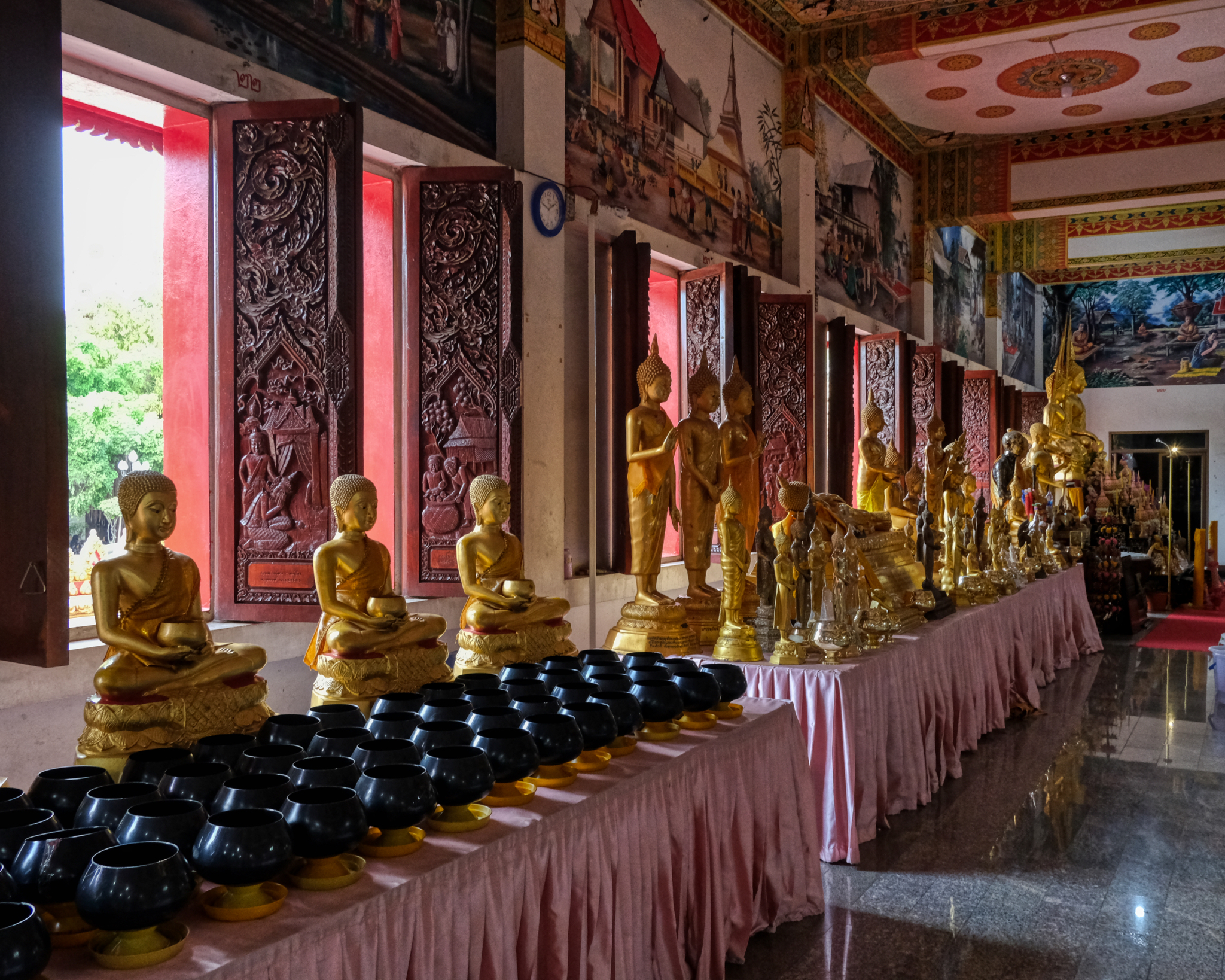 Very special light falling on the various Buddha images.
Very special light falling on the various Buddha images.
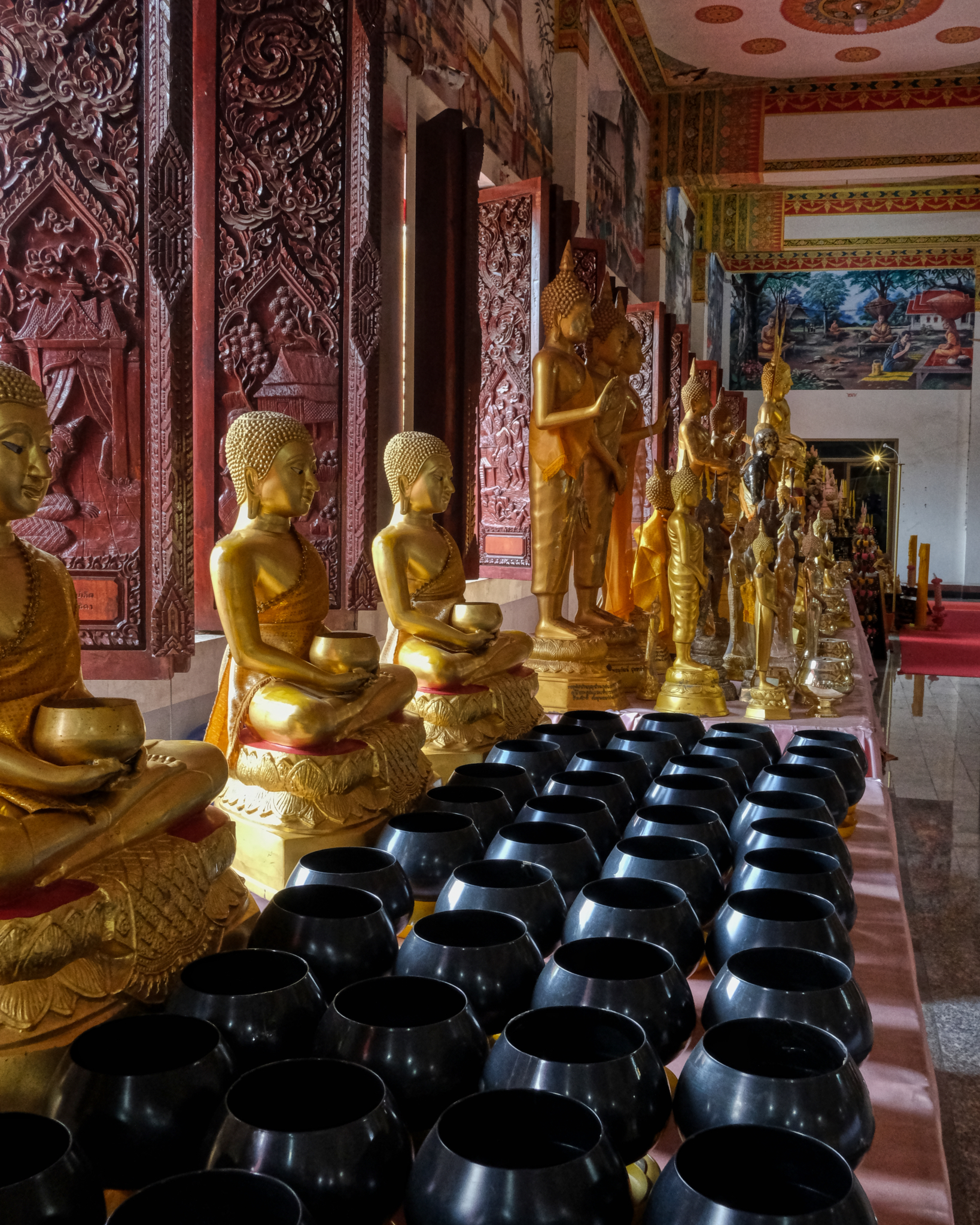 Pots for making donations and making wishes.
Pots for making donations and making wishes.
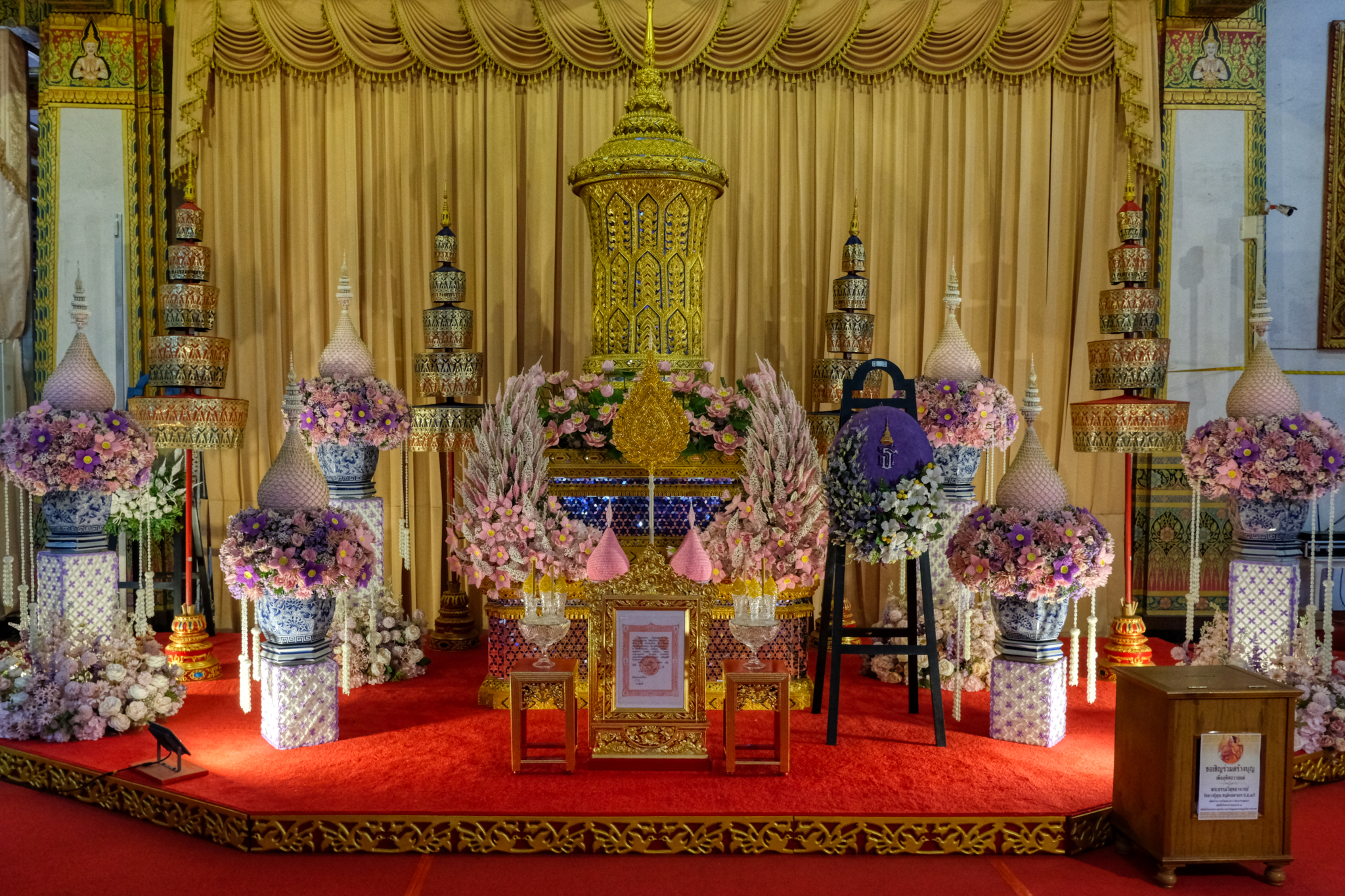 Such a pretty flower memorial altar.
Such a pretty flower memorial altar.
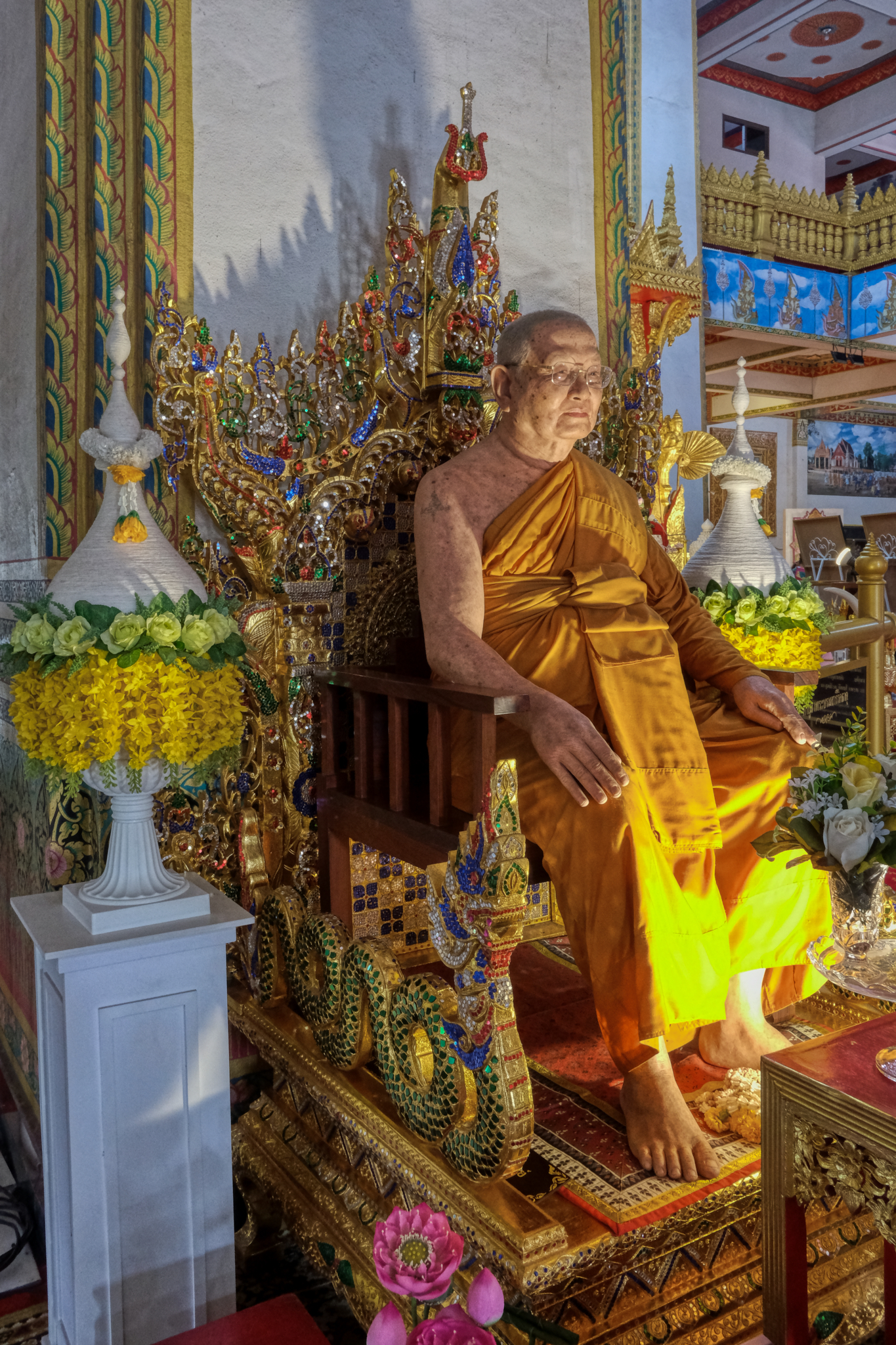 This hyper-realistic wax monk was too realistic . . . and creepy.
This hyper-realistic wax monk was too realistic . . . and creepy.
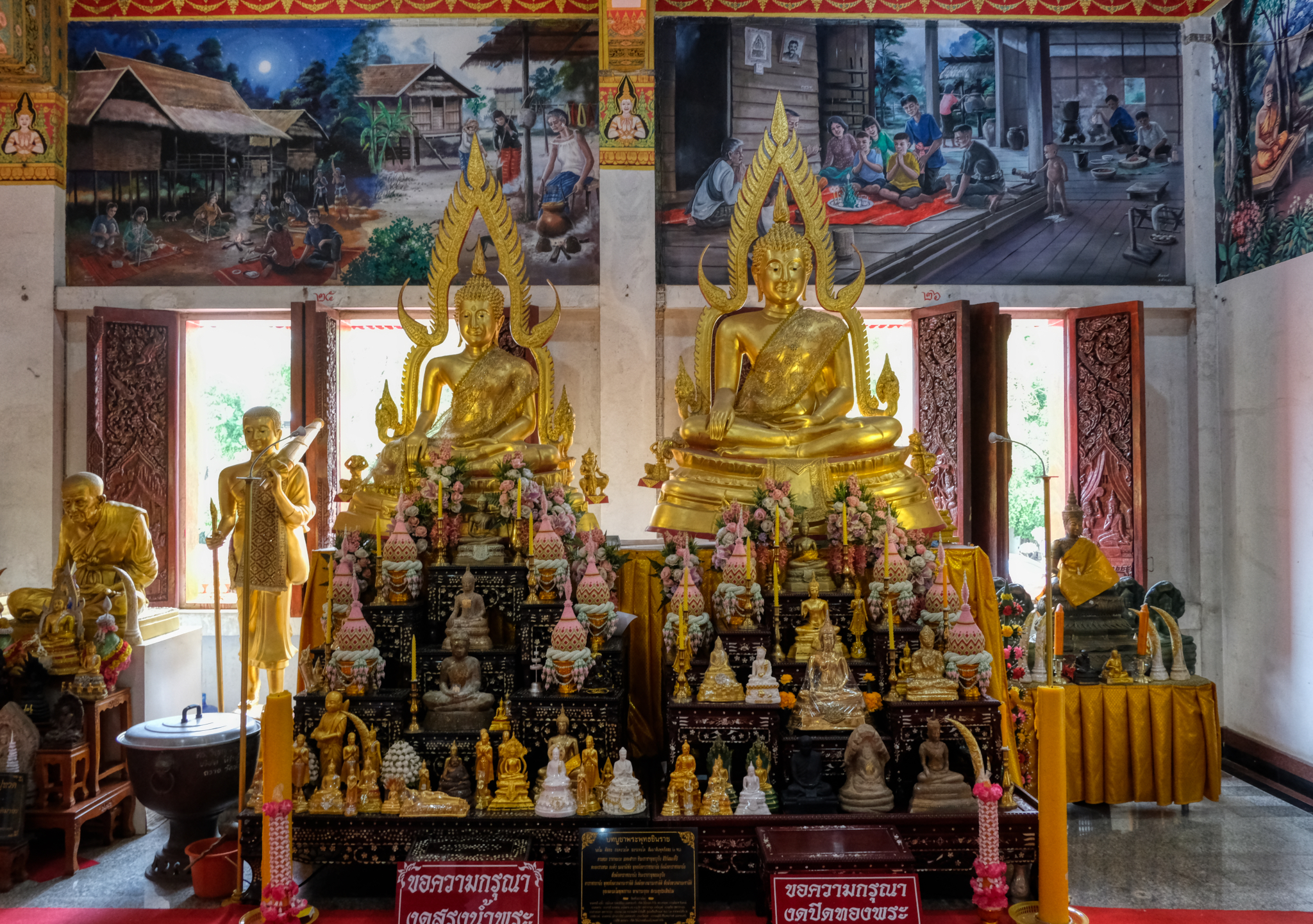 We paid our respects here and then chatted with a monk before leaving. We knew we haddn't spent enough time in Khon Kaen and vowed to return.
We paid our respects here and then chatted with a monk before leaving. We knew we haddn't spent enough time in Khon Kaen and vowed to return.
We left the next morning for a 7 hour drive home.
It had been a wonderful vacation in the middle of the COVID Pandemic!
Ratchaburi Ramble
 Wednesday, April 6, 2022 at 5:36PM
Wednesday, April 6, 2022 at 5:36PM One of the benefits of having a wife who is a serious golfer is that I get to tag along when she goes on an out-of-Bangkok golf junket with her pals. We were on vacation in the seaside town of Hua Hin and made the short drive north to the Ratchaburi Royal Golf Club early one morning after a spactacular sunrise over the Gulf of Thailand . . . . and while she played a competitive round, I explored the nearby countryside, the old town market in Ratchaburi town, and the 10th century Wat Mahathat Worawihan.
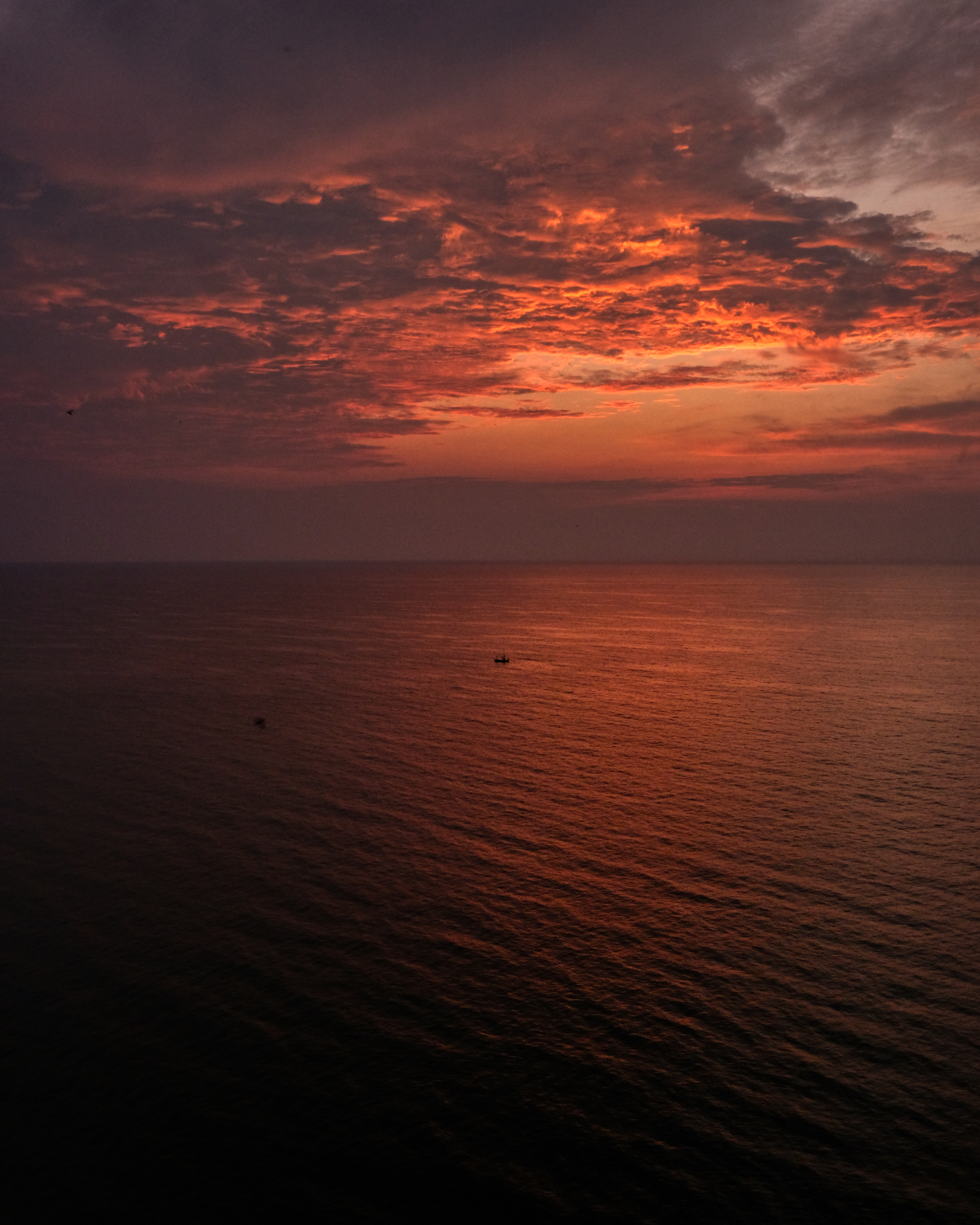 It's nice to sit on the balcony drinking the the first morning cup of coffee while the sun is rising over the Gulf of Thailand. The squid fishermen were returning with their catch after having been out to sea all night.
It's nice to sit on the balcony drinking the the first morning cup of coffee while the sun is rising over the Gulf of Thailand. The squid fishermen were returning with their catch after having been out to sea all night.
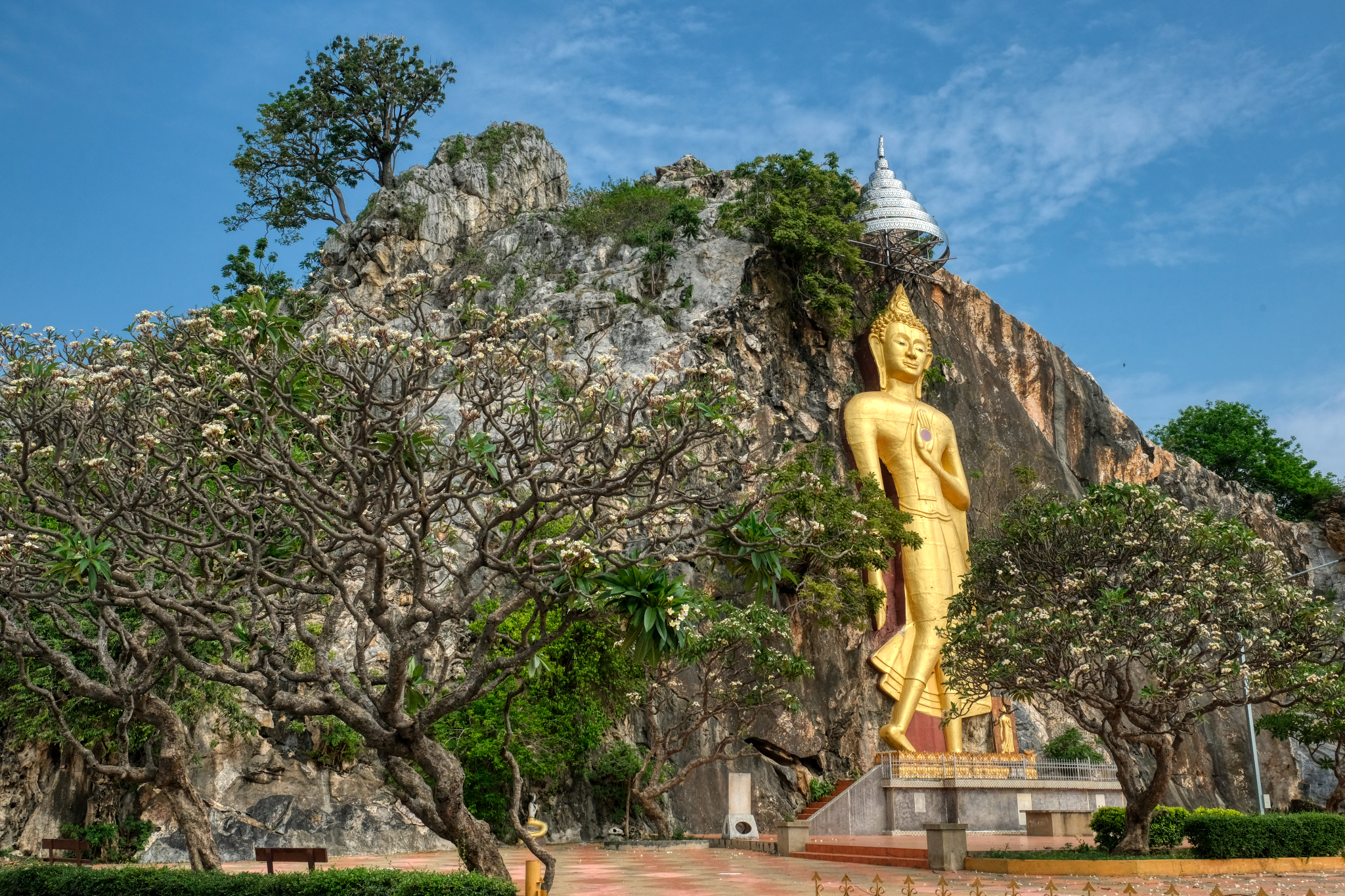 Along the Ratchaburi highway . . . a giant Buddha statue . . . without a place name.
Along the Ratchaburi highway . . . a giant Buddha statue . . . without a place name.
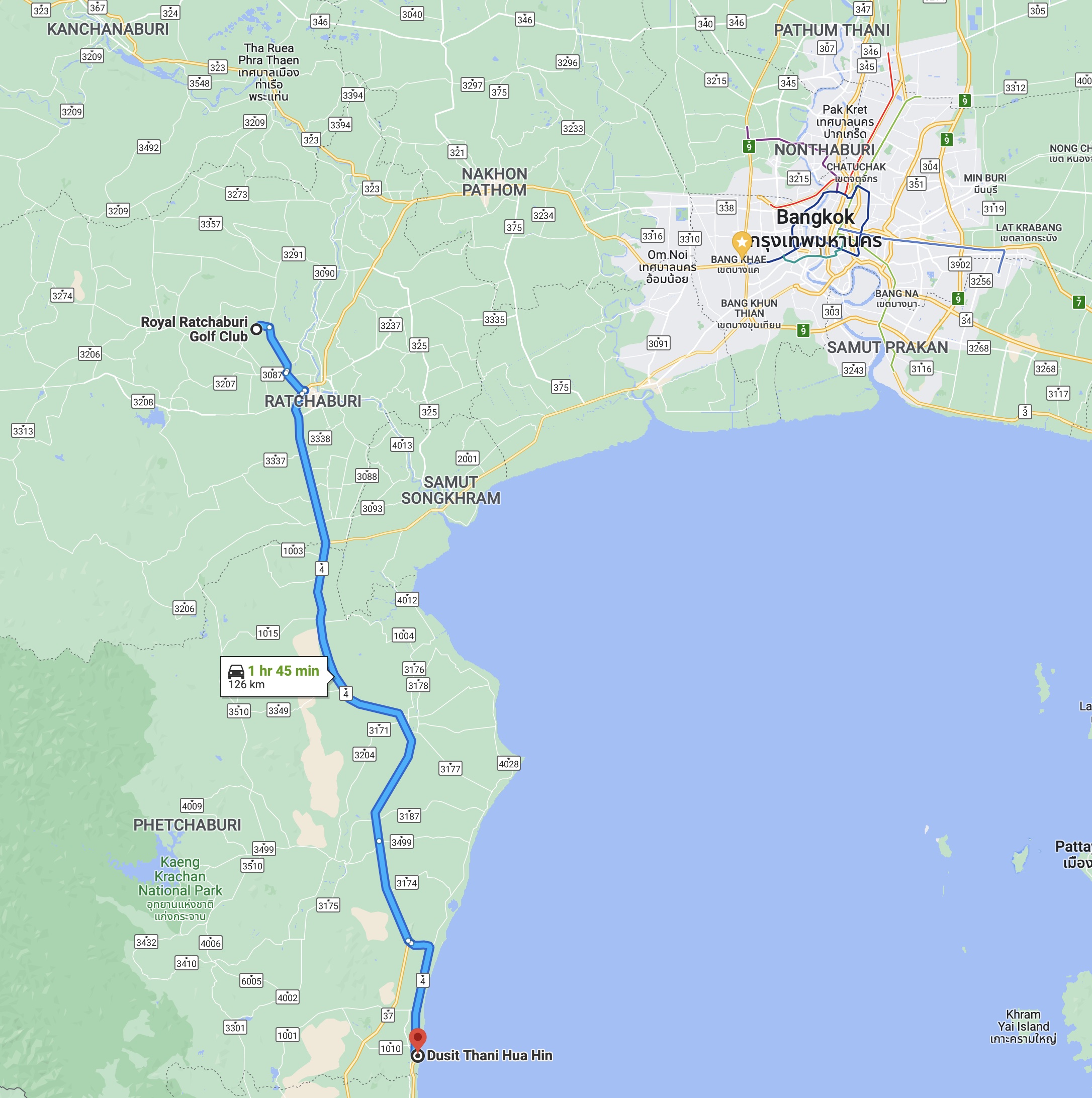 Only an hour and 45 minutes away . . . up and into the hilly Ratchaburi Province.
Only an hour and 45 minutes away . . . up and into the hilly Ratchaburi Province.
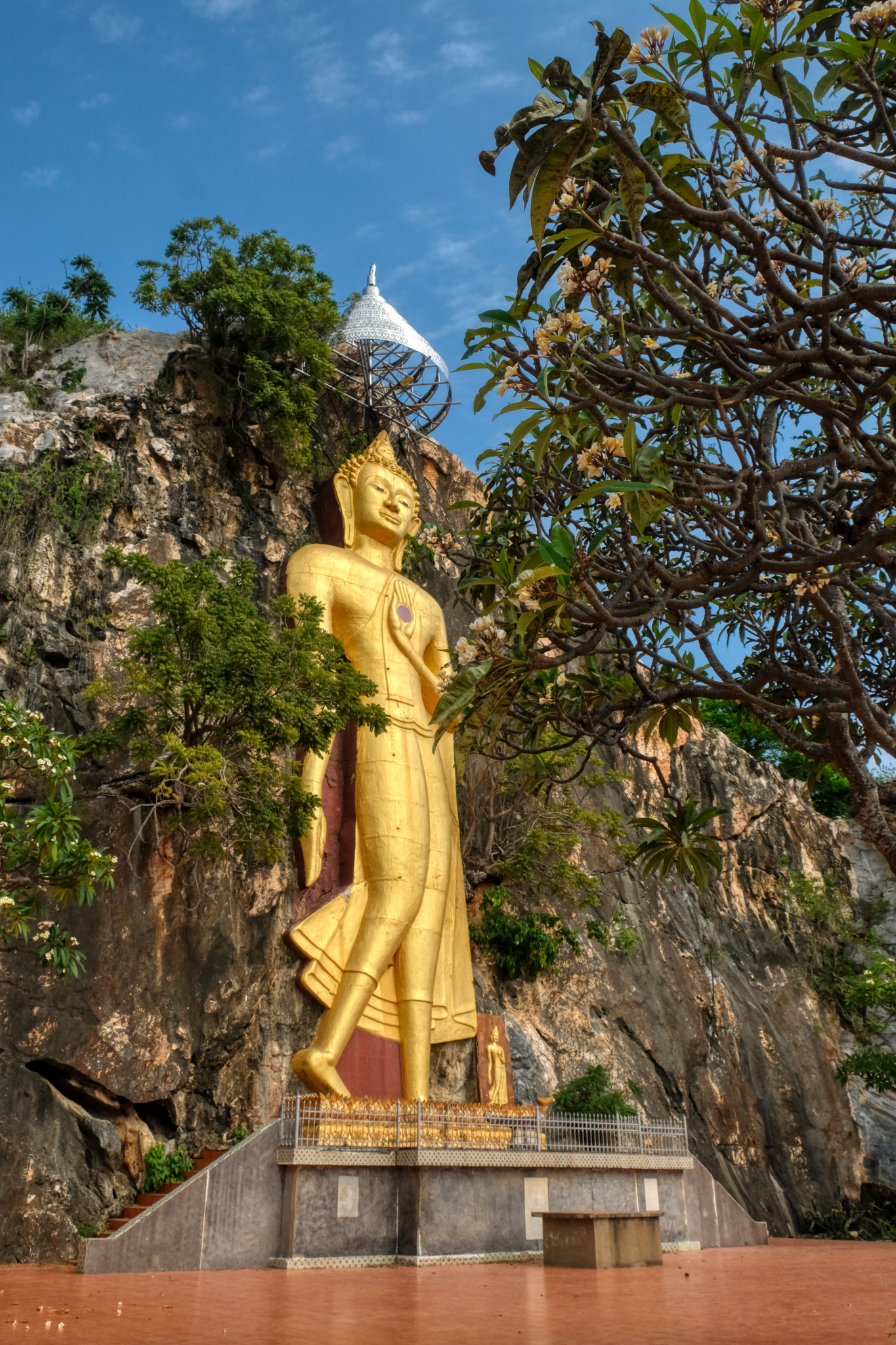 Small provincial roads in Thailand always serve up some amazing sights.
Small provincial roads in Thailand always serve up some amazing sights.
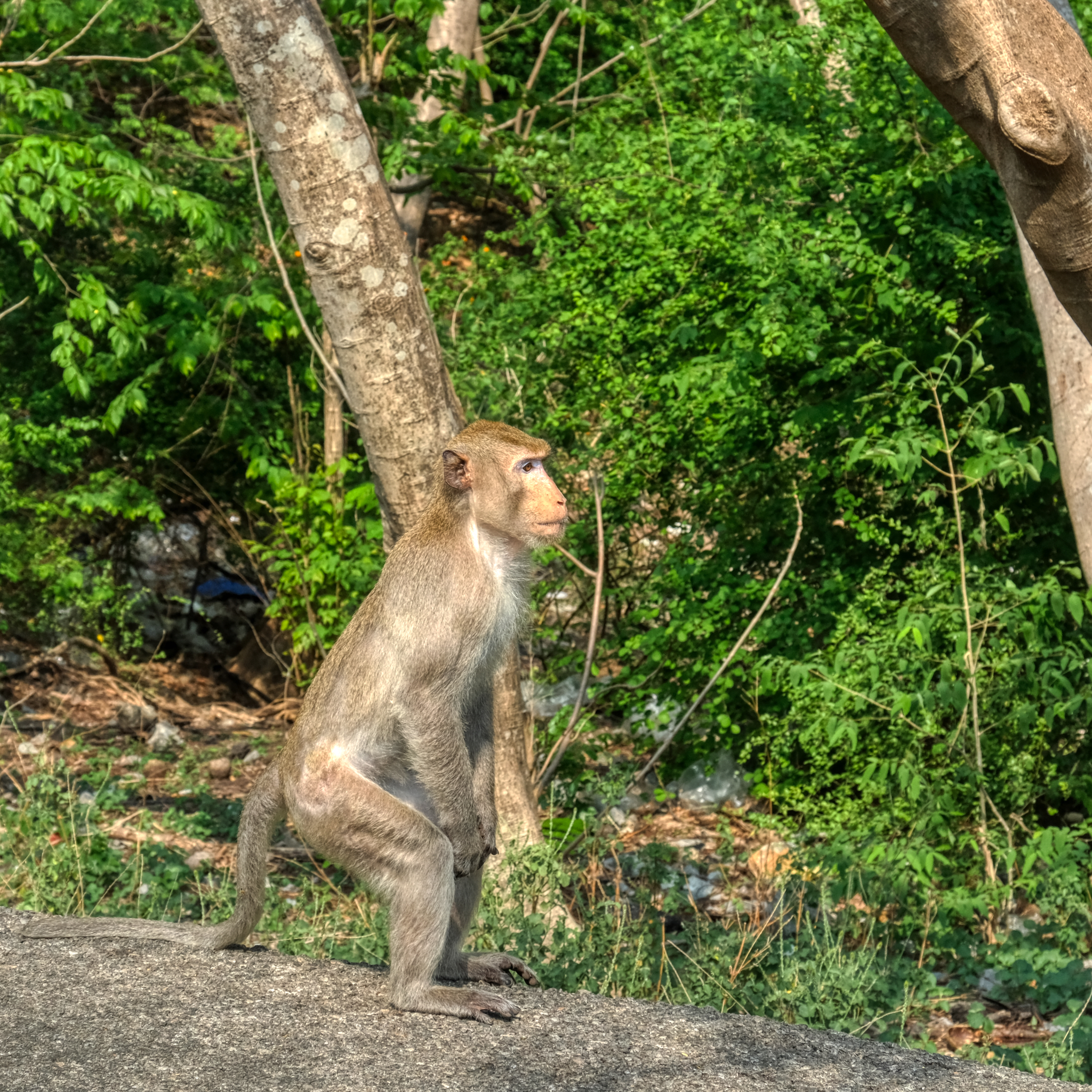 Yes, they have monkeys in Thailand. This one, and about 20 of his buddies kept me from leaving my car to walk up a trail to a large cave Buddha temple.
Yes, they have monkeys in Thailand. This one, and about 20 of his buddies kept me from leaving my car to walk up a trail to a large cave Buddha temple.
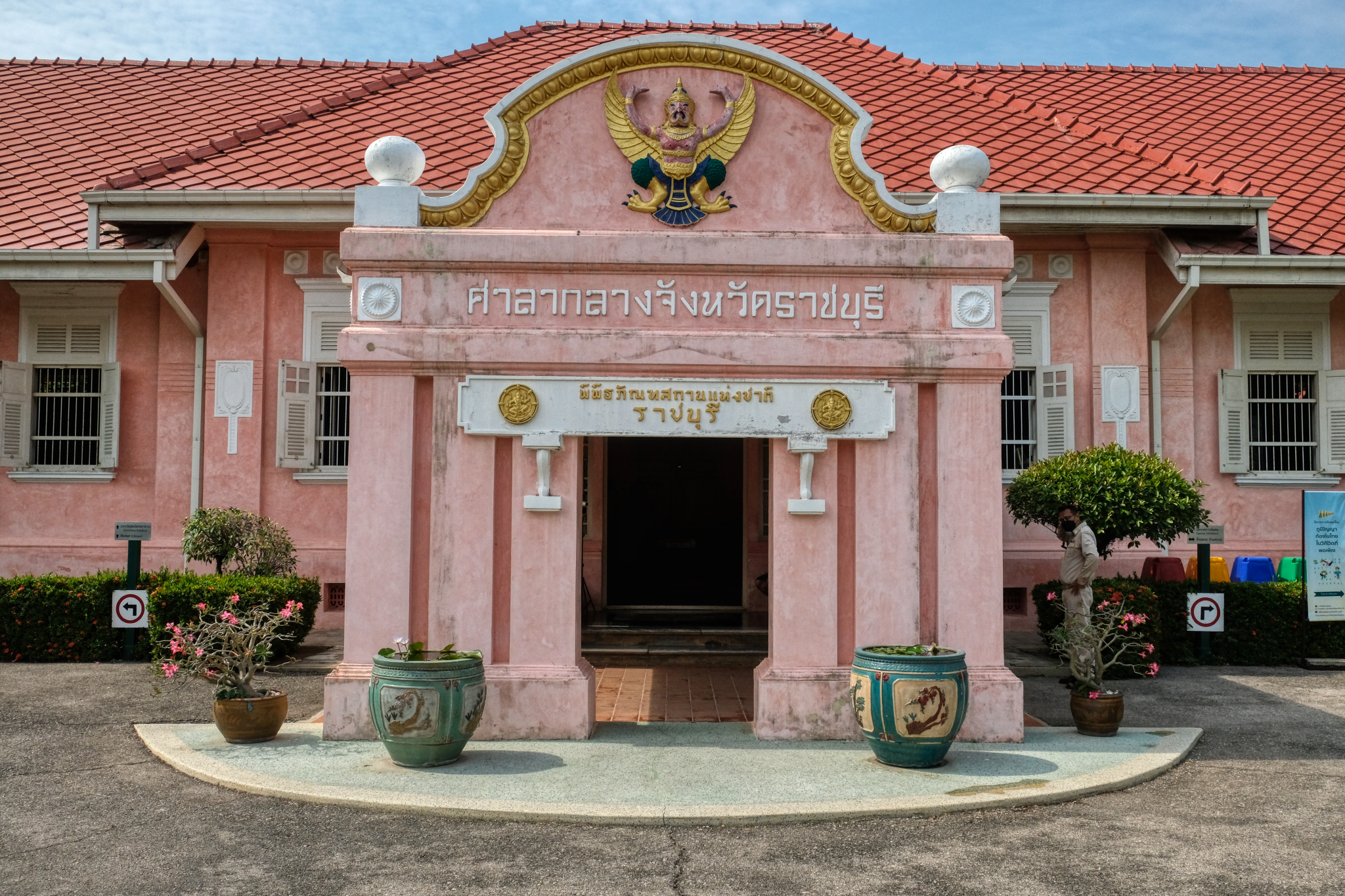 As I was on a 'ramble', I had no particular place to go. I made my way to Ratchaburi, a town I had never visited. I arrived in Ratchaburi on small roads and on the outskirts of town I discovered this wonderful place: The Ratchaburi National Museum.
As I was on a 'ramble', I had no particular place to go. I made my way to Ratchaburi, a town I had never visited. I arrived in Ratchaburi on small roads and on the outskirts of town I discovered this wonderful place: The Ratchaburi National Museum.
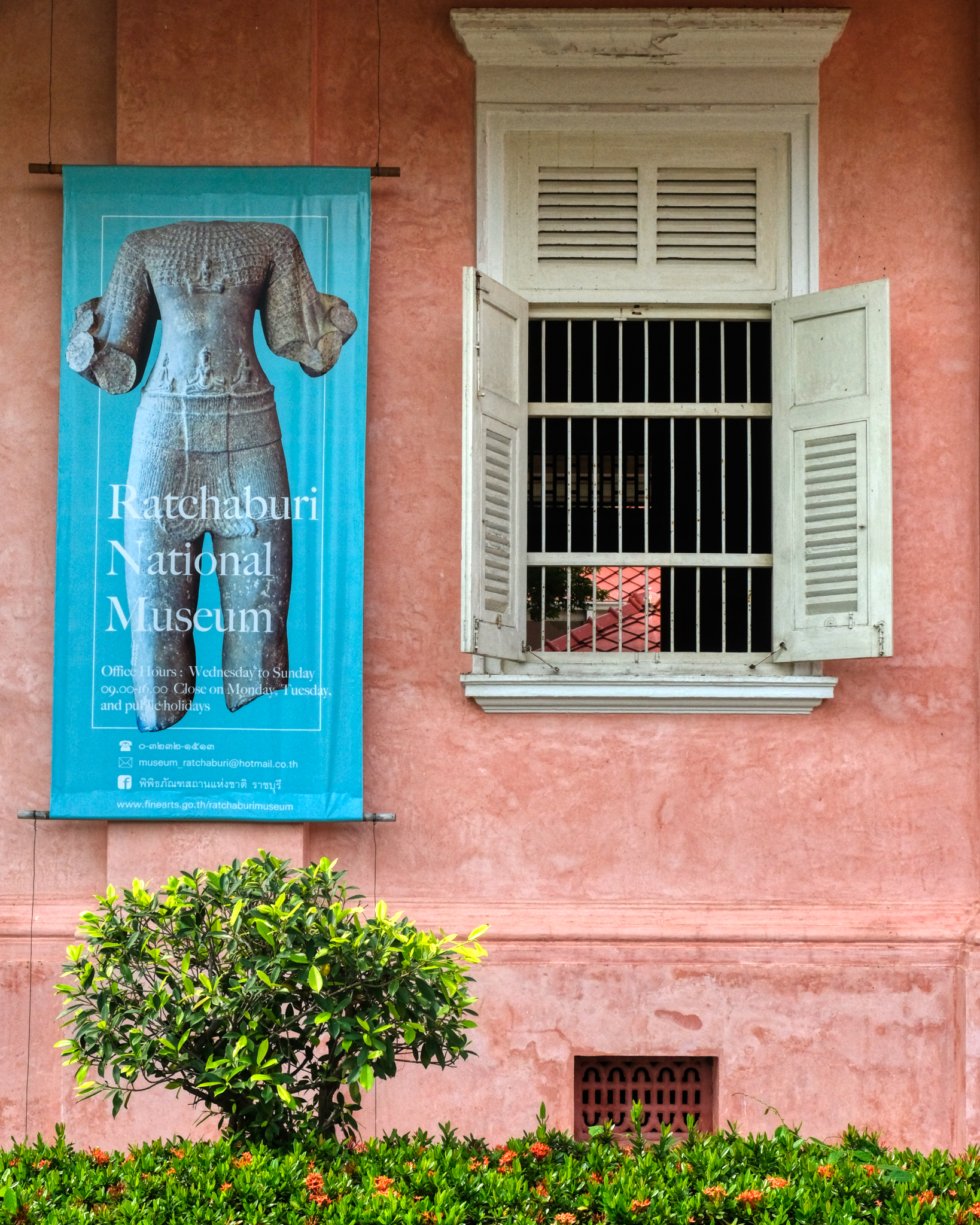 It was a gorgeous building . . . old Thai monumental style.
It was a gorgeous building . . . old Thai monumental style.
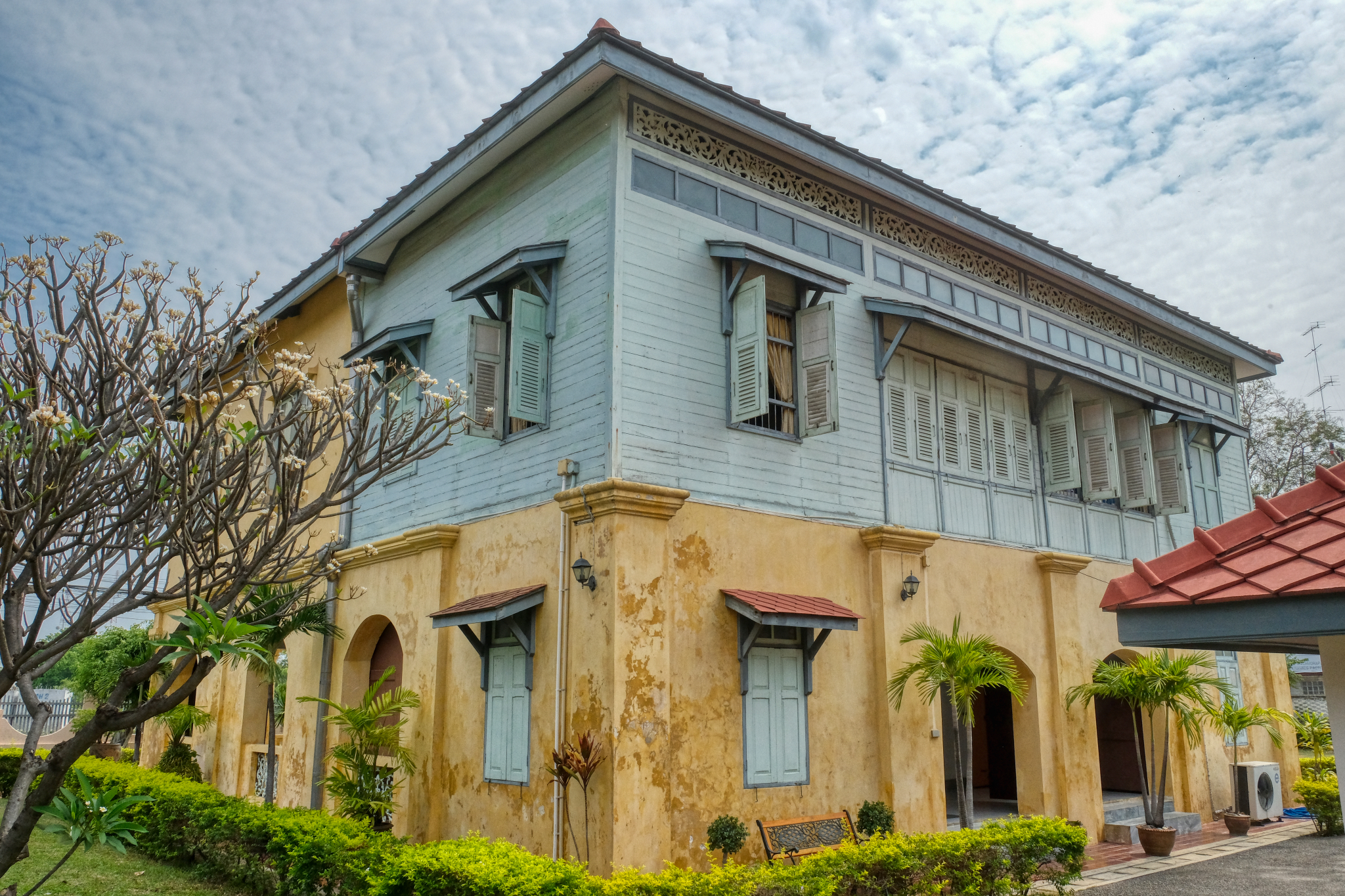 There were two buildings on the museum property. I adored the patina, color, and style of this old gem.
There were two buildings on the museum property. I adored the patina, color, and style of this old gem.
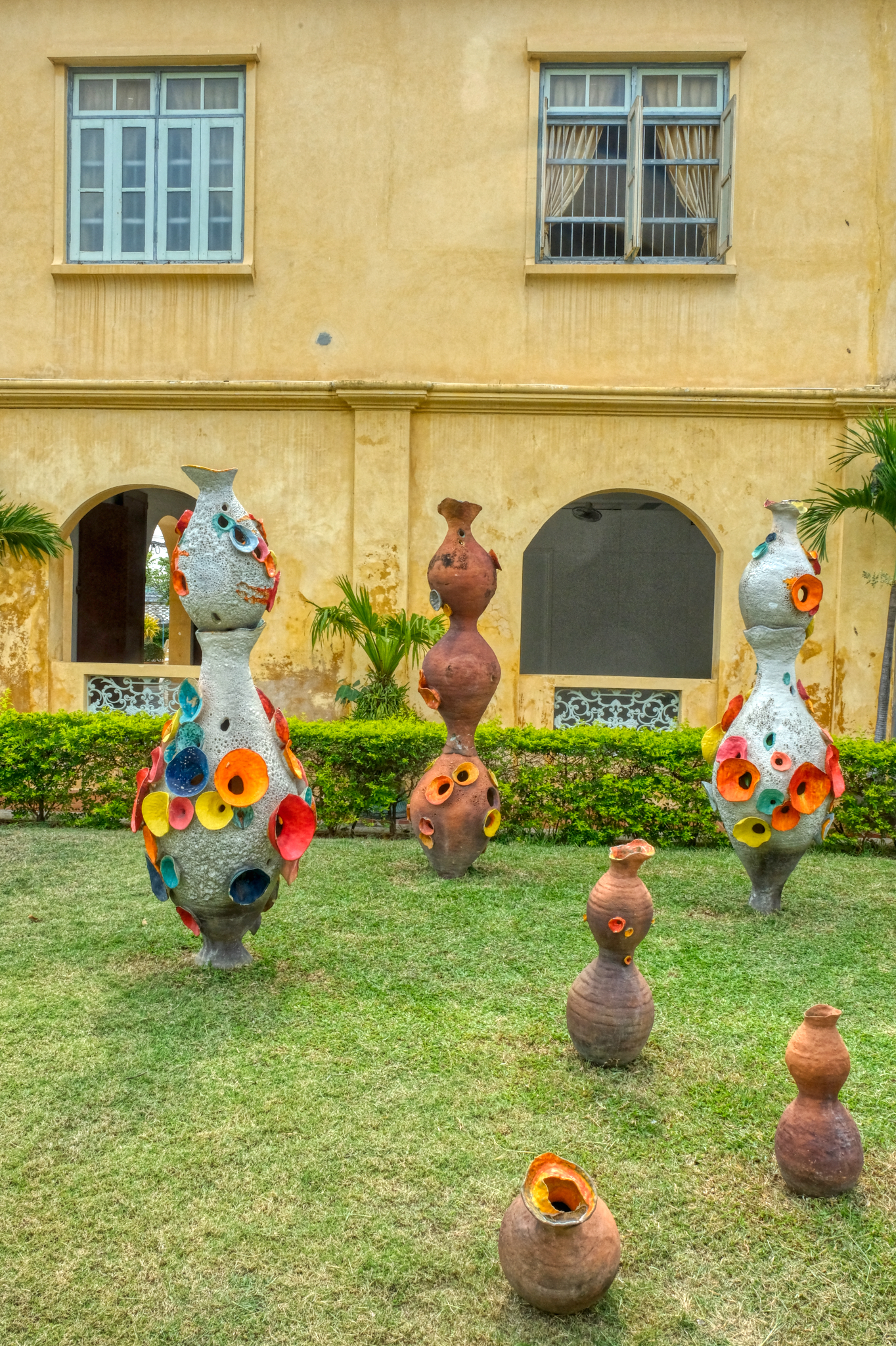 Being a museum, they had yard art too.
Being a museum, they had yard art too.
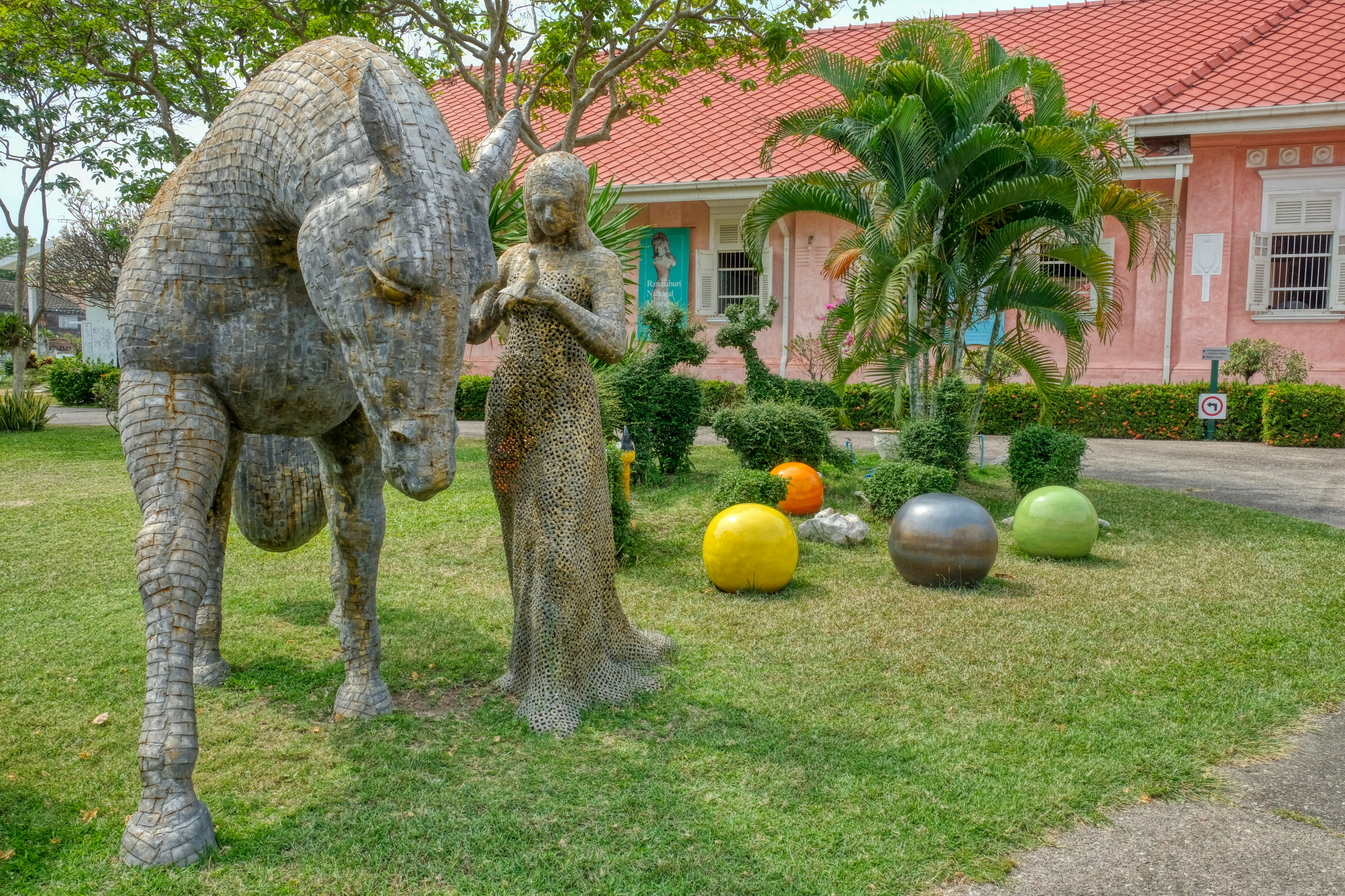 This large metal sculpture was fantastic.
This large metal sculpture was fantastic.
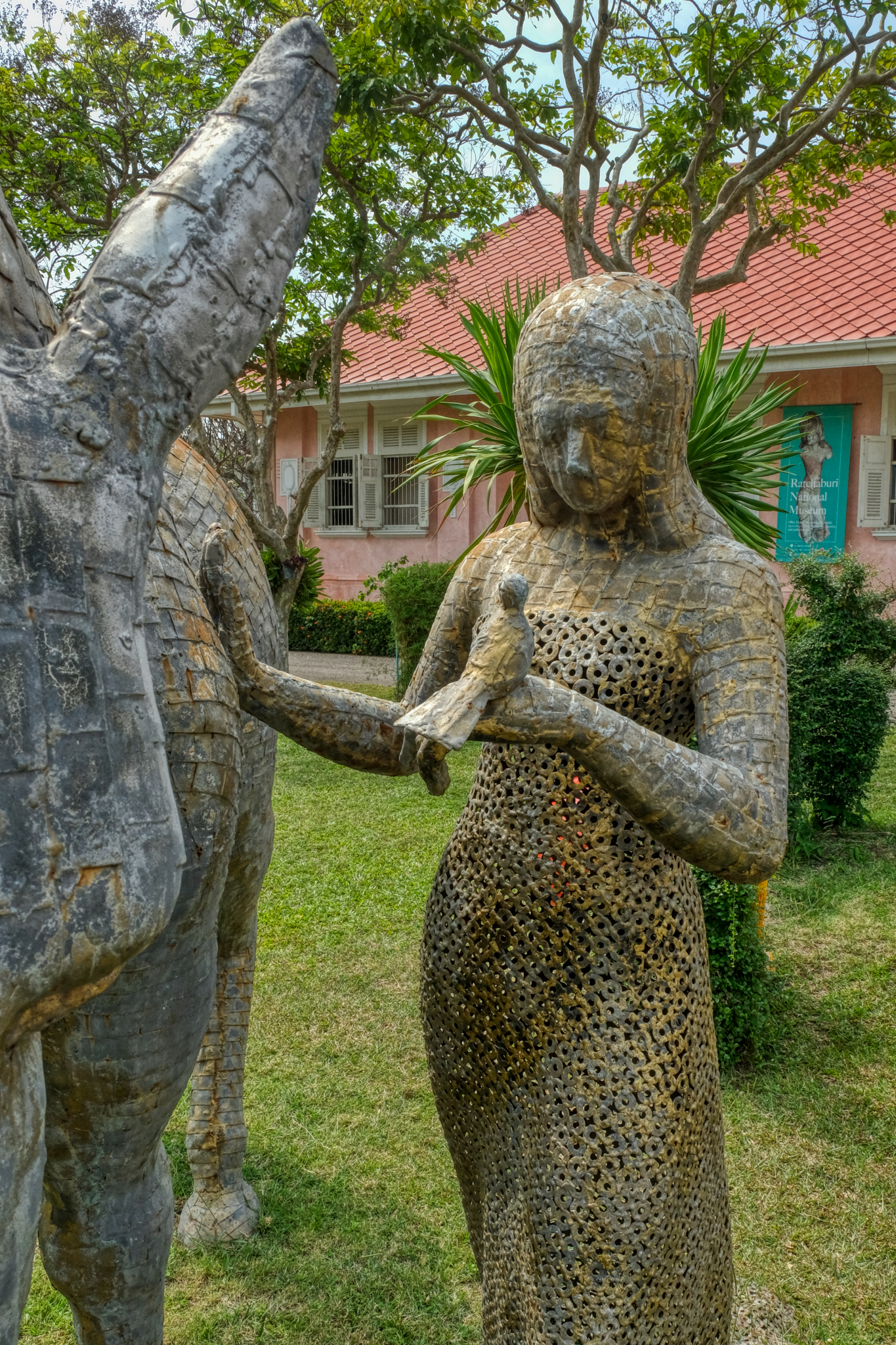 Made entirely of ordinary steel washers and small squares of steel. Amazing.
Made entirely of ordinary steel washers and small squares of steel. Amazing.
 The museum rules strictly prohibited photography of the exhibits . . . and they enforced this rule by having one of the museum staff follow me from room to room. They did, however, allow me to photograph the halls and courtyard when I asked.
The museum rules strictly prohibited photography of the exhibits . . . and they enforced this rule by having one of the museum staff follow me from room to room. They did, however, allow me to photograph the halls and courtyard when I asked.
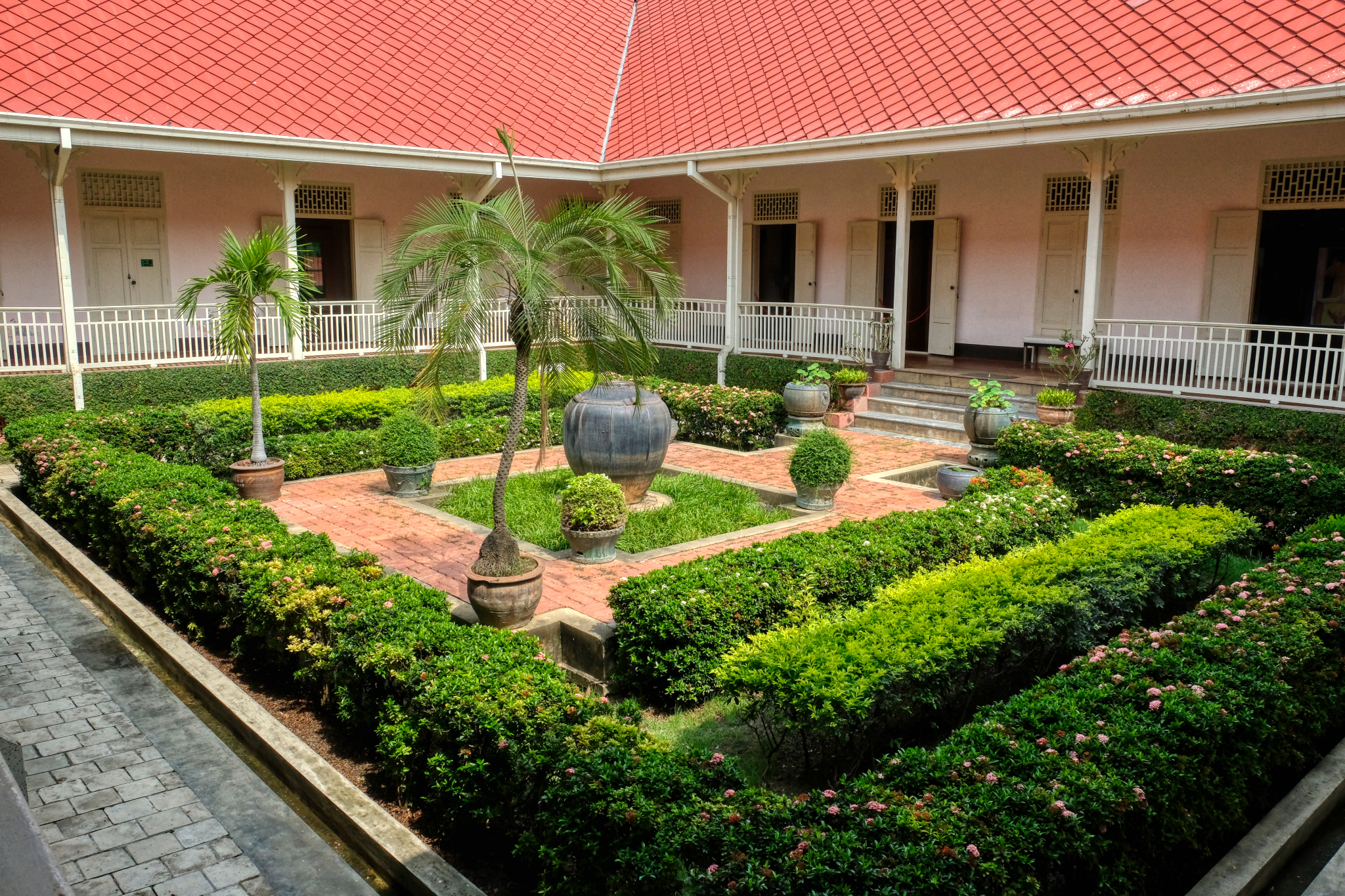 The museum collection was excellent and very well organized. The exhibits began in prehistory and ancient geology of the area and proceeded chronologically as you walked from room to room around the courtyard. It was one of the best, most informative provincial museums I have been to anywhere in the world.
The museum collection was excellent and very well organized. The exhibits began in prehistory and ancient geology of the area and proceeded chronologically as you walked from room to room around the courtyard. It was one of the best, most informative provincial museums I have been to anywhere in the world.
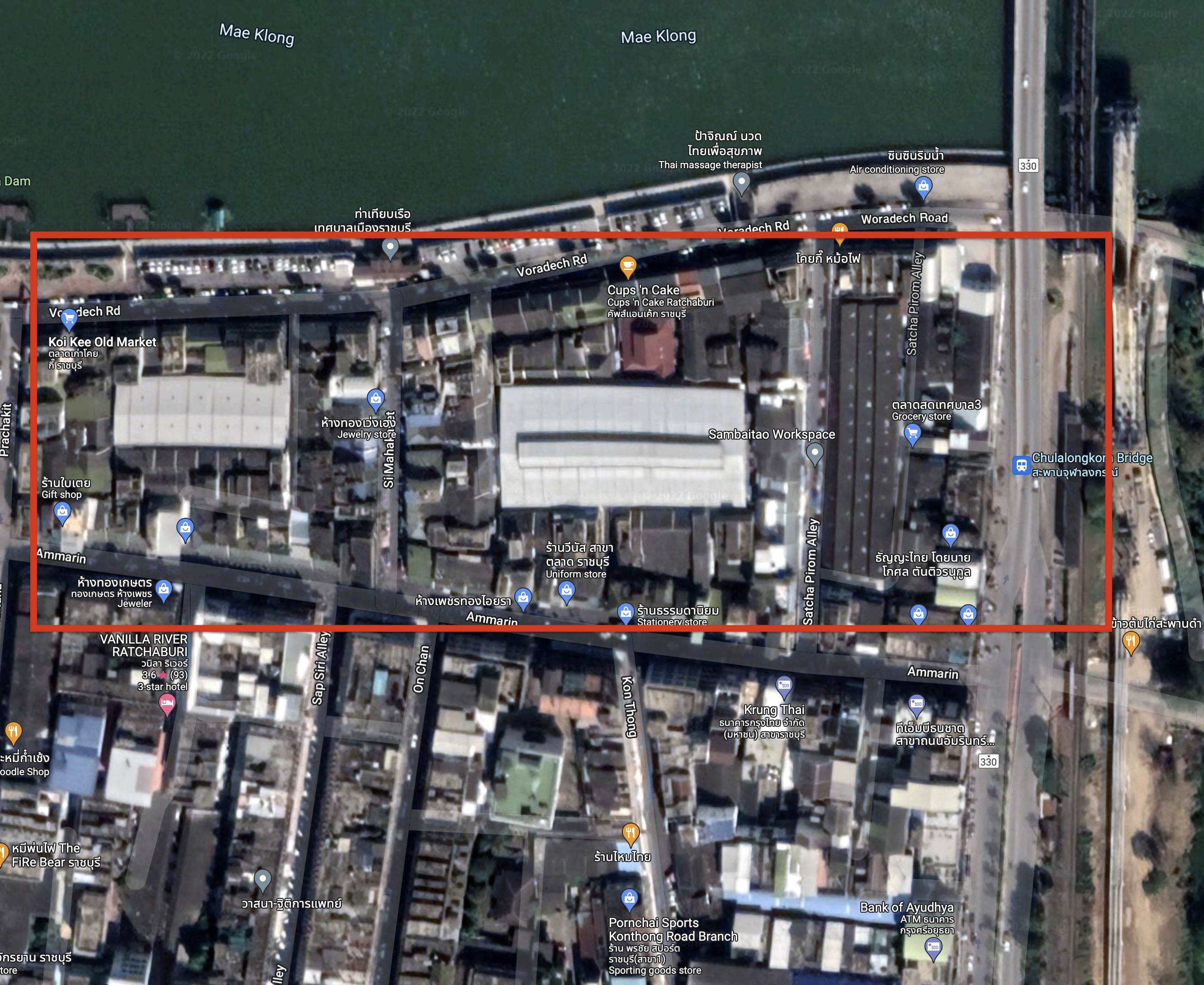 I next drove into the town center and the old city center market. The market occupies the inside center alleyways of several blocks along the Mae Klong River.
I next drove into the town center and the old city center market. The market occupies the inside center alleyways of several blocks along the Mae Klong River.
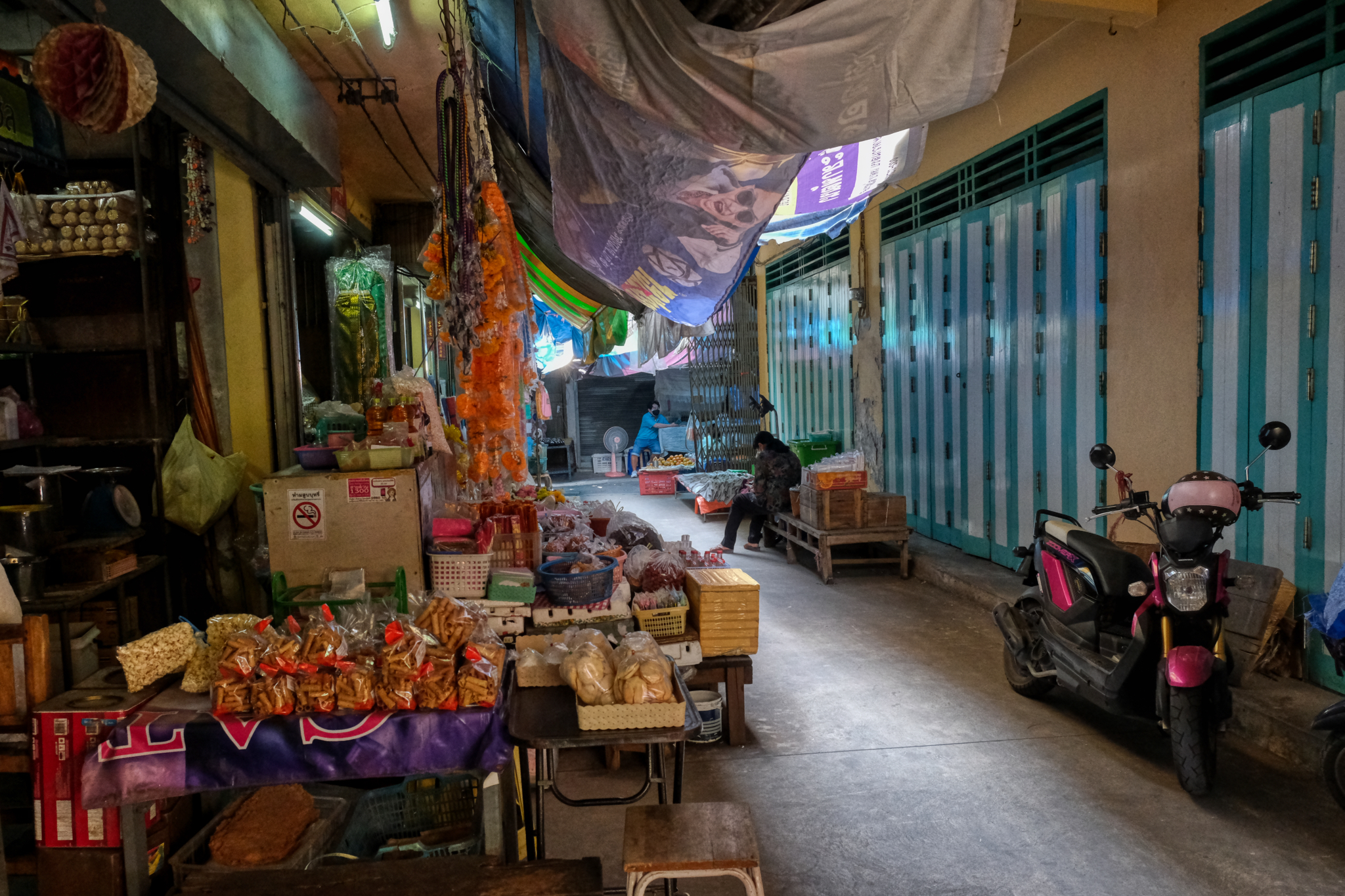 As I left the museum I looked on my GoogleMaps and spotted a river and "Old Town Market" . . . so I drove straight there. I love these old town, city center markets in Thailand's small cities. This market would have been in it's prime during the 1950s and 1960s.
As I left the museum I looked on my GoogleMaps and spotted a river and "Old Town Market" . . . so I drove straight there. I love these old town, city center markets in Thailand's small cities. This market would have been in it's prime during the 1950s and 1960s.
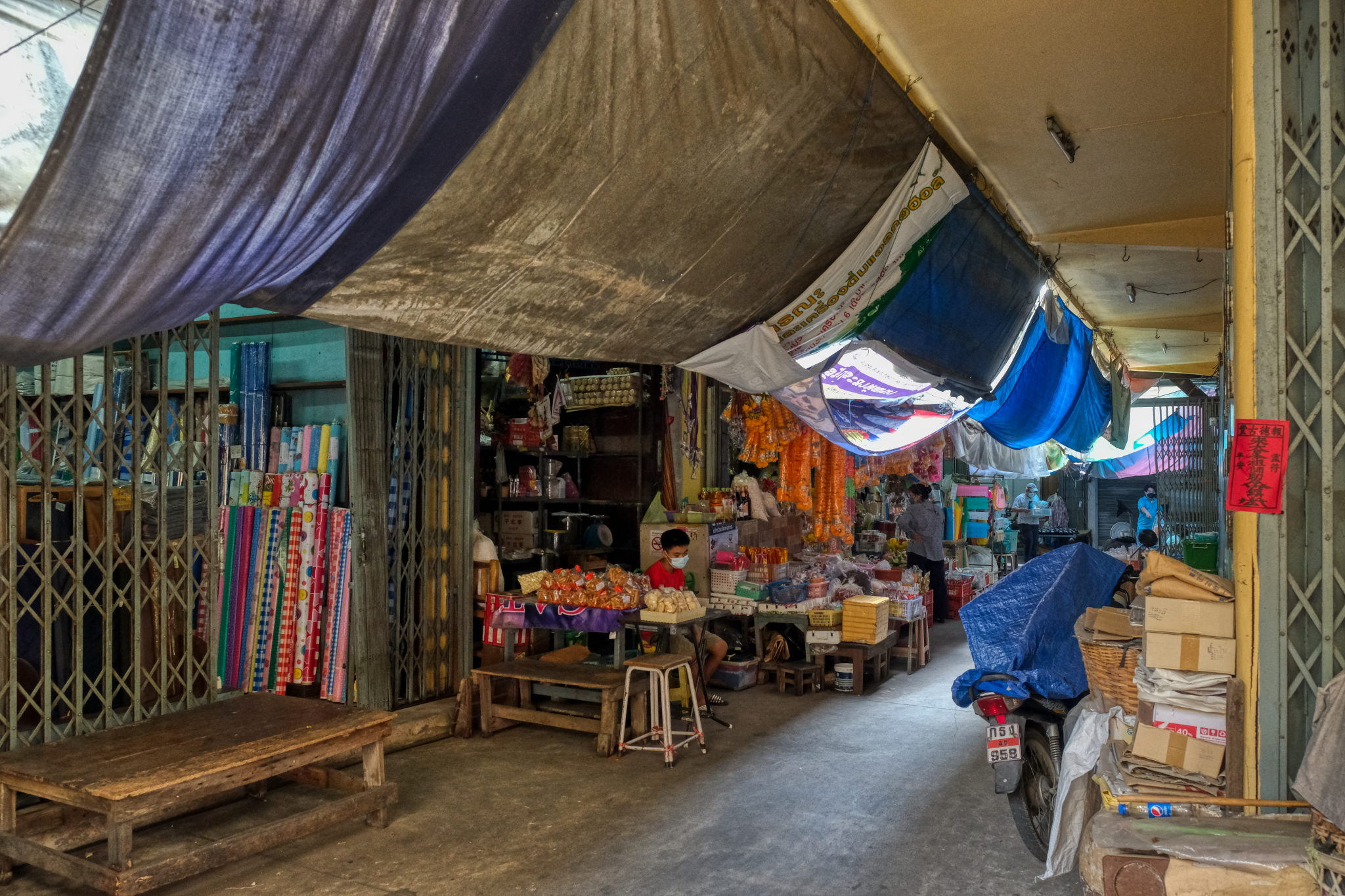 The old markets are the remnants of the oldest parts of Thai cities and maintain an older way of doing business.
The old markets are the remnants of the oldest parts of Thai cities and maintain an older way of doing business.
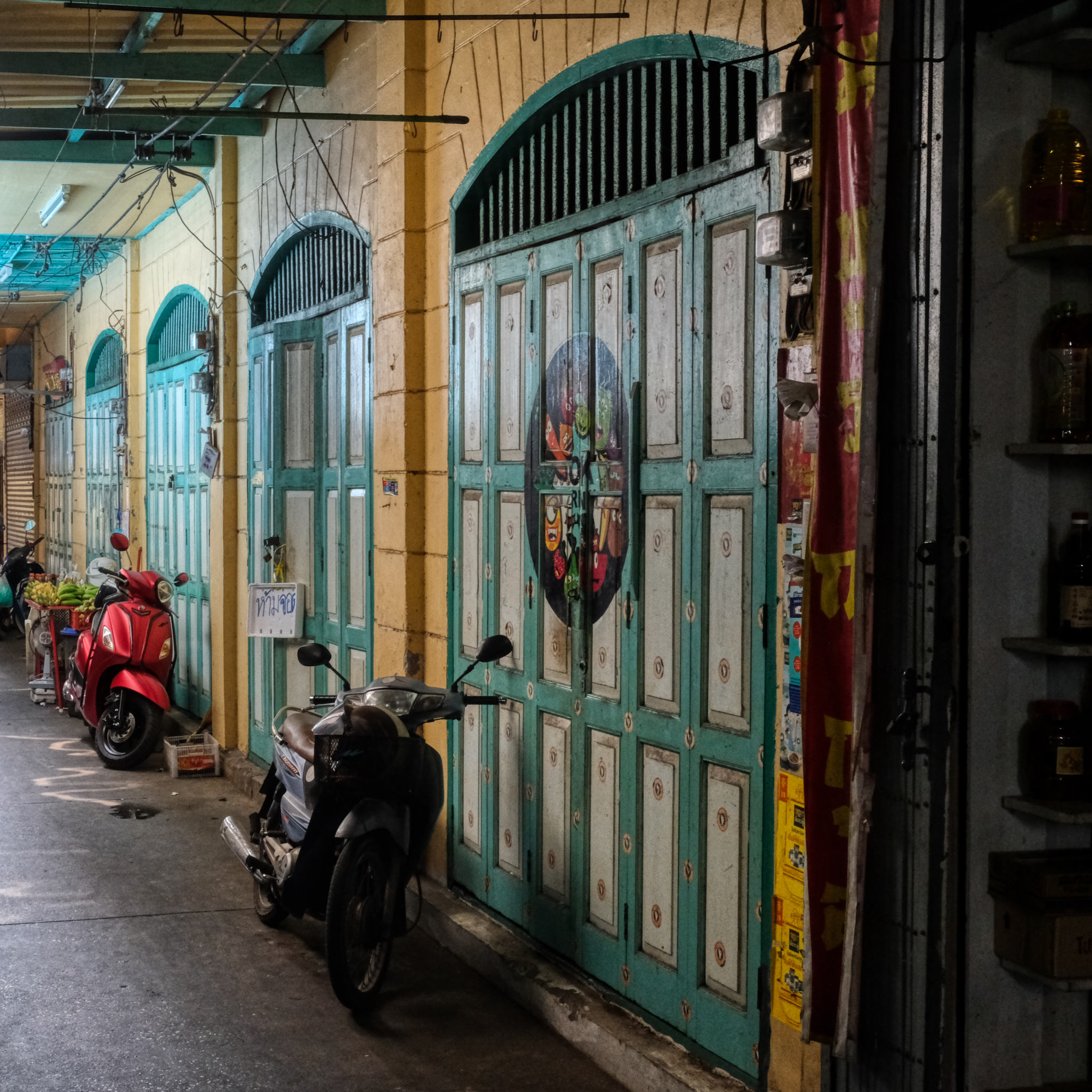 The city or local area government seems to have taken an interest in this old market. Many of the walls and old panel doors seem to have been painted recently. It looked very good.
The city or local area government seems to have taken an interest in this old market. Many of the walls and old panel doors seem to have been painted recently. It looked very good.
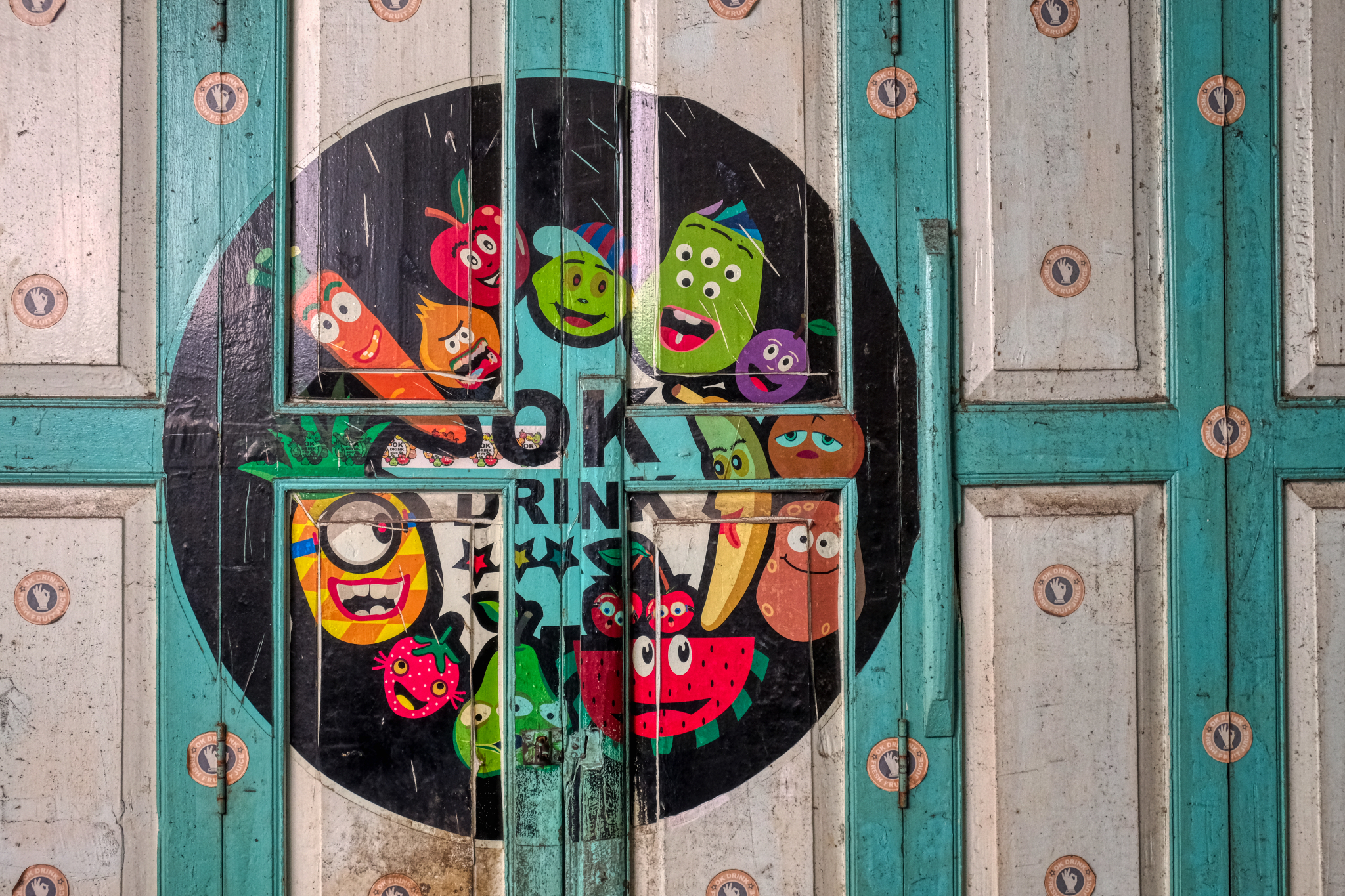 A colorful advertisement on the panel doors.
A colorful advertisement on the panel doors.
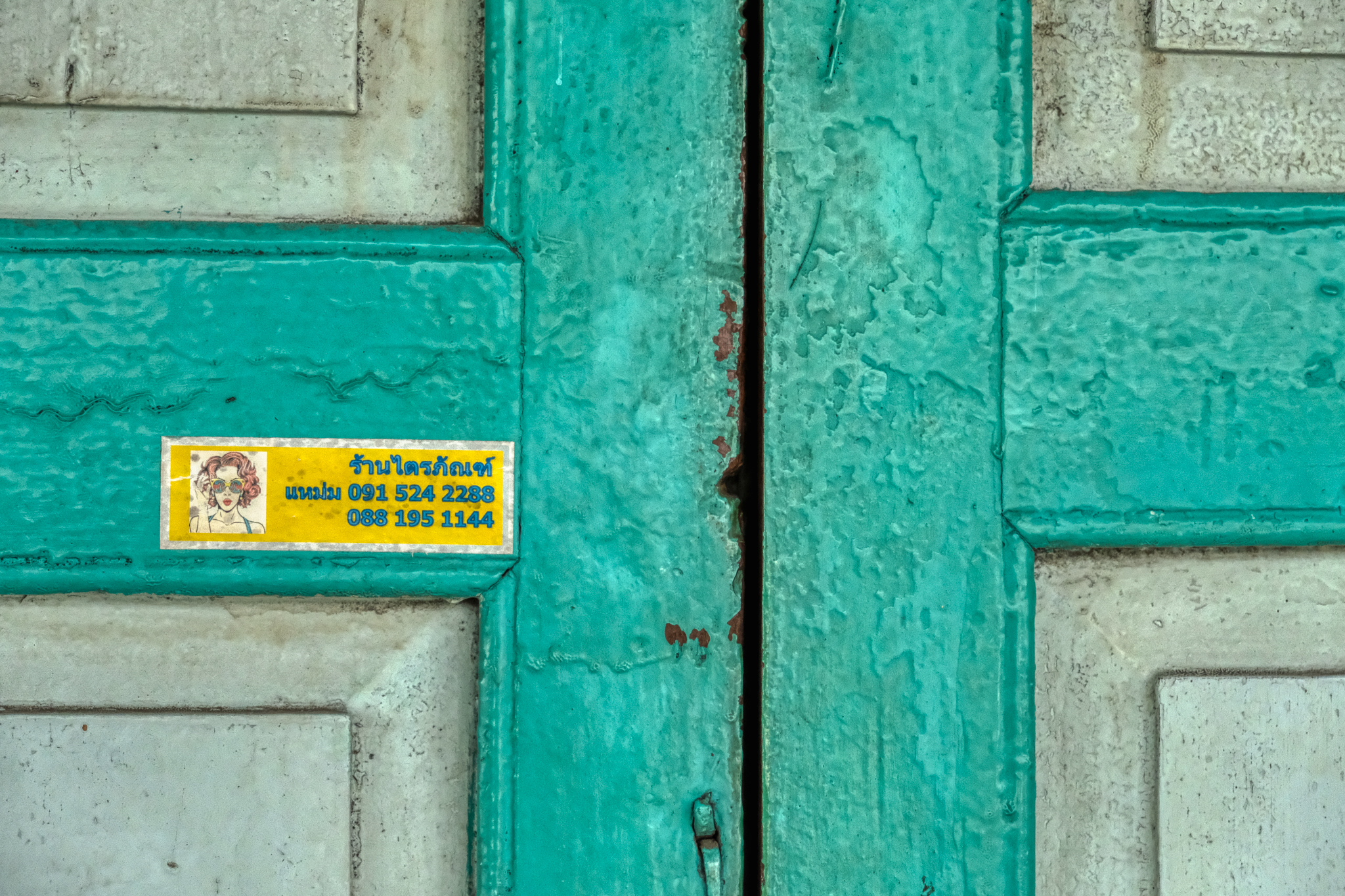 History in paint.
History in paint.
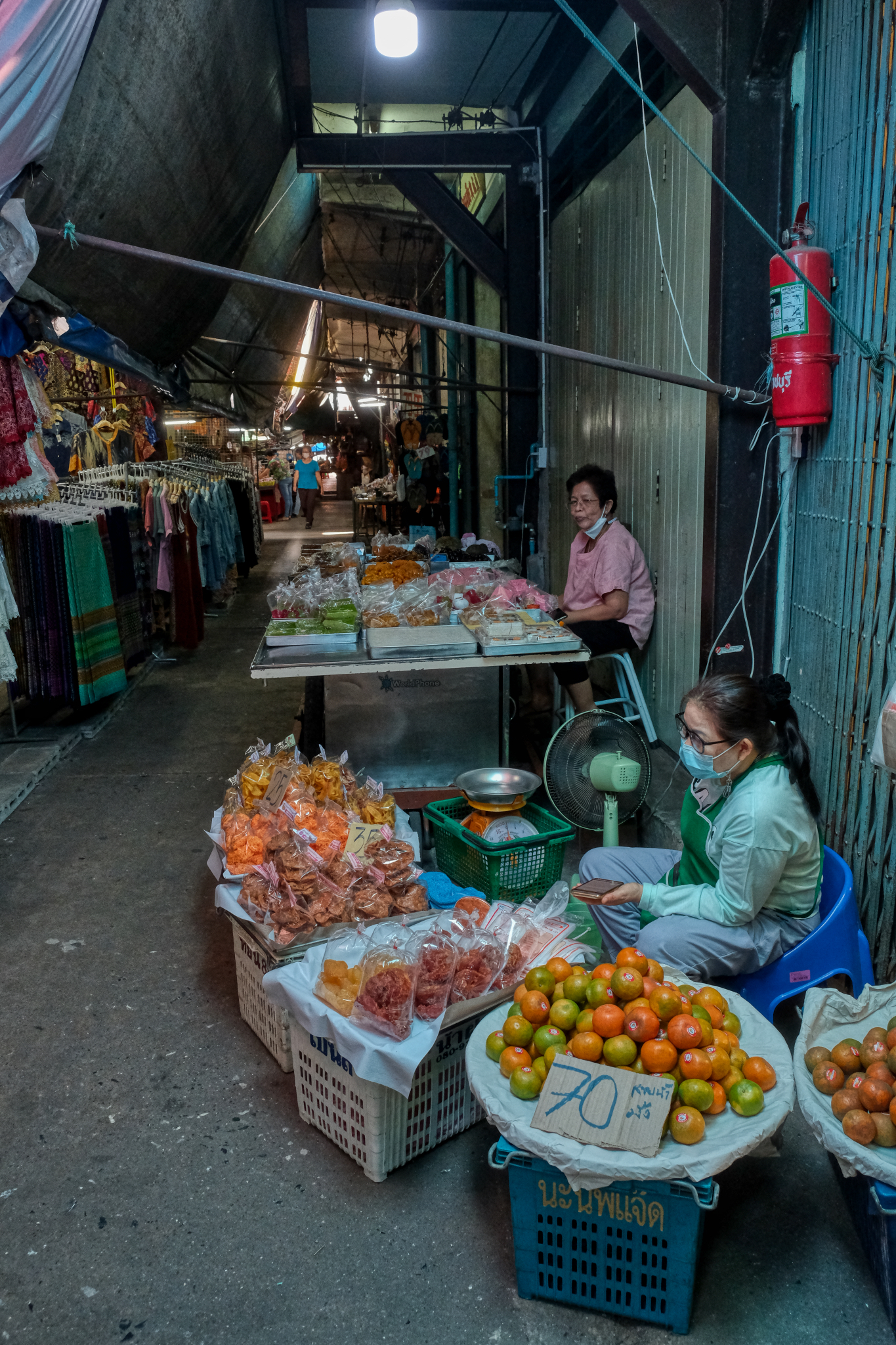 Small business in the alleys, which are themselves lined with very old small shops.
Small business in the alleys, which are themselves lined with very old small shops.
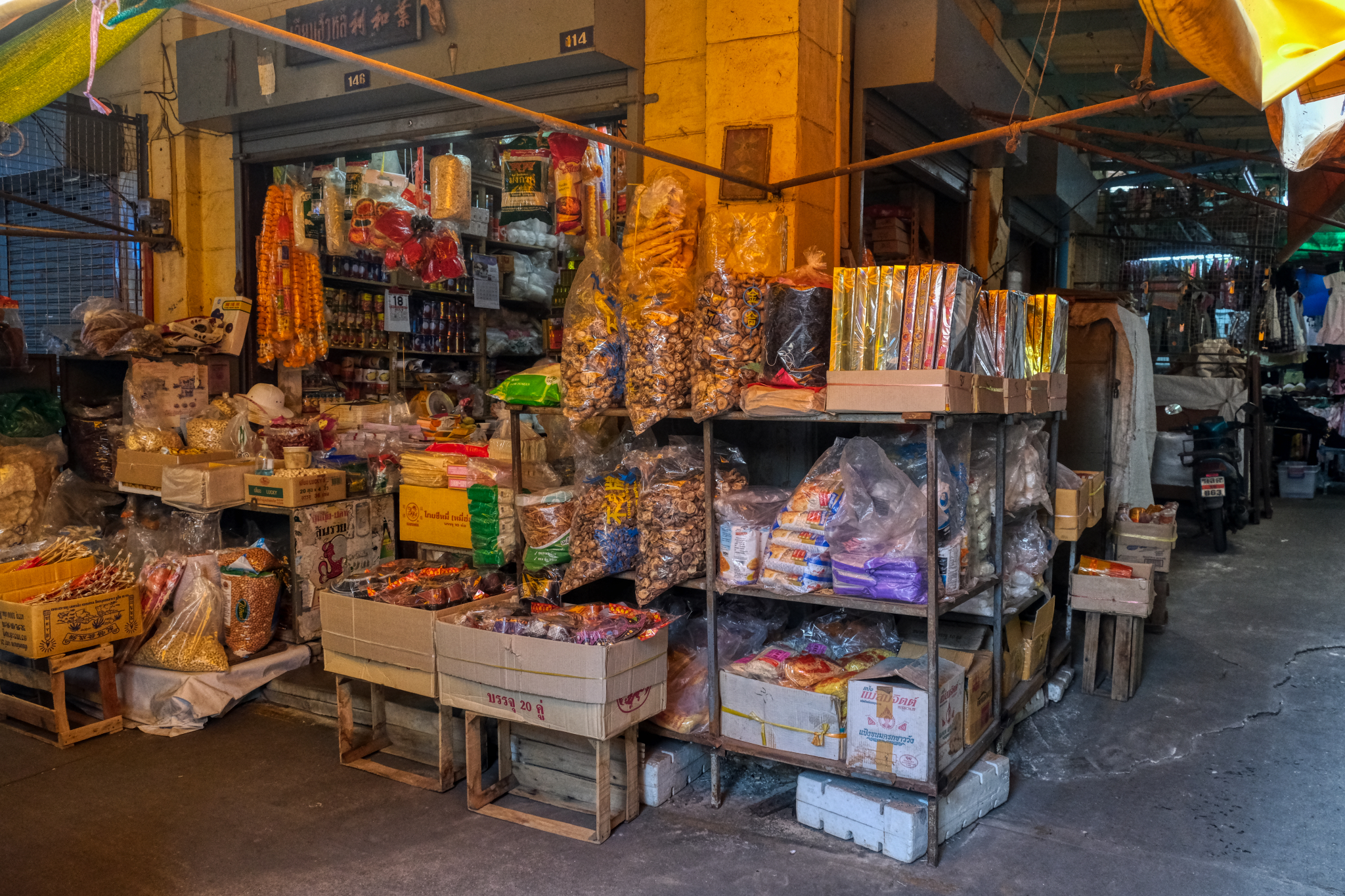 My first thought when seeing this shop was, 'supply and demand.' What kind of world is outside of this market can be deduced by what one sees for sale in it. There is an old pattern of consumption, imbedded in the cultural practices, the anthropology of food, that still demands these items.
My first thought when seeing this shop was, 'supply and demand.' What kind of world is outside of this market can be deduced by what one sees for sale in it. There is an old pattern of consumption, imbedded in the cultural practices, the anthropology of food, that still demands these items.
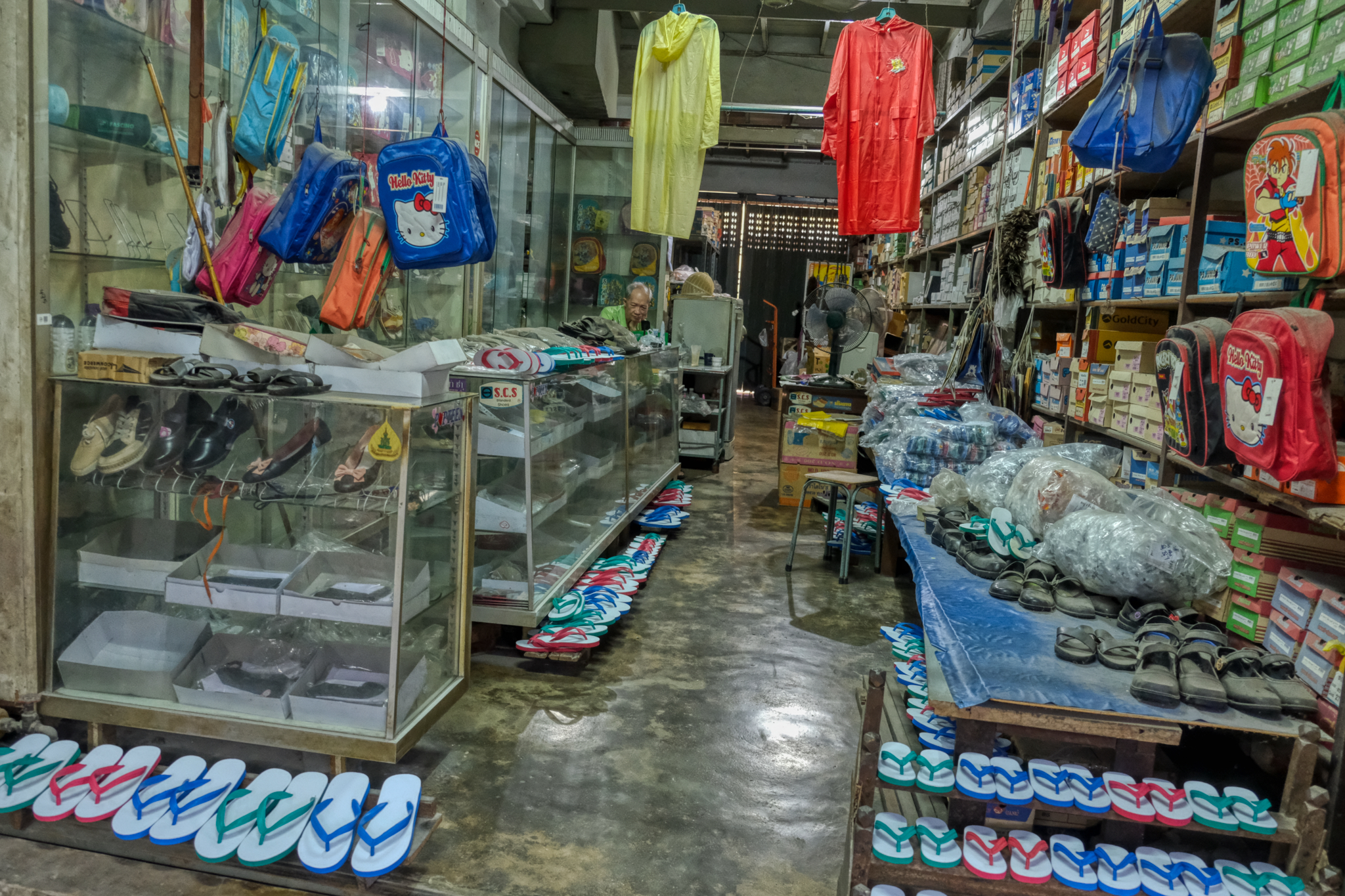 Times change. There was a time, maybe 50 years ago, when this shop was at the center of the Ratchaburi commercial center. You came here, and here only, if you wanted to buy a pair of new shoes. But the city grew in a different direction: what was the busy hub of activity has now became the backwater of the old town 'wet market.' This old man seems to have been here as long as the furniture. He doesn't even bother to dust off the shoes any more.
Times change. There was a time, maybe 50 years ago, when this shop was at the center of the Ratchaburi commercial center. You came here, and here only, if you wanted to buy a pair of new shoes. But the city grew in a different direction: what was the busy hub of activity has now became the backwater of the old town 'wet market.' This old man seems to have been here as long as the furniture. He doesn't even bother to dust off the shoes any more.
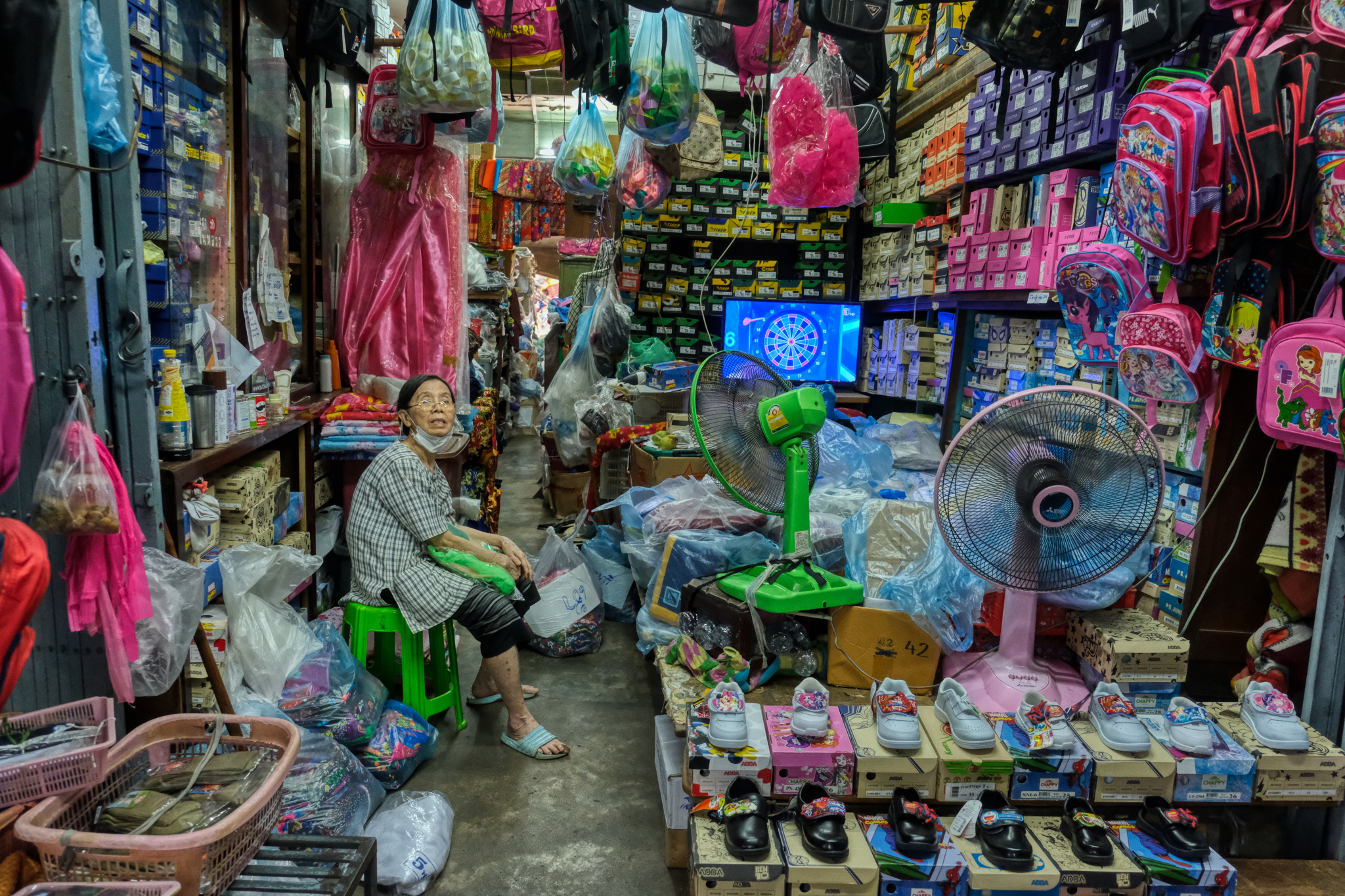 She is still hopeful and making an effort. These shops have suffered terribly during the pandemic: people do not like to congregate in the tight quarters of these narrow alleyways. I am sure she lives in the back of this shop.
She is still hopeful and making an effort. These shops have suffered terribly during the pandemic: people do not like to congregate in the tight quarters of these narrow alleyways. I am sure she lives in the back of this shop.
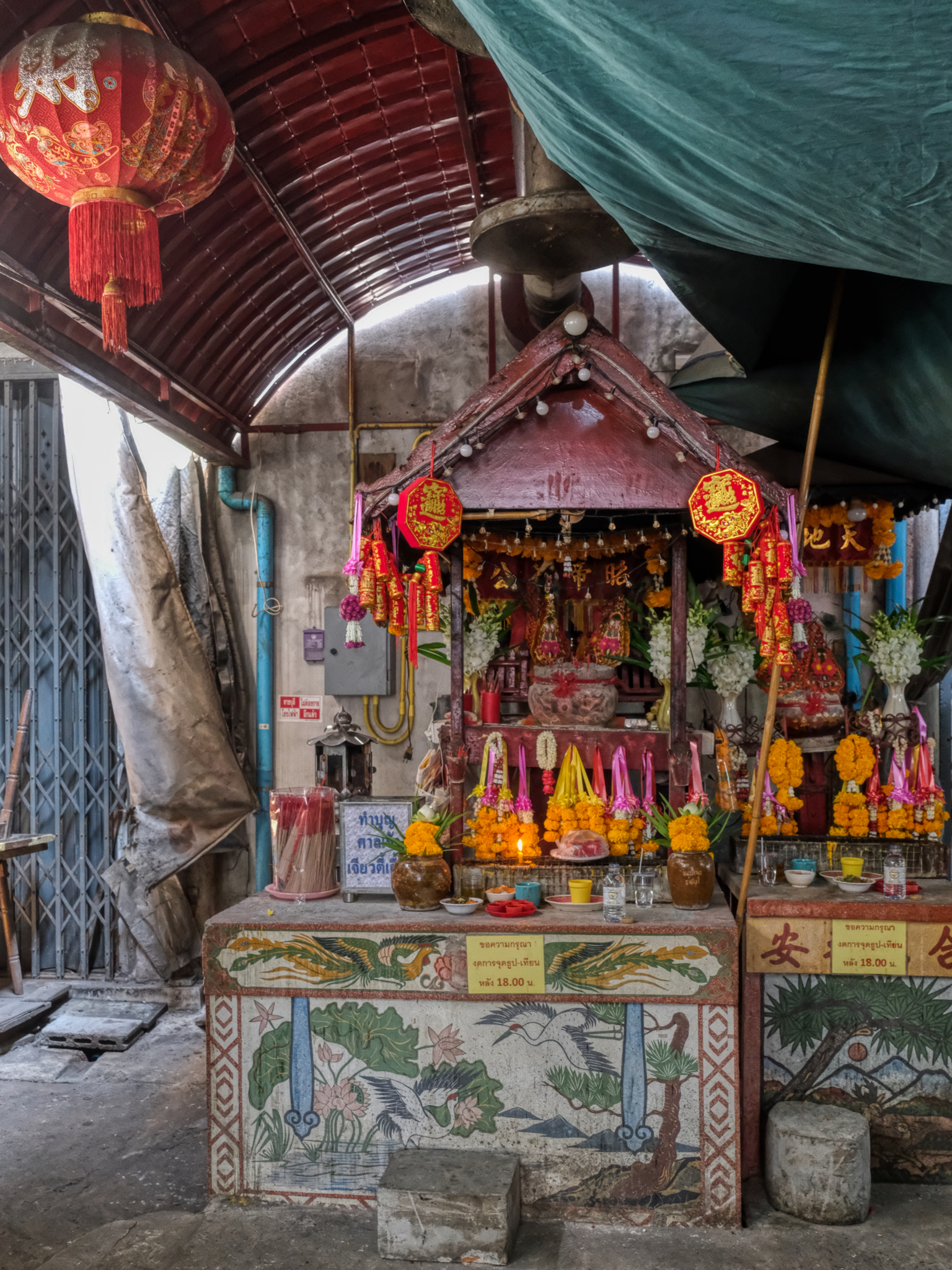 Tucked away deep in the old market is the spirit house/spirit altar for the shopkeepers to leave their offerings in hopes of better luck. The flowers and other offerings were all fresh from this very morning.
Tucked away deep in the old market is the spirit house/spirit altar for the shopkeepers to leave their offerings in hopes of better luck. The flowers and other offerings were all fresh from this very morning.
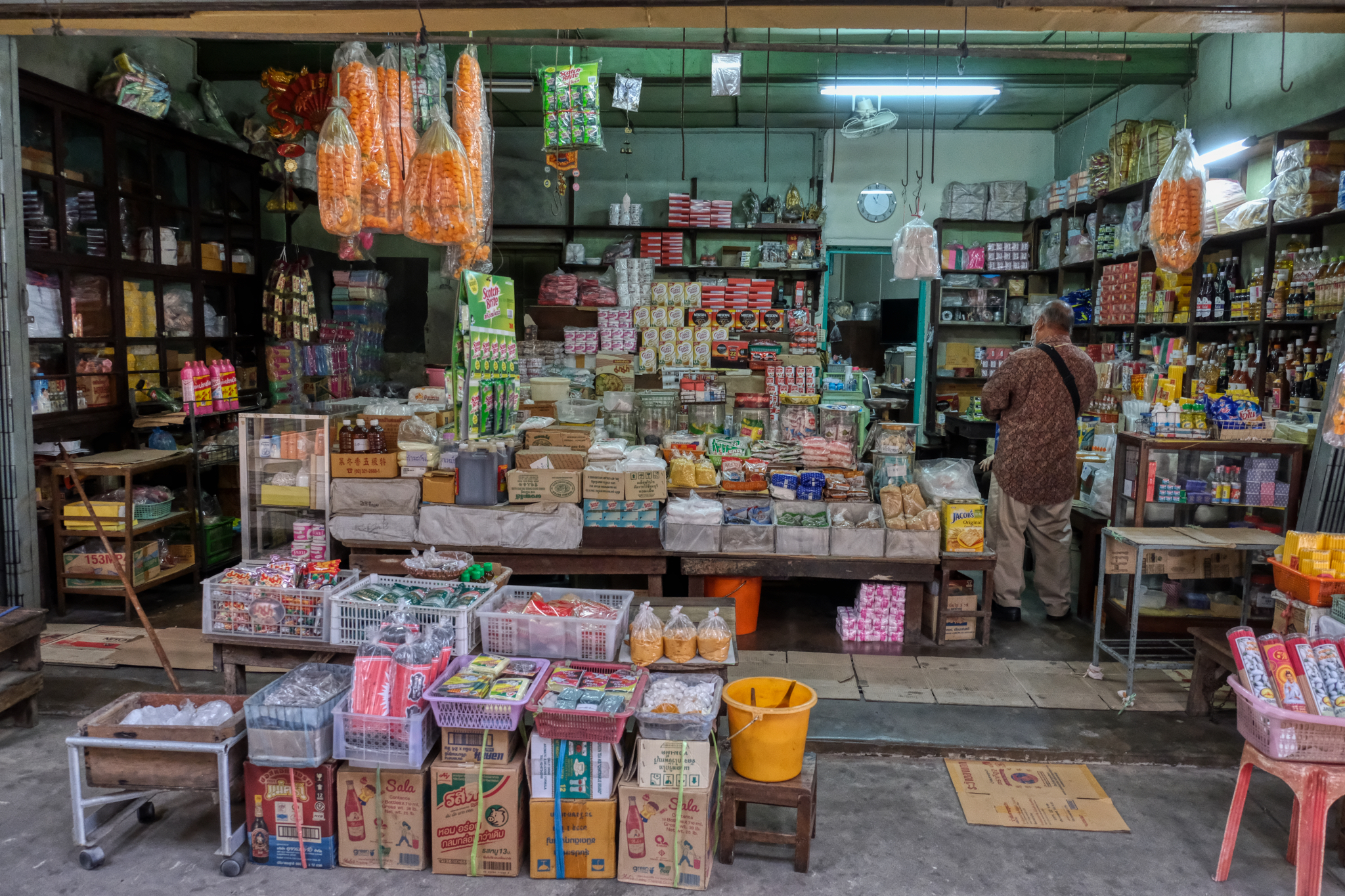 This dry goods shop in the old market seemed to be doing pretty good. You have to remember that less than a mile from this spot there are several multinational big box giant supermarkets. It is hard to understand how these small shops survive. I assume it survives by servicing those who work in the old market itself.
This dry goods shop in the old market seemed to be doing pretty good. You have to remember that less than a mile from this spot there are several multinational big box giant supermarkets. It is hard to understand how these small shops survive. I assume it survives by servicing those who work in the old market itself.
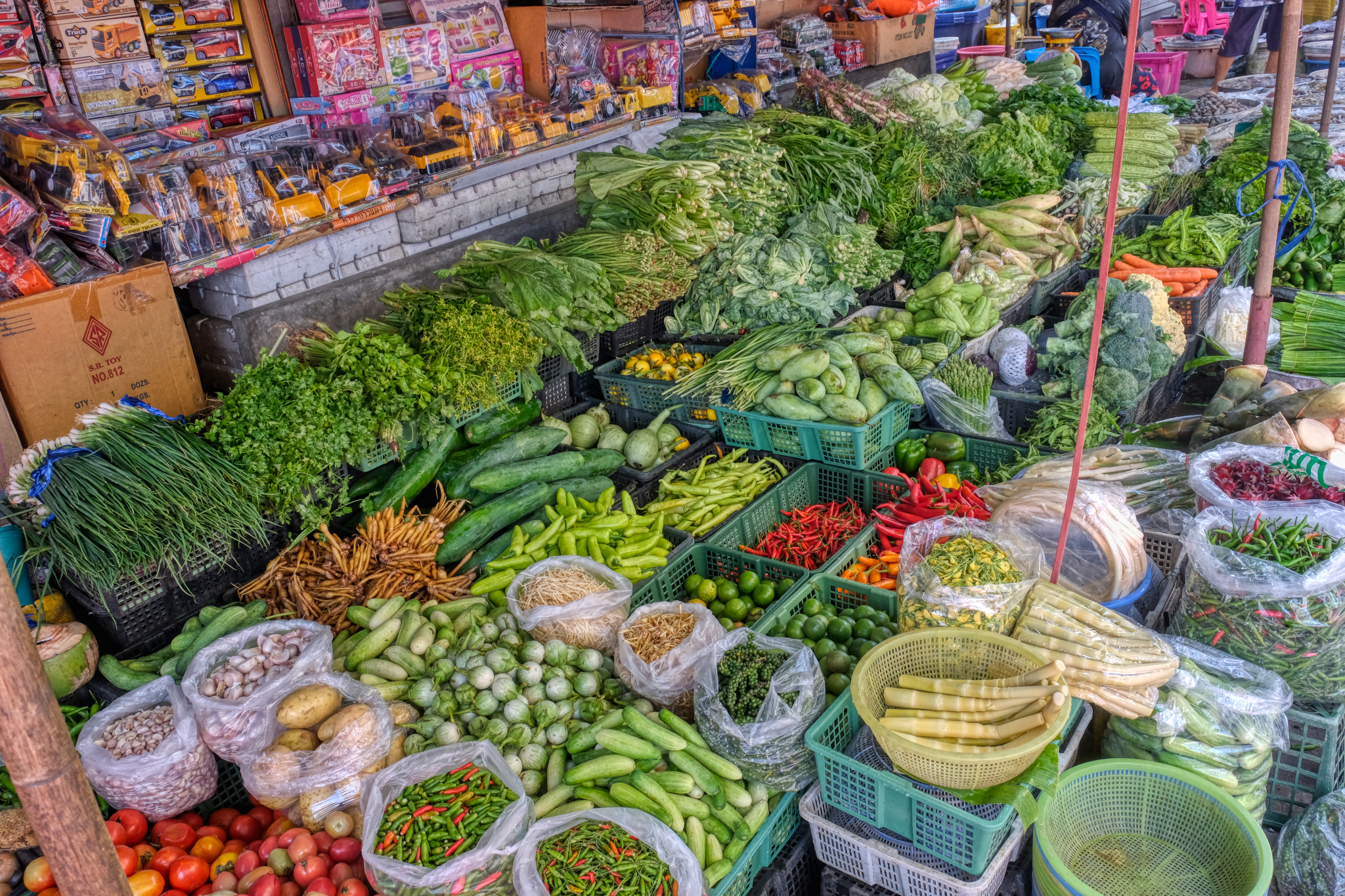 There were many sections of the old town market, and of course, one of them was for fresh fruits and vegetables. So delicious in Thailand.
There were many sections of the old town market, and of course, one of them was for fresh fruits and vegetables. So delicious in Thailand.
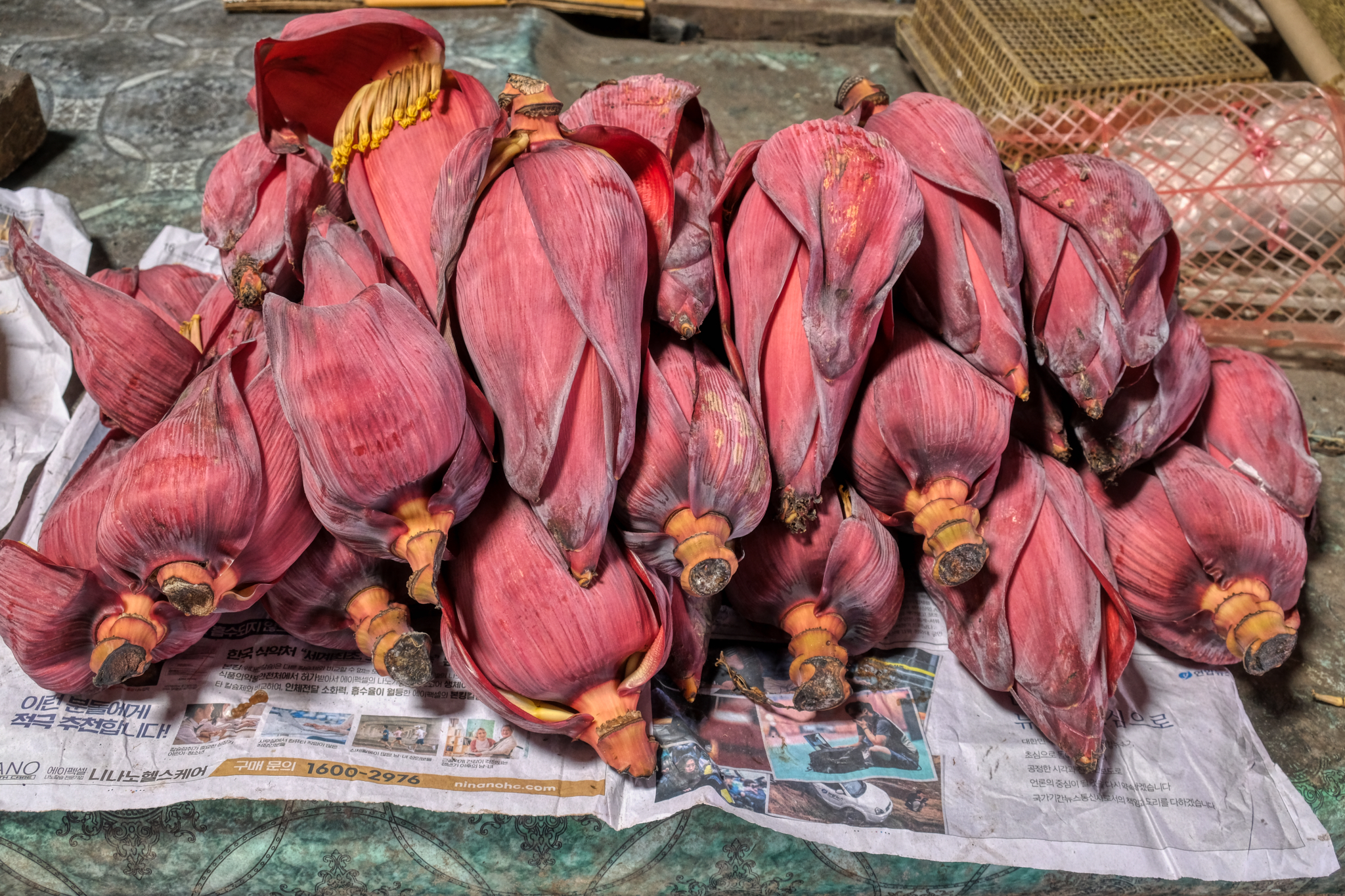 Banana flower hearts . . . used in some Thai dishes.
Banana flower hearts . . . used in some Thai dishes.
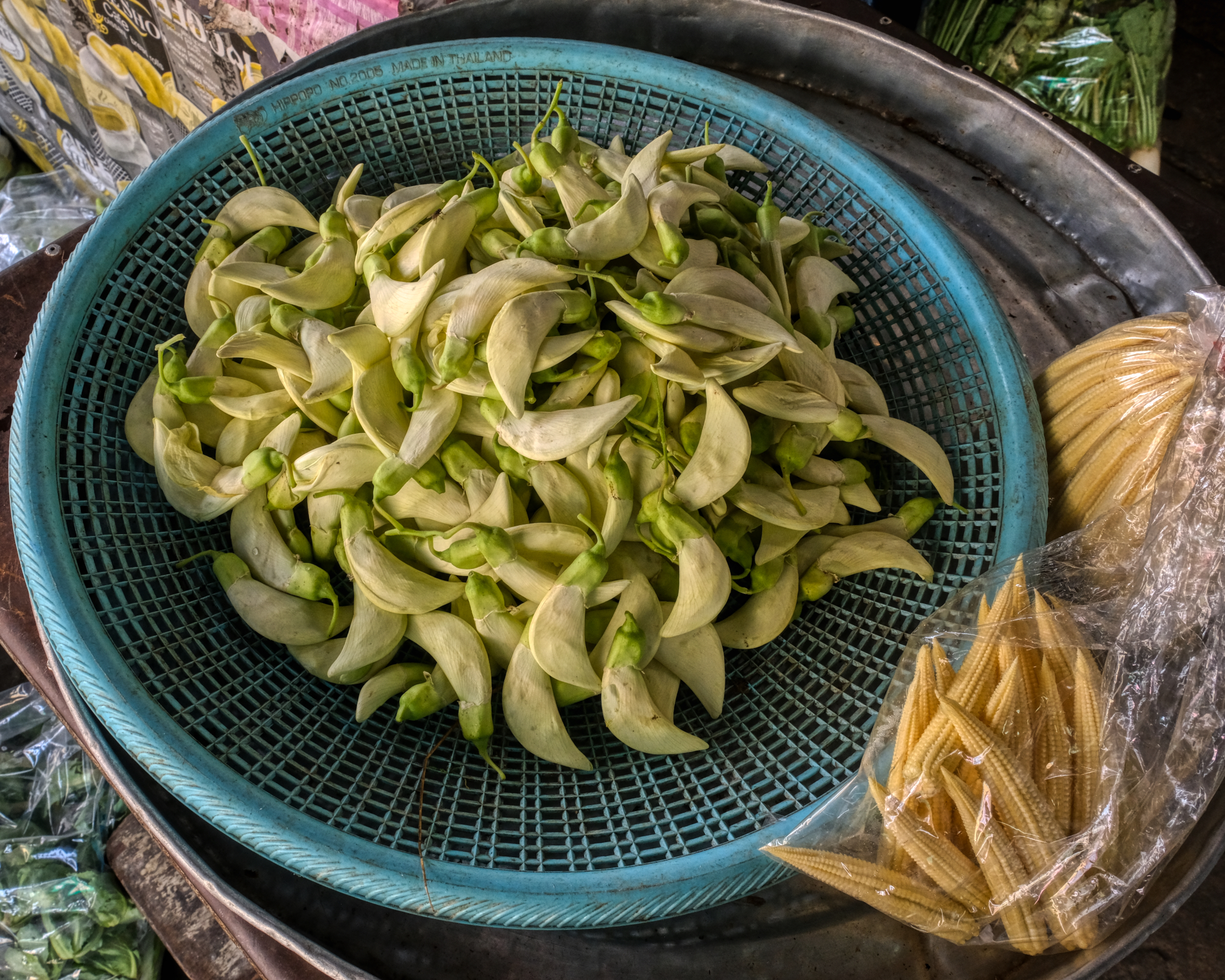 I had never seen this before . . . some kind of flower bud for use in one of the many thousands of Thai dishes.
I had never seen this before . . . some kind of flower bud for use in one of the many thousands of Thai dishes.
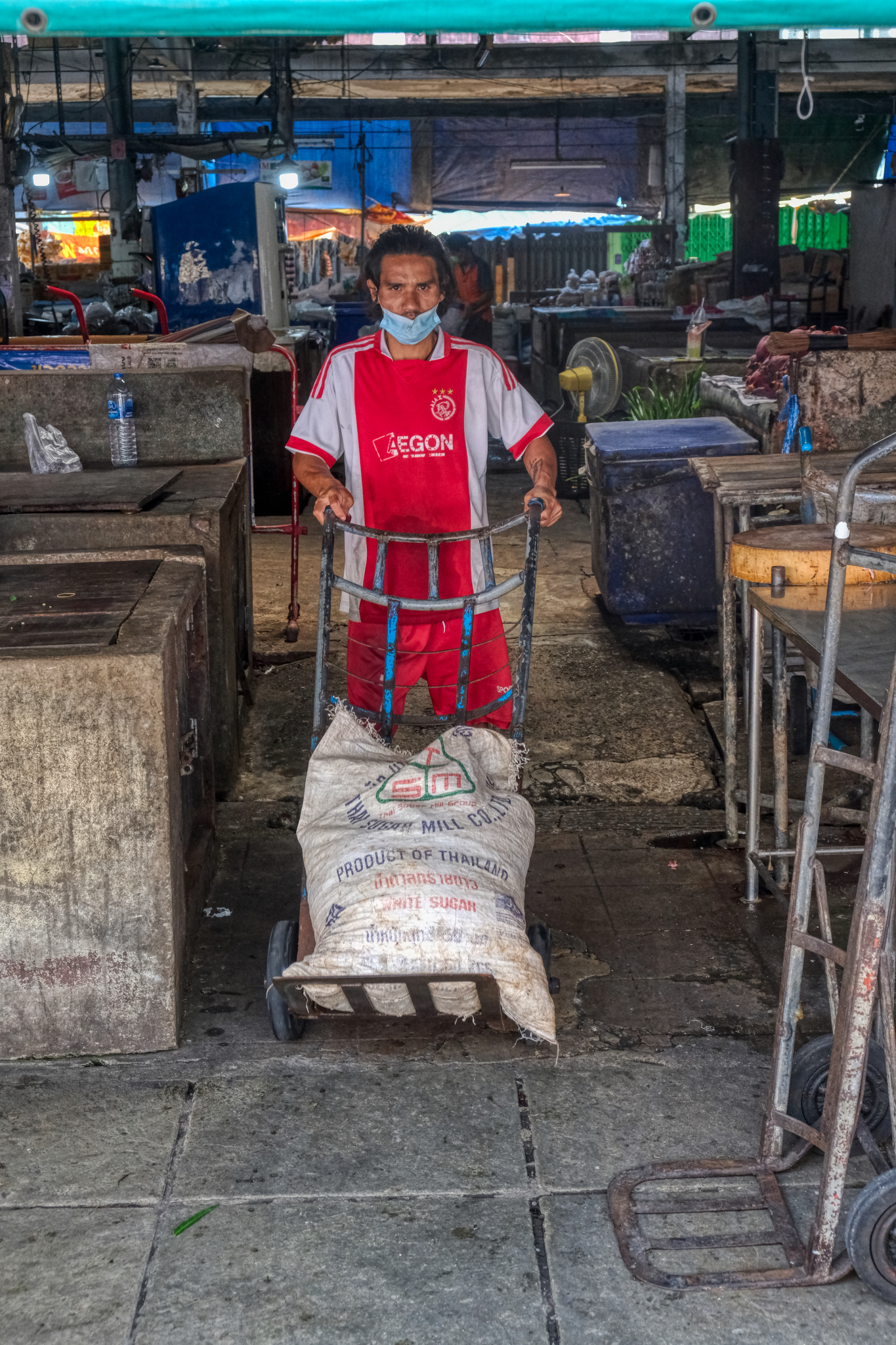 Although most of the market I saw so far was clean, neat, and recently refurbished, I eventually found the oldest part of the market. It was partially abandoned and the commerce there seemed to be left to the poorest people.
Although most of the market I saw so far was clean, neat, and recently refurbished, I eventually found the oldest part of the market. It was partially abandoned and the commerce there seemed to be left to the poorest people.
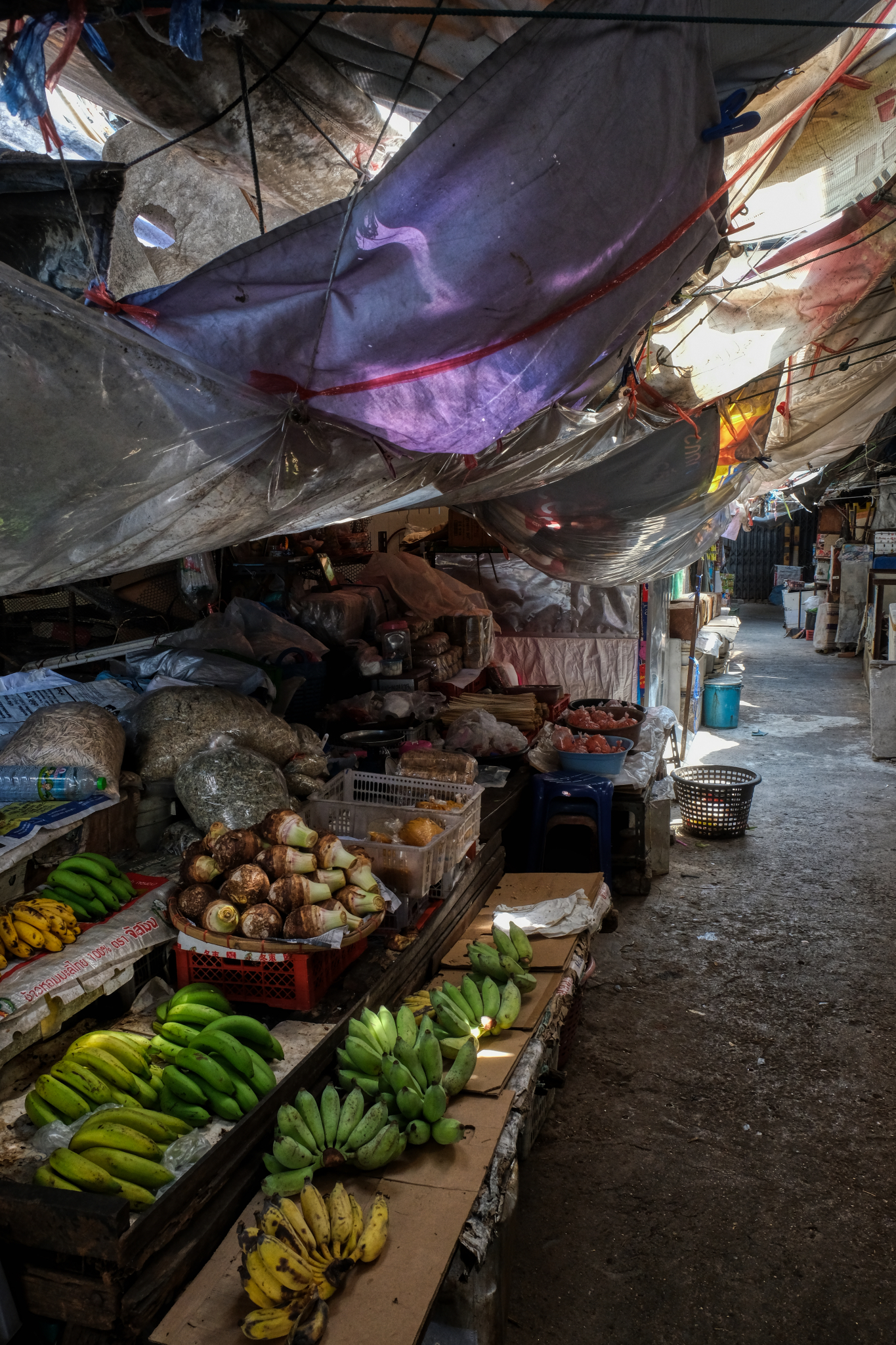 Old plastic rain flies over meagre offerings in the old, dead market. It is here we see the dilapidation caused by the corporate big box stores a couple of blocks away. I LOVE this photo.
Old plastic rain flies over meagre offerings in the old, dead market. It is here we see the dilapidation caused by the corporate big box stores a couple of blocks away. I LOVE this photo.
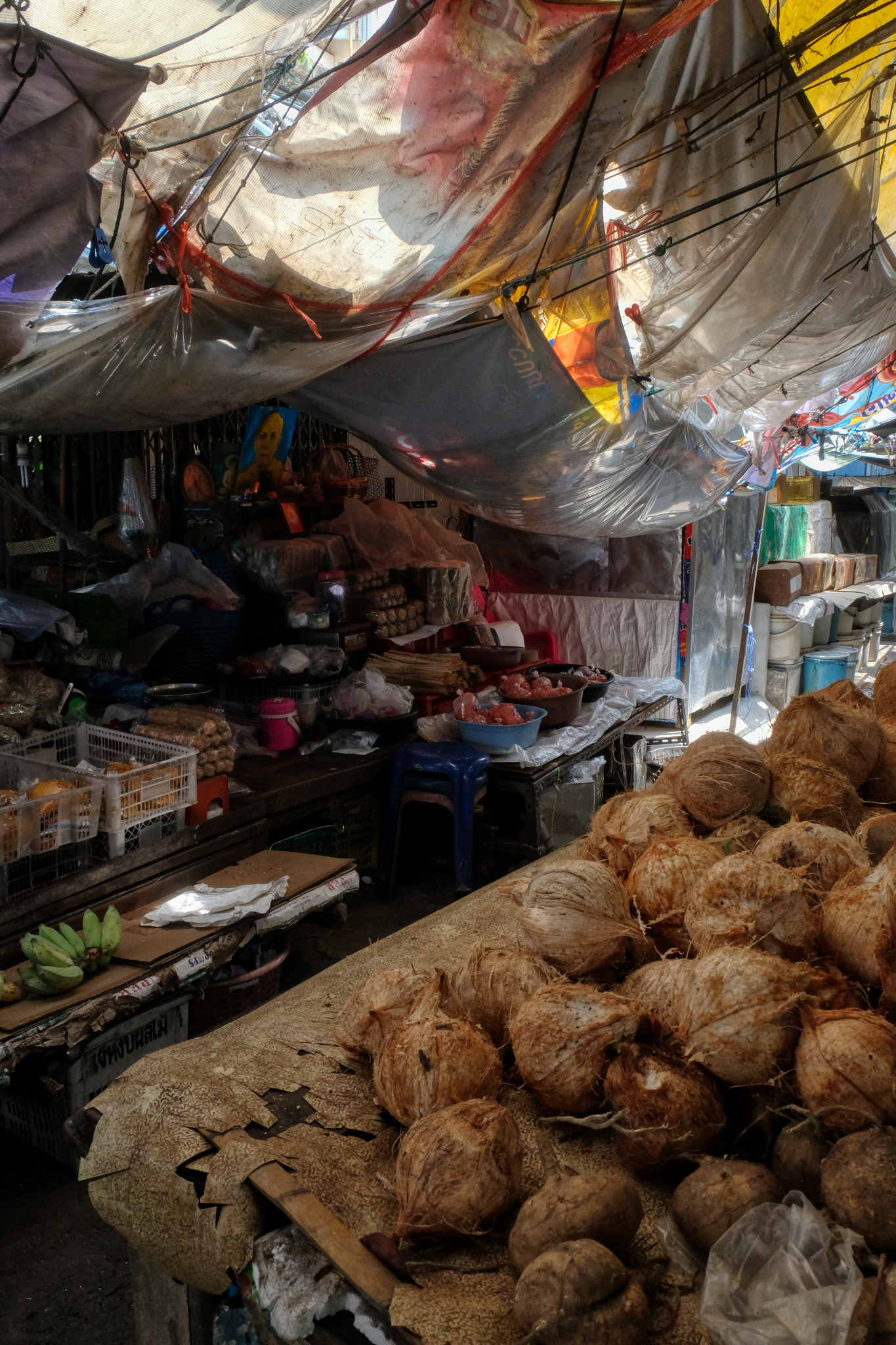 Old coconuts for sale.
Old coconuts for sale.
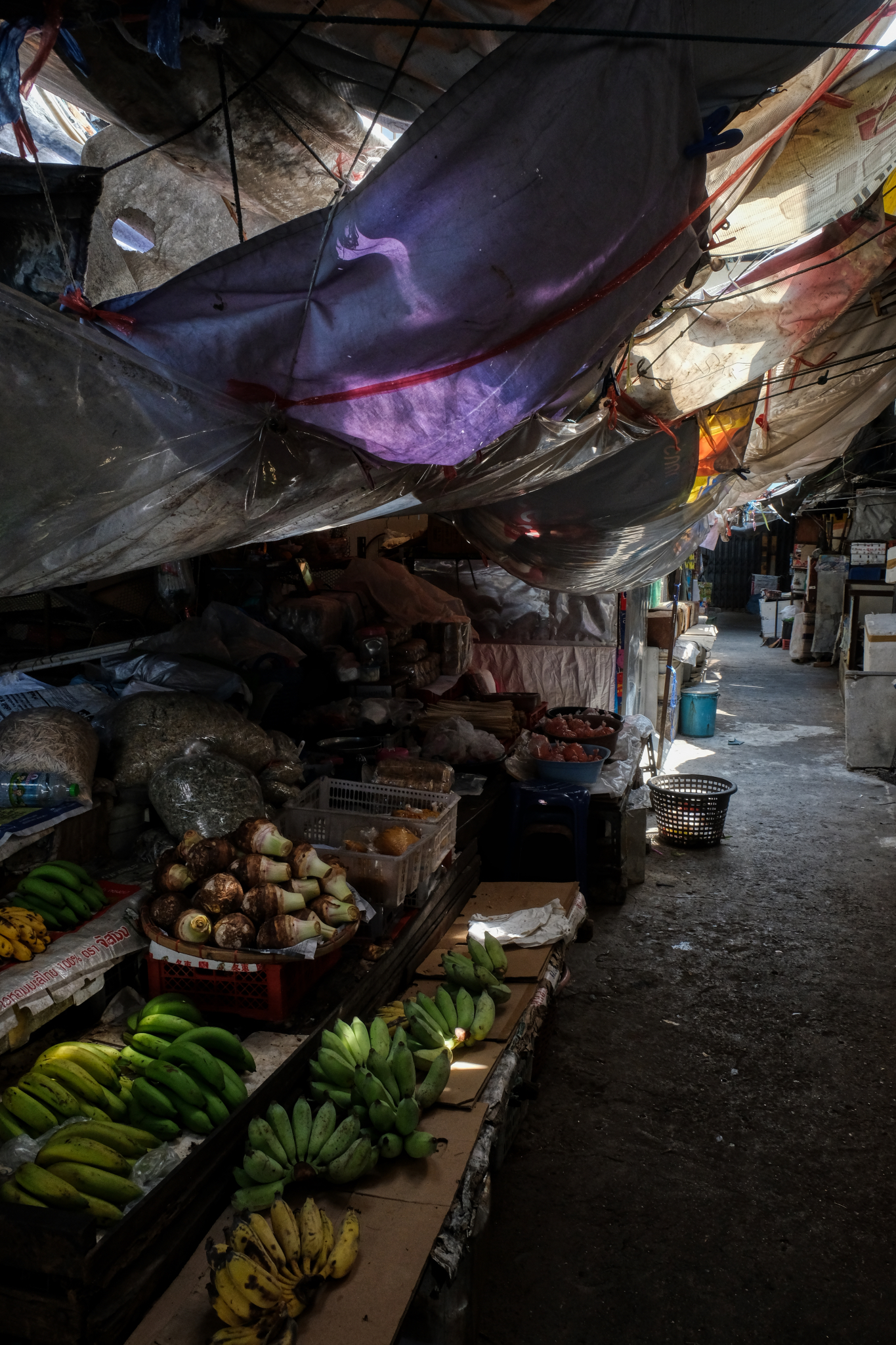 I was the ONLY person in this part of the market. Nobody was here, not even the merchants . . . at 10:00 in the morning.
I was the ONLY person in this part of the market. Nobody was here, not even the merchants . . . at 10:00 in the morning.
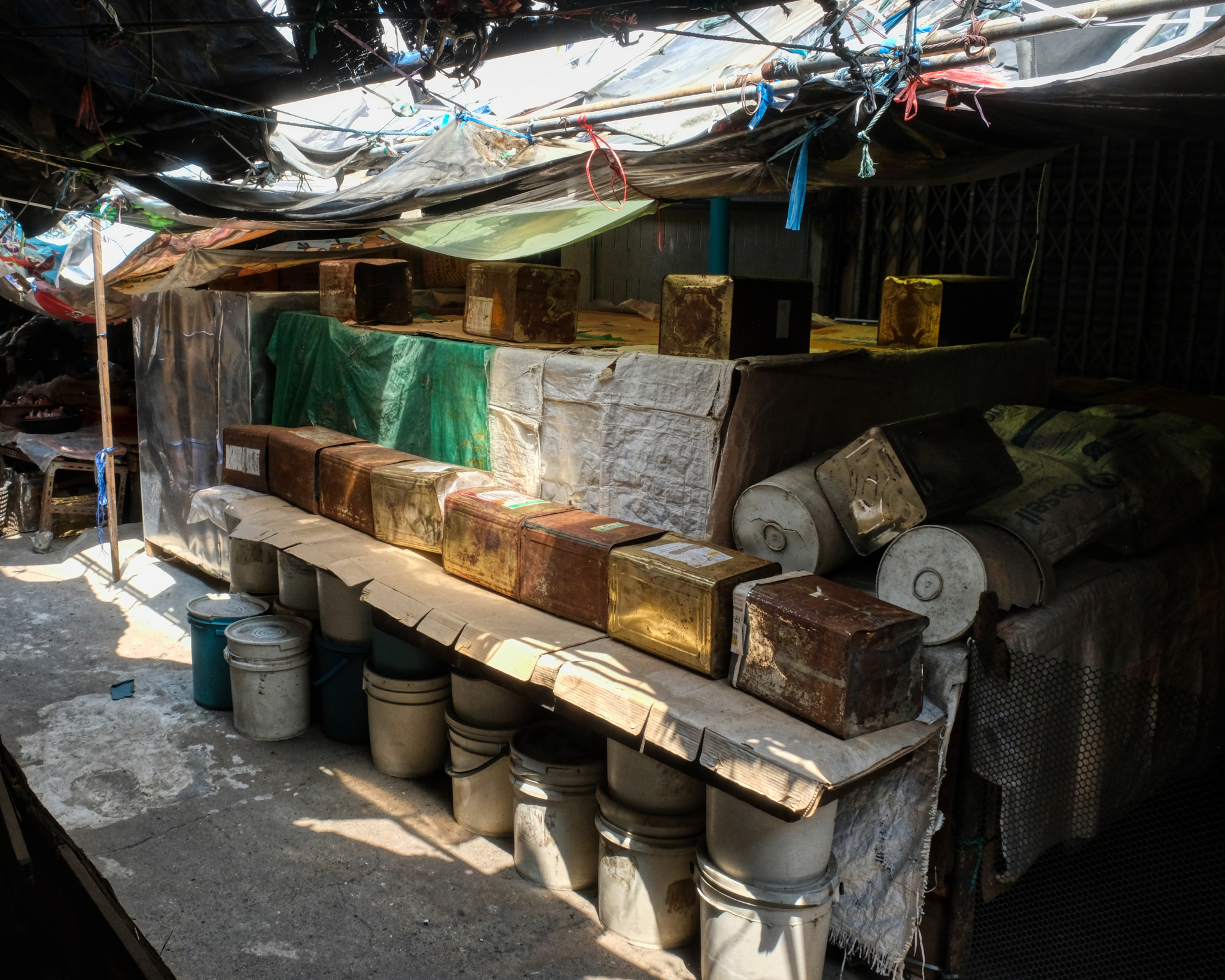 I tried to imagine what this 'business' was . . . but came up short.
I tried to imagine what this 'business' was . . . but came up short.
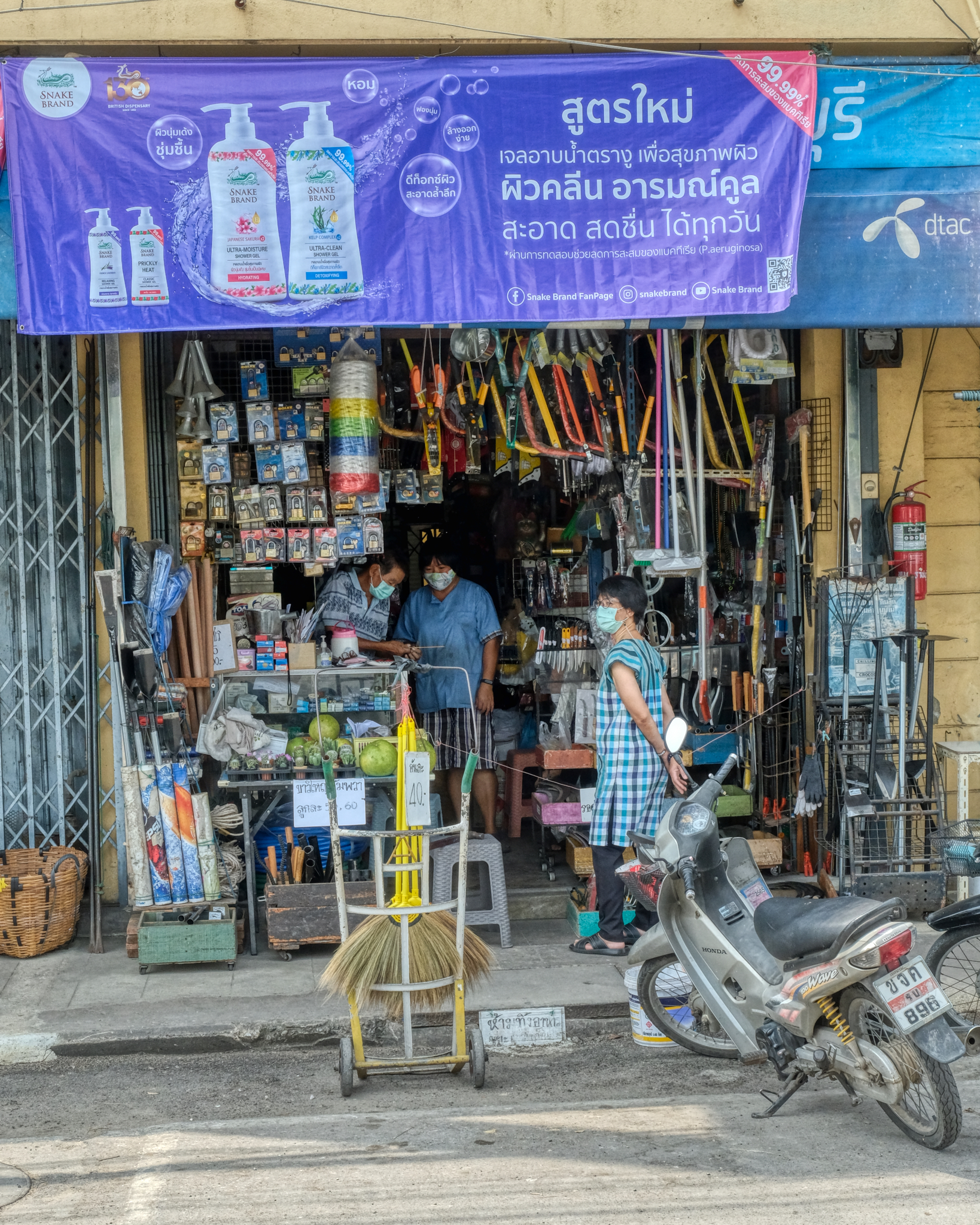
Outside of the inner alleyways of the old market, along the city streets, are more businesses. Here ,a hardware store.
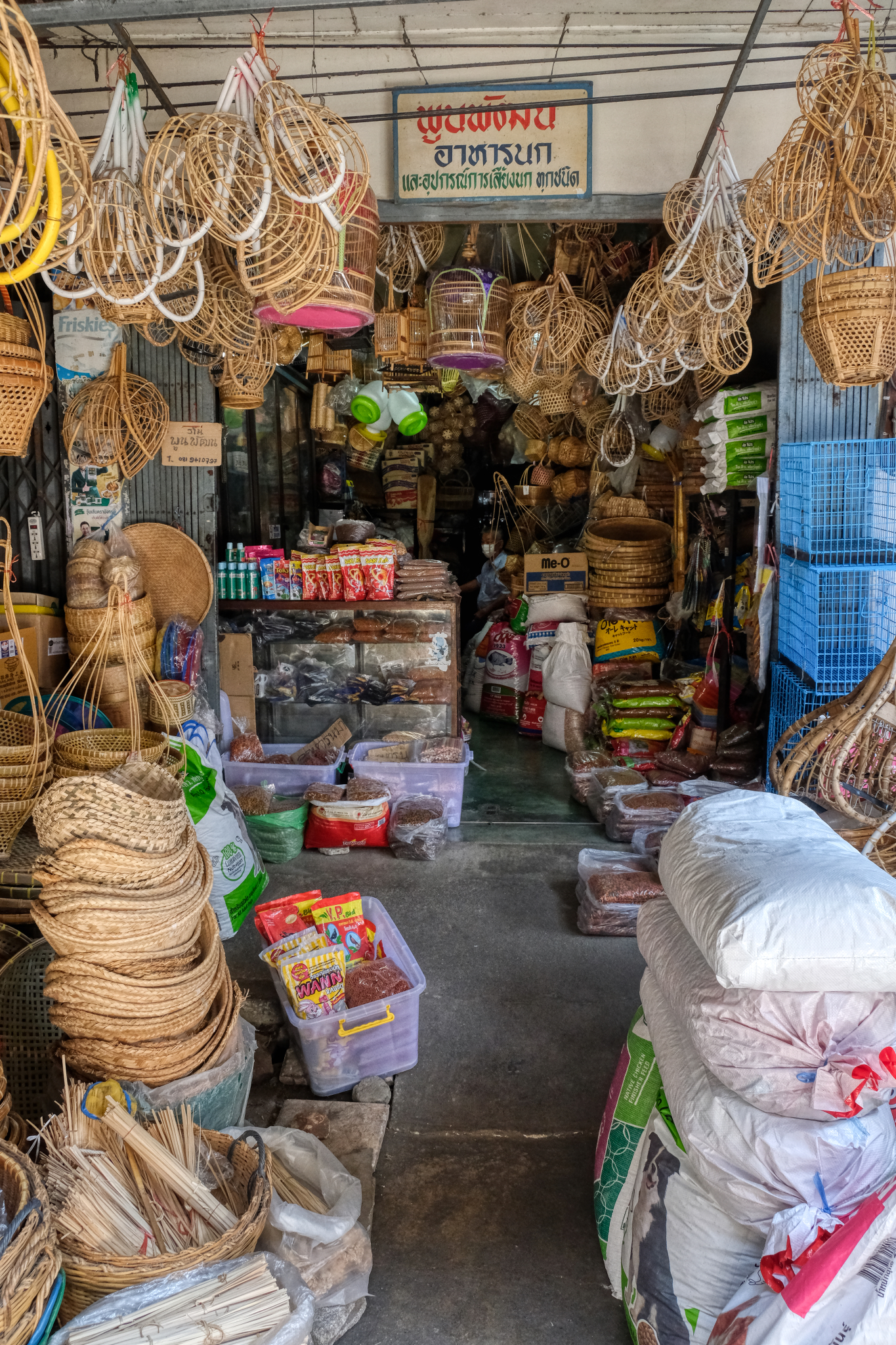 Shops that have everything a local resident would want and need.
Shops that have everything a local resident would want and need.
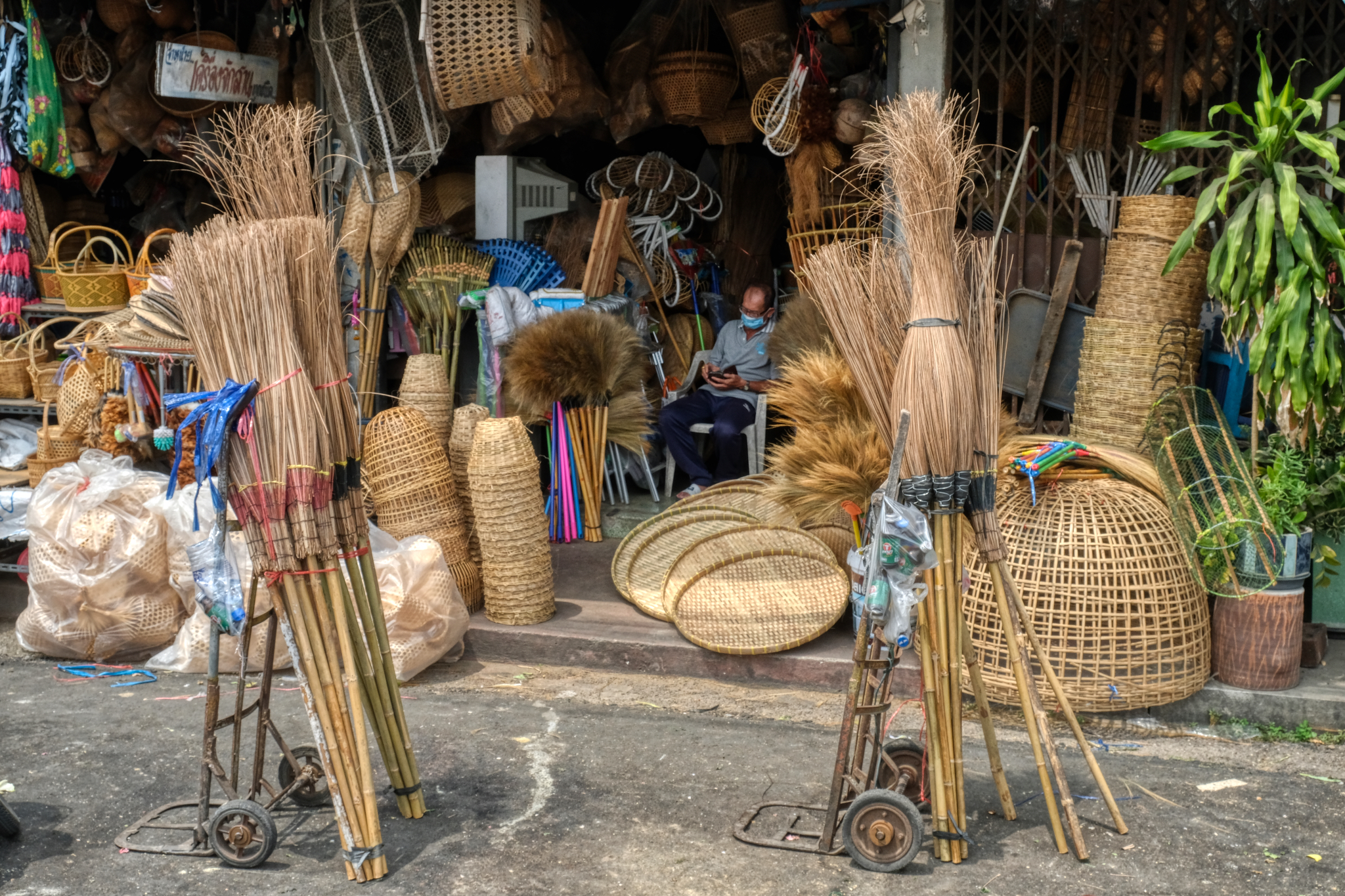 If it can be made out of straw, bamboo, or wicker . . . . they have it here.
If it can be made out of straw, bamboo, or wicker . . . . they have it here.
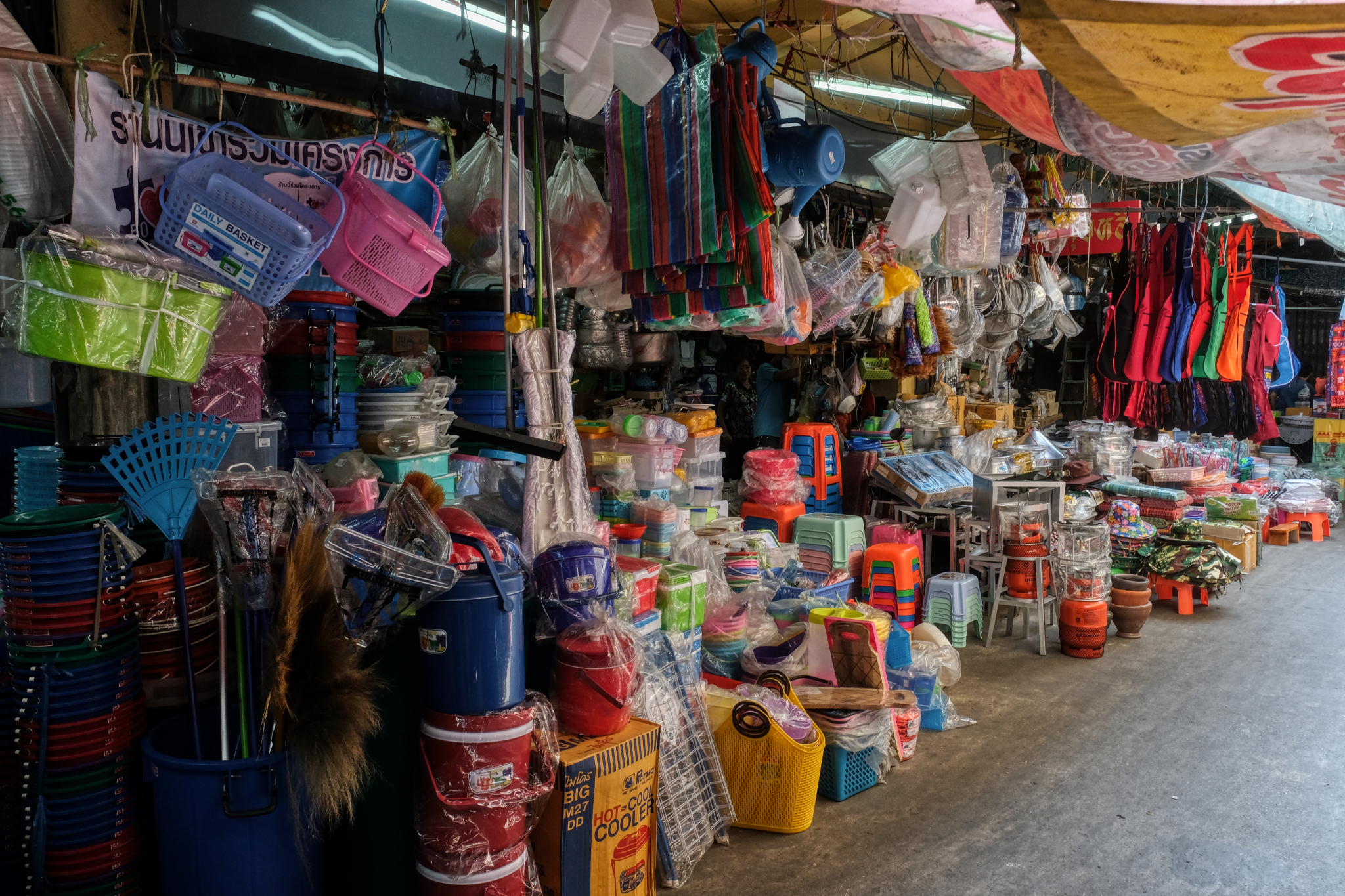 Of course, if it can be made out of straw, bamboo, or wicker . . . it can also be made out of plastic.
Of course, if it can be made out of straw, bamboo, or wicker . . . it can also be made out of plastic.
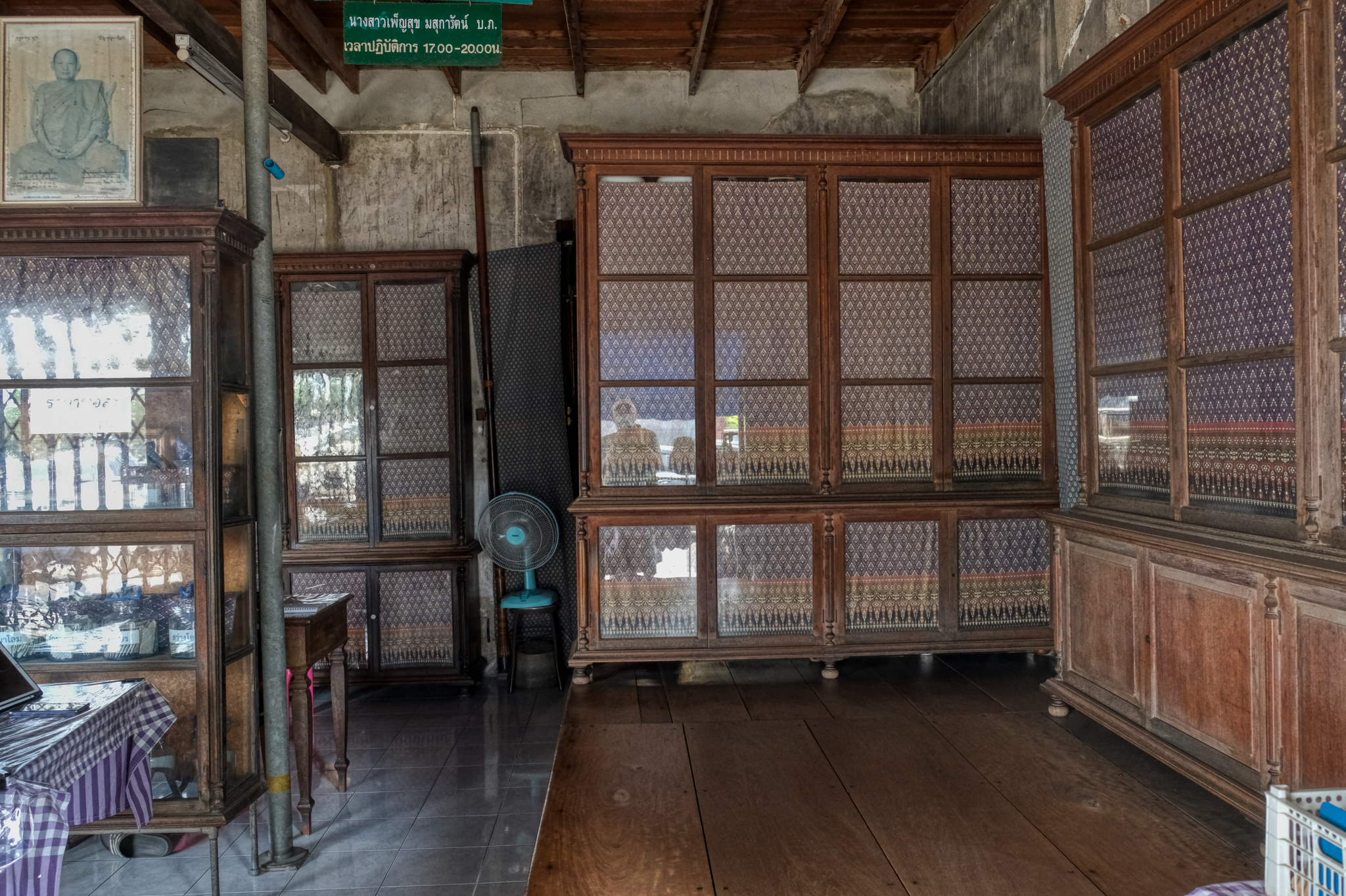 The owner of this shop told me it was restored to how it was when her family started it 100 years ago. A beautiful look into the past times in Thailand.
The owner of this shop told me it was restored to how it was when her family started it 100 years ago. A beautiful look into the past times in Thailand.
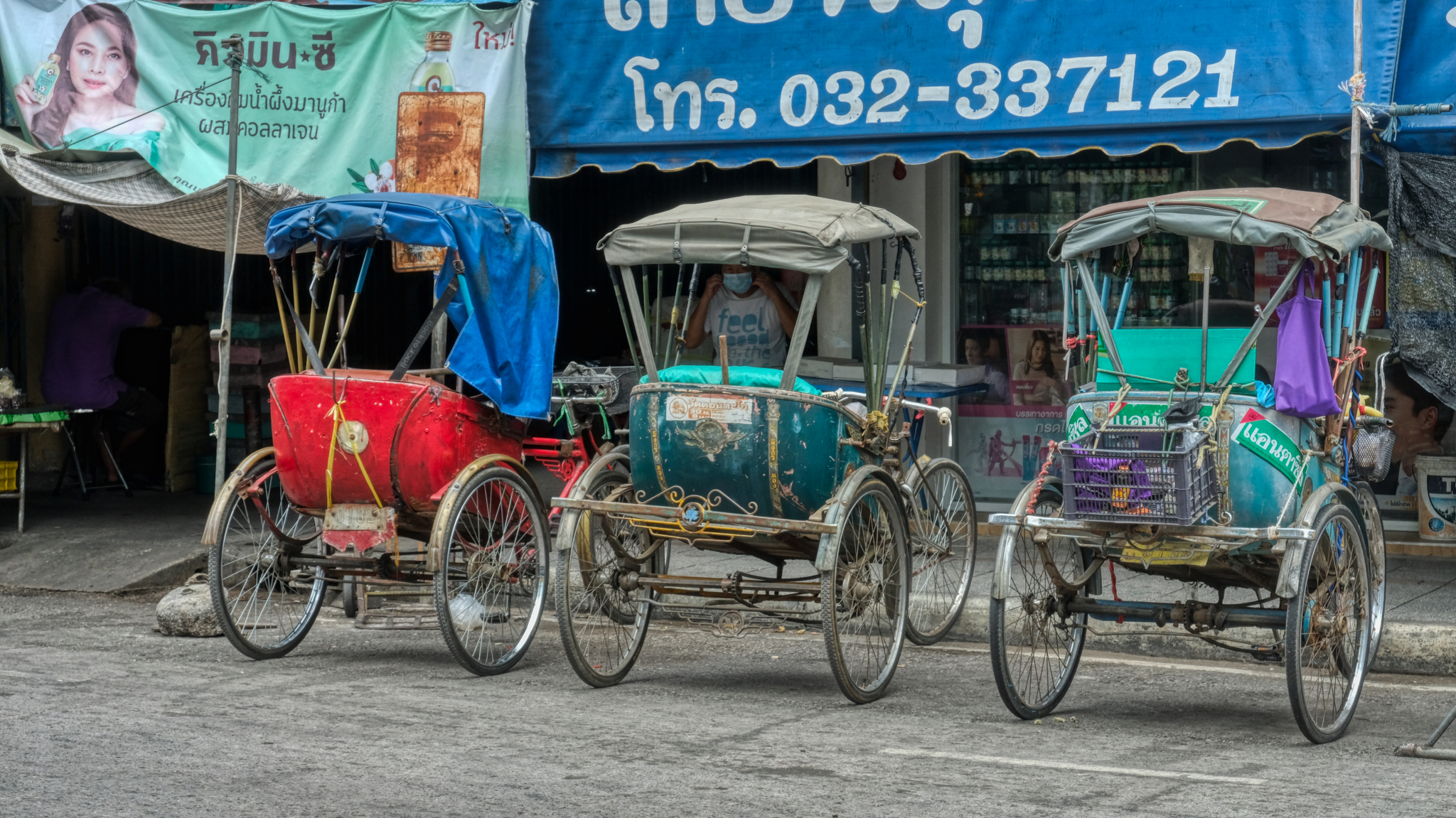 When I came to live in Thailand 26 years ago these samlors were ubiquitous. There would always be 20-30 of these 'pedal cabs' lied up next to the wet markets ready to take the customers home. Now it is rare to see them anywhere any more.
When I came to live in Thailand 26 years ago these samlors were ubiquitous. There would always be 20-30 of these 'pedal cabs' lied up next to the wet markets ready to take the customers home. Now it is rare to see them anywhere any more.
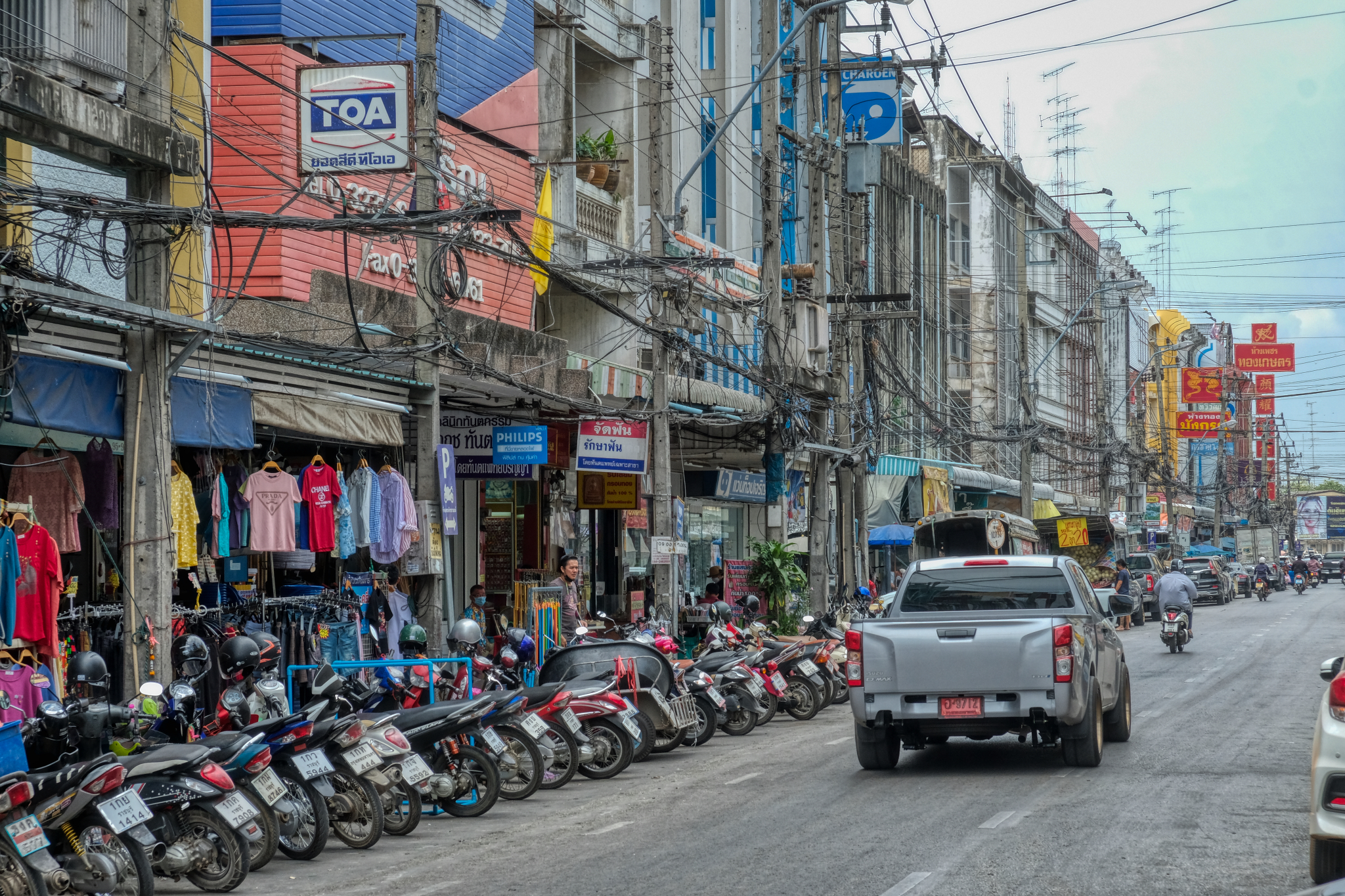 The "modern" Ratchiburi commercial center, dating from the 1970s and 1980s. Of course the true 'modern' Ratchiburi commercial zone is now located in the multinational Big Box stores and shopping malls that dot the major roads leading in and out of the town . . . and the Thais drive there in their pick-up trucks.
The "modern" Ratchiburi commercial center, dating from the 1970s and 1980s. Of course the true 'modern' Ratchiburi commercial zone is now located in the multinational Big Box stores and shopping malls that dot the major roads leading in and out of the town . . . and the Thais drive there in their pick-up trucks.
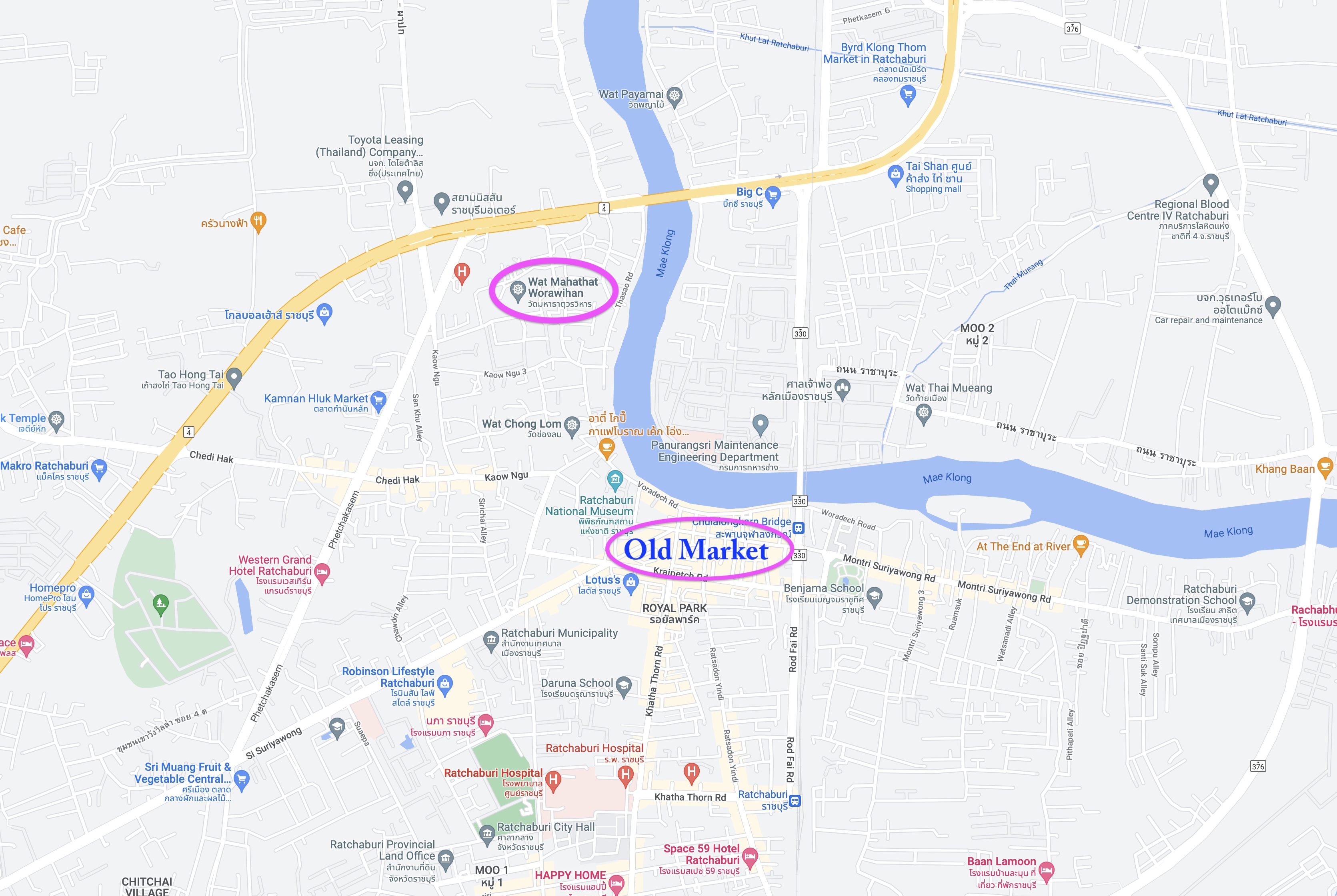 My last stop was at the amazing 10th century Wat Mahathat Worawihan.
My last stop was at the amazing 10th century Wat Mahathat Worawihan.
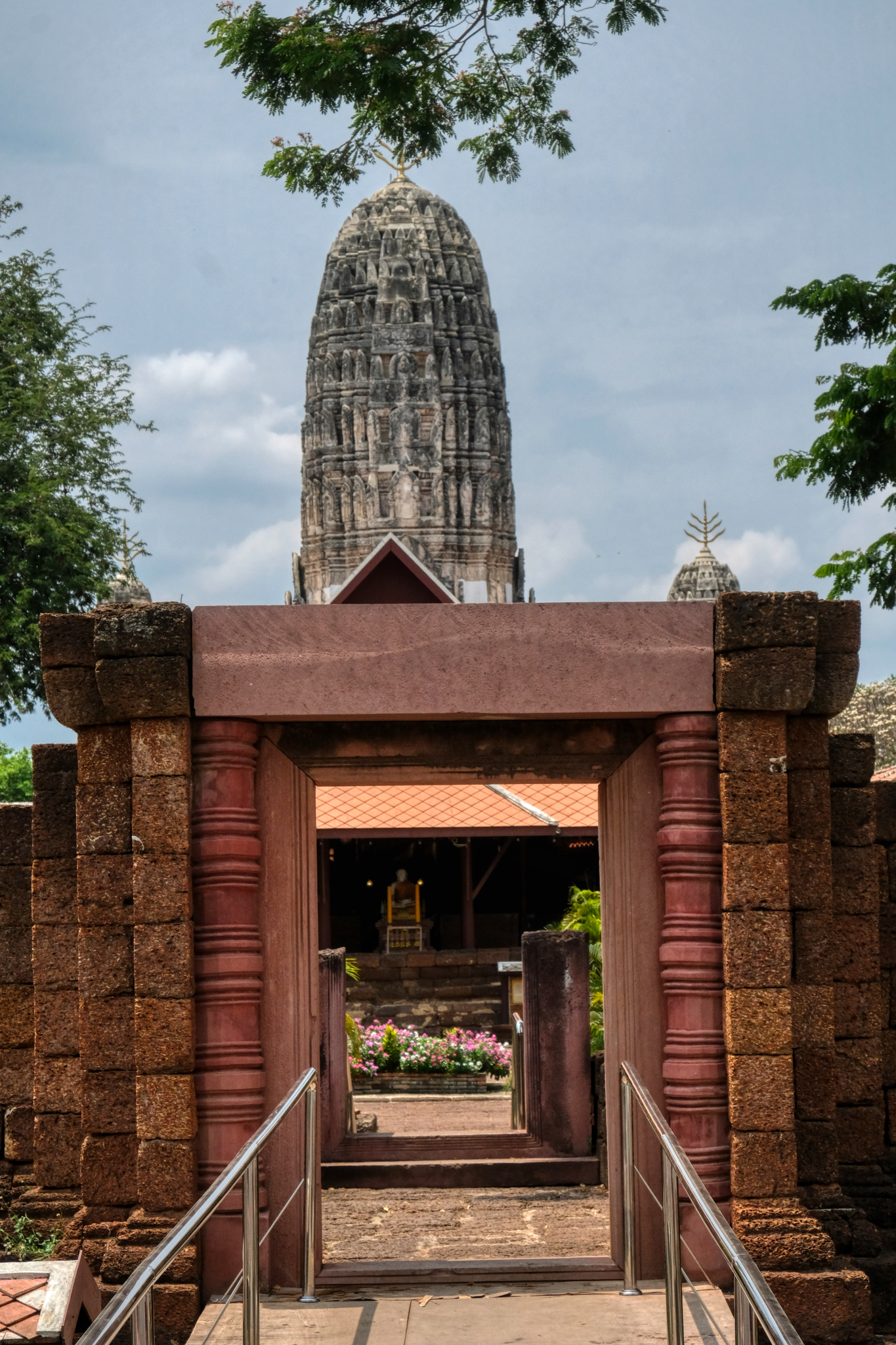 The front gate of Wat Mahathat Worawihan did not impress. But what was within astonished me.
The front gate of Wat Mahathat Worawihan did not impress. But what was within astonished me.
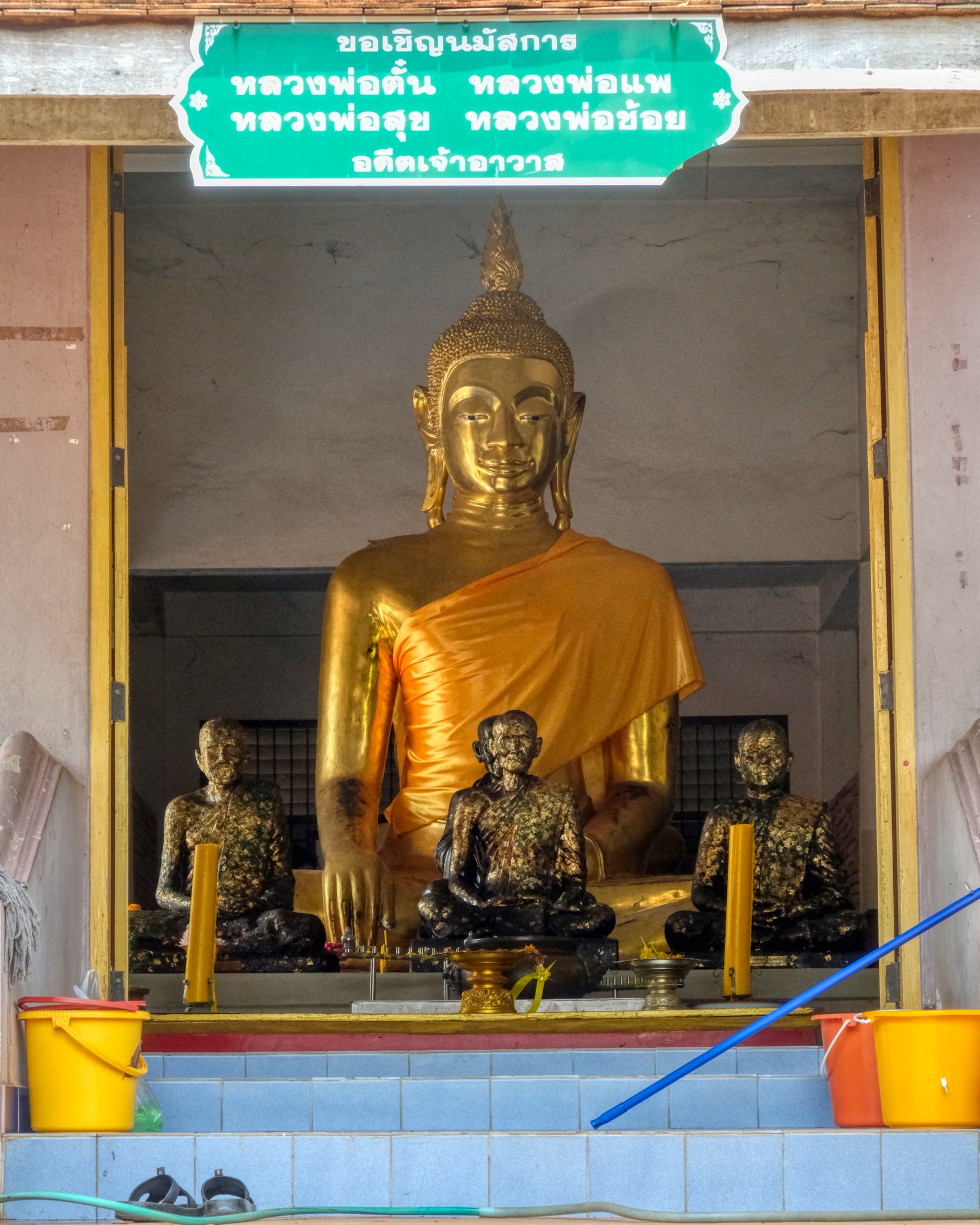 My first inkling about the beauty within this was was when I looked through a small building's window and saw this.
My first inkling about the beauty within this was was when I looked through a small building's window and saw this.
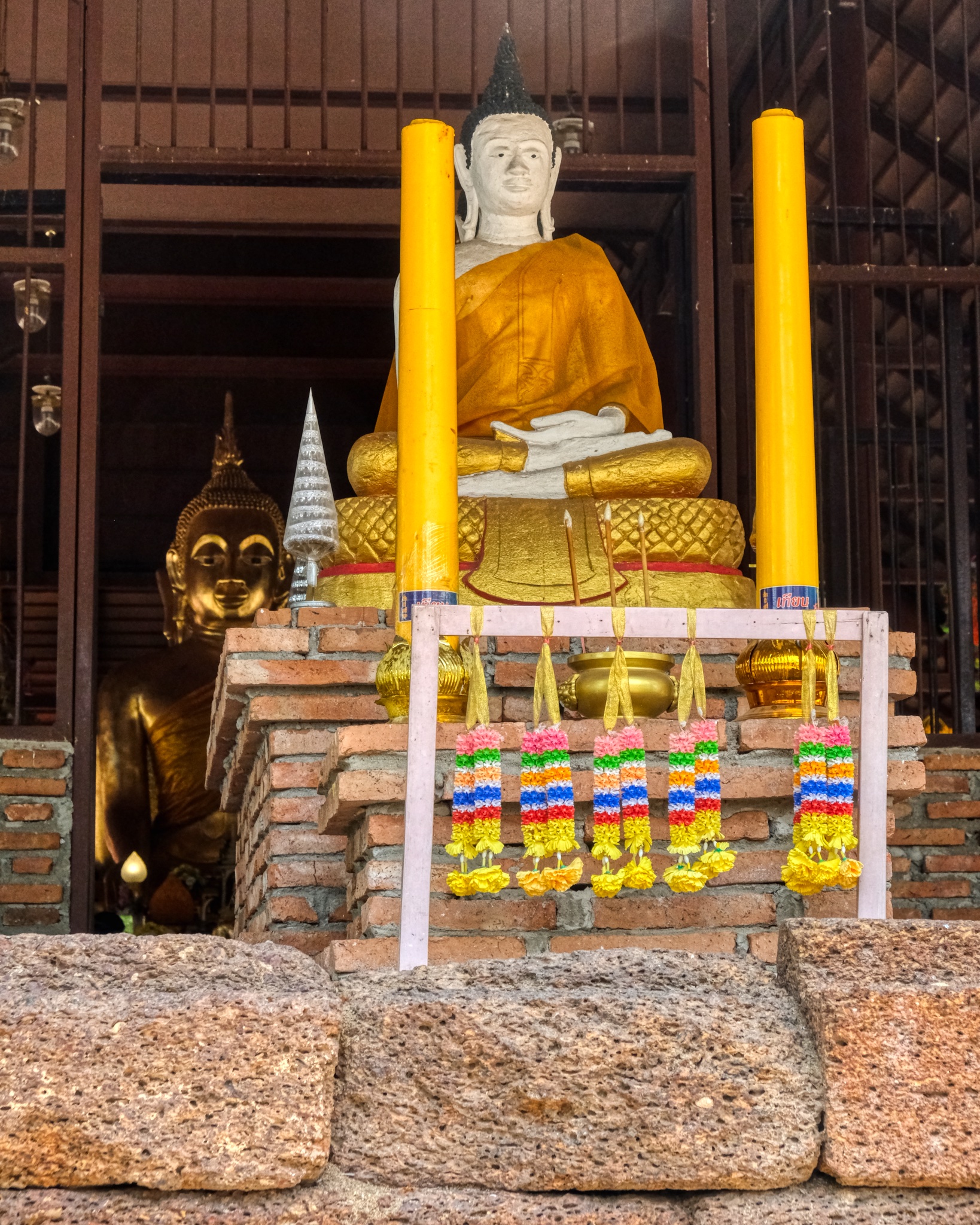 The sala/temple straight ahead looked inviting. I could see a large Buddha image within.
The sala/temple straight ahead looked inviting. I could see a large Buddha image within.
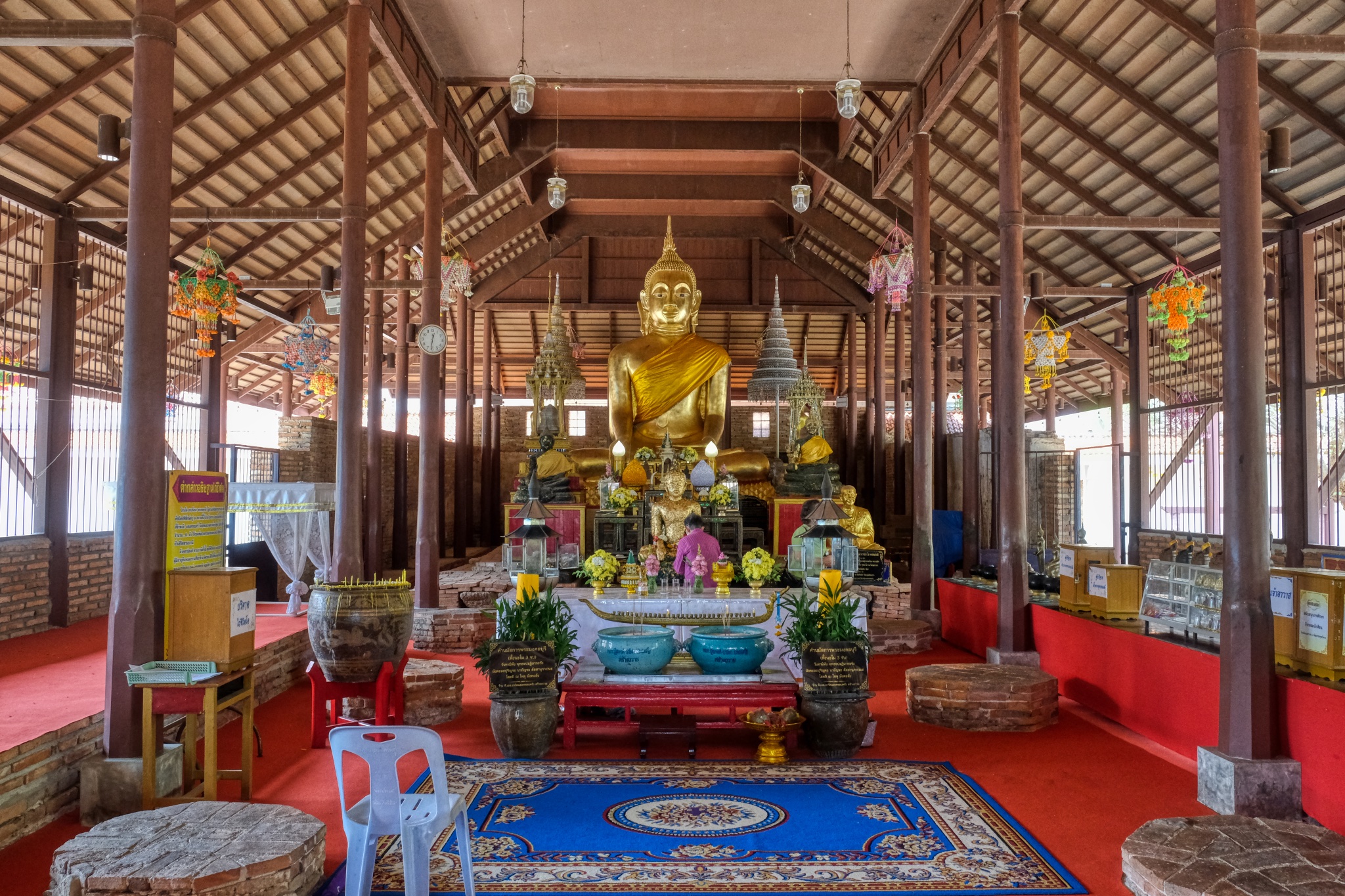 I took my shoes off and went in and discovered this remarkable spiritual space. If you look closely you can see the bases of the pillars that held up an earlier temple in the same location. "It is believed that this temple was built in the Dvaravati Period, around the 10th-11th Century, nearly the same time as when the old city of Ratchaburi was built. Later, a Khmer or Lop Buri sanctuary was built over the temple around the 13th Century to be the centre of the town according to the Khmer belief regarding the universe."
I took my shoes off and went in and discovered this remarkable spiritual space. If you look closely you can see the bases of the pillars that held up an earlier temple in the same location. "It is believed that this temple was built in the Dvaravati Period, around the 10th-11th Century, nearly the same time as when the old city of Ratchaburi was built. Later, a Khmer or Lop Buri sanctuary was built over the temple around the 13th Century to be the centre of the town according to the Khmer belief regarding the universe."
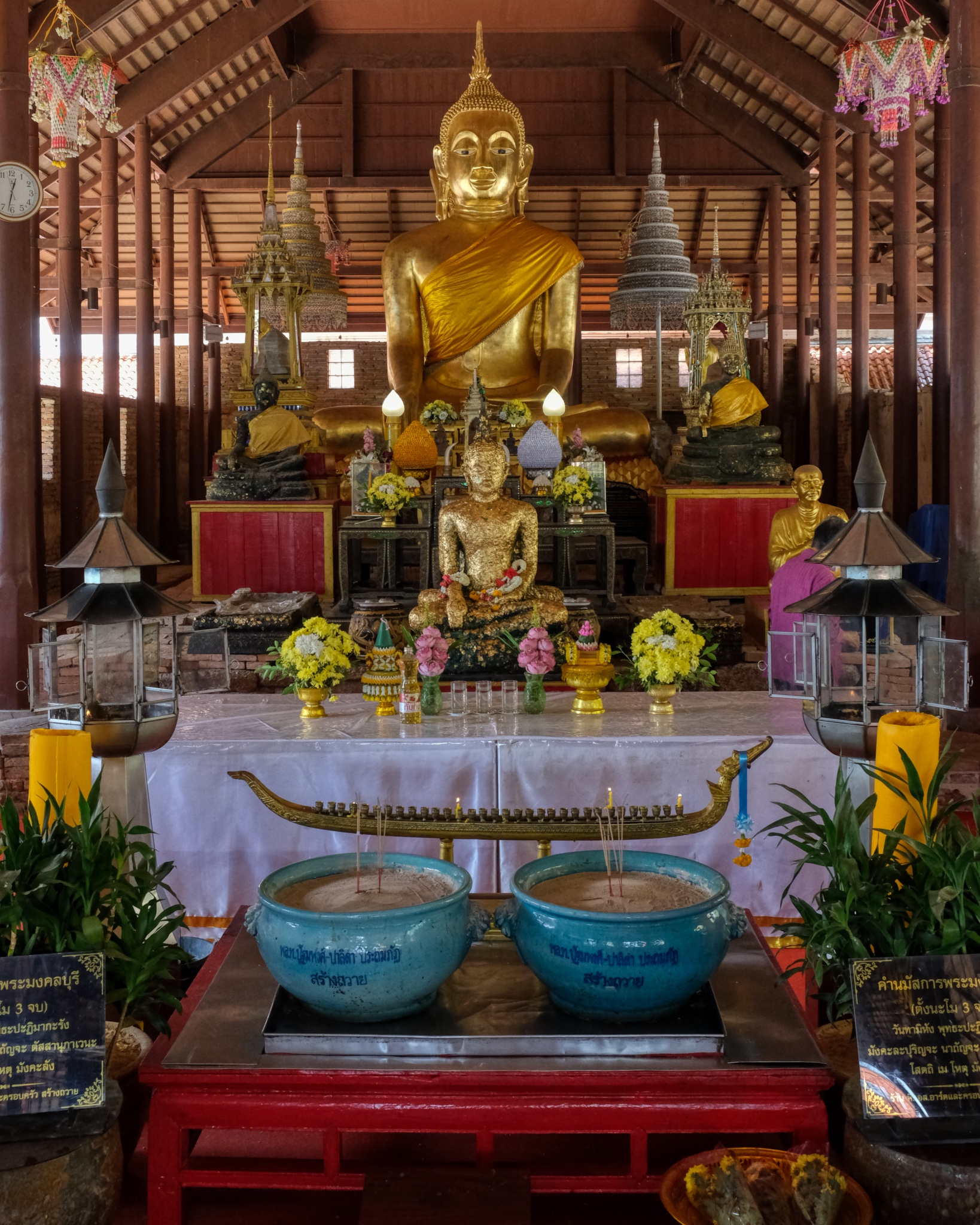 Exquisite Buddha images and a fine altar.
Exquisite Buddha images and a fine altar.
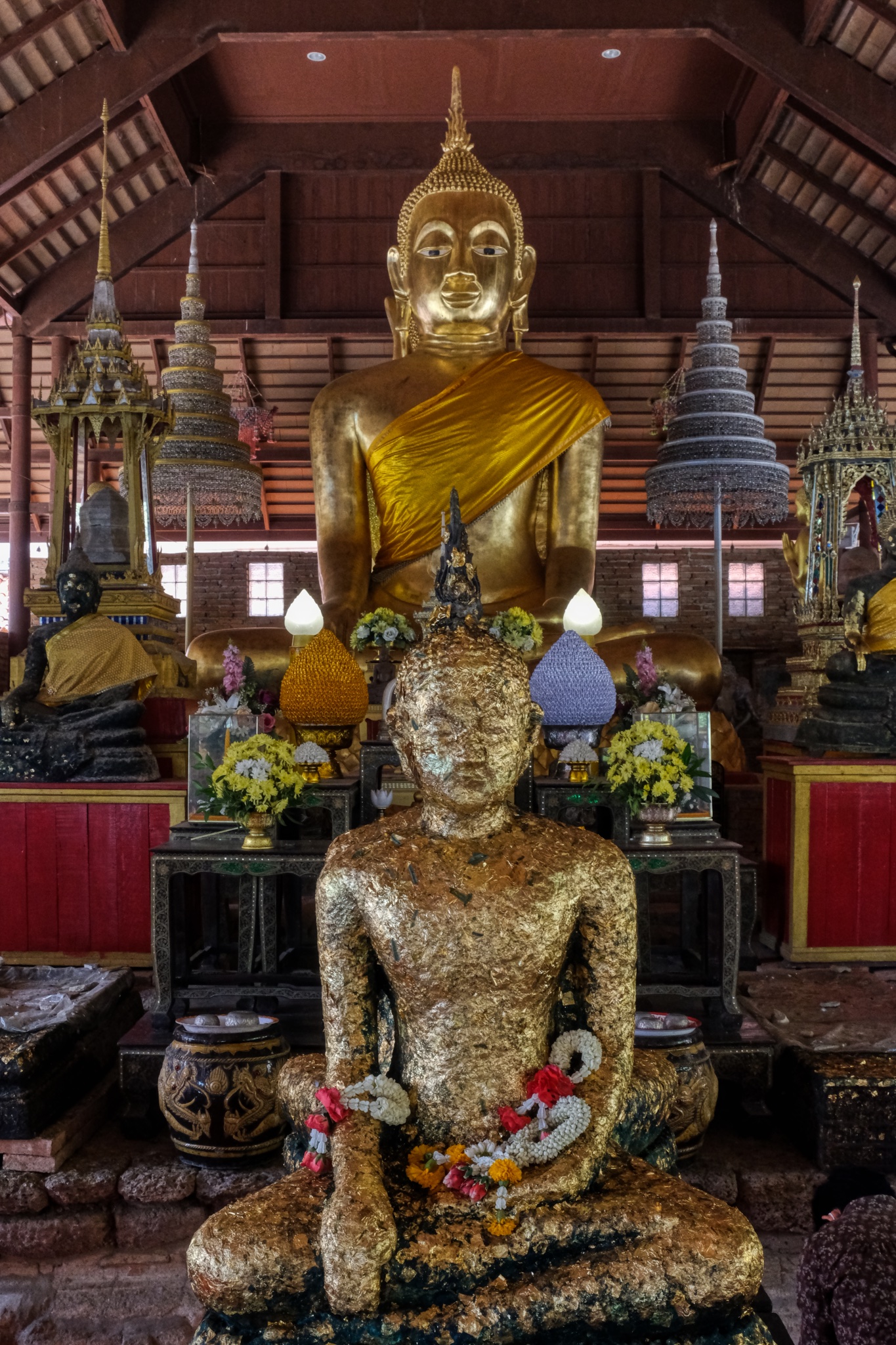 Buddha.
Buddha.
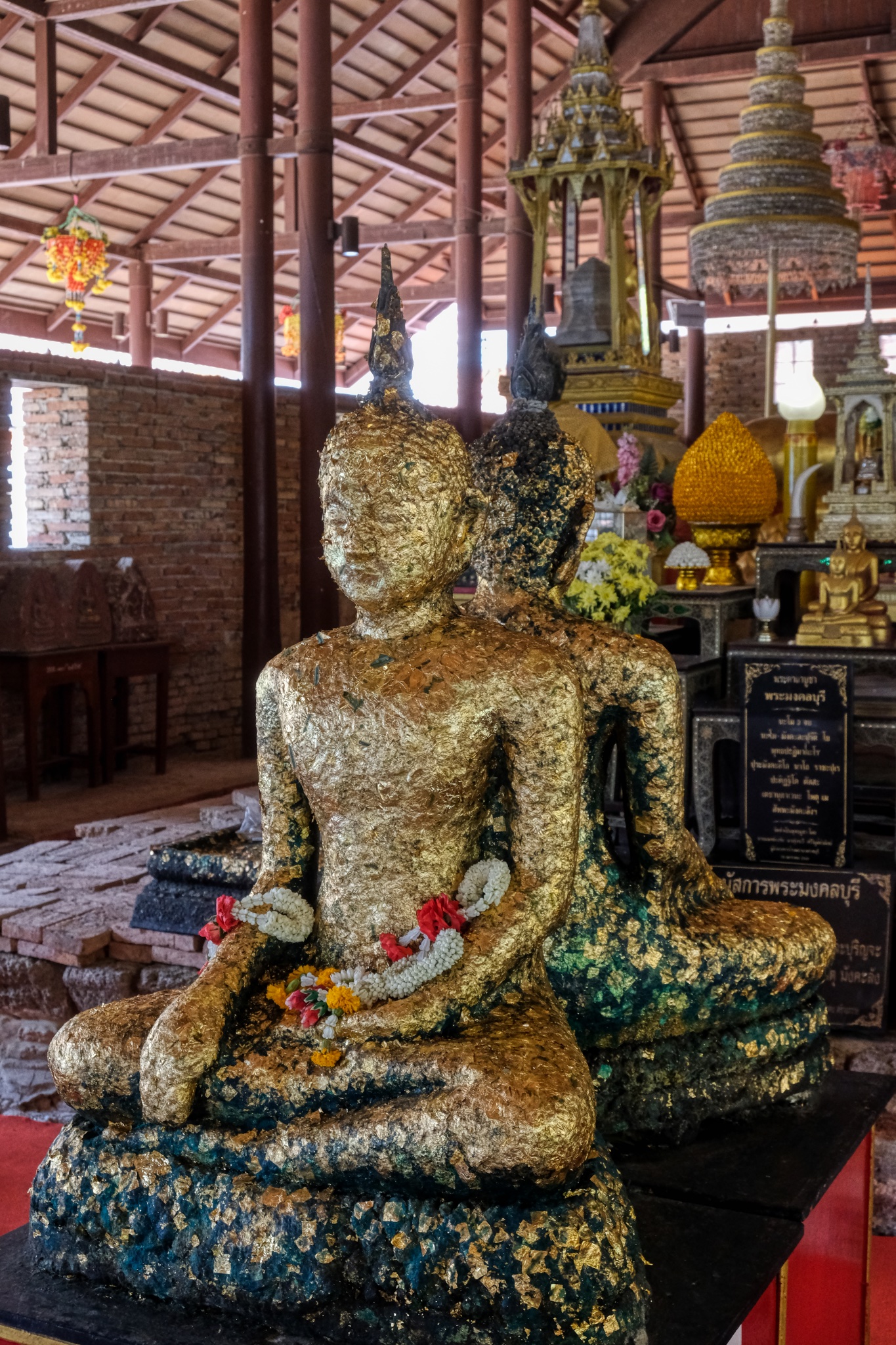 Devotees adorn Buddha images with gold leaf as a part of respectful practices. I was intrigued by these two Buddhas sitting back-to-back.
Devotees adorn Buddha images with gold leaf as a part of respectful practices. I was intrigued by these two Buddhas sitting back-to-back.
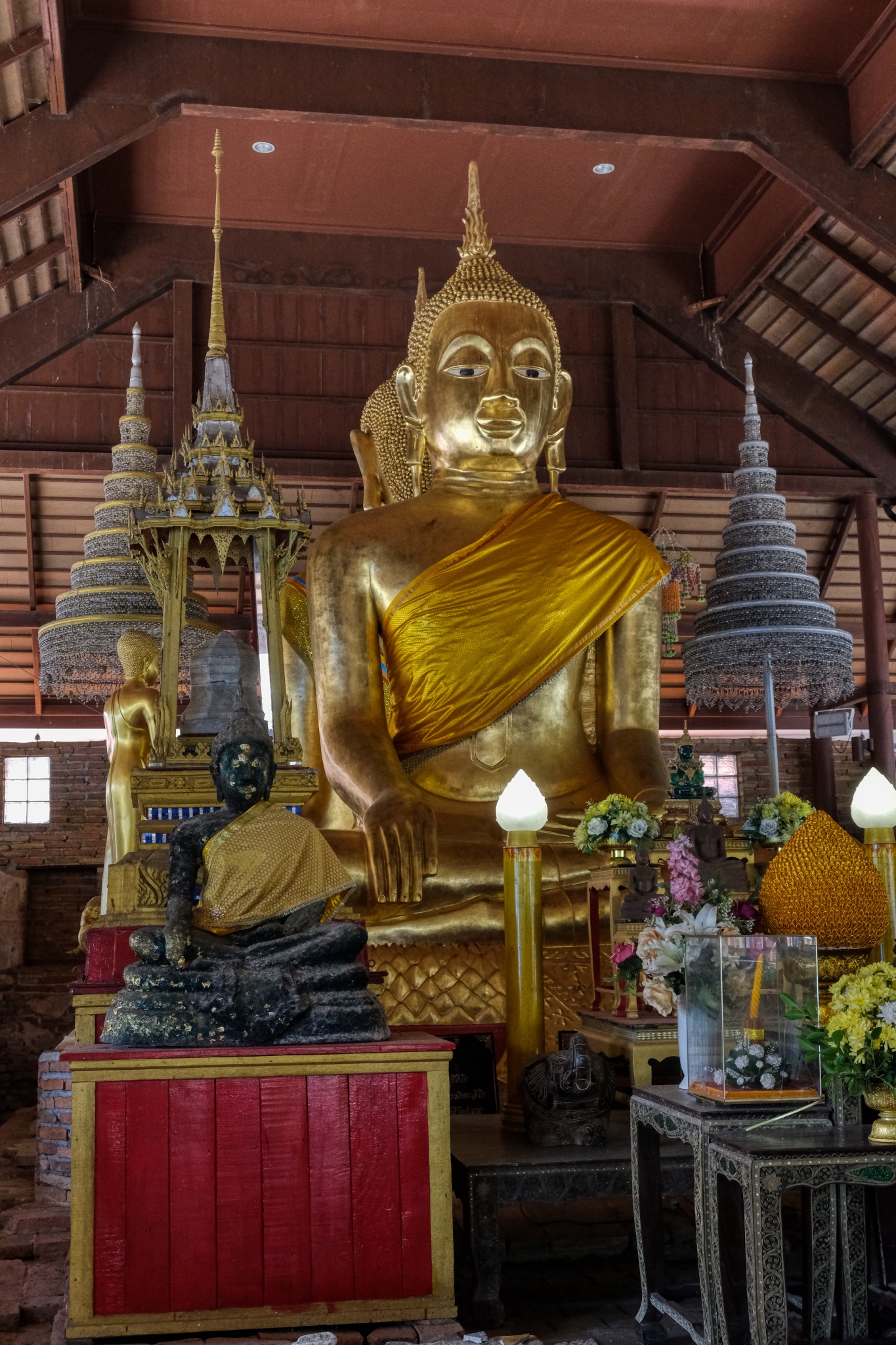 When I looked up at the main, large Buddha image I noticed that it was also a double Buddha. It is very unusual to see two Buddhas sitting back-to-back.
When I looked up at the main, large Buddha image I noticed that it was also a double Buddha. It is very unusual to see two Buddhas sitting back-to-back.
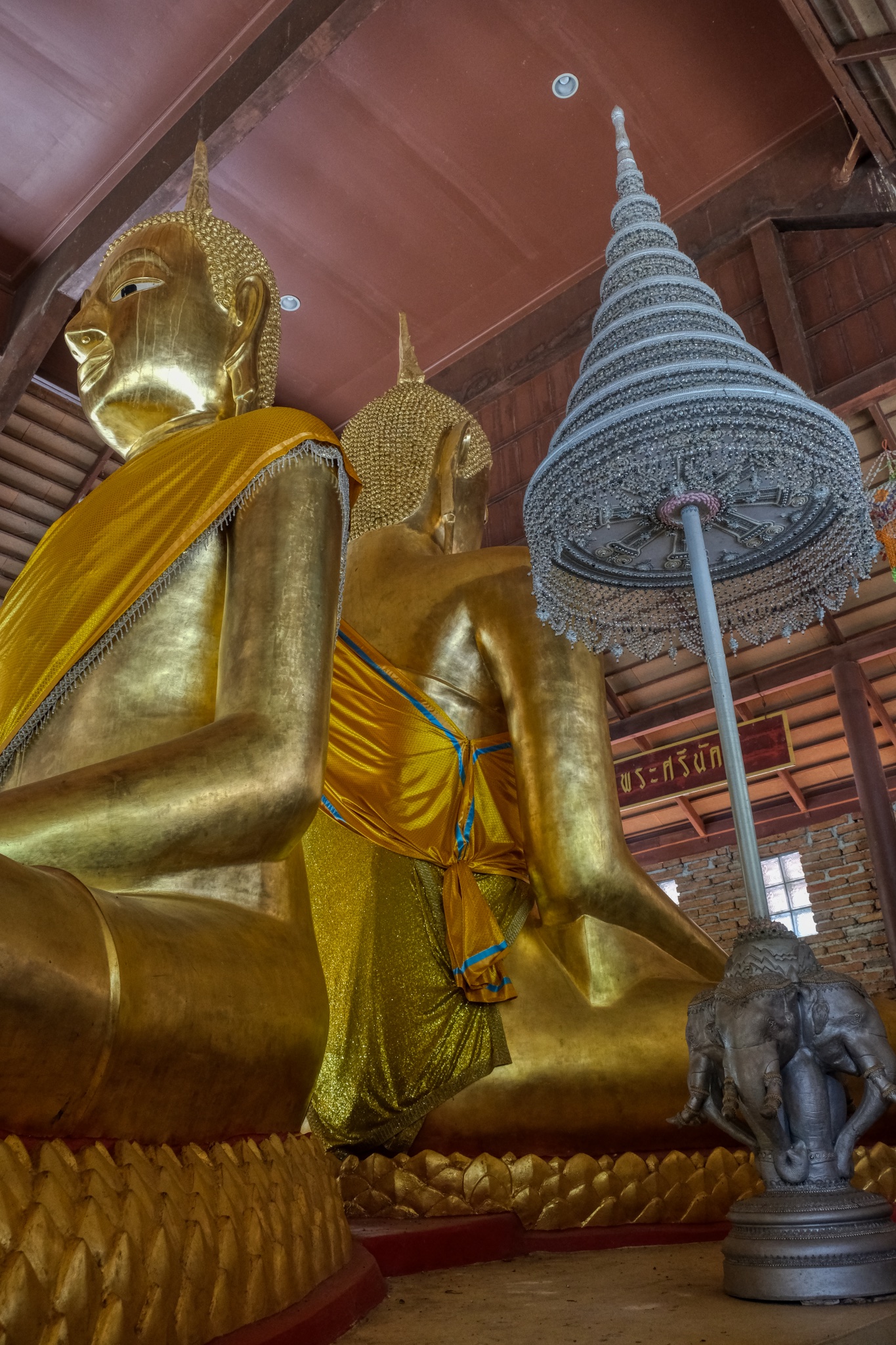 Normally only one Buddha sits in a Wat, and normally facing East.
Normally only one Buddha sits in a Wat, and normally facing East.
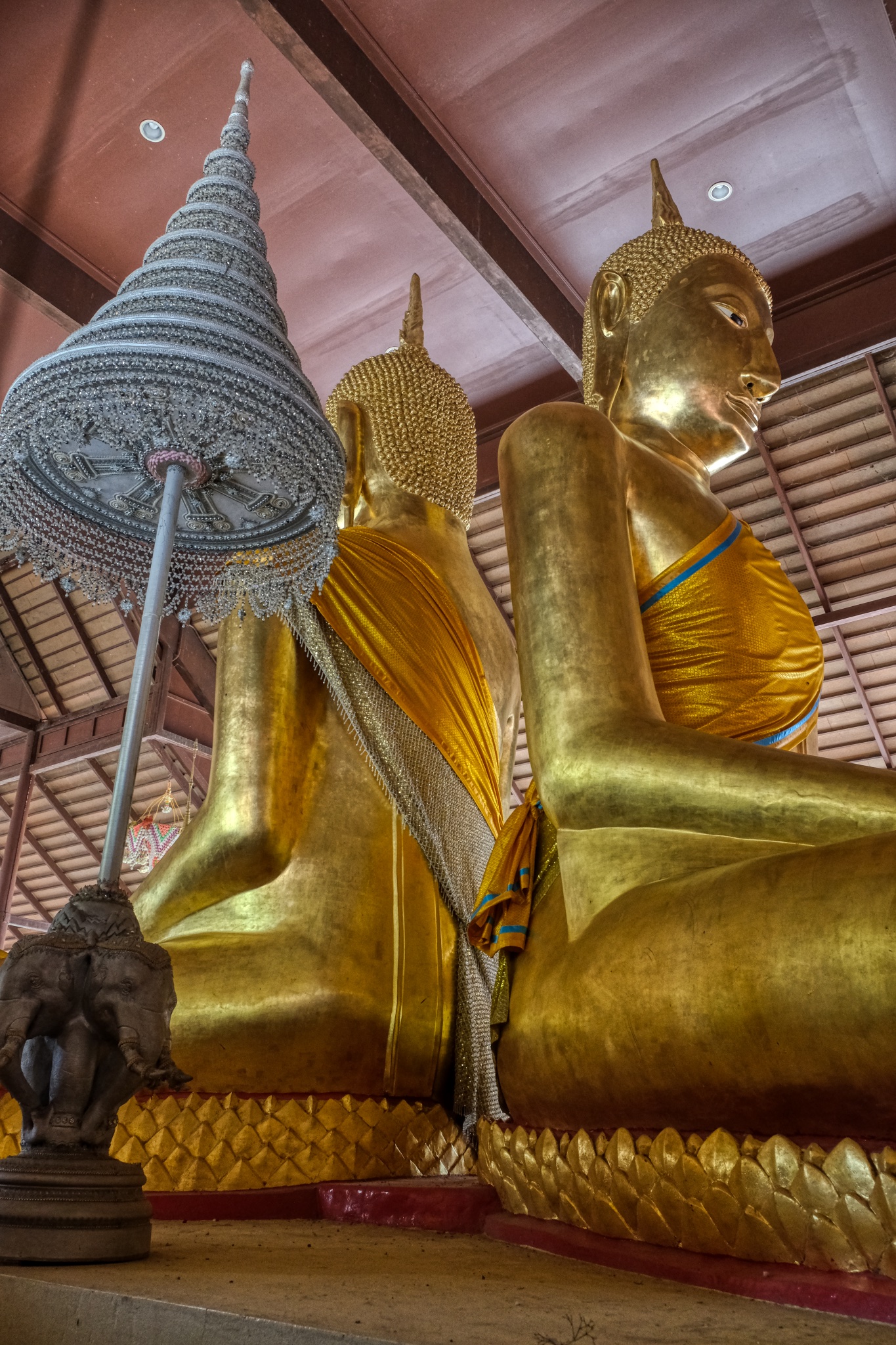 They were extraordinarily beautiful Buddhas. My research turned this up:"It is a stucco Buddha image in the gesture of subduing Mara, which has a lap width of 8 Sok 1 Khuep. Its characteristic is of the Pre-Ayutthaya art, with a Sukhothai style face. It has a long body but short knees. He turns his face to the east, and there is another Buddha image behind his back, turning its face to the opposite side or the west. This means we ask the Buddha’s blessing to prevent danger from the front as well as the back." (citation)
They were extraordinarily beautiful Buddhas. My research turned this up:"It is a stucco Buddha image in the gesture of subduing Mara, which has a lap width of 8 Sok 1 Khuep. Its characteristic is of the Pre-Ayutthaya art, with a Sukhothai style face. It has a long body but short knees. He turns his face to the east, and there is another Buddha image behind his back, turning its face to the opposite side or the west. This means we ask the Buddha’s blessing to prevent danger from the front as well as the back." (citation)
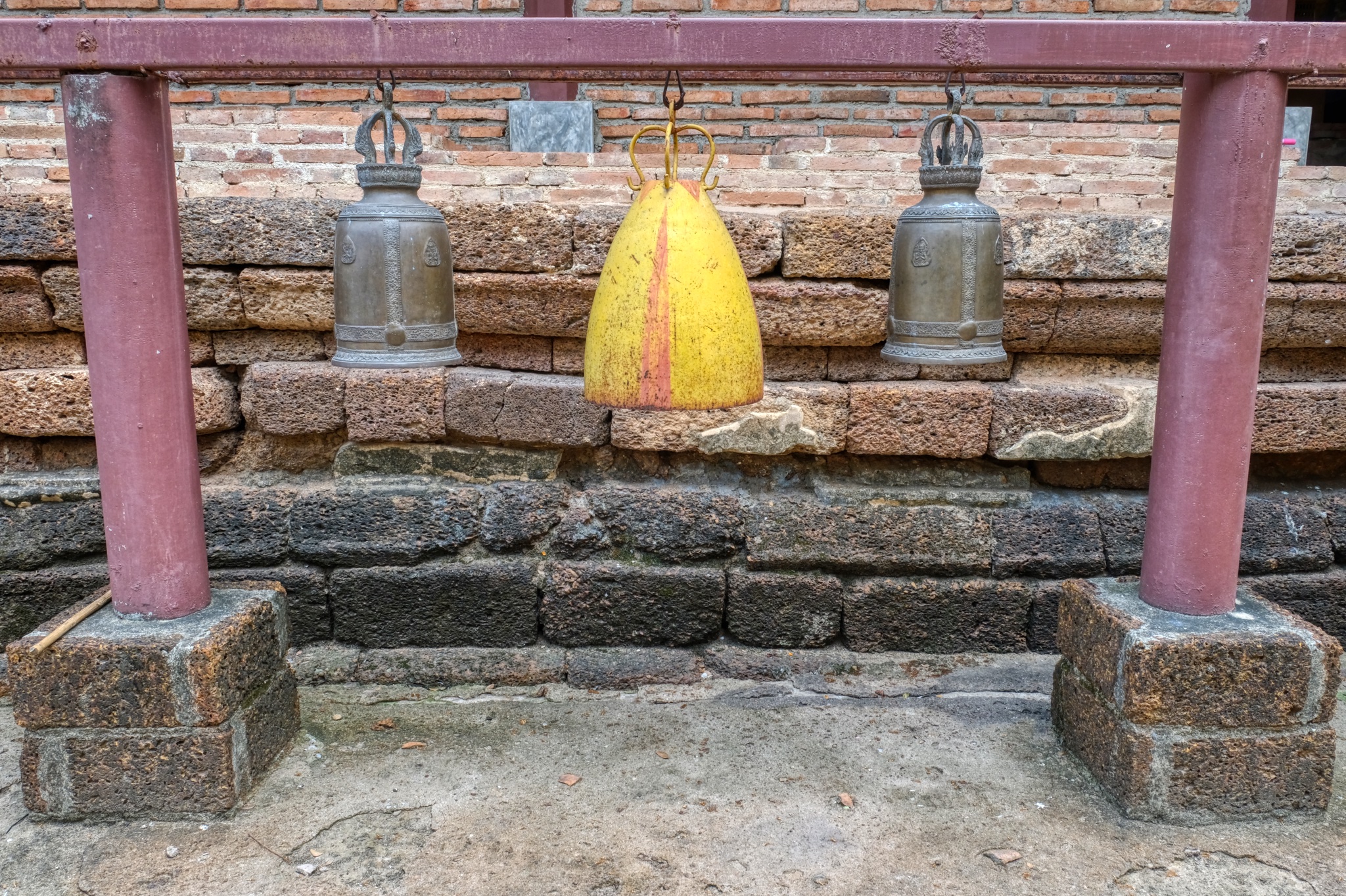 I left the Buddha hall to wander around the wat grounds.
I left the Buddha hall to wander around the wat grounds.
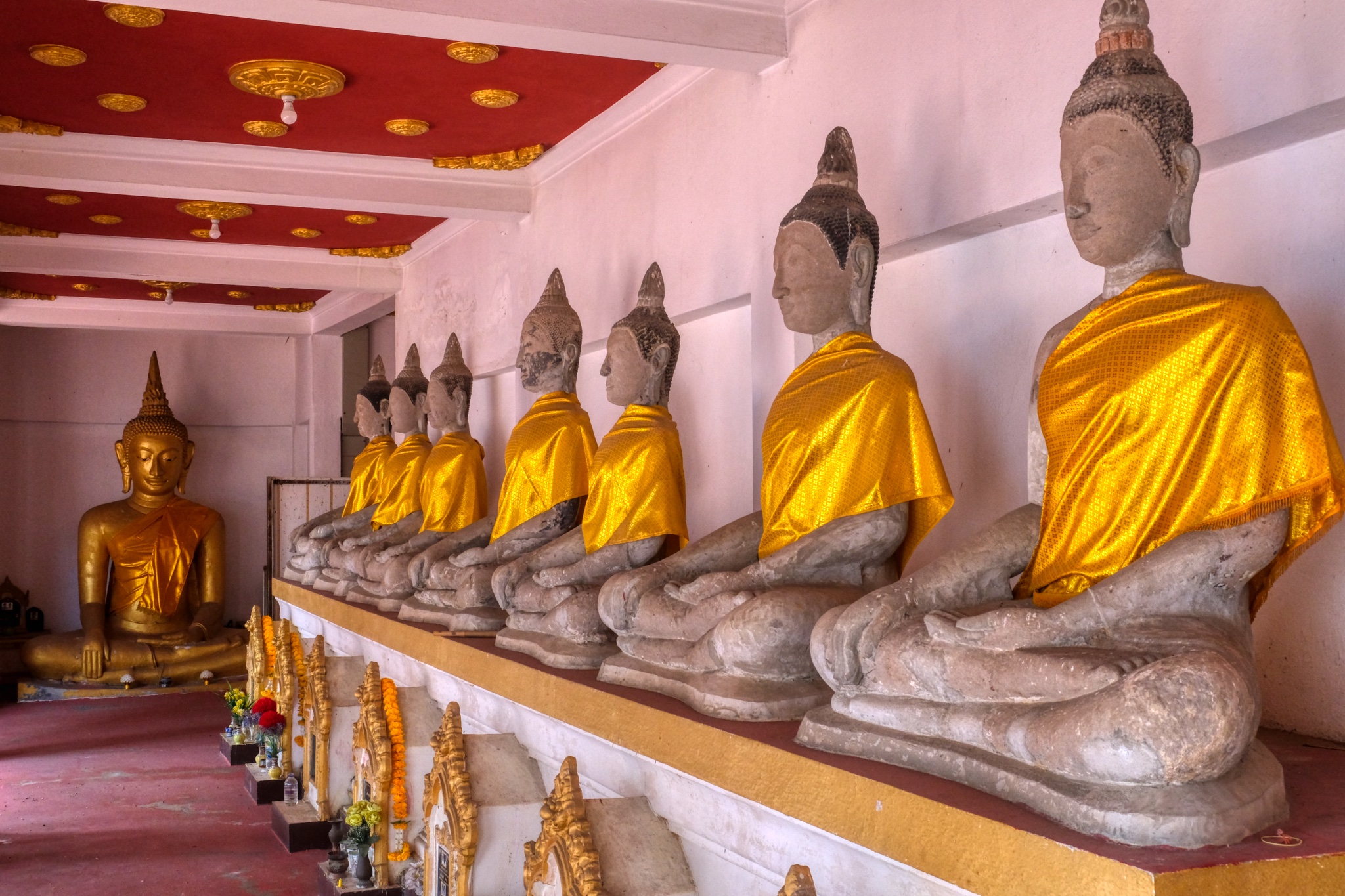 Like many Thai wats, there are covered halls lined with Buddha images, often as markers for the cremated remains of former monks and doners, as is the case here.
Like many Thai wats, there are covered halls lined with Buddha images, often as markers for the cremated remains of former monks and doners, as is the case here.
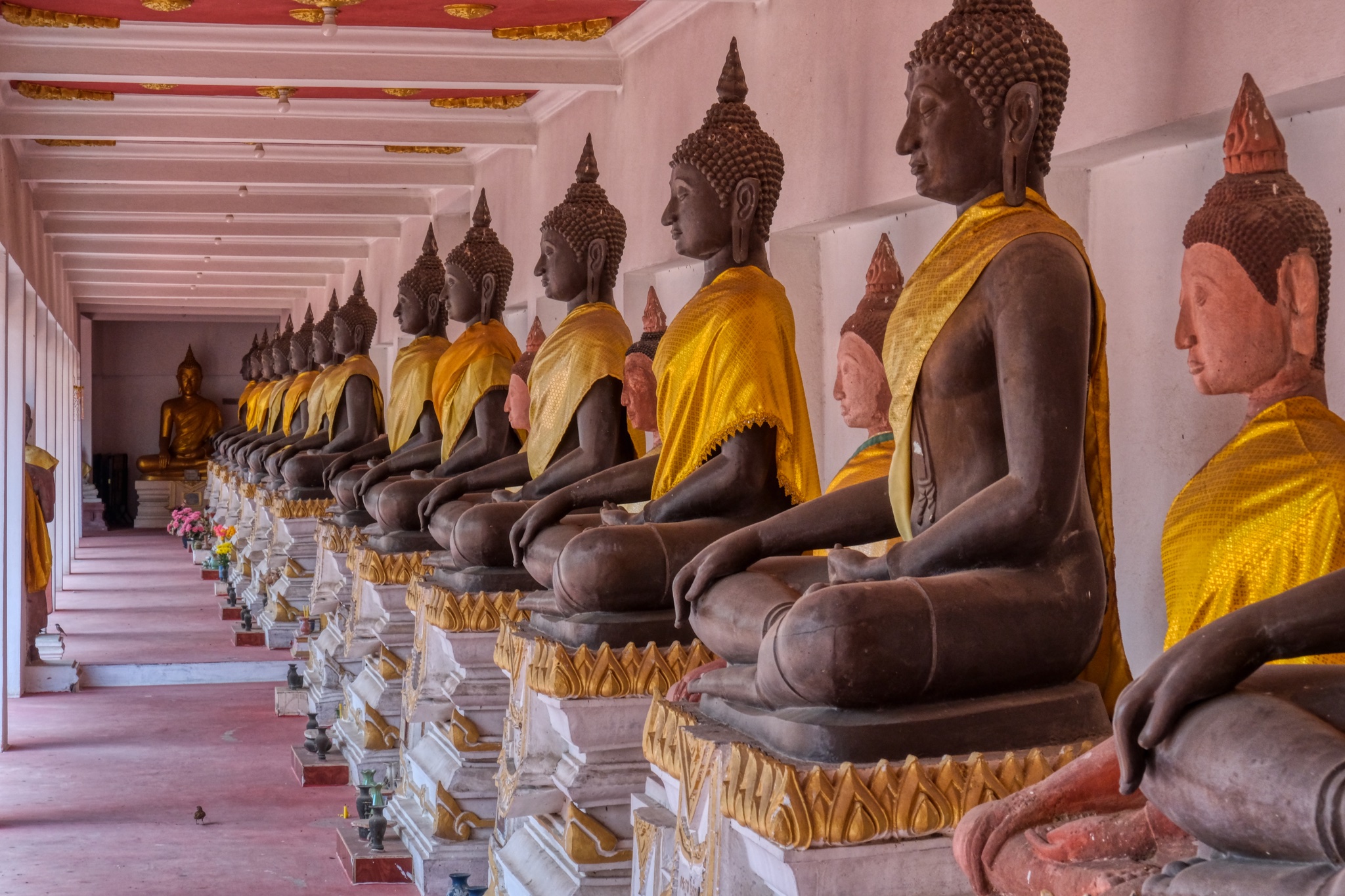 Such a beautiful sight.
Such a beautiful sight.
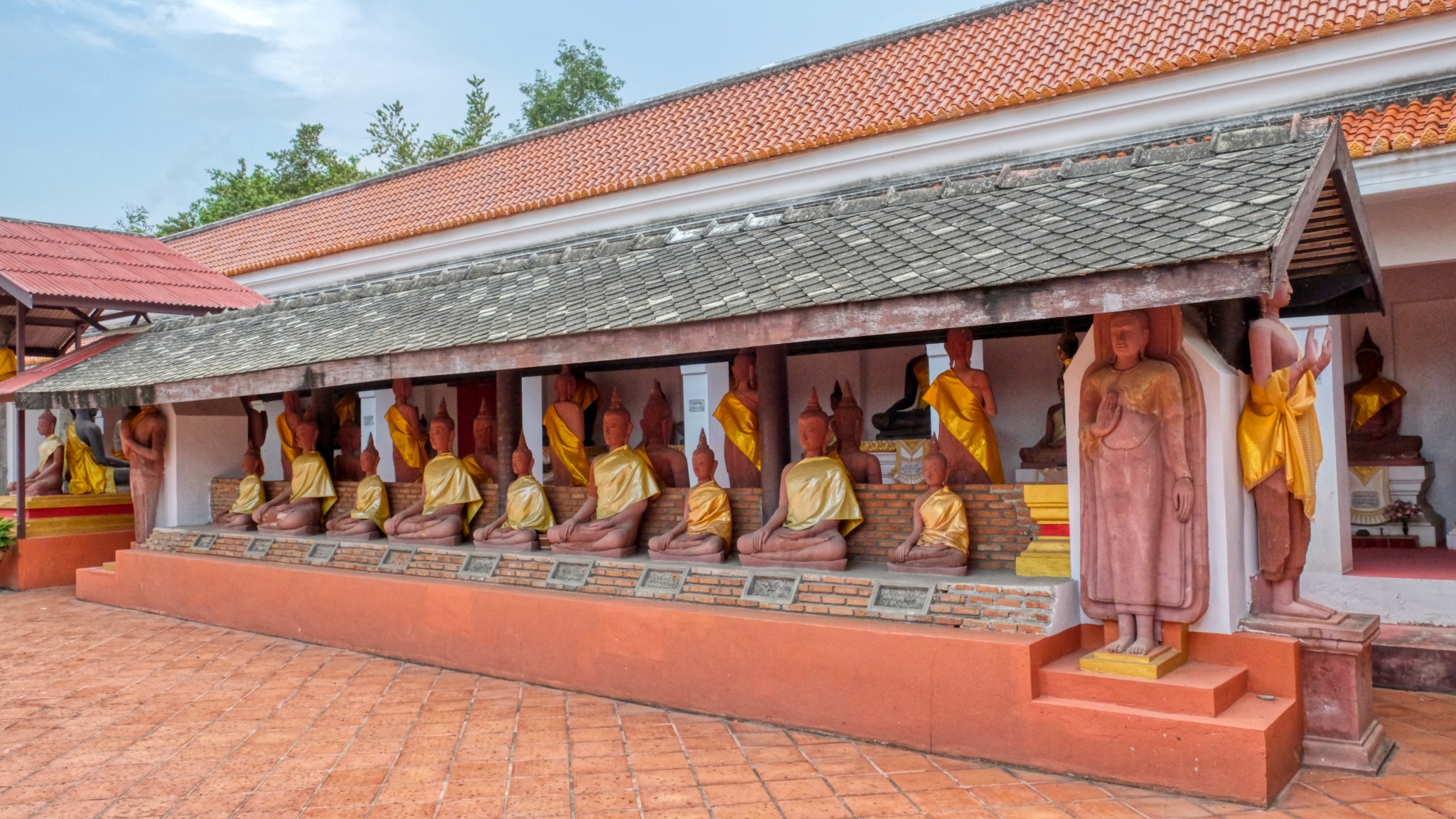 In fact, there are several rows of these grave marking Buddha statues.
In fact, there are several rows of these grave marking Buddha statues.
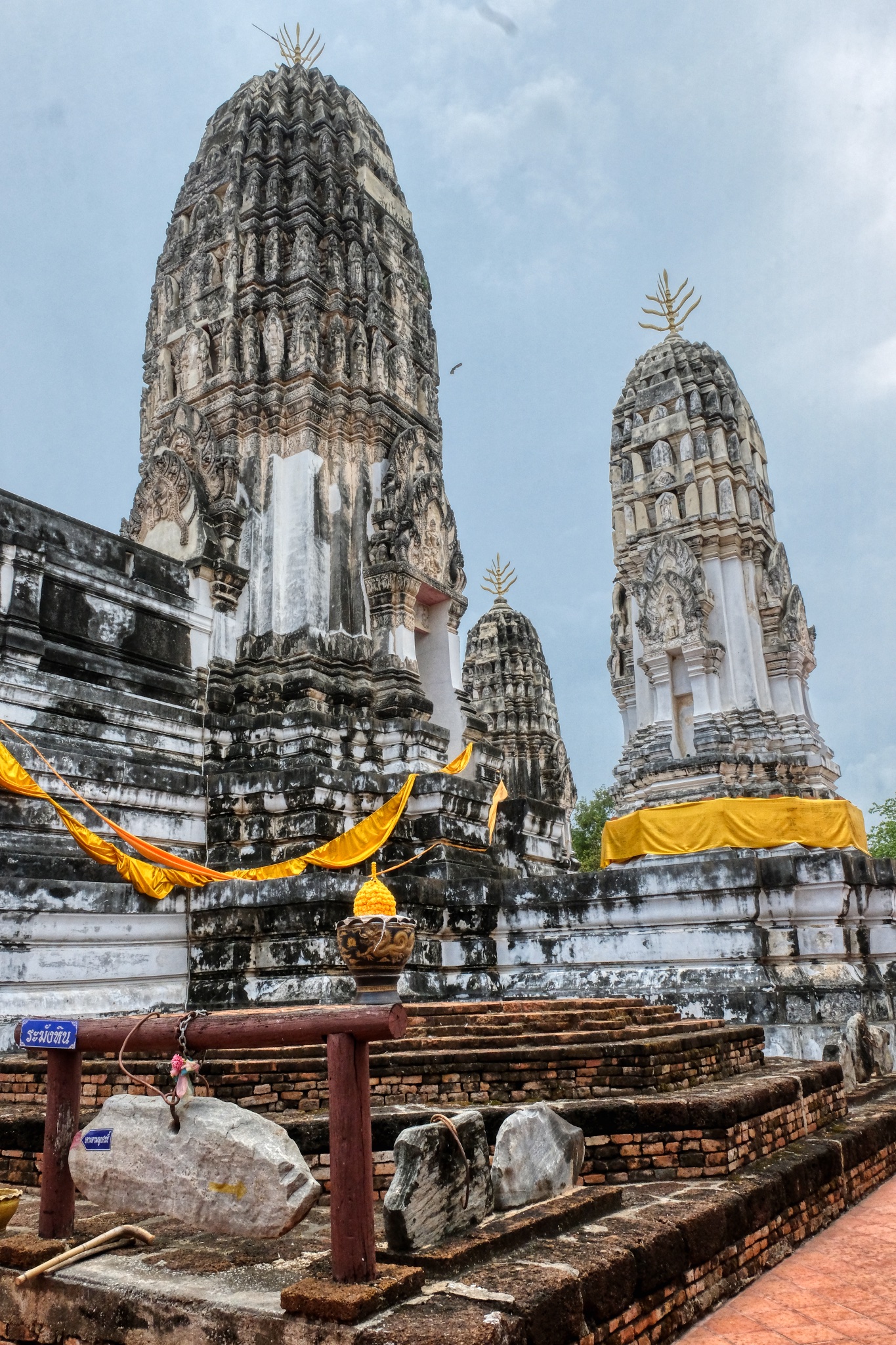 The Five Prangs. At the center of th Wat is a large courtyard enclosed by a cloister. At the center of the courtyard stand five massive parangs, known as "Phra Prang Ha Yod", or five peak prang. The Khmer/Lopburi style towers were constructed during the Sukhothai era.
The Five Prangs. At the center of th Wat is a large courtyard enclosed by a cloister. At the center of the courtyard stand five massive parangs, known as "Phra Prang Ha Yod", or five peak prang. The Khmer/Lopburi style towers were constructed during the Sukhothai era.
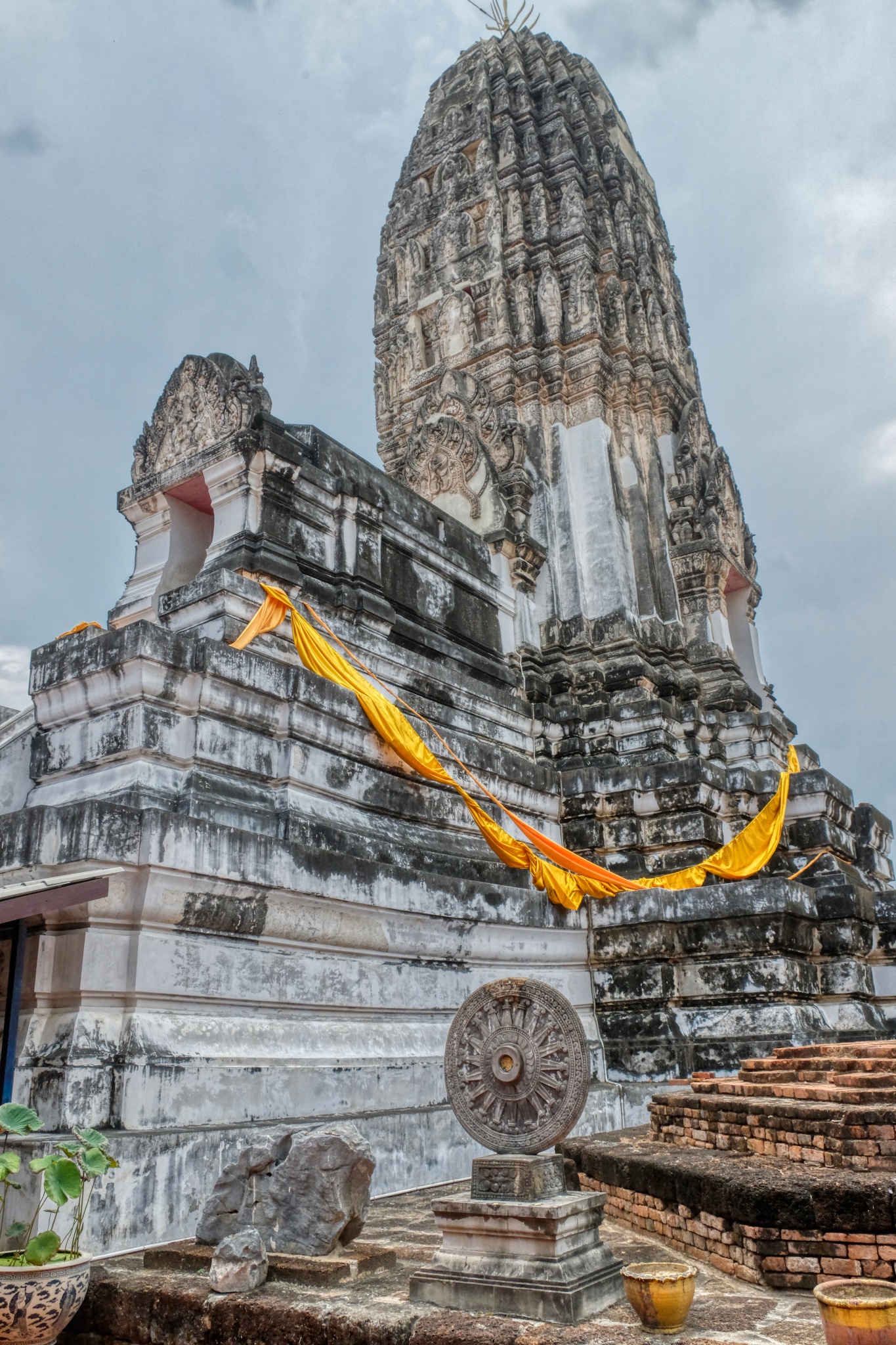
"Surrounded by four smaller ones, the tallest central prang rising over forty meters enshrines Buddha relics. Enshrined in large niches on all of its four faces are standing golden images of the Buddha. The brick plastered prangs, decorated with fine stucco work are topped with a trishula, a three pointed spear, the weapon of the Hindu God Shiva. Sheltering them is a small multi tiered ceremonial umbrella" (citation)
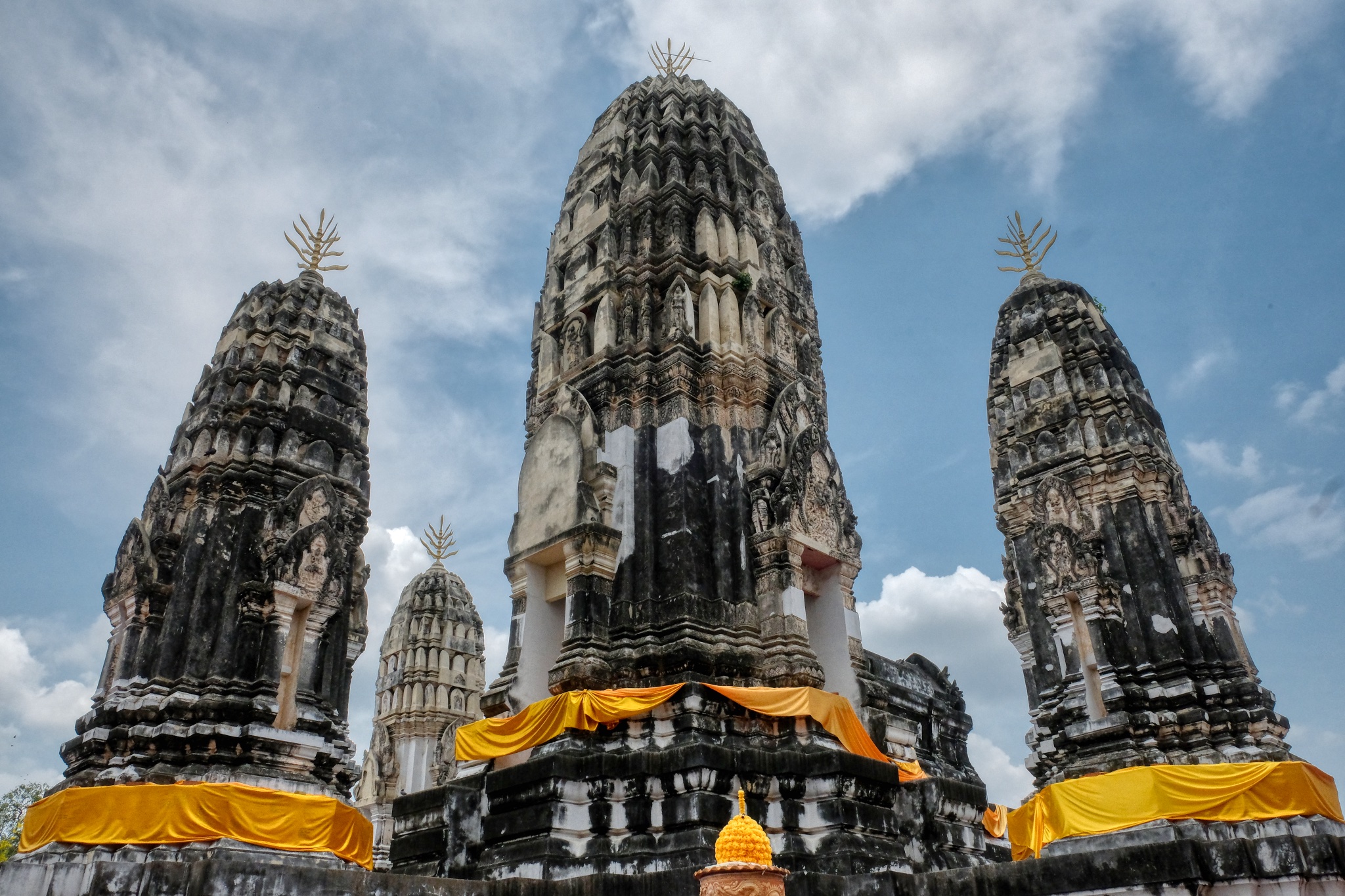 Extraordinary.
Extraordinary.
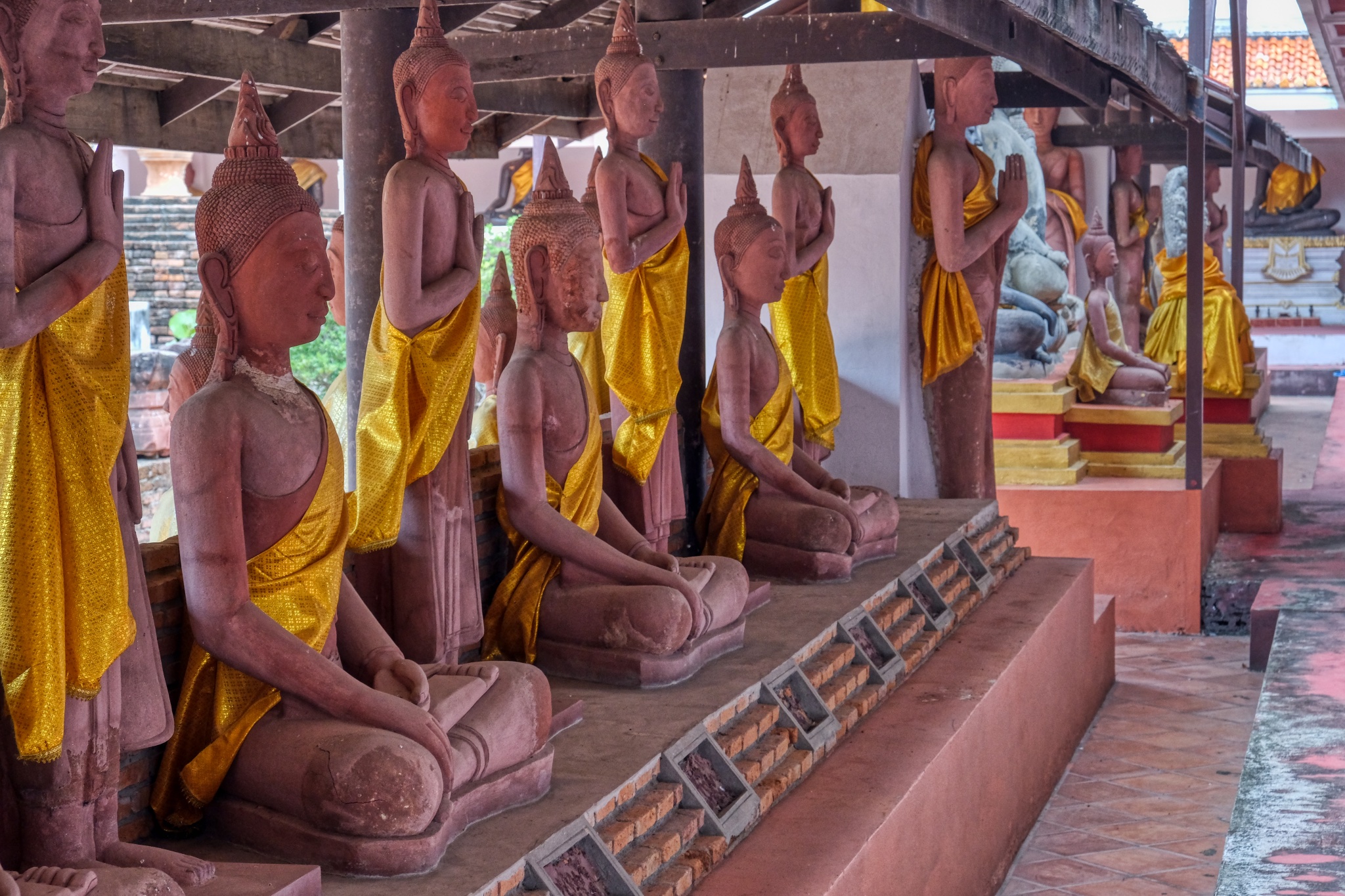 Ah! A phone message from my wife: she is on the 16th hole. Time for me to leave this amazing place. I headed back out along the Buddha colonnades.
Ah! A phone message from my wife: she is on the 16th hole. Time for me to leave this amazing place. I headed back out along the Buddha colonnades.
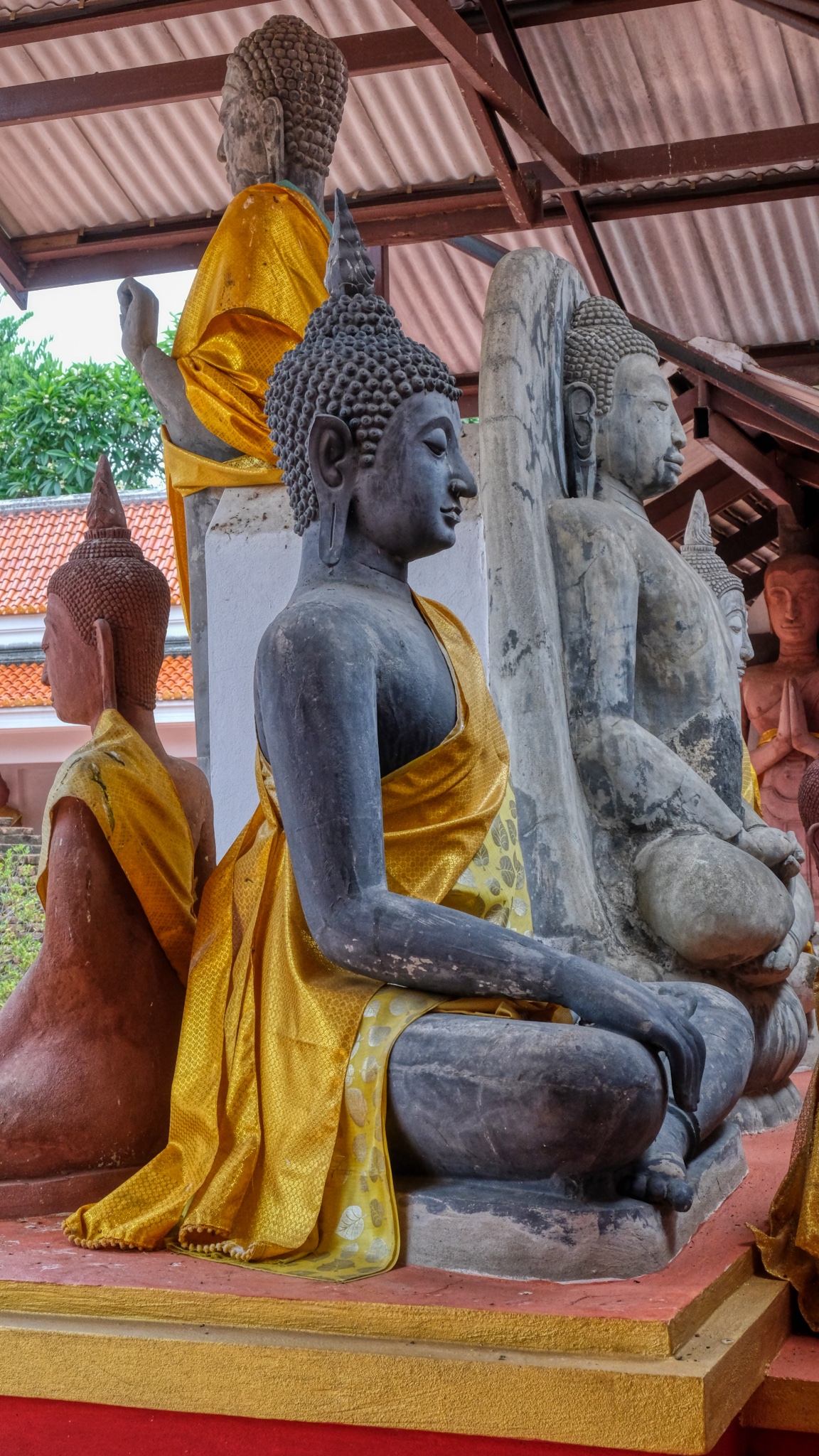 A wide variety of Buddha images present.
A wide variety of Buddha images present.
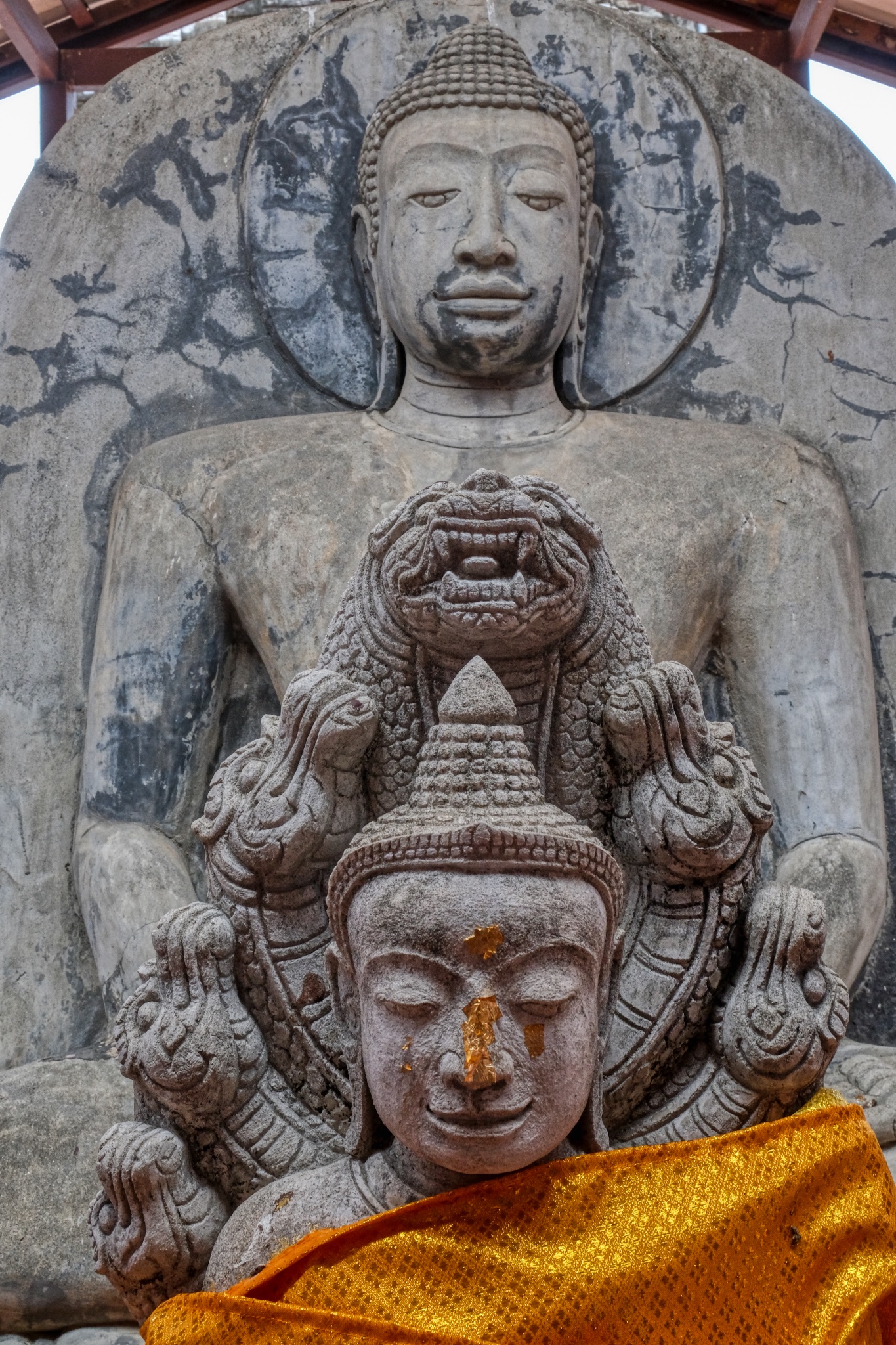 A fine reminder about my mortality and a questioning about what I am doing with my conscieness.
A fine reminder about my mortality and a questioning about what I am doing with my conscieness.
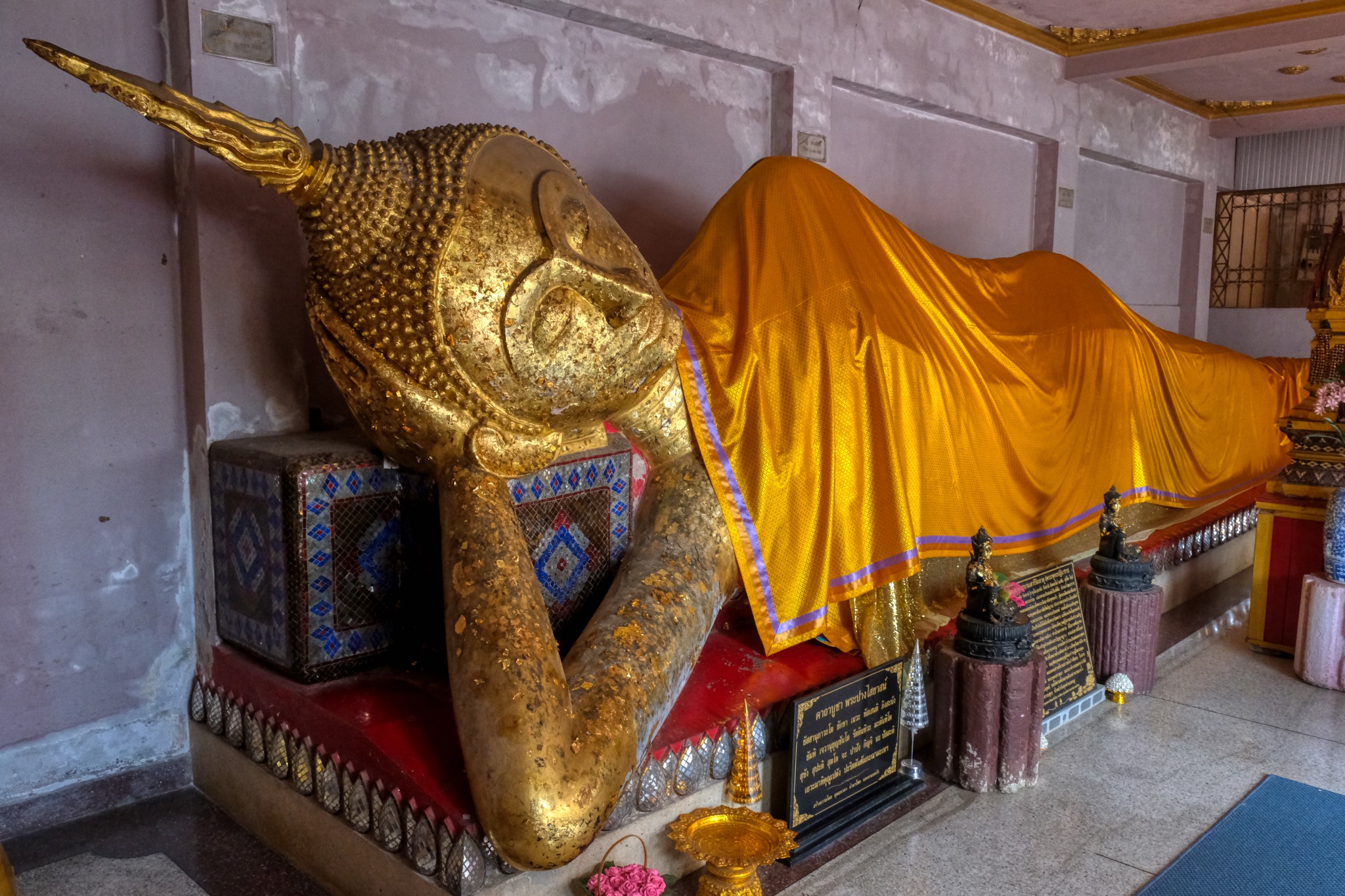 One last grotto . . . to visit a reclining Buddha.
One last grotto . . . to visit a reclining Buddha.
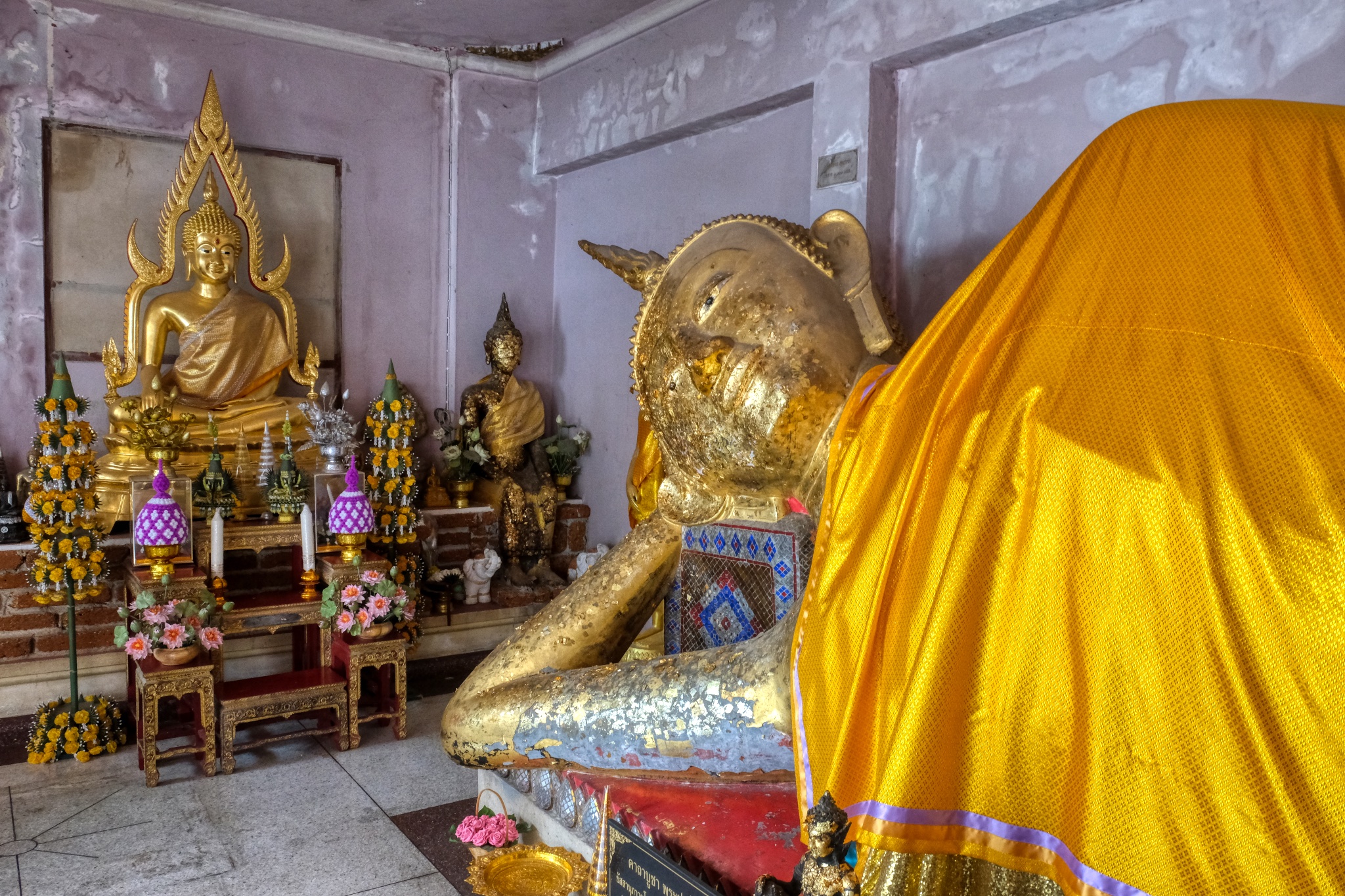 Such a beautiful display. An old 'nun' altar keeper offered me a bottle of water here, which I took. It was a hot day!
Such a beautiful display. An old 'nun' altar keeper offered me a bottle of water here, which I took. It was a hot day!
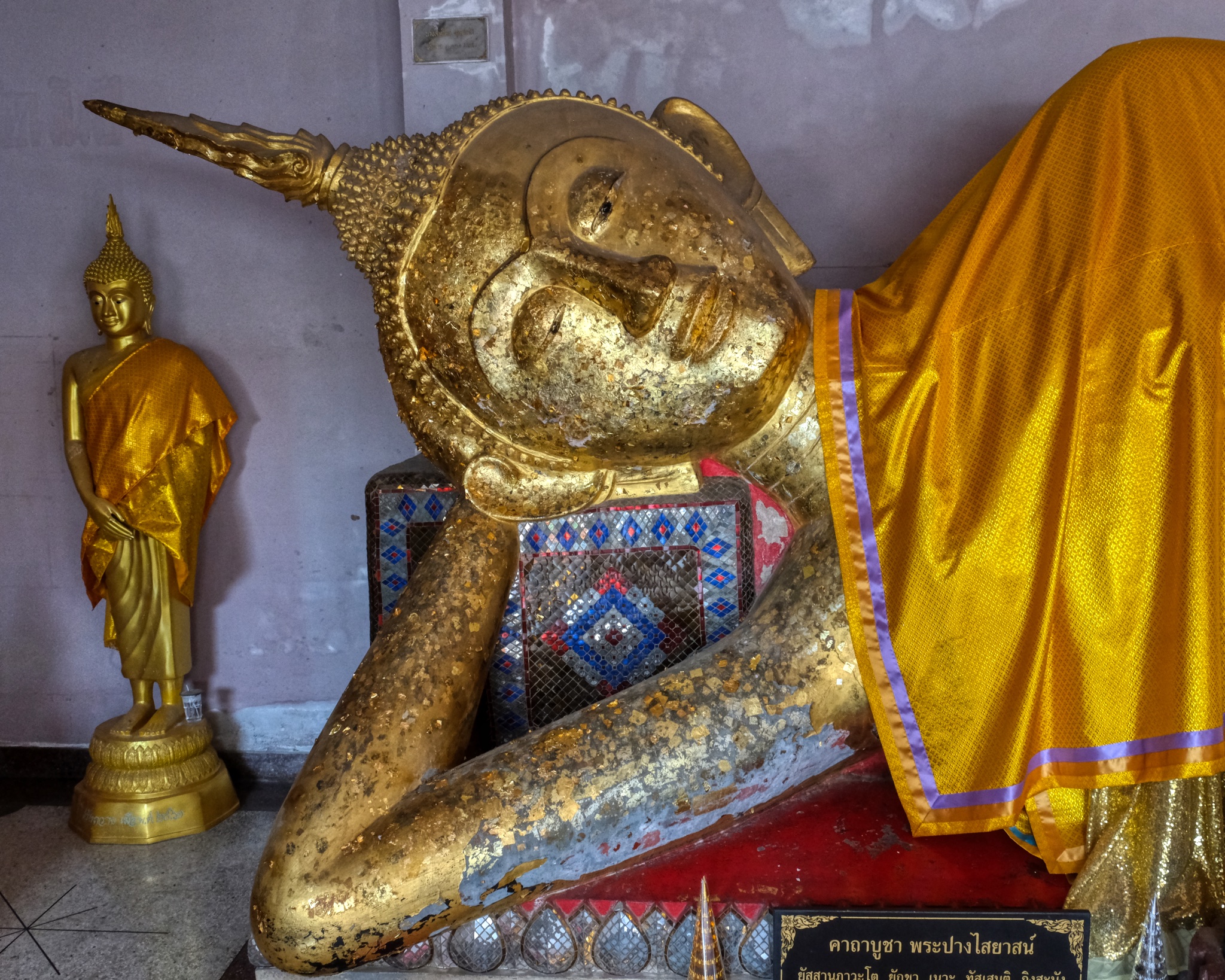 I lingered in this space to pay my respect to the Buddha. I also left my donation here.
I lingered in this space to pay my respect to the Buddha. I also left my donation here.
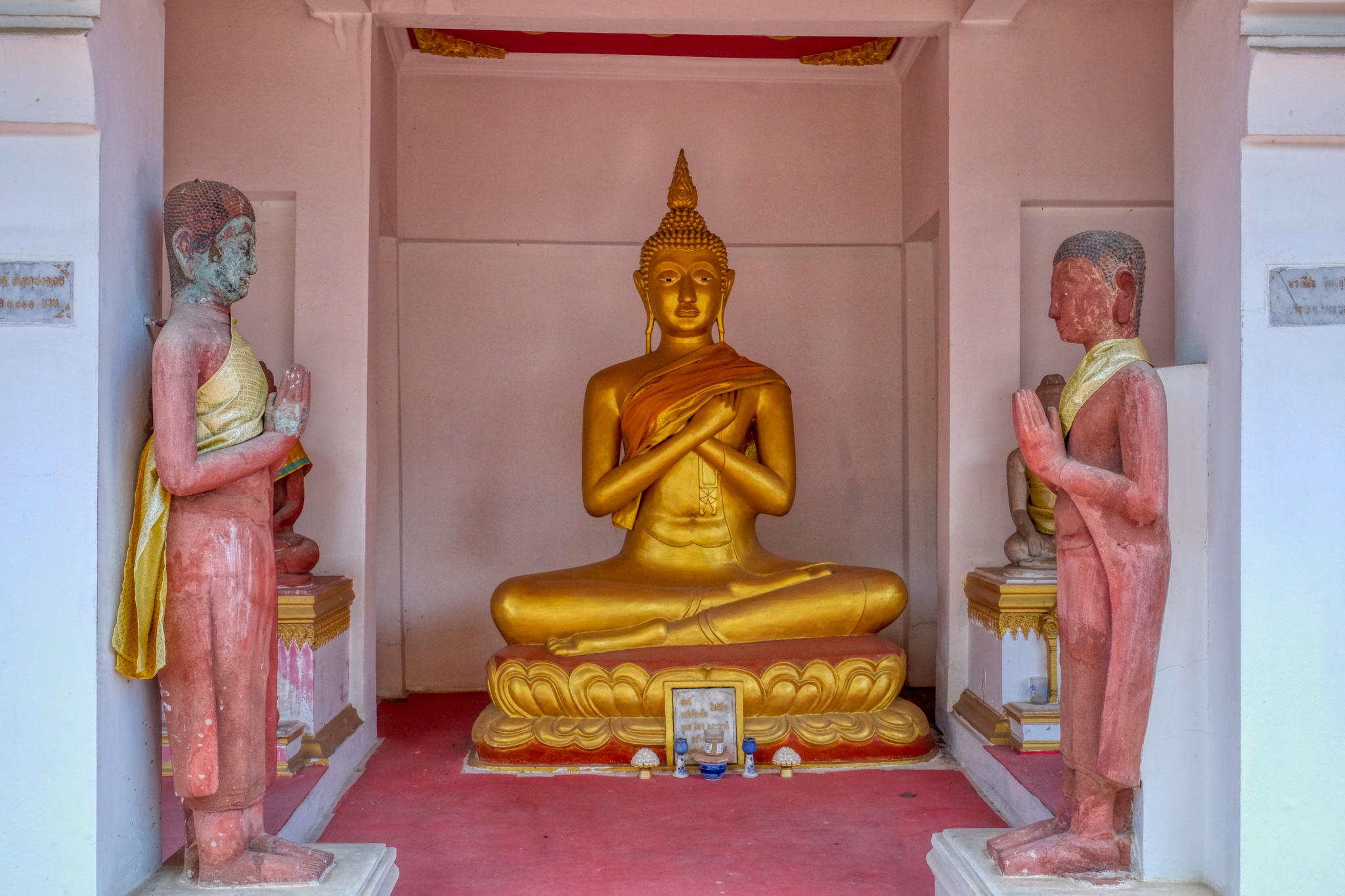 My last stop. Then the 25 minute drive to pick up my wife at the golf course and the 1 hour 45 minute drive back to Hua Hin. A wonderful day . . . .
My last stop. Then the 25 minute drive to pick up my wife at the golf course and the 1 hour 45 minute drive back to Hua Hin. A wonderful day . . . .
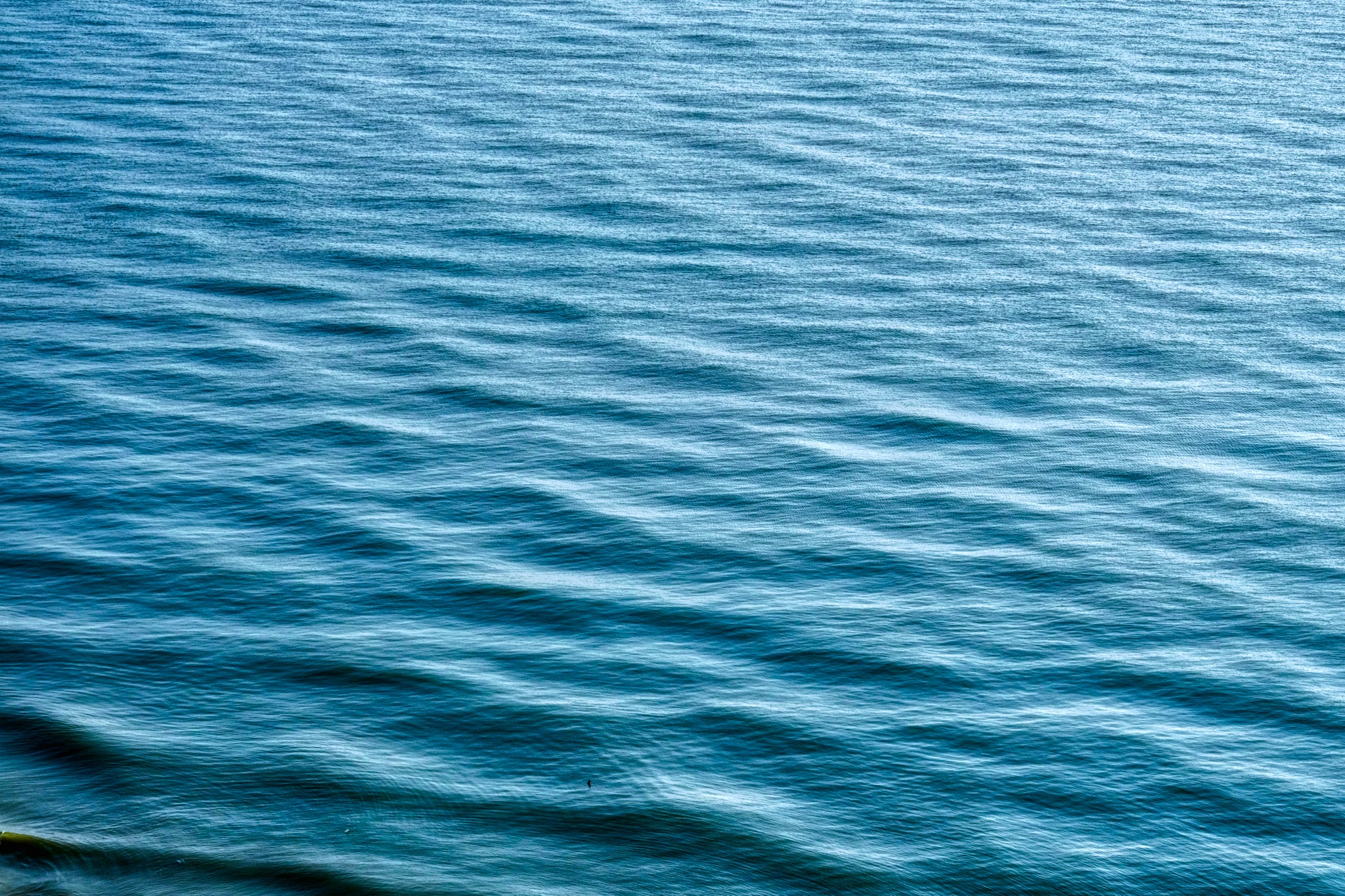 Back on the balcony for a gin & tonic and this strange blue sea . . .
Back on the balcony for a gin & tonic and this strange blue sea . . .
A Petchaburi, Thailand 'Photo Ramble'
 Wednesday, March 17, 2021 at 4:03PM
Wednesday, March 17, 2021 at 4:03PM A 'photo ramble' blog entry in four parts: The Old Town of Petchaburi, The Buddhist Temples (Wats) of Petchaburi Town, Two Old Fishing Ports in Petchaburi Province, and Salt Pan Workers in Petchaburi Province.
PART 1: THE OLD TOWN
 Petchaburi is a provincial capital located between Bangkok and the beach towns of Cha Am and Hua Hin. It is a very small city that I pass by whenever I go to Hua Hin for a beach getaway from the pace of urban Bangkok . . . but I never stop to see what is there . . . until my old friend, John Stiles, and I decided to take a "photo ramble" there last week. [The 11th century Wat Mahathat Worawihan in the background.]
Petchaburi is a provincial capital located between Bangkok and the beach towns of Cha Am and Hua Hin. It is a very small city that I pass by whenever I go to Hua Hin for a beach getaway from the pace of urban Bangkok . . . but I never stop to see what is there . . . until my old friend, John Stiles, and I decided to take a "photo ramble" there last week. [The 11th century Wat Mahathat Worawihan in the background.]
 Petchaburi is only two hours away on good divided highway from home . . . and seemingly in a different decade.
Petchaburi is only two hours away on good divided highway from home . . . and seemingly in a different decade.
 We arrived and parked, as we planned to spend the day on foot. At first look, Petchaburi looks like a lot of old Thai market towns. An old, somewhat worn out downtown area with lots of 'street life' - civic culture. In Thai, Phetchaburi means "city of diamonds".
We arrived and parked, as we planned to spend the day on foot. At first look, Petchaburi looks like a lot of old Thai market towns. An old, somewhat worn out downtown area with lots of 'street life' - civic culture. In Thai, Phetchaburi means "city of diamonds".
 There are some interesting old buildings with a lot of character . . .
There are some interesting old buildings with a lot of character . . .
 . . . and ample material for one of my favorite photographic subjects: old door portraits.
. . . and ample material for one of my favorite photographic subjects: old door portraits.
 A magnificent old door with its life story written all over it.
A magnificent old door with its life story written all over it.
 Old Thai market towns have a special dilapidated charm I really enjoy.
Old Thai market towns have a special dilapidated charm I really enjoy.
 A corner coffee shop. We stopped here for iced coffee with milk. Very good.
A corner coffee shop. We stopped here for iced coffee with milk. Very good.
 The Petchaburi clothing shops spill right out onto the sidewalks.
The Petchaburi clothing shops spill right out onto the sidewalks.
 Buddhist votive offerings shops near the main city center Wat (temple).
Buddhist votive offerings shops near the main city center Wat (temple).
 These old wooden shop houses are slowly disappearing in Thailand's larger towns and cities.
These old wooden shop houses are slowly disappearing in Thailand's larger towns and cities.
 Our casual stroll brought us into an area of old alleys and a wet market.
Our casual stroll brought us into an area of old alleys and a wet market.
 We were literally stopped in our tracks when we rounded a corner into this narrow alley . . . and found a street full of art. Fantastic!
We were literally stopped in our tracks when we rounded a corner into this narrow alley . . . and found a street full of art. Fantastic!
 This was such a whimsical painting, made more so by the actual, real door knob that had been mounted in the wall!
This was such a whimsical painting, made more so by the actual, real door knob that had been mounted in the wall!
 The wall art was wonderfully integrated into the structures of the alley.
The wall art was wonderfully integrated into the structures of the alley.
 Dragon art . . .
Dragon art . . .
 A drayman starting his rounds in front of a fish mural. Wonderful!
A drayman starting his rounds in front of a fish mural. Wonderful!
 There was a 'missing building' in the art alley . . . no problem: paint the revered former King of Thailand on the exposed end . . .
There was a 'missing building' in the art alley . . . no problem: paint the revered former King of Thailand on the exposed end . . .
 There seemed to be a "pet" theme across much of the alley art work.
There seemed to be a "pet" theme across much of the alley art work.
 Scrumptious and stylish . . .
Scrumptious and stylish . . .
 A wall of sweet kitties.
A wall of sweet kitties.
 None of this Petchaburi alley art was signed, but we guessed that these two lovely people were the artists.
None of this Petchaburi alley art was signed, but we guessed that these two lovely people were the artists.
 Refreshed with Art, we walked on through the alleys of old Petchaburi town.
Refreshed with Art, we walked on through the alleys of old Petchaburi town.
 There were many very old shops in Peetchaburi . . . from a time before big box franchises and bar code stock control.
There were many very old shops in Peetchaburi . . . from a time before big box franchises and bar code stock control.
 I had the feeling that this woman has been sitting in this auto parts shop for a very, very long time.
I had the feeling that this woman has been sitting in this auto parts shop for a very, very long time.
 A city fabric shop . . . with cushions and plastic door mats.
A city fabric shop . . . with cushions and plastic door mats.
 My friend John among the basketry taking candid street photos.
My friend John among the basketry taking candid street photos.
 Our wanderings brought us to the Petchaburi River, which bisects the city.
Our wanderings brought us to the Petchaburi River, which bisects the city.
 We stopped here for a delicious lunch of noodle soup. Gotta love Thai street food!
We stopped here for a delicious lunch of noodle soup. Gotta love Thai street food!
 We left the old town and its interesting old alleys to explore the many Wats.
We left the old town and its interesting old alleys to explore the many Wats.
PART 2: THE BUDDHIST TEMPLES
 Wat Khoi on the outskirts of Petchaburi, near the hilltop Wat.
Wat Khoi on the outskirts of Petchaburi, near the hilltop Wat.
 Wat Khoi is a very special and architecturally unique Wat.
Wat Khoi is a very special and architecturally unique Wat.
 Wat Khoi is in the shadow of the Petchaburi hilltop Phra Nakhon Khiri (Khao Wang).
Wat Khoi is in the shadow of the Petchaburi hilltop Phra Nakhon Khiri (Khao Wang).
 There is a very beautiful Kuan Yin statue in the garden of Wat Khoi.
There is a very beautiful Kuan Yin statue in the garden of Wat Khoi.
 Wat Khoi had these amazing. worked metal bas reliefs of Thai people across a wall.
Wat Khoi had these amazing. worked metal bas reliefs of Thai people across a wall.
 The 500 year old Wat Sa-Bua was once a center of Buddhist evangelism in southern Thailand.
The 500 year old Wat Sa-Bua was once a center of Buddhist evangelism in southern Thailand.
 Two kind Wat Sa-Bua monks opened up the ancient Wat for us to take photos. Thank you.
Two kind Wat Sa-Bua monks opened up the ancient Wat for us to take photos. Thank you.
 This black Buddha statue is said to be even older than the Wat, +500 years old.
This black Buddha statue is said to be even older than the Wat, +500 years old.
 An amazing tree on the Wat grounds . . . and a monkey!
An amazing tree on the Wat grounds . . . and a monkey!
 Wat Sa-Bua is built up against a wooded hill with many monkeys scampering all over!
Wat Sa-Bua is built up against a wooded hill with many monkeys scampering all over!
 This ornery fellow let me know I was getting close enough.
This ornery fellow let me know I was getting close enough.
 The rocky hillside behind Wat Sa-Bua haad fantastic old chedis.
The rocky hillside behind Wat Sa-Bua haad fantastic old chedis.
 A beautiful and highly revered chedi.
A beautiful and highly revered chedi.
 We enjoyed our time at Wat Sa-Bua, but walked on up the road to see more Wats nearby . . .
We enjoyed our time at Wat Sa-Bua, but walked on up the road to see more Wats nearby . . .
 The area near the hill attracted many monkeys . . . some ventured out into the nearby neighborhood on a monkey elevated highway!
The area near the hill attracted many monkeys . . . some ventured out into the nearby neighborhood on a monkey elevated highway!
 Yep, just a monkey hanging out on your roof.
Yep, just a monkey hanging out on your roof.
 We drove up a small drive along the hillside hoping it would take us to the uppermost temples, but the road did not go all the way up. No problem, we found Wat Rattana Trai on the way.
We drove up a small drive along the hillside hoping it would take us to the uppermost temples, but the road did not go all the way up. No problem, we found Wat Rattana Trai on the way.
 There was a marvelous old Wat at this hillside Buddhist compound.
There was a marvelous old Wat at this hillside Buddhist compound.
 The beautiful arches and lighting made for perfect portraits. [Your humble photographer.]
The beautiful arches and lighting made for perfect portraits. [Your humble photographer.]
 John and I took turns posing for portraits.
John and I took turns posing for portraits.
 I appreciate old doors, but this one was very special . . .
I appreciate old doors, but this one was very special . . .
 Exquisitely inlaid door panels.
Exquisitely inlaid door panels.
 There were many chedis up the hillside behind Wat Rattana Trai. So interesting.
There were many chedis up the hillside behind Wat Rattana Trai. So interesting.
 We walked back out through the beautiful arches to move on to the city center . . . and the big Wat there.
We walked back out through the beautiful arches to move on to the city center . . . and the big Wat there.
 Near the center of the old city we found the gate to the 11th century Wat Mahathat Worawihan.
Near the center of the old city we found the gate to the 11th century Wat Mahathat Worawihan.
 This ancient Wat had amazing old structures as well as new buildings, like this one. These are living, contemporary places of devotion, not abandoned museums.
This ancient Wat had amazing old structures as well as new buildings, like this one. These are living, contemporary places of devotion, not abandoned museums.
 And we were not disappointed in the ancient temples still in perfect repair. So beautiful.
And we were not disappointed in the ancient temples still in perfect repair. So beautiful.
 Lovely artistry.
Lovely artistry.
 A large Buddha image in one of the many small temple buildings within the grounds of Wat Mahathat Worawihan.
A large Buddha image in one of the many small temple buildings within the grounds of Wat Mahathat Worawihan.
 The Wat temples were very crowed that day with devotees on Makha Bucha Day, a celebration of the ideal Buddhist community started by Buddha Gotama.
The Wat temples were very crowed that day with devotees on Makha Bucha Day, a celebration of the ideal Buddhist community started by Buddha Gotama.
 This temple entry . . . . stunning artistry.
This temple entry . . . . stunning artistry.
 Gorgeous Buddhist art.
Gorgeous Buddhist art.
 There were many monks around the Wat on this special day conducting blessings to the followers.
There were many monks around the Wat on this special day conducting blessings to the followers.
 This monk arrived at the temple and asked the 20 or so devotees to leave for a few minutes while he vacuumed.
This monk arrived at the temple and asked the 20 or so devotees to leave for a few minutes while he vacuumed.
 A 1000 year old window. Magnificent.
A 1000 year old window. Magnificent.
 An ancient founders' marker stone tablet.
An ancient founders' marker stone tablet.
 In our wanderings a round the Wat we came across this interesting building.
In our wanderings a round the Wat we came across this interesting building.
 Inside we found the monk meeting hall where the monks would gather every morning to take teachings from the Abbot.
Inside we found the monk meeting hall where the monks would gather every morning to take teachings from the Abbot.
PART 3: THE FISHING PORTS
 Rather than drive back to Bangkok, we spent the night just outside of Hua Hin. We woke up early to catch the sunrise along the road home. We stopped on this bridge over a canal for wonderful sunrise photos.
Rather than drive back to Bangkok, we spent the night just outside of Hua Hin. We woke up early to catch the sunrise along the road home. We stopped on this bridge over a canal for wonderful sunrise photos.
 Looking west along the same canal in the hot and humid misty Thai morning.
Looking west along the same canal in the hot and humid misty Thai morning.
 The next morning heading back to Bangkok along the tiny local farm roads, we happened upon two fishing ports, the first of which was very small.
The next morning heading back to Bangkok along the tiny local farm roads, we happened upon two fishing ports, the first of which was very small.
 I love these colorful Thai wooden fishing/squid boats.
I love these colorful Thai wooden fishing/squid boats.
 The first roadside fishing port was very small and seemingly very poor.
The first roadside fishing port was very small and seemingly very poor.
 These fishermen festoon their fishing boats' bows with colorful streamers for good luck.
These fishermen festoon their fishing boats' bows with colorful streamers for good luck.
 Where you have fishing boats and fish . . . you have cats.
Where you have fishing boats and fish . . . you have cats.
 There was a primitive charm to this old, unnamed fishing port.
There was a primitive charm to this old, unnamed fishing port.
 The second port we 'discovered', Moo 2 (Bang Tabun, Ban Laem District, Petchaburi Province), was an industrial fishing port. Bigger boats, lots of warehouses and clean, orderly docks.
The second port we 'discovered', Moo 2 (Bang Tabun, Ban Laem District, Petchaburi Province), was an industrial fishing port. Bigger boats, lots of warehouses and clean, orderly docks.
 A very busy port with boats coming and going all the time.
A very busy port with boats coming and going all the time.
 A delightful nautical scene.
A delightful nautical scene.
 Industrial squid boats with their outrigger bright light booms folded in. They catch squid by putting out very bright amber or green lights to lure the squid to the surface where the deck crew scoops them up with net scoops on long poles.
Industrial squid boats with their outrigger bright light booms folded in. They catch squid by putting out very bright amber or green lights to lure the squid to the surface where the deck crew scoops them up with net scoops on long poles.
 There were only a few of these small boats here.
There were only a few of these small boats here.
 I could have stood on this bridge watching the fishing boats come and go all day. But we needed to move on.
I could have stood on this bridge watching the fishing boats come and go all day. But we needed to move on.
 Before leaving the Moo 2 fishing port we explored a nearby Wat with amazing carvings on the roof ends.
Before leaving the Moo 2 fishing port we explored a nearby Wat with amazing carvings on the roof ends.
PART 4: SALT PAN WORKERS
 Back on the small coastal road we drove into a salt pan area with many white egrets.
Back on the small coastal road we drove into a salt pan area with many white egrets.
 We saw many of these old salt warehouses bursting at the seams out in the salt pans as we drove along . . . and wondered if there would be salt harvesting.
We saw many of these old salt warehouses bursting at the seams out in the salt pans as we drove along . . . and wondered if there would be salt harvesting.
 It wasn't long before we found the salt workers toiling in the heat to remove the salt, two baskets-full at a time.
It wasn't long before we found the salt workers toiling in the heat to remove the salt, two baskets-full at a time.
 Damp salt cones, raked by a previous crew, await portage.
Damp salt cones, raked by a previous crew, await portage.
 Hard work: scooping damp salt into your baskets and lugging it out to the road . . . but still a friendly spirit.
Hard work: scooping damp salt into your baskets and lugging it out to the road . . . but still a friendly spirit.
 The 'salt boss' keeping track of basket loads . . . many Thais wear these masks when working in the sun . . . they do not want their skin to become dark.
The 'salt boss' keeping track of basket loads . . . many Thais wear these masks when working in the sun . . . they do not want their skin to become dark.
 There was a steady line of salt porters delivering their loads from the pans.
There was a steady line of salt porters delivering their loads from the pans.
 No reason to not be colorful and stylish . . . .
No reason to not be colorful and stylish . . . .
 Reflecting on our experience, we had a wonder-full 36 hours in Petchaburi city and province. Did I really just say that?
Reflecting on our experience, we had a wonder-full 36 hours in Petchaburi city and province. Did I really just say that?
Rural Thai Temple Loi Kratong Celebration
 Saturday, December 26, 2020 at 2:05PM
Saturday, December 26, 2020 at 2:05PM  A young couple setting their kratong to float into Klong Ha (canal 5). Loi Kratong is a wonderful occasion in Thailand . . . everyone participates.
A young couple setting their kratong to float into Klong Ha (canal 5). Loi Kratong is a wonderful occasion in Thailand . . . everyone participates. Driving home from an evening of testing at my local drag strip, I noticed many cars parked near the rural canalside Buddhist temple. So I stopped to take a look.
Driving home from an evening of testing at my local drag strip, I noticed many cars parked near the rural canalside Buddhist temple. So I stopped to take a look. I parked and walked across a narrow bridge toward the lights in the distance.
I parked and walked across a narrow bridge toward the lights in the distance. I entered the temple grounds through a 'side entrance' . . . lots of motorcycles parked.
I entered the temple grounds through a 'side entrance' . . . lots of motorcycles parked. Although it was a festival, a trampoline was the only amusement here for the kids in this rural location.
Although it was a festival, a trampoline was the only amusement here for the kids in this rural location. Once inside, I joined the crowd of rural Thai folks enjoying the evening out.
Once inside, I joined the crowd of rural Thai folks enjoying the evening out. And what the people had come for was to stroll about the temple grounds eating various Thai treats, watching presentations and dancing on a stage, meet with the Buddhist monks for blessings, make a donation to the temple, to purchase or make their own kratong, and to launch their kratong into the klong (canal).
And what the people had come for was to stroll about the temple grounds eating various Thai treats, watching presentations and dancing on a stage, meet with the Buddhist monks for blessings, make a donation to the temple, to purchase or make their own kratong, and to launch their kratong into the klong (canal). There were rows and rows of food stalls set up for the evening.
There were rows and rows of food stalls set up for the evening. As always in Thailand, were was every imaginable delicious thing to eat on sale . . . readymade dinner packs . . . .
As always in Thailand, were was every imaginable delicious thing to eat on sale . . . readymade dinner packs . . . . What would a festival be without deep fried frog?
What would a festival be without deep fried frog? The deep-fried bug snack stall was doing a brisk business.
The deep-fried bug snack stall was doing a brisk business. The fried bug stall had two kinds of grasshoppers: these 'type A' grasshoppers, and . . .
The fried bug stall had two kinds of grasshoppers: these 'type A' grasshoppers, and . . . . . . and these 'type B' grasshoppers. Take your pick.
. . . and these 'type B' grasshoppers. Take your pick. If you were looking to munch on something a little more crunchy, there were the deep-fried june bugs on offer in green and black.
If you were looking to munch on something a little more crunchy, there were the deep-fried june bugs on offer in green and black. If crispy bugs weren't to your liking, there was also the chewy option: deep-fried and highly spiced grubs. Mmmmmmm!
If crispy bugs weren't to your liking, there was also the chewy option: deep-fried and highly spiced grubs. Mmmmmmm! For this festival, the food stalls had been erected in and among the temple buildings and large Buddha statuary.
For this festival, the food stalls had been erected in and among the temple buildings and large Buddha statuary. At the base of this Buddha statue many local ladies were crafting kratongs for purchase to benefit the temple.
At the base of this Buddha statue many local ladies were crafting kratongs for purchase to benefit the temple. An onsite workshop of kratong production.
An onsite workshop of kratong production. I purchased one of these kratongs made with a banana stalk base. "A krathong is traditionally a small floating container fashioned of leaves which is made to hold a small portion of goods like a traditional Thai dish (such as hor mok) or dessert. The traditional krathong used for floating at the festival are made from a slice of a banana tree trunk or a spider lilly plant. Modern krathongs are more often made of bread or Styrofoam. A bread krathong will disintegrate after a few days and can be eaten by fish. Banana stalk krathongs are also biodegradable, but Styrofoam krathongs are increasingly banned, as they pollute rivers and oceans." (**) There were NO kratongs for sale at this temple with Styrofoam bases . . . I was very happy to see that.
I purchased one of these kratongs made with a banana stalk base. "A krathong is traditionally a small floating container fashioned of leaves which is made to hold a small portion of goods like a traditional Thai dish (such as hor mok) or dessert. The traditional krathong used for floating at the festival are made from a slice of a banana tree trunk or a spider lilly plant. Modern krathongs are more often made of bread or Styrofoam. A bread krathong will disintegrate after a few days and can be eaten by fish. Banana stalk krathongs are also biodegradable, but Styrofoam krathongs are increasingly banned, as they pollute rivers and oceans." (**) There were NO kratongs for sale at this temple with Styrofoam bases . . . I was very happy to see that. In addition to having kratongs for sale, there was a "Best Kratong" contest! Here are a few of the entrants:
In addition to having kratongs for sale, there was a "Best Kratong" contest! Here are a few of the entrants: This entry in the "Best Kratong Contest" was very beautiful.
This entry in the "Best Kratong Contest" was very beautiful. My favorite to win the contest: the COVID-19-themed kratong. Yes, let's send the virus down the river along with our best wishes for a better life in the future.
My favorite to win the contest: the COVID-19-themed kratong. Yes, let's send the virus down the river along with our best wishes for a better life in the future. The families would eventually wait their turn to enter a temple structure to pay respect to the Buddha.
The families would eventually wait their turn to enter a temple structure to pay respect to the Buddha. Buddhism is a living "religion" in Thailand. Families carry out ancient rituals still today.
Buddhism is a living "religion" in Thailand. Families carry out ancient rituals still today. Small donations are placed on these bushes like leaves. Sweet.
Small donations are placed on these bushes like leaves. Sweet. Just wandering around the wat to enjoy the Buddha imagery.
Just wandering around the wat to enjoy the Buddha imagery. The 'Wat festival' is not only a celebration of Loi Krathong and a fund raising event for the temple, it is also a community event. A stage is set up for local rural folk to share cultural and artistic expression, like this troupe of elderly traditional Thai dancers.
The 'Wat festival' is not only a celebration of Loi Krathong and a fund raising event for the temple, it is also a community event. A stage is set up for local rural folk to share cultural and artistic expression, like this troupe of elderly traditional Thai dancers. The traditional Thai dance group being publicly acknowledged and praised.
The traditional Thai dance group being publicly acknowledged and praised.  Community leaders and event organizers acknowledged by the area political leader.
Community leaders and event organizers acknowledged by the area political leader. I took my new kratong (float) toward the canal to launch it and was met with throngs of people now entering the Wat for the festival and launching their own kratongs. Notice everybody eating some delicious Thai snack or other.
I took my new kratong (float) toward the canal to launch it and was met with throngs of people now entering the Wat for the festival and launching their own kratongs. Notice everybody eating some delicious Thai snack or other. I arrived at the canal as the crowds poured in across the bridge.
I arrived at the canal as the crowds poured in across the bridge. A nice family photo just before launching their individual krathongs.
A nice family photo just before launching their individual krathongs. I pressed myself into this human mass to launch my own kratong, express my hopes for the coming year, and send respect to the Buddha.
I pressed myself into this human mass to launch my own kratong, express my hopes for the coming year, and send respect to the Buddha. Such a wonderful sight: a whole community collectively floating away the bad from last year and the hopes for the coming year.
Such a wonderful sight: a whole community collectively floating away the bad from last year and the hopes for the coming year. And one giant krathong for the entire community and Wat.
And one giant krathong for the entire community and Wat. The whole scene brightly lit up in fantastic colorful neon arrays.
The whole scene brightly lit up in fantastic colorful neon arrays. Reflect light on Klong 5. Magic.
Reflect light on Klong 5. Magic. Extraordinary reflection!
Extraordinary reflection! When I left I crossed back over the bridge and saw this amazing scene!
When I left I crossed back over the bridge and saw this amazing scene! Looking across the canal to the other side, I noticed just as many people there crowding to float their kratongs.
Looking across the canal to the other side, I noticed just as many people there crowding to float their kratongs. Looking back under the bridge to the Wat side of the canal . . . many, many people out joining in an ancient Thai cultural tradition.
Looking back under the bridge to the Wat side of the canal . . . many, many people out joining in an ancient Thai cultural tradition. My last look back at the the rural Loi Krathong festival . . . way out in a dark Thai farmland night.
My last look back at the the rural Loi Krathong festival . . . way out in a dark Thai farmland night.First Post-Lockdown Jaunt: Two Days in Rural Khao Yai!
 Wednesday, June 3, 2020 at 2:18PM
Wednesday, June 3, 2020 at 2:18PM 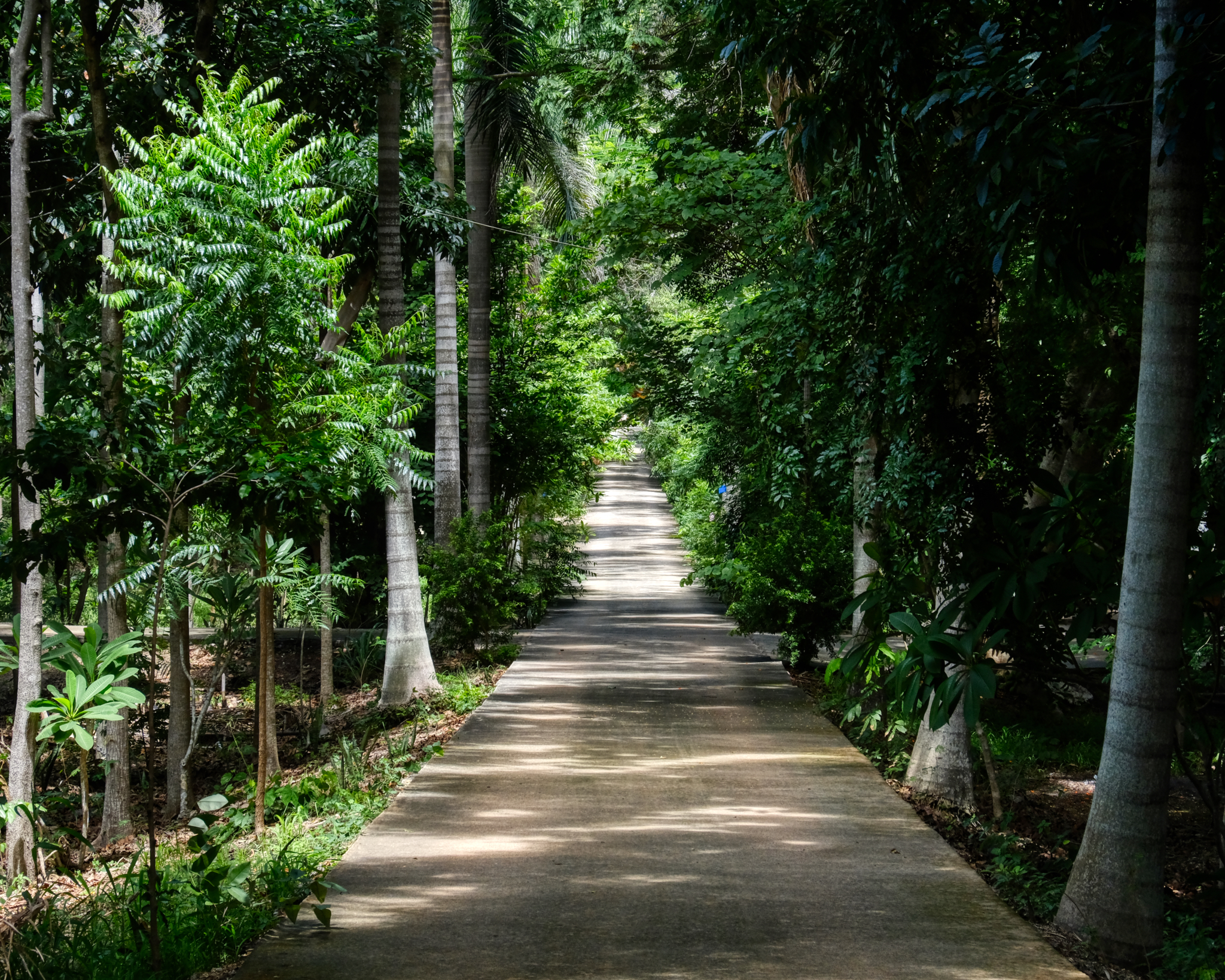
Khao Yai (literally, "large mountain" in the Thai language) is a region of Thailand about a three hour drive northeast of Bangkok. It is thought of as an area with a national park, mountains, and nature, although the mountains are really just tall hills. There is a lot to see in this part of rural Thailand . . . and one very special temple: Wat PA Phrom Prathan (last half of this entry).
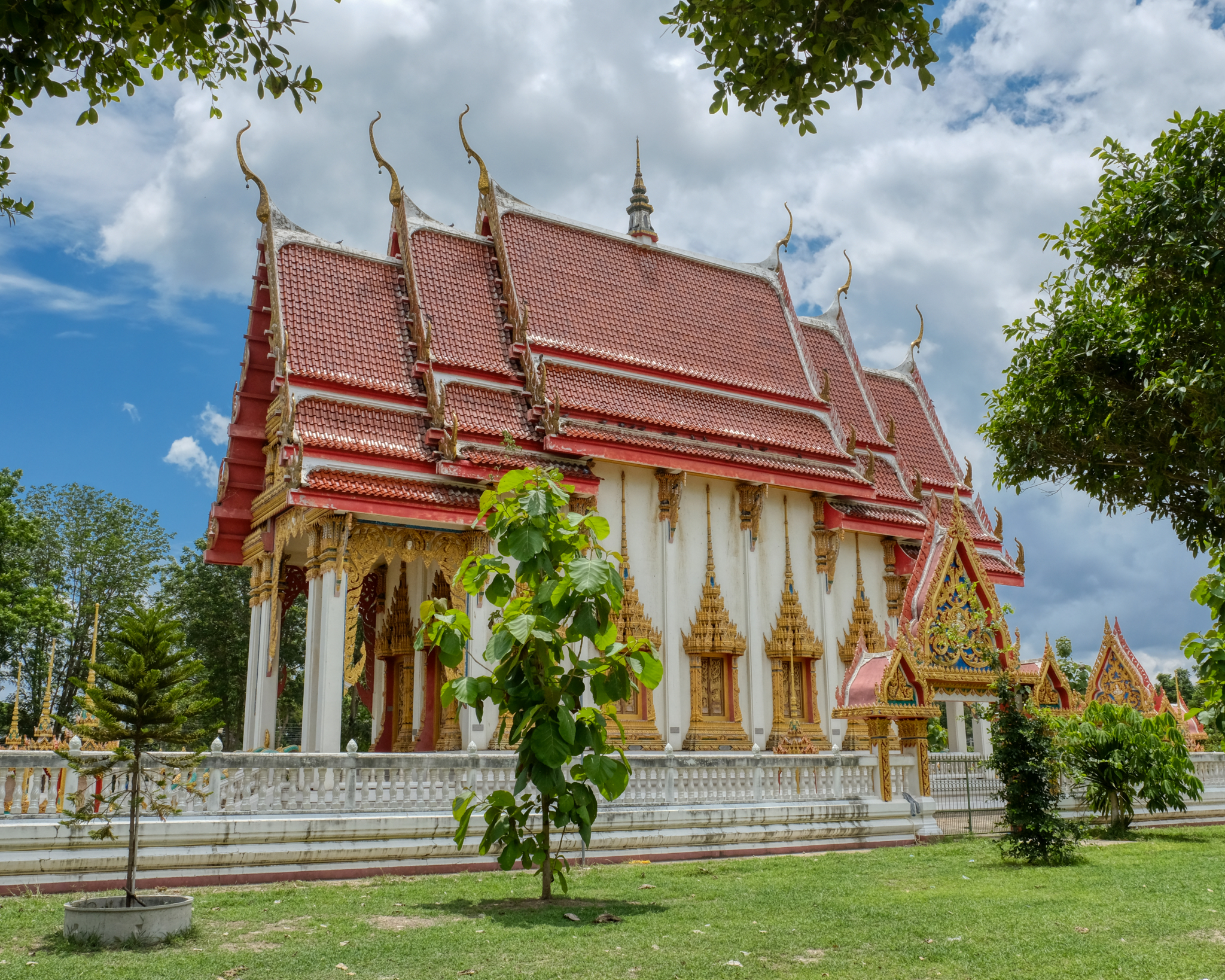 While my wife played golf with her golfing gang, I escaped to the small back roads. There are always Buddhist temples (wats) every 4-5 kilometers along almost every road in Thailand.
While my wife played golf with her golfing gang, I escaped to the small back roads. There are always Buddhist temples (wats) every 4-5 kilometers along almost every road in Thailand.
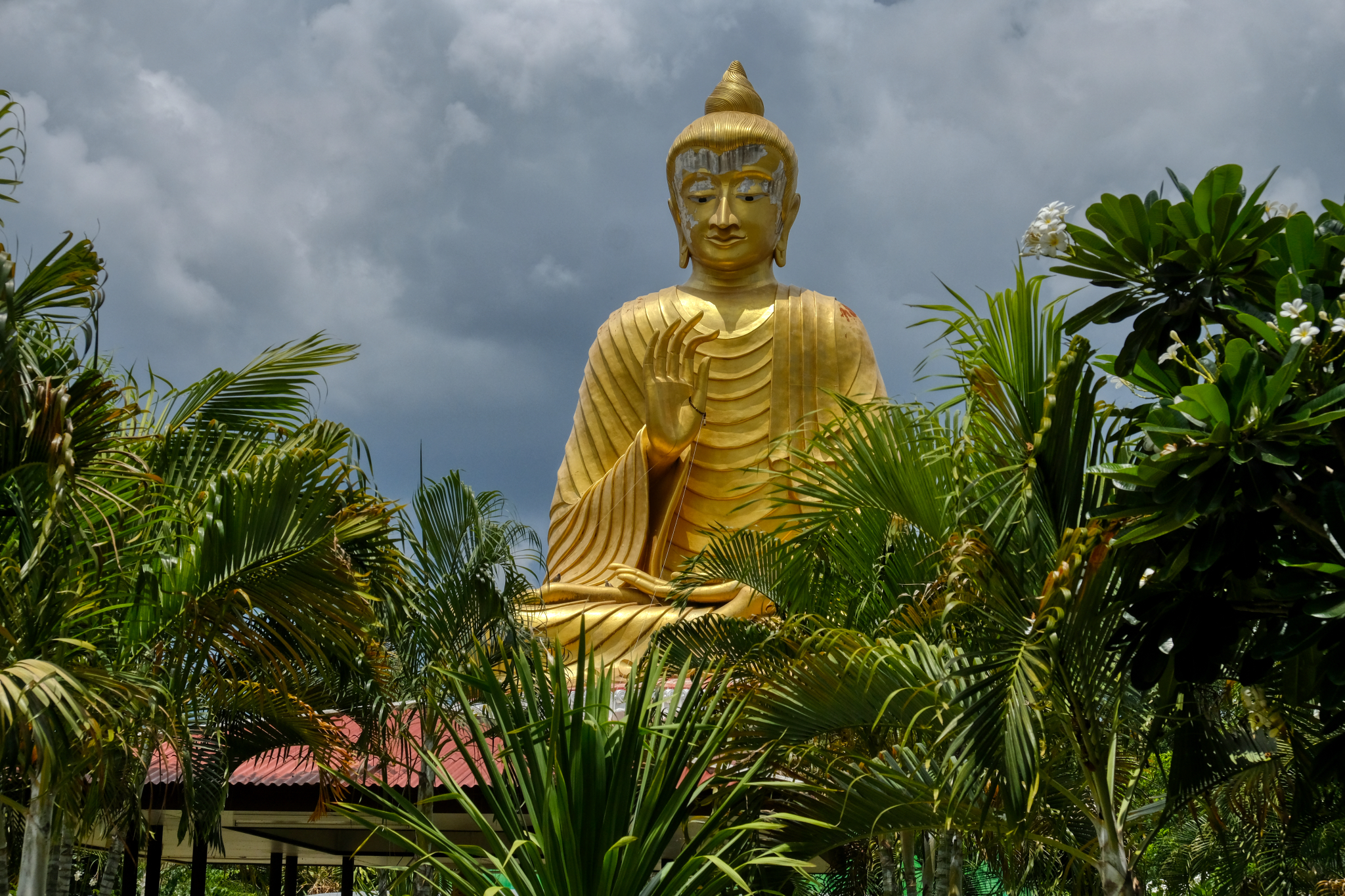 I stopped in at many of these roadside wats and walked around and took a few photos. I have lived in Thailand for a very long time and have been in literally many hundreds of these Thai wats.
I stopped in at many of these roadside wats and walked around and took a few photos. I have lived in Thailand for a very long time and have been in literally many hundreds of these Thai wats.
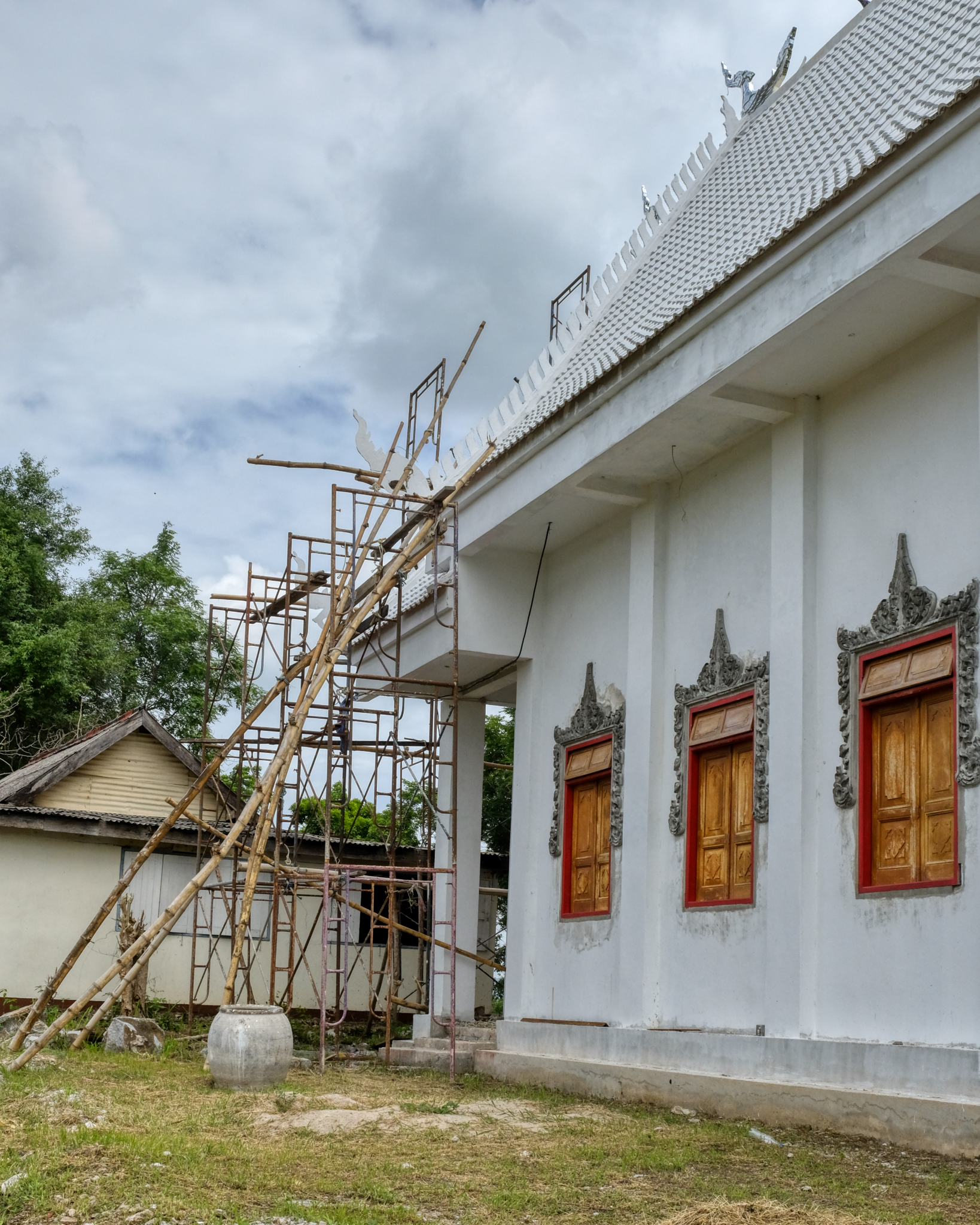 Rural Thai wats can be very similar, but there are always surprises and idiosyncrasies. This wat was in the process of building a new temple building.
Rural Thai wats can be very similar, but there are always surprises and idiosyncrasies. This wat was in the process of building a new temple building.
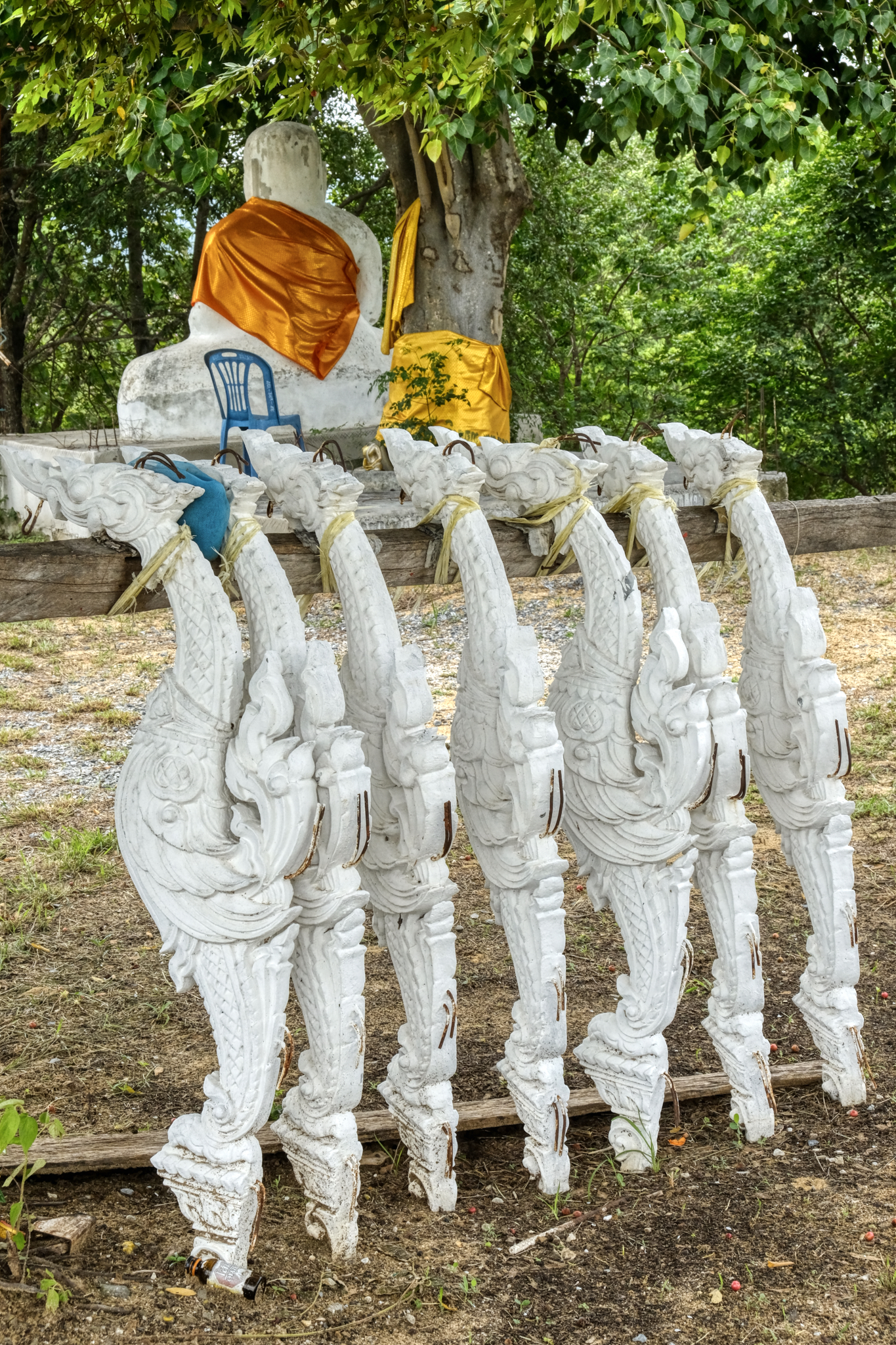 Pre cast decor waiting too be added to the exterior of the new wat structure.
Pre cast decor waiting too be added to the exterior of the new wat structure.
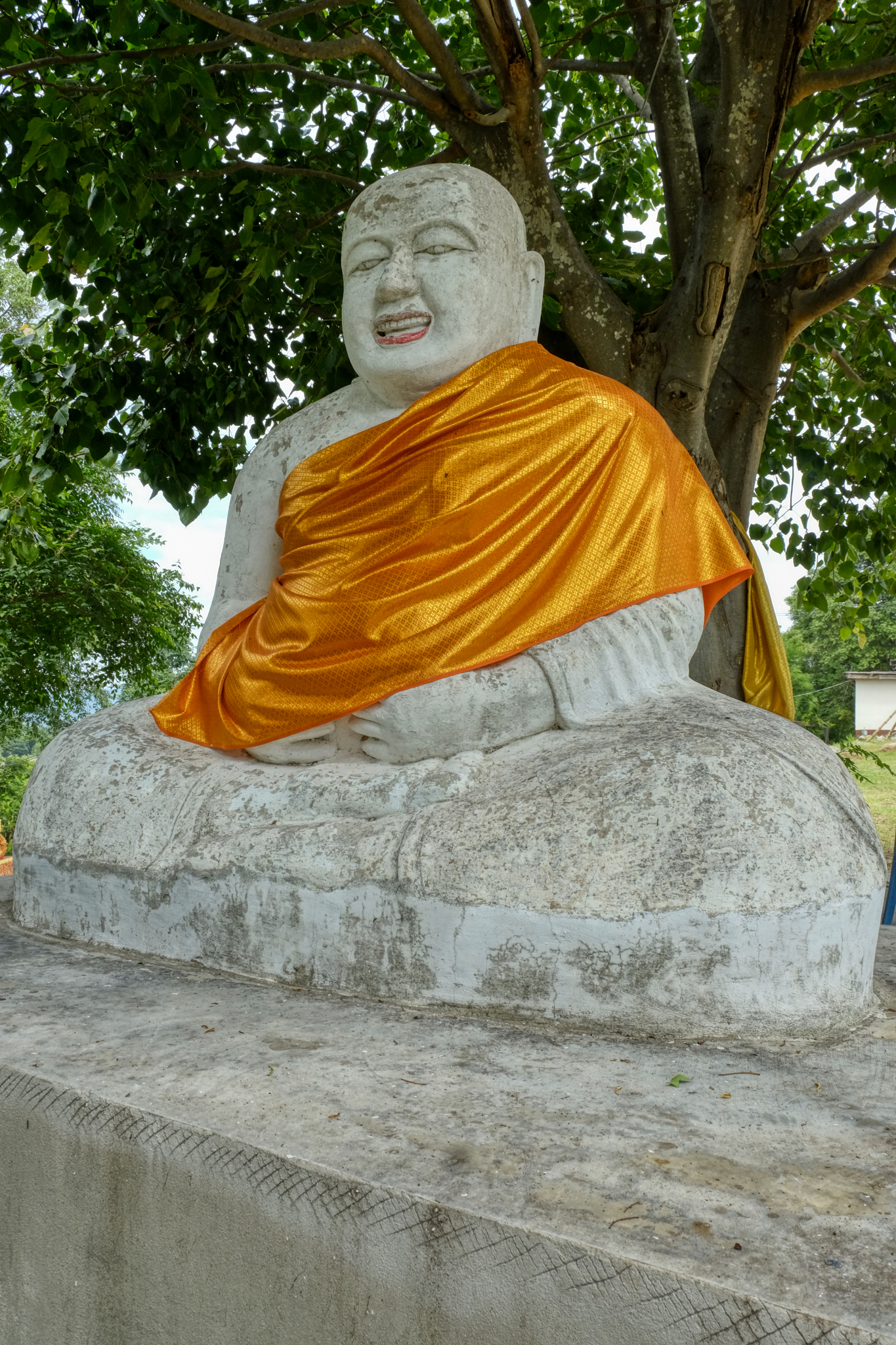 This Buddha image was very unusual for Thailand! It seems more Japanese . . .
This Buddha image was very unusual for Thailand! It seems more Japanese . . .
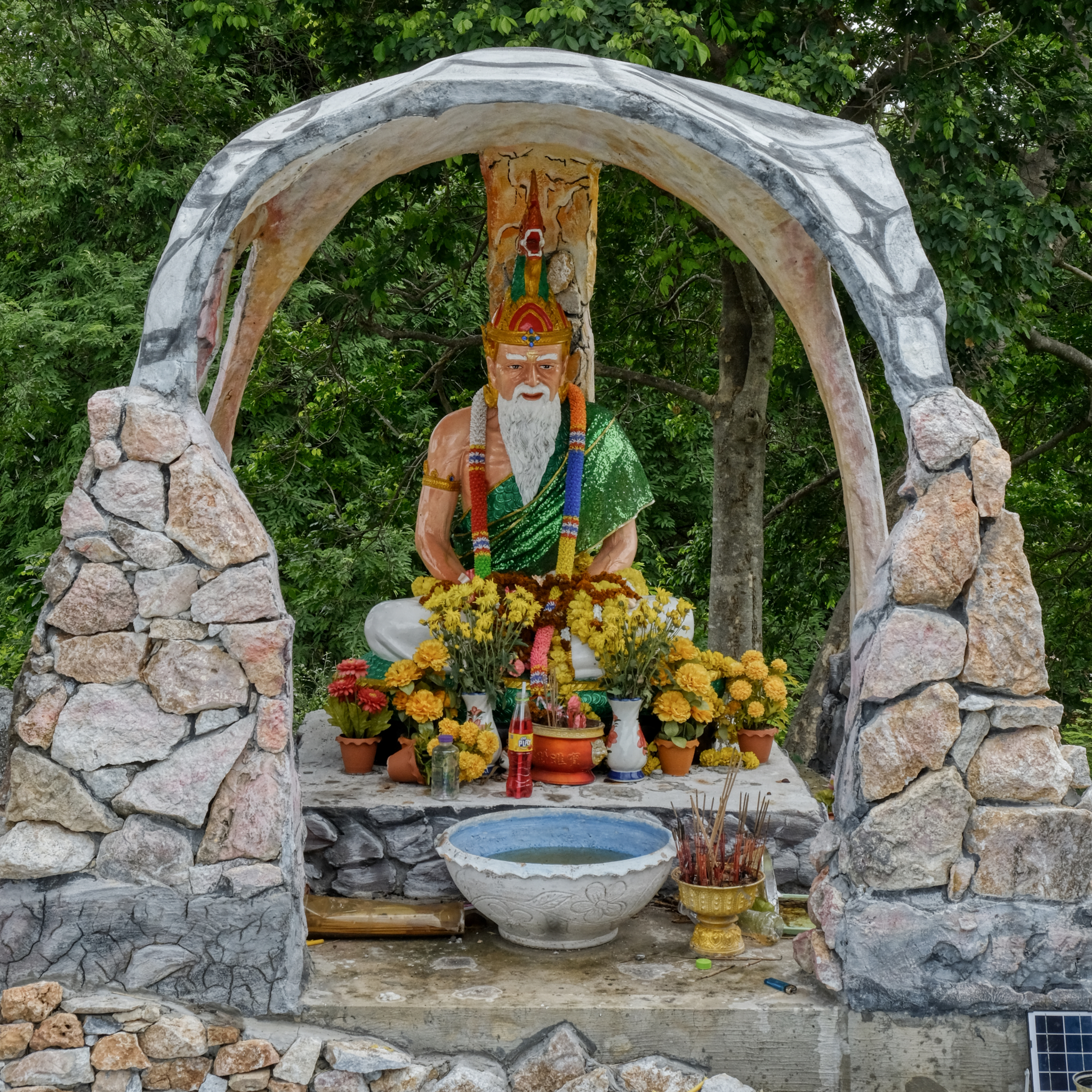 You have to remember that what is found inside a Buddhist temple was put there by the donors, not necessarily by monks who live there. This is a grotto dedicated to a Hindu guru. It is not uncommon to see Hindu gods and iconography in Thai wats.
You have to remember that what is found inside a Buddhist temple was put there by the donors, not necessarily by monks who live there. This is a grotto dedicated to a Hindu guru. It is not uncommon to see Hindu gods and iconography in Thai wats.
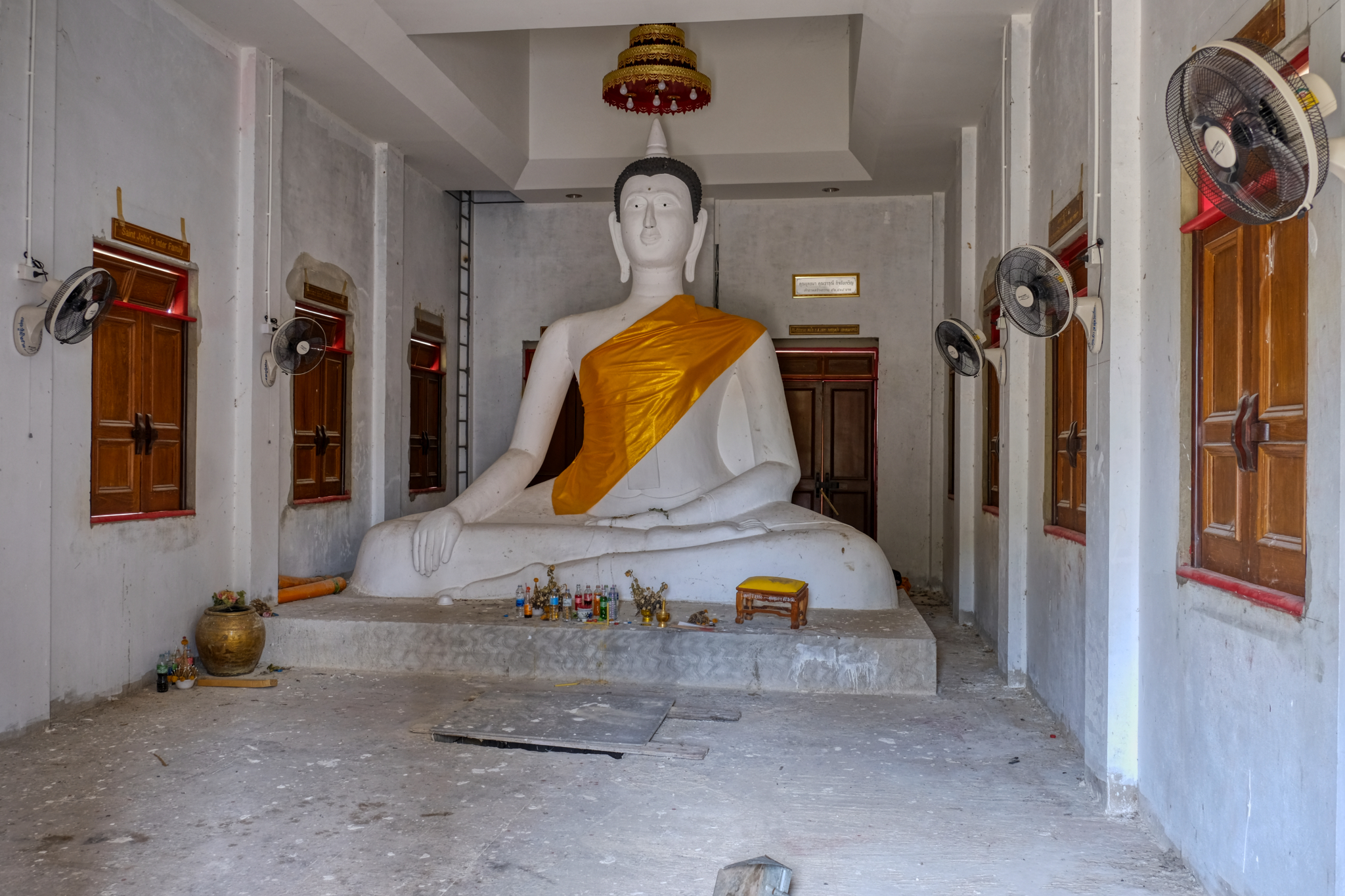 Having been a sponsor of the construction of a wat myself, I am always excited to see a new wat being built . . . I especially enjoy the interiors . . . . a wonderfully naive Buddha statue awaiting a gold leaf covering, I assume.
Having been a sponsor of the construction of a wat myself, I am always excited to see a new wat being built . . . I especially enjoy the interiors . . . . a wonderfully naive Buddha statue awaiting a gold leaf covering, I assume.
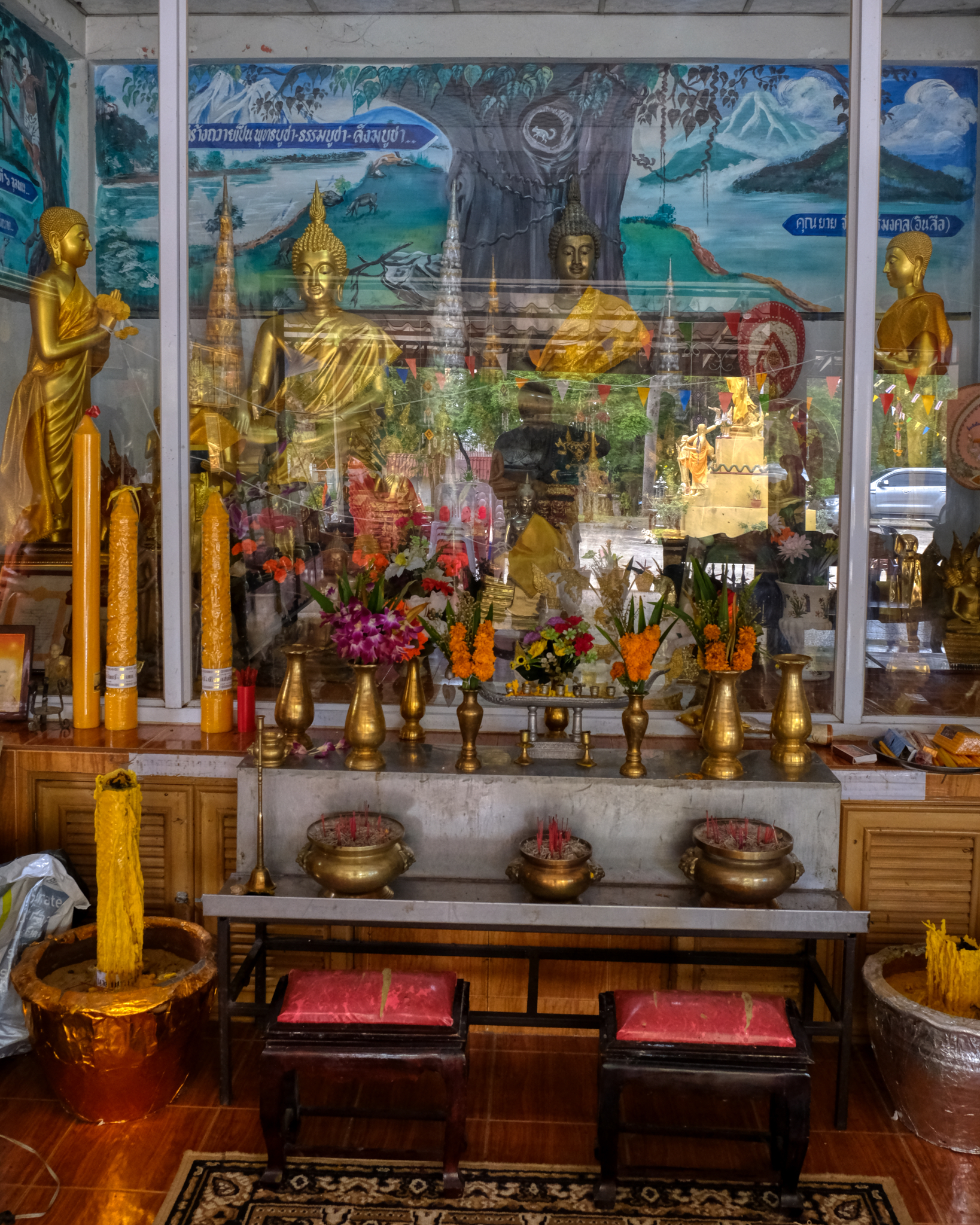 The wat did not have a proper temple building. This is the altar the new building will replace . . . just a covered portico.
The wat did not have a proper temple building. This is the altar the new building will replace . . . just a covered portico.
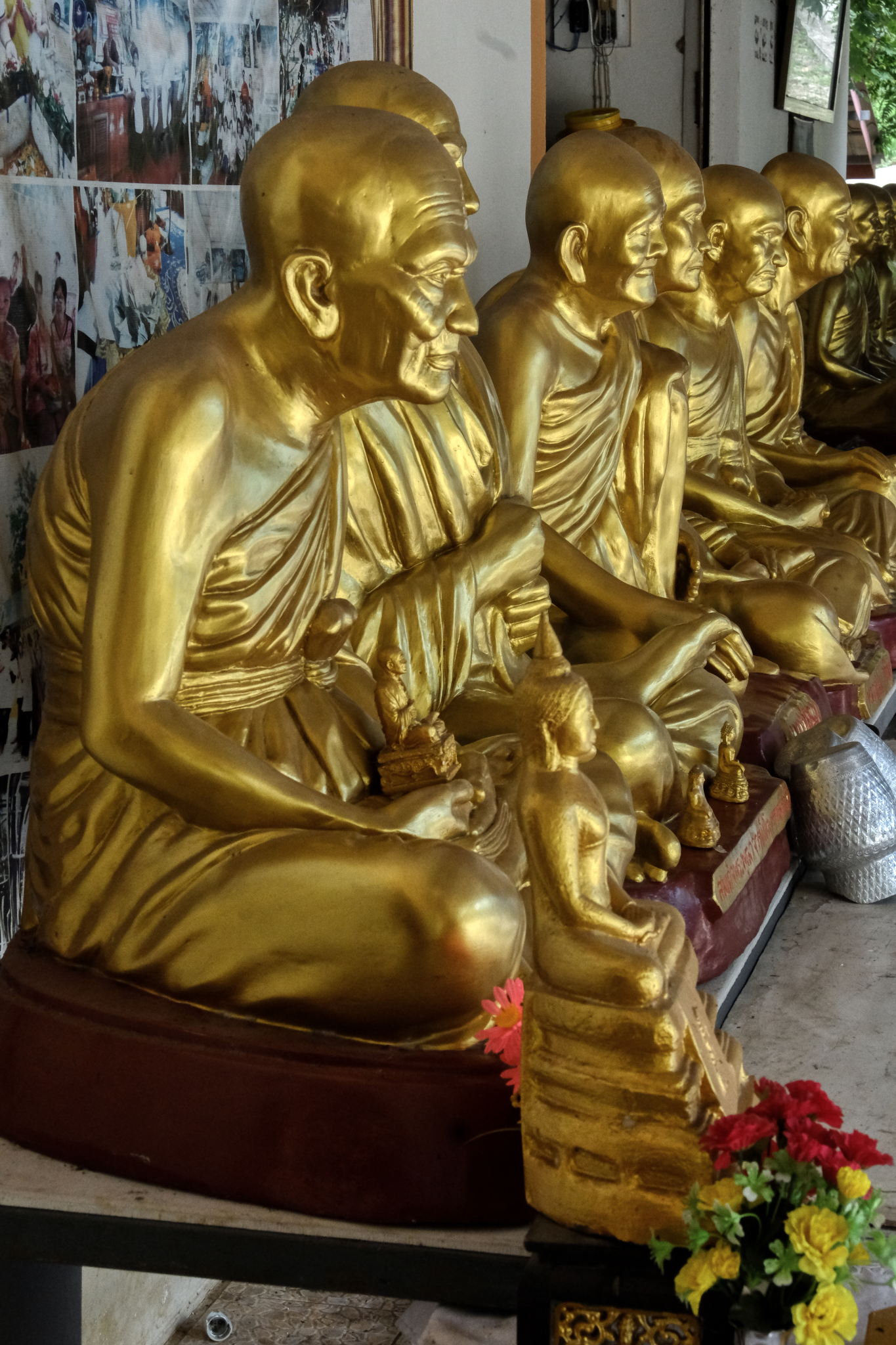 This wat had a line of gilded revered monk statues. Very powerful: These Guys Made It All The Way And You Can Too!
This wat had a line of gilded revered monk statues. Very powerful: These Guys Made It All The Way And You Can Too!
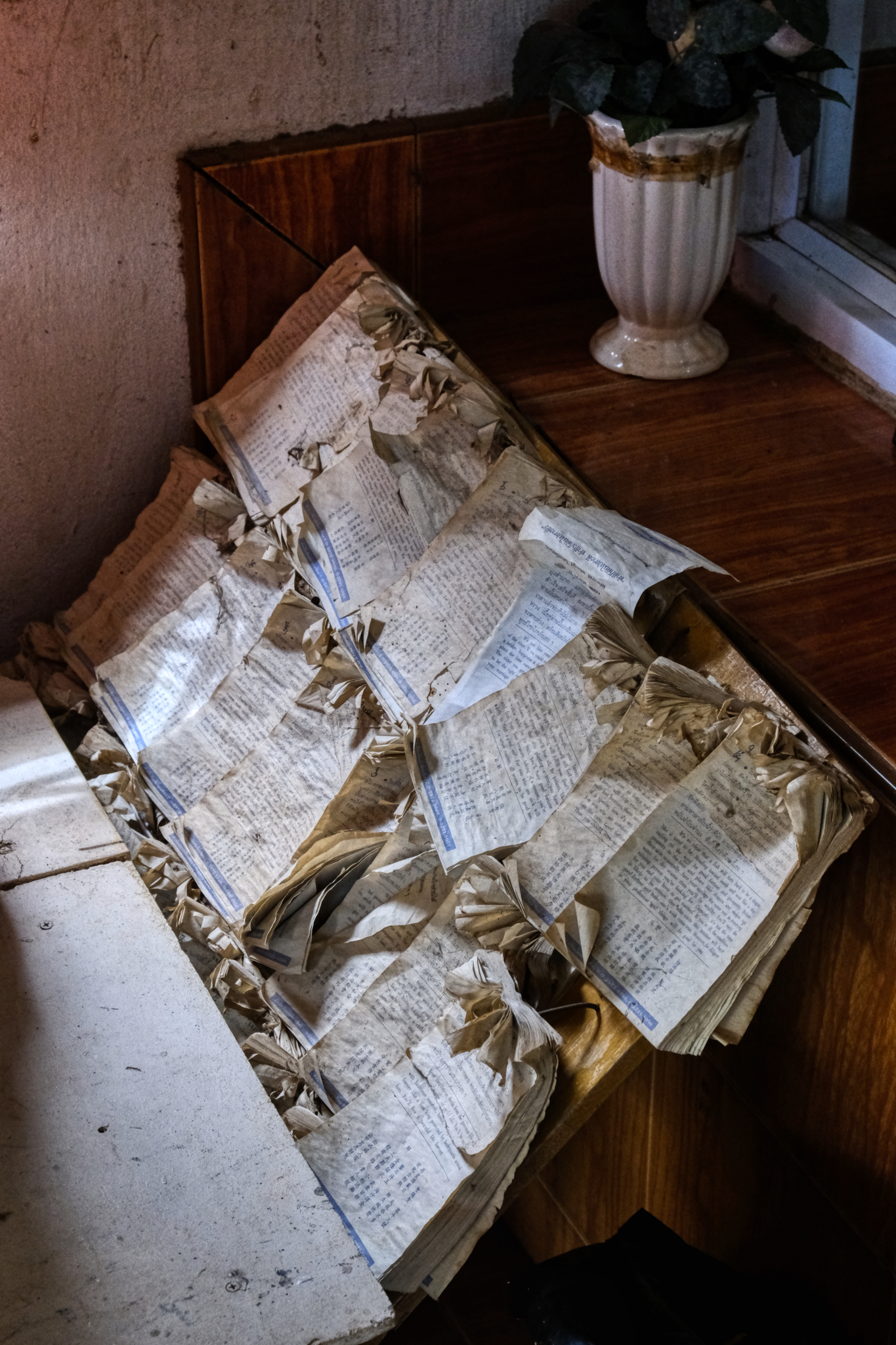 There are non-Buddhist, but old spiritual practices to be found in Thai Buddhist temples. These are for use in a numerological system for fortune telling. Beautifully weathered.
There are non-Buddhist, but old spiritual practices to be found in Thai Buddhist temples. These are for use in a numerological system for fortune telling. Beautifully weathered.
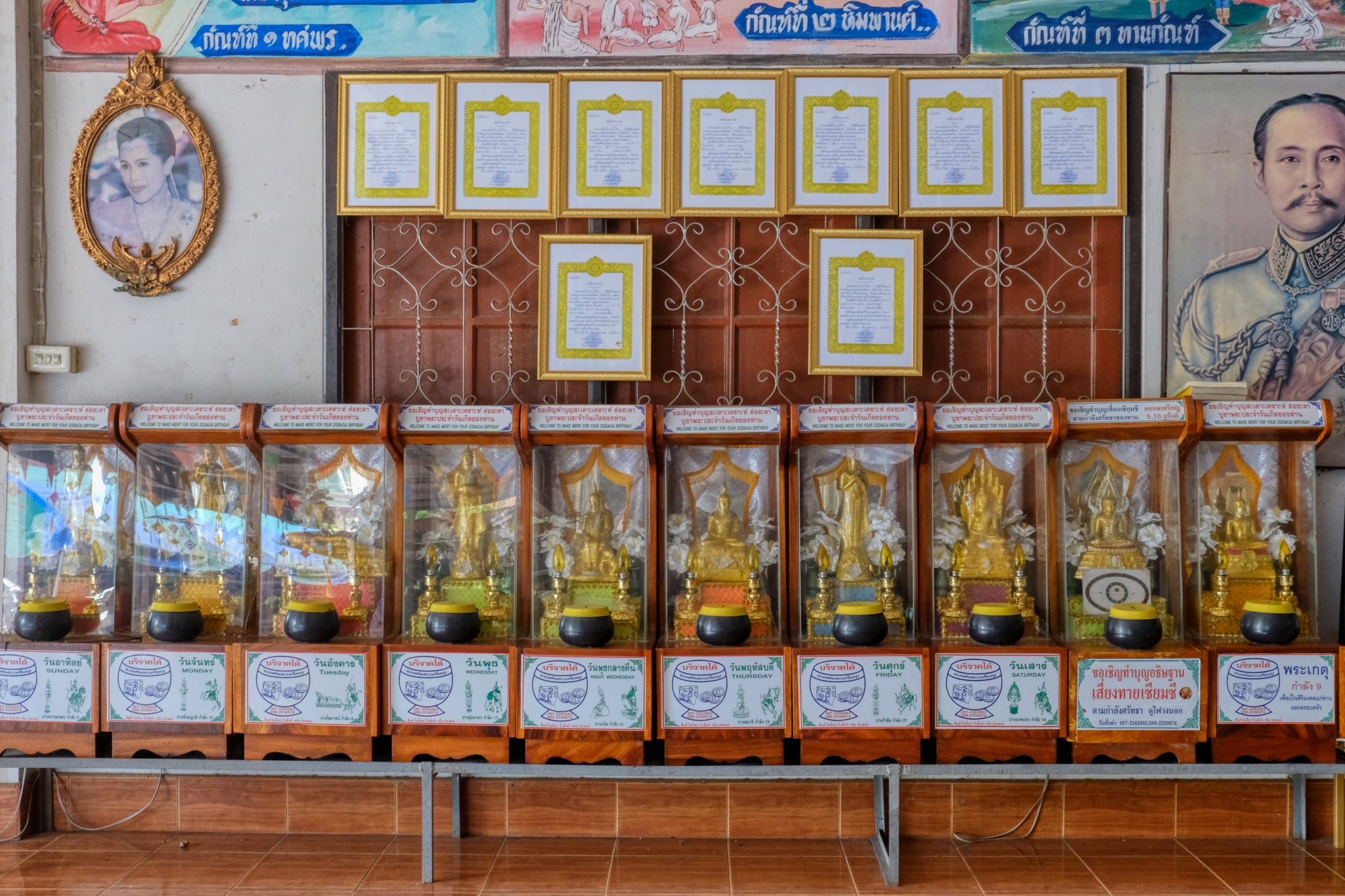 "Welcome to make merit for your Zodiacal Birthday" . . . . and a little something for the days of the week too!
"Welcome to make merit for your Zodiacal Birthday" . . . . and a little something for the days of the week too!
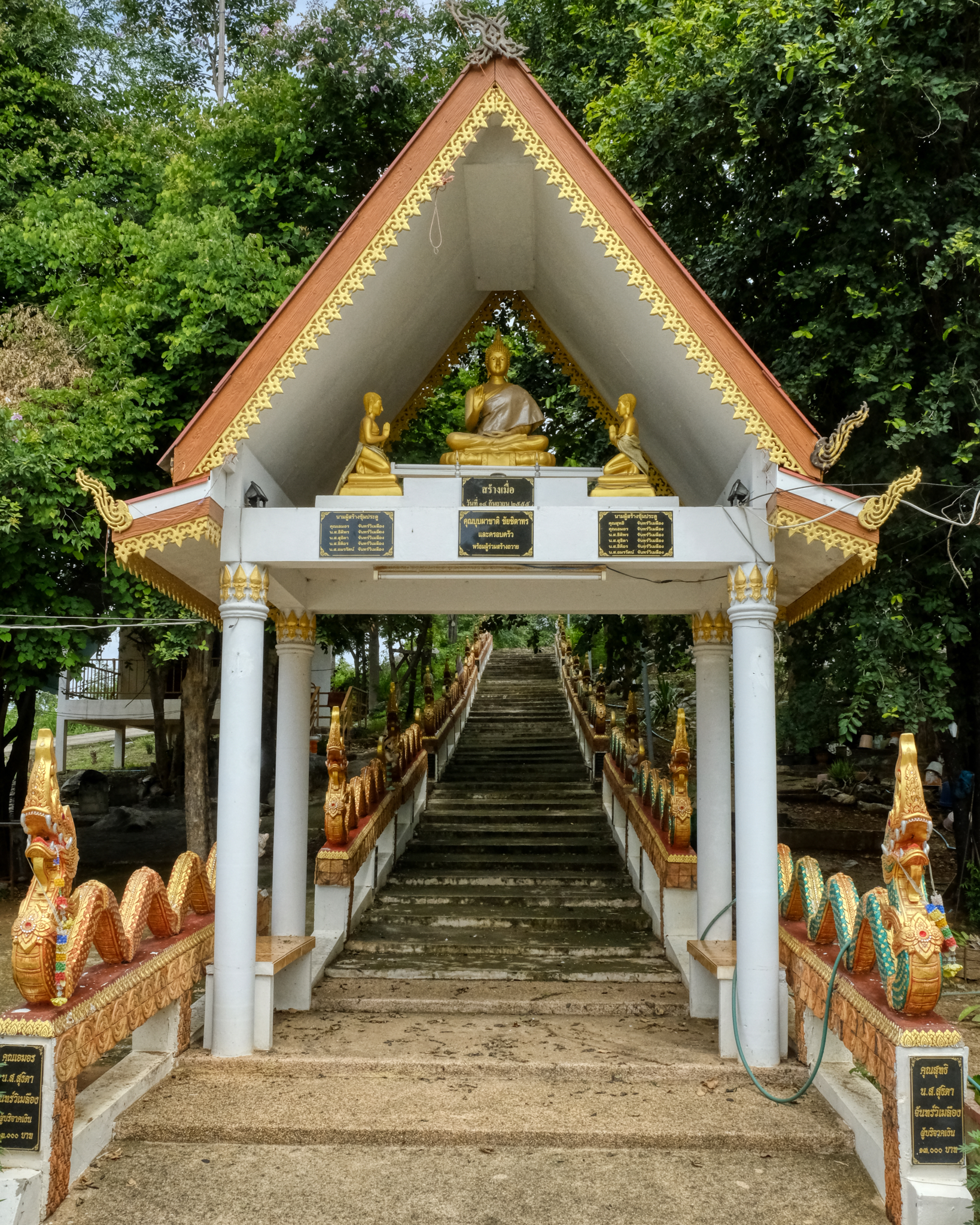 The hillside wat had a beautiful staircase up to the new wat location.
The hillside wat had a beautiful staircase up to the new wat location.
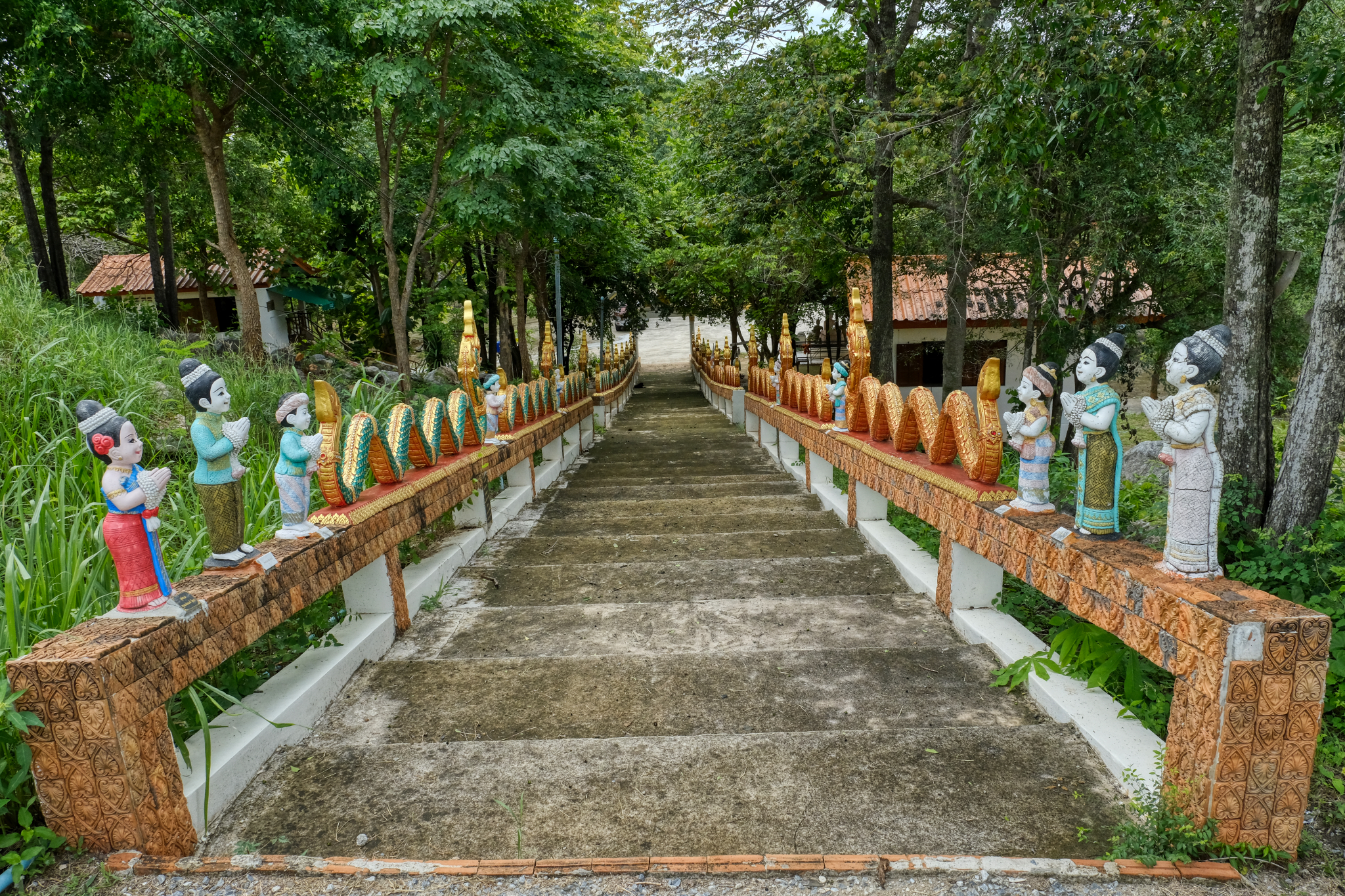 The same staircase looking down.
The same staircase looking down.
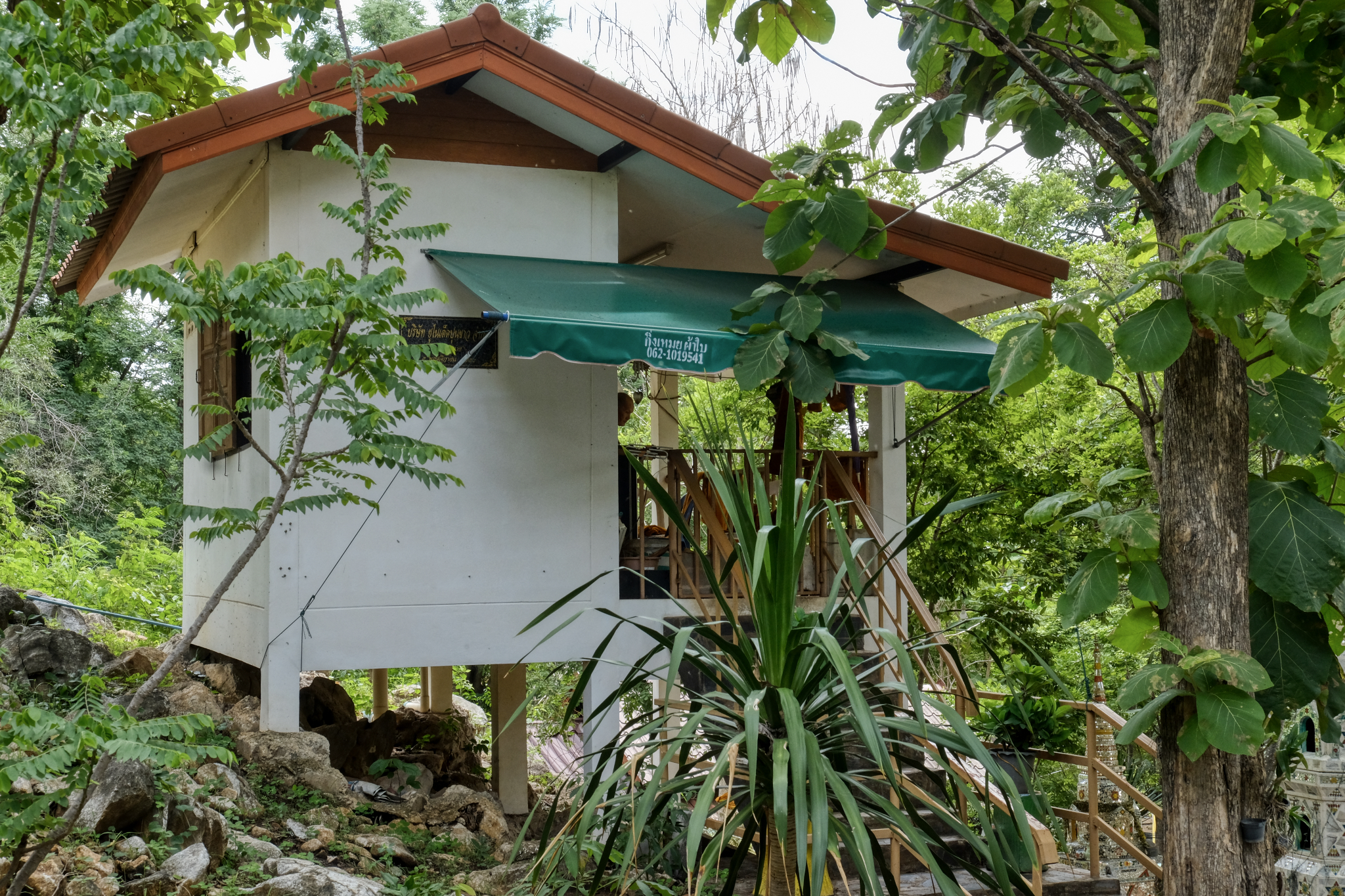 The monks live in a variety of accommodation: sometimes they have their own 'hut' or cabin, like this one. Sometimes these can be very nice, and sometimes very austere dormitories.
The monks live in a variety of accommodation: sometimes they have their own 'hut' or cabin, like this one. Sometimes these can be very nice, and sometimes very austere dormitories.
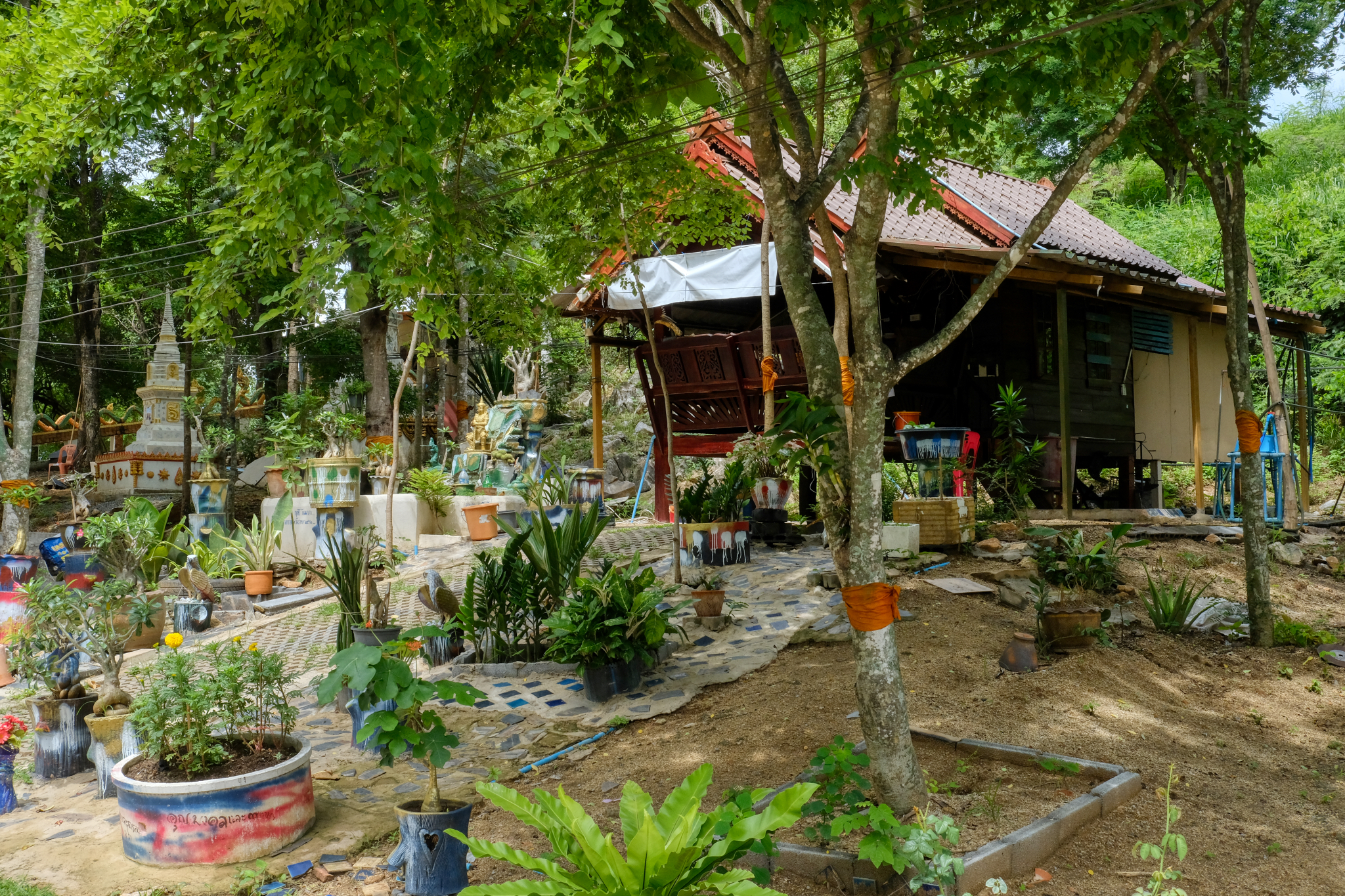 This monk keeps an interesting and cluttered front yard!
This monk keeps an interesting and cluttered front yard!
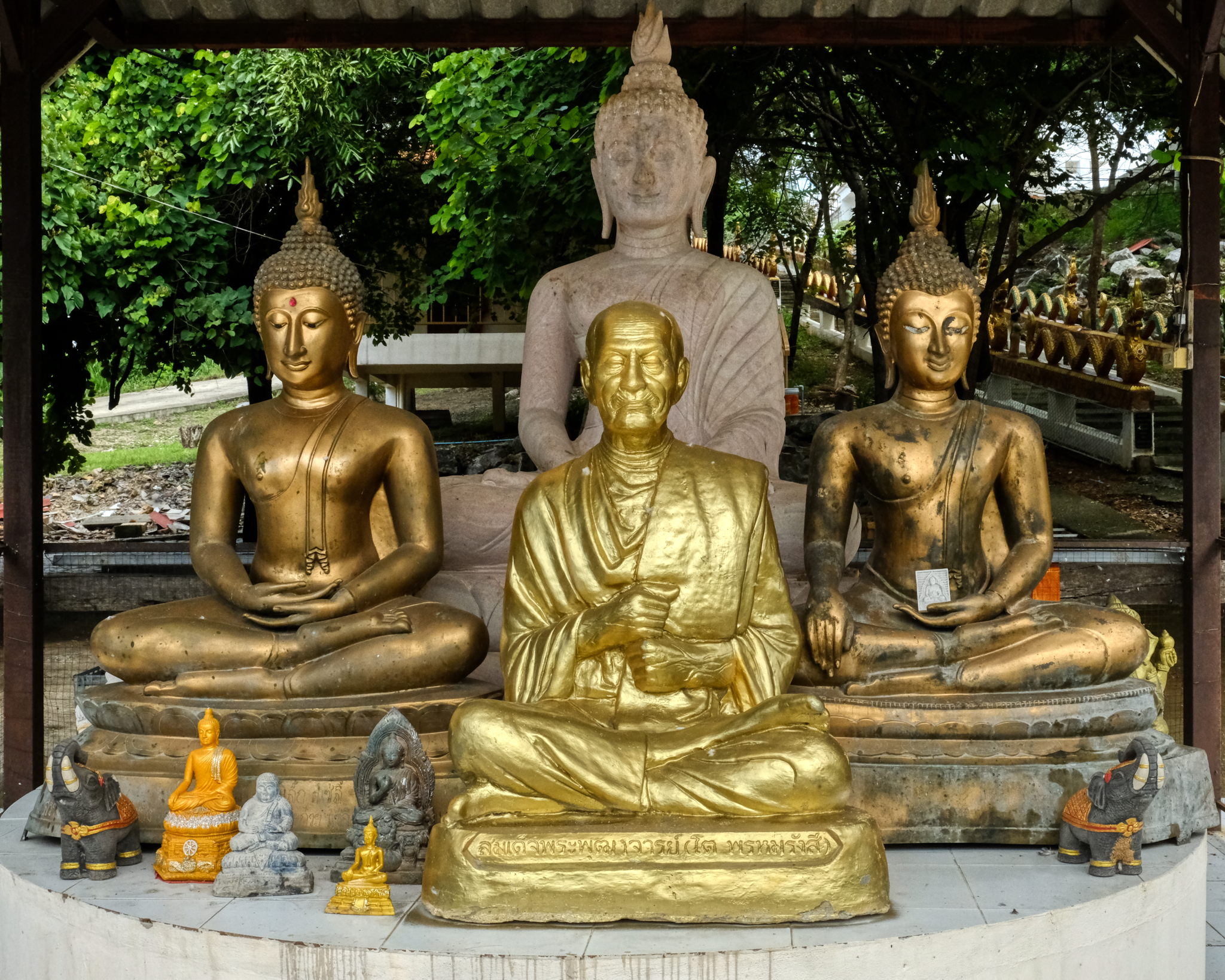 I found this wonderful altar in a sala out in a wooded area of the wat.
I found this wonderful altar in a sala out in a wooded area of the wat.
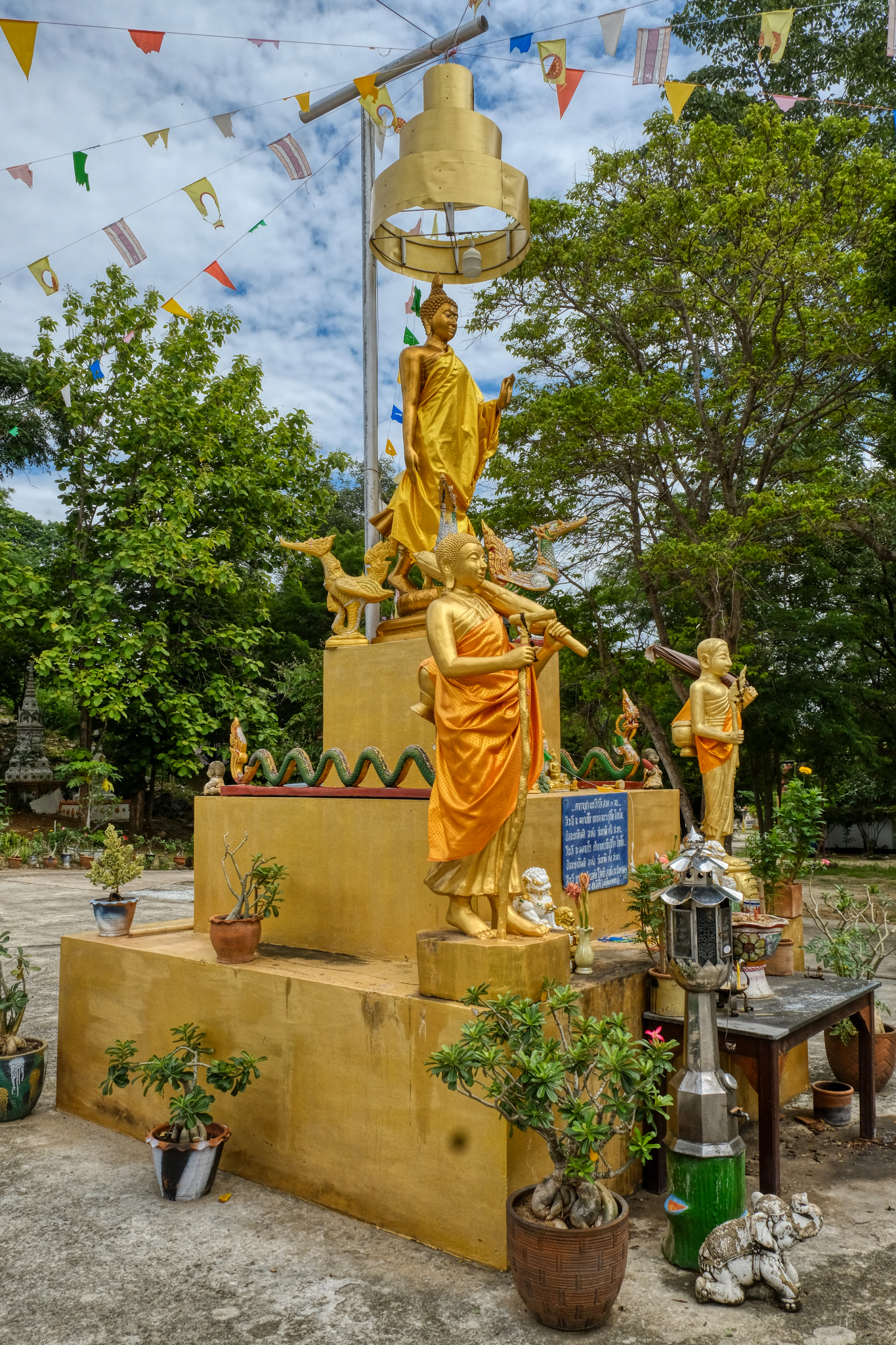 There always some amazing things to see on the grounds of Thai Buddhist wats!
There always some amazing things to see on the grounds of Thai Buddhist wats!
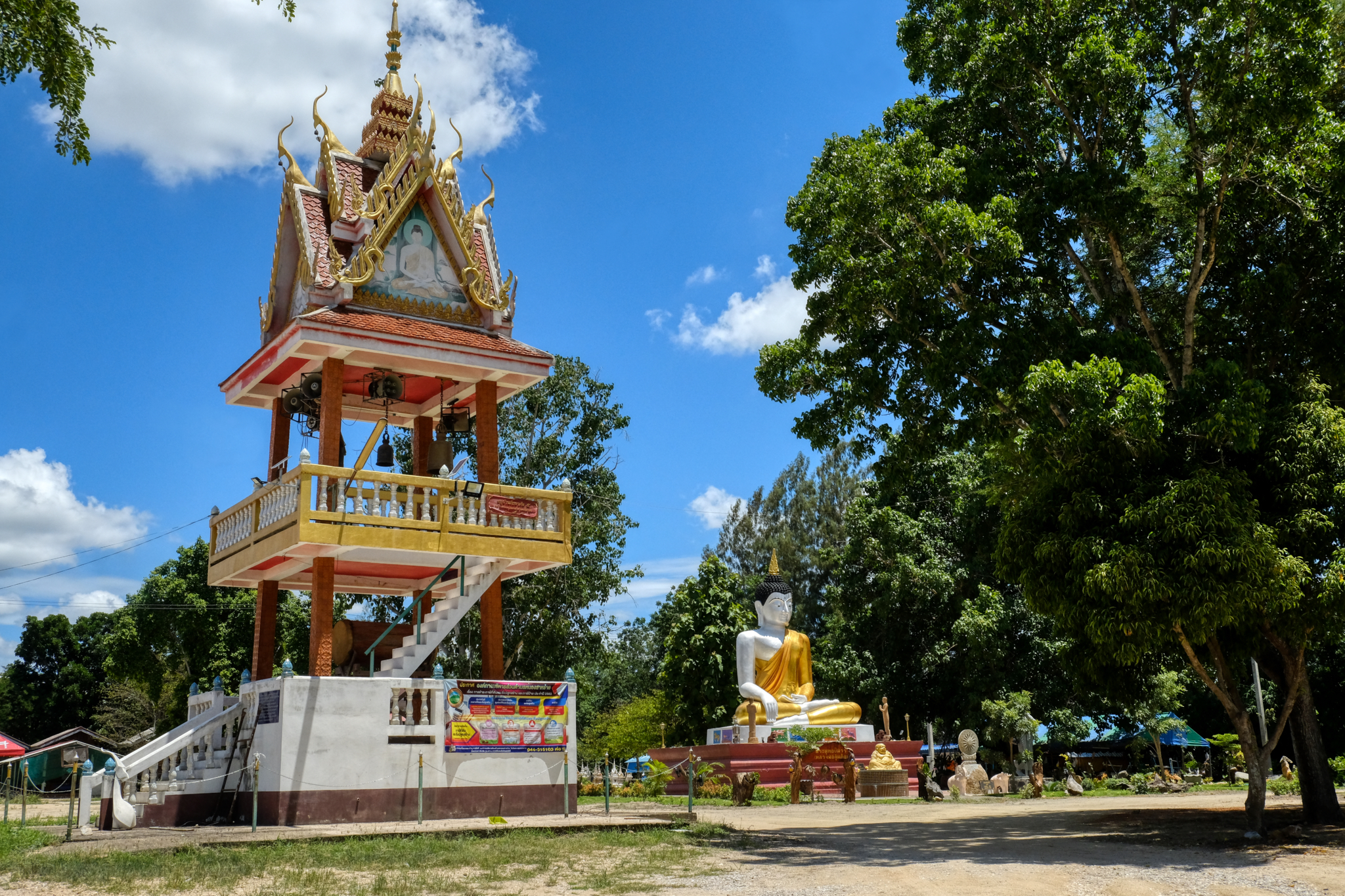 At another wat along a country lane . . . a bell and drum tower and very large outdoor Buddha.
At another wat along a country lane . . . a bell and drum tower and very large outdoor Buddha.
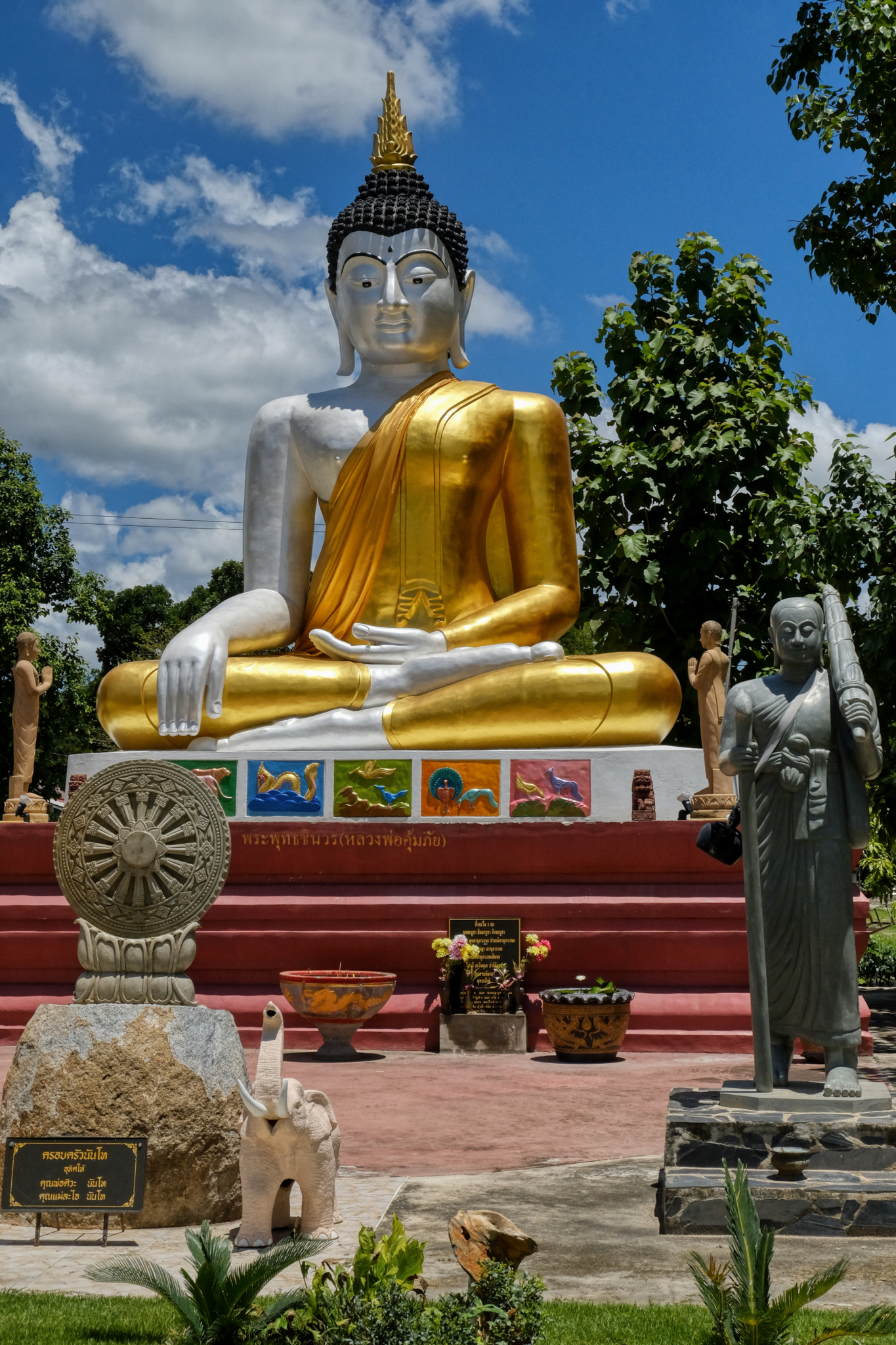 Such a serious-looking Buddha . . .
Such a serious-looking Buddha . . .
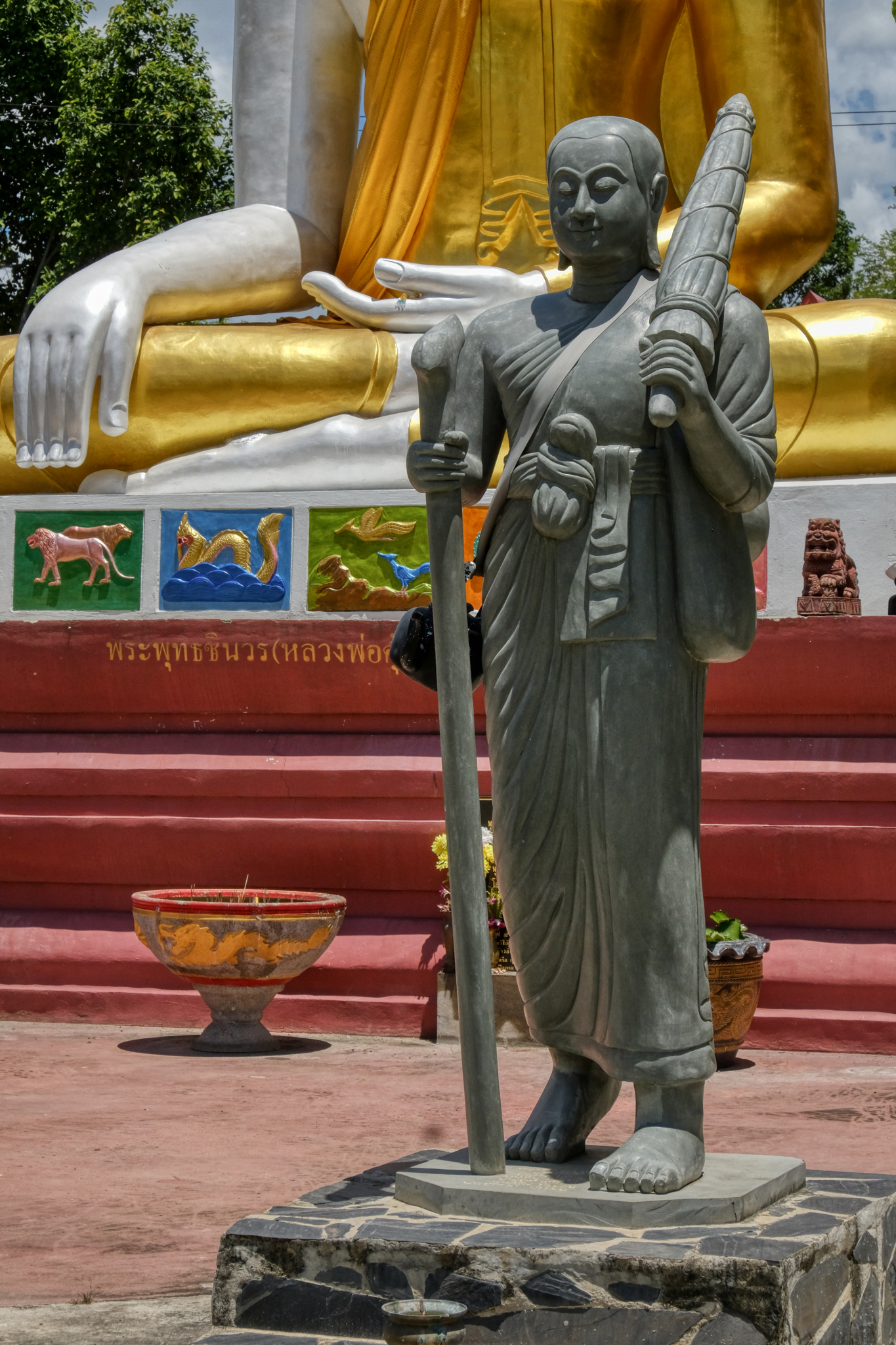 I loved this statue of the Buddha as a wondering monk . . . which he was.
I loved this statue of the Buddha as a wondering monk . . . which he was.
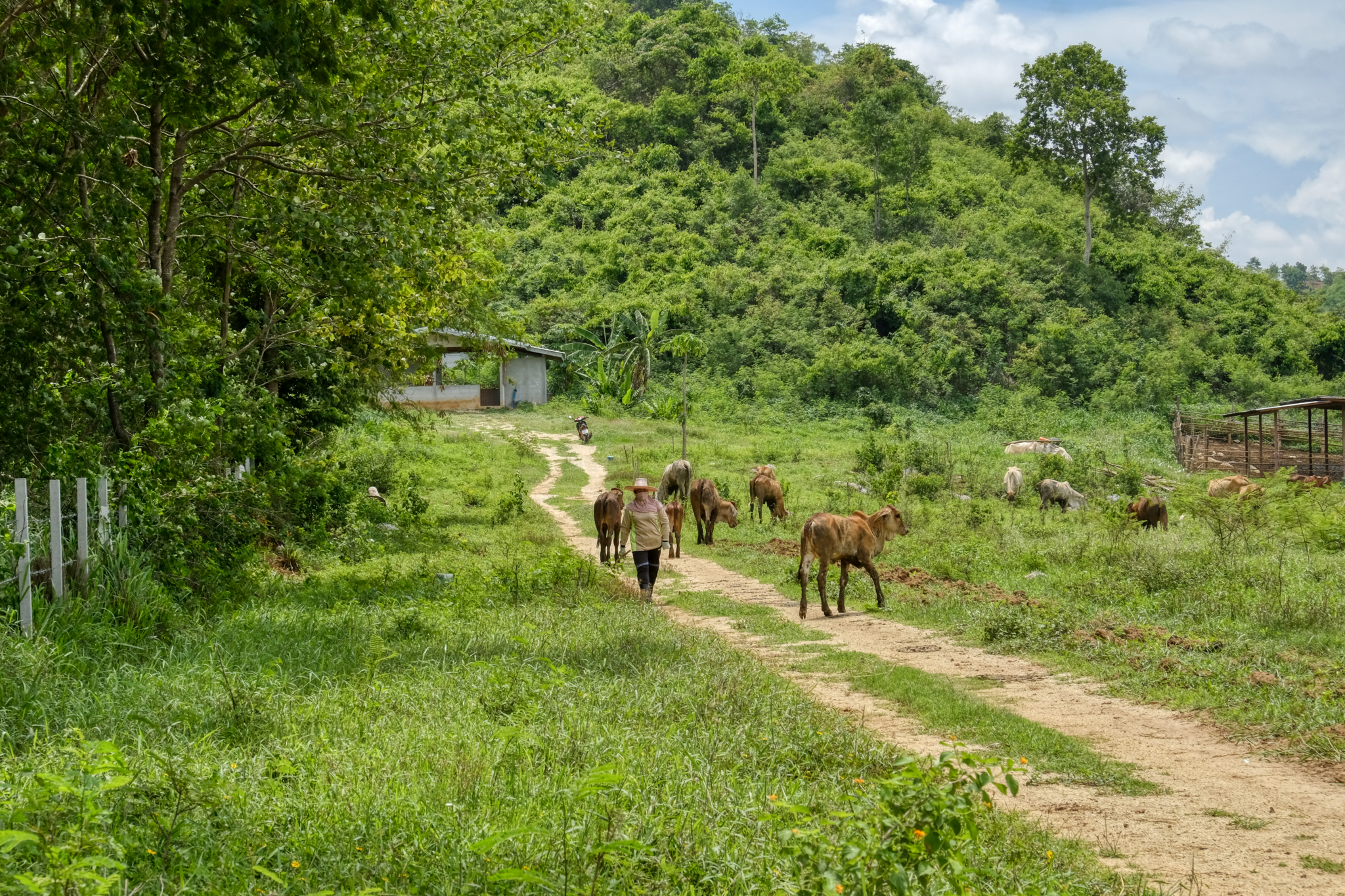 Sometimes my small rural lanes would come to a dead-end . . . as it did here in a farmers field.
Sometimes my small rural lanes would come to a dead-end . . . as it did here in a farmers field.
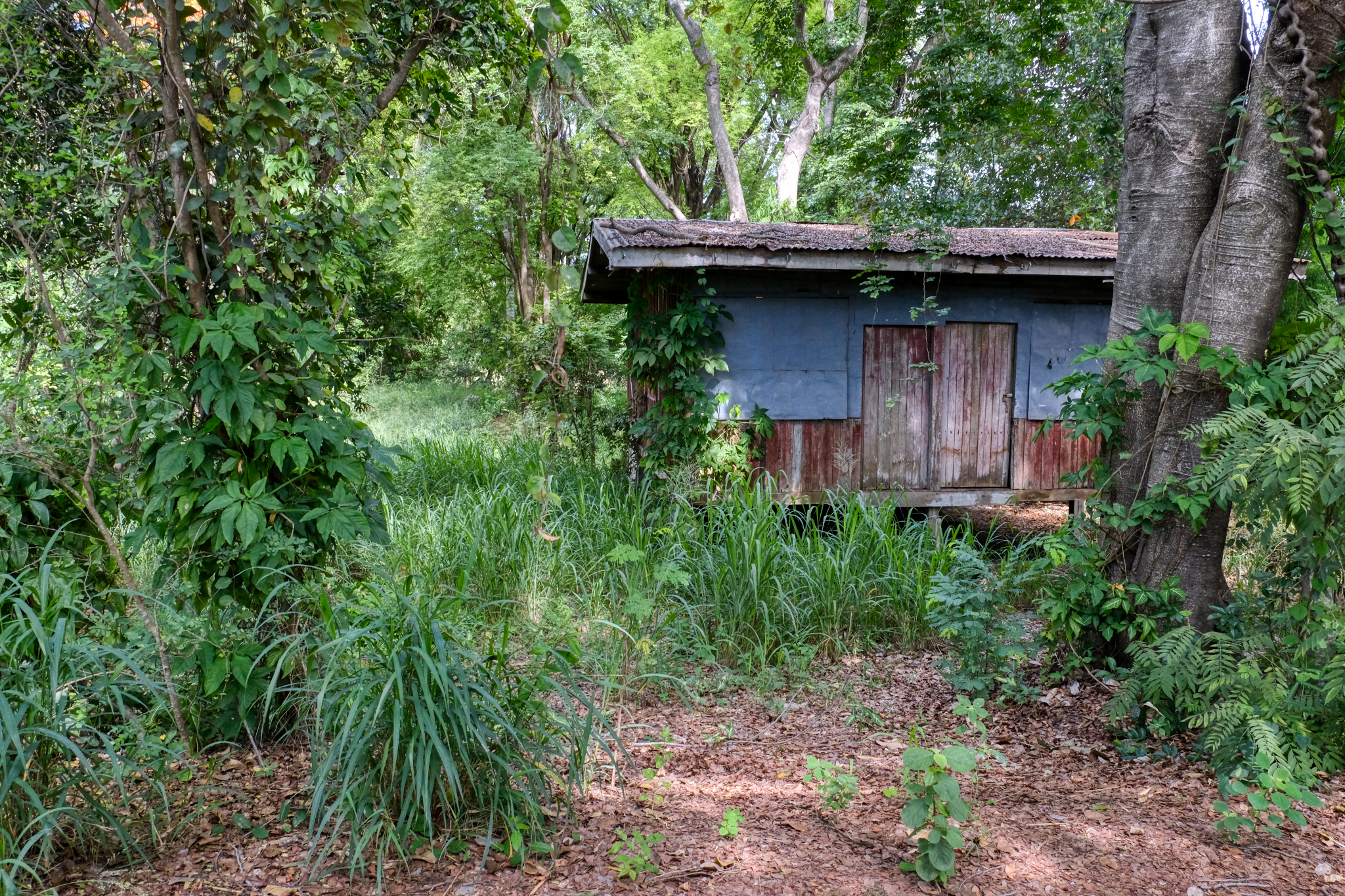 Many small work sheds dot the agricultural landscape in this part of Thailand.
Many small work sheds dot the agricultural landscape in this part of Thailand.
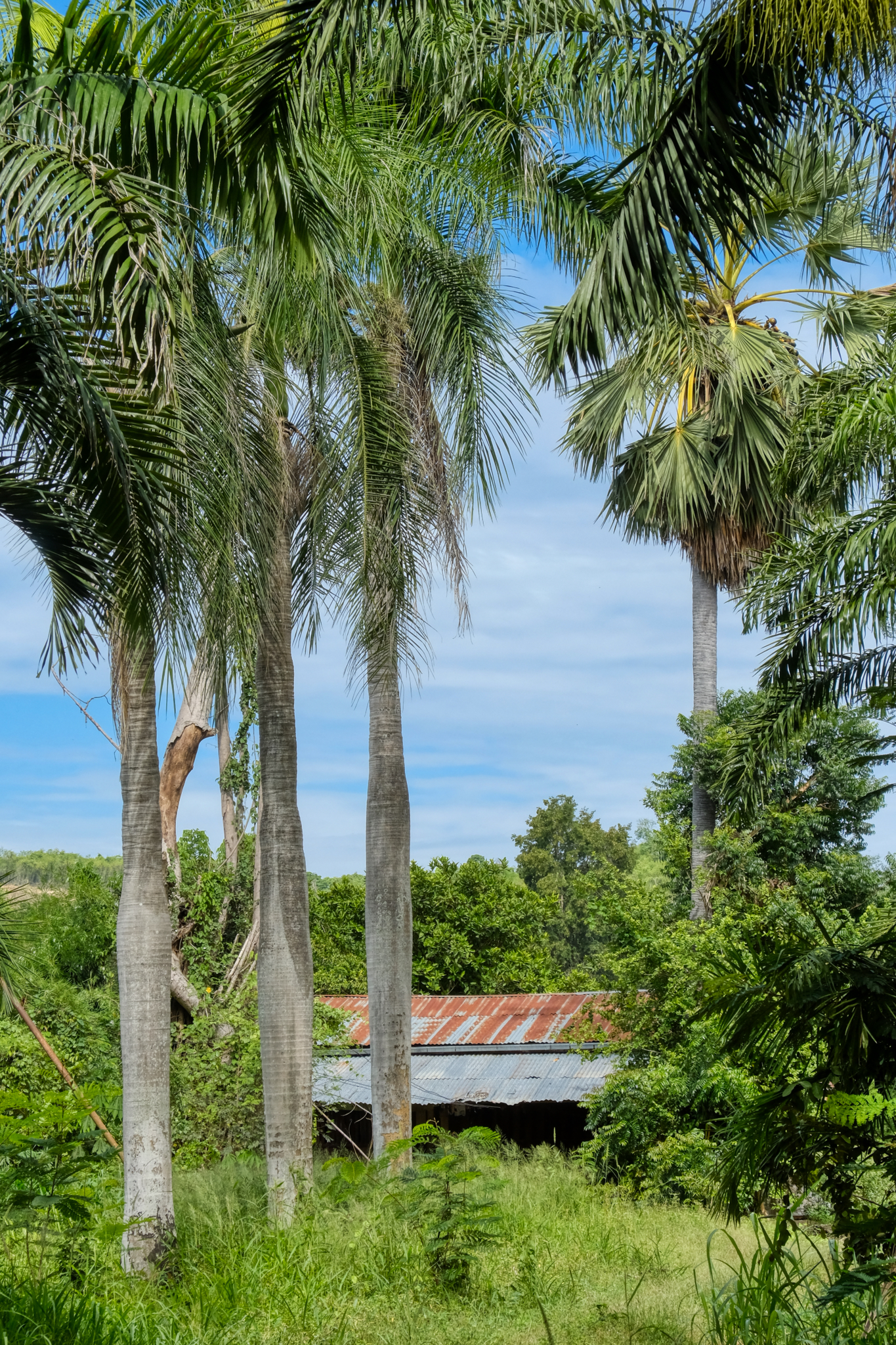 It was a beautiful day to be out rambling in the Thai countryside.
It was a beautiful day to be out rambling in the Thai countryside.
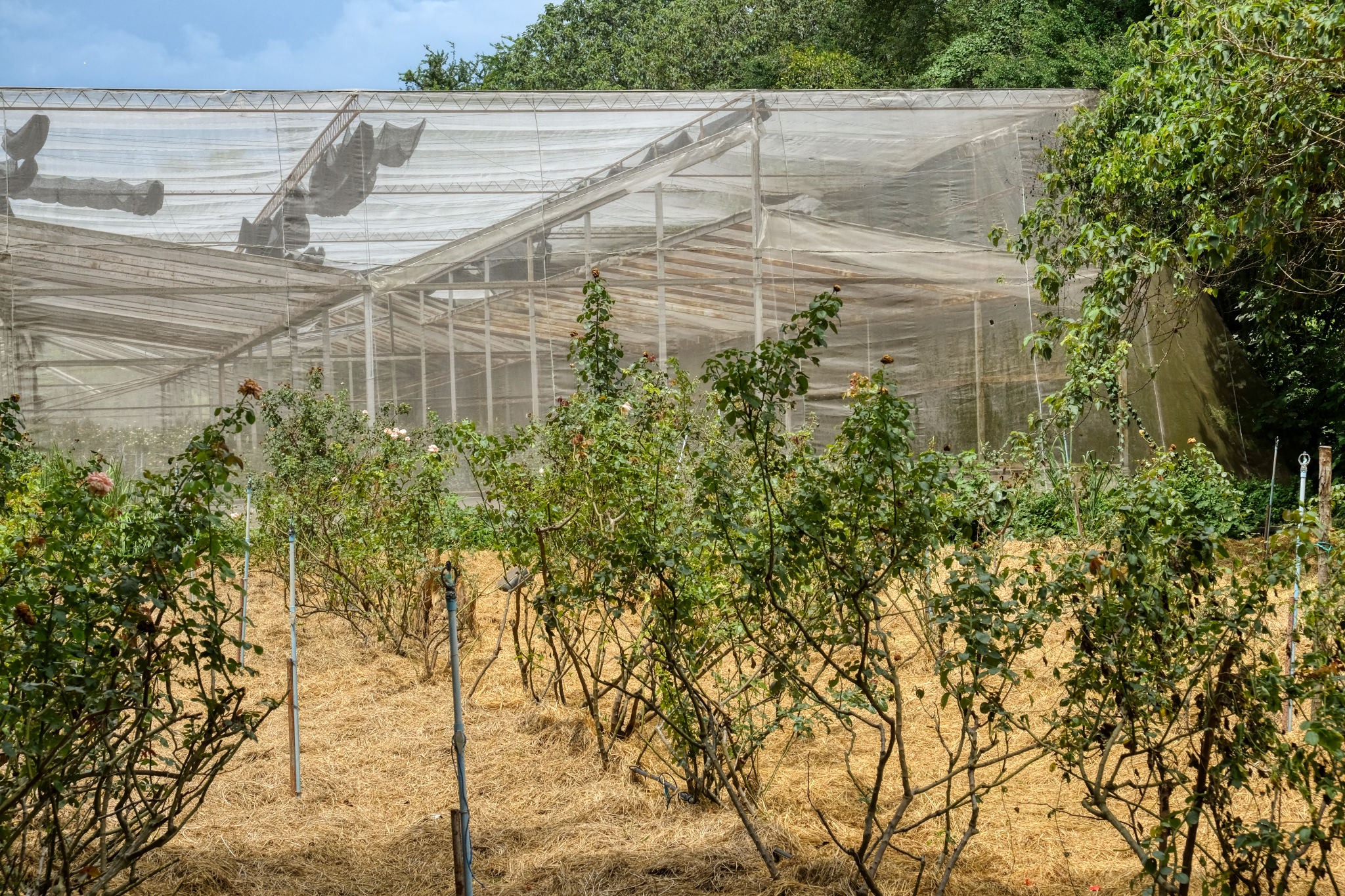 I stumbled upon this big greenhouse operation raising roses. Big agribusiness out in the deep forest.
I stumbled upon this big greenhouse operation raising roses. Big agribusiness out in the deep forest.
 A bamboo pump house.
A bamboo pump house.
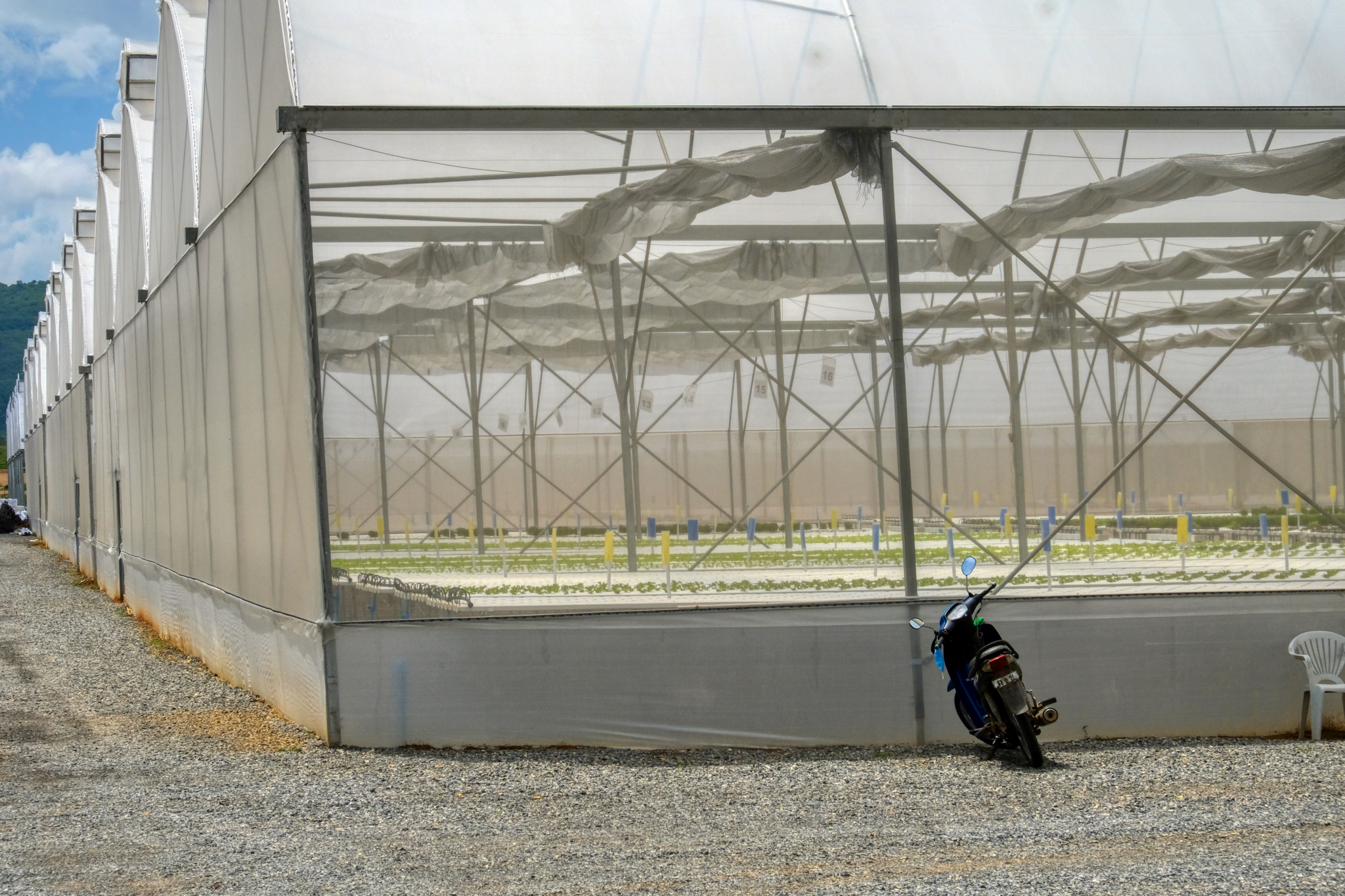 More rural agribusiness . . . lettuce.
More rural agribusiness . . . lettuce.
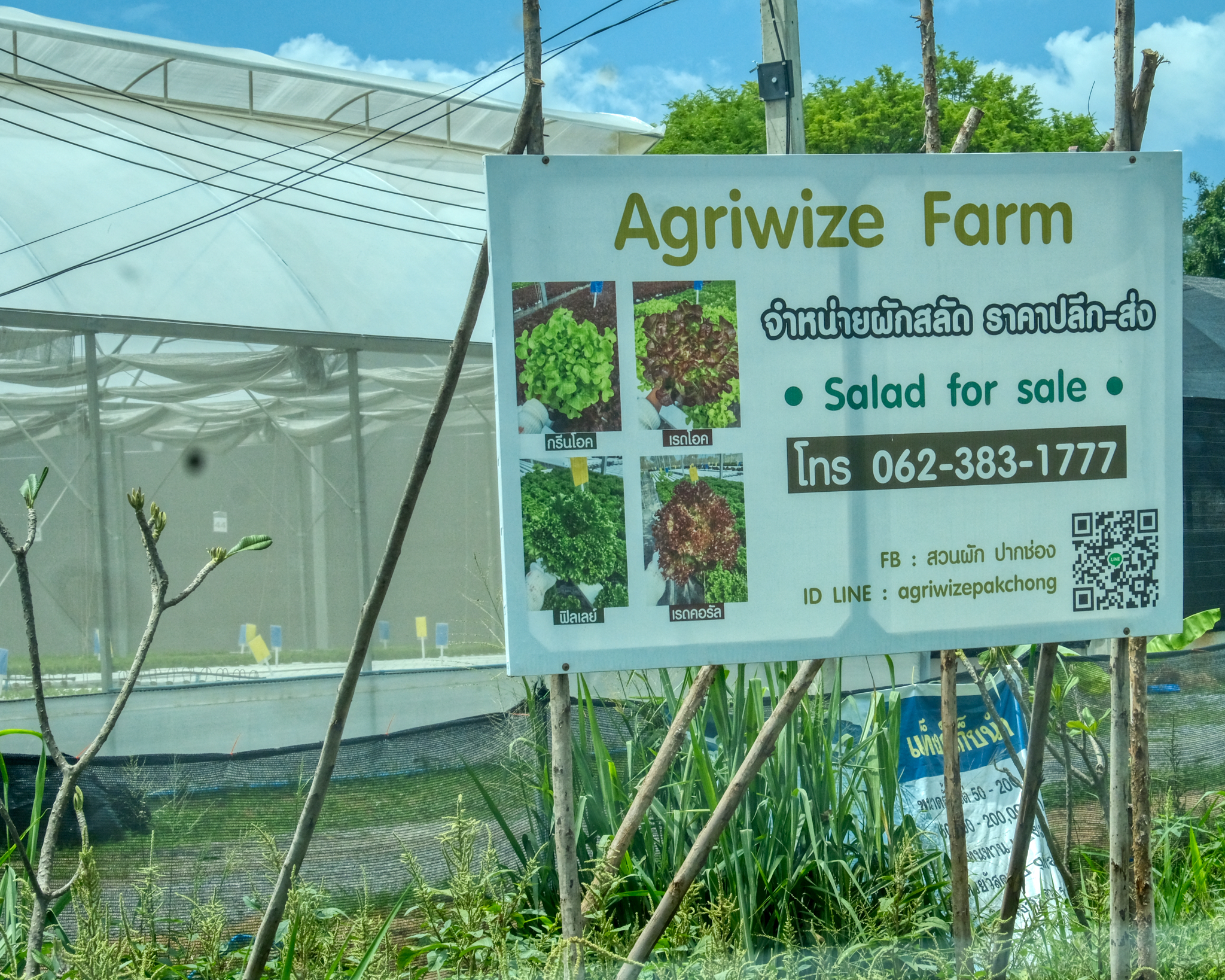 Being only 3 hours to a city of 13 million people, this kind of big agribusiness was to be expected.
Being only 3 hours to a city of 13 million people, this kind of big agribusiness was to be expected.
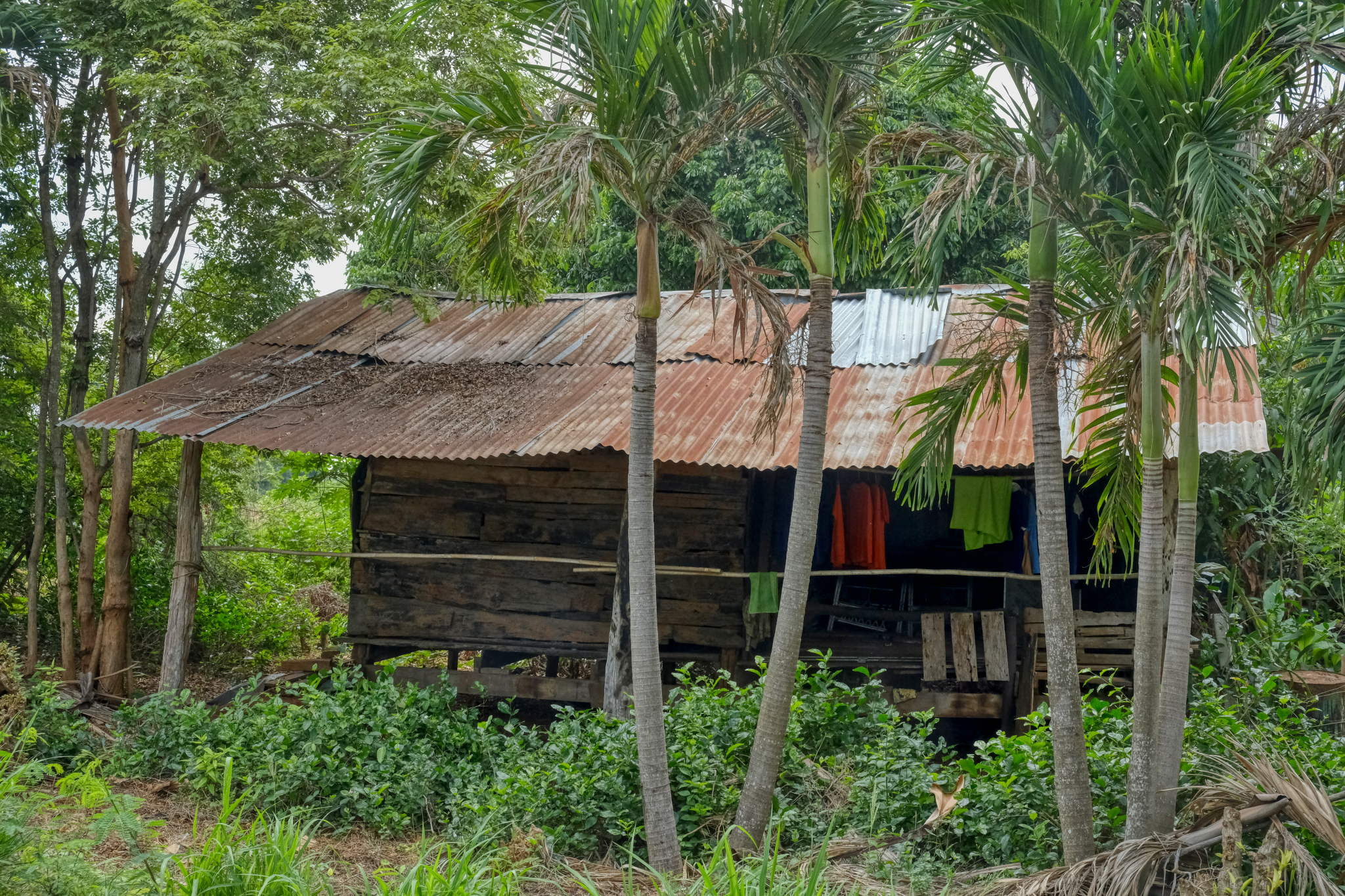 This old teakwood shack was occupied . . . rural splendor?
This old teakwood shack was occupied . . . rural splendor?
-----------------------------------------------------------------------------------------------------------------
WAT PA PHROM PRATHAN
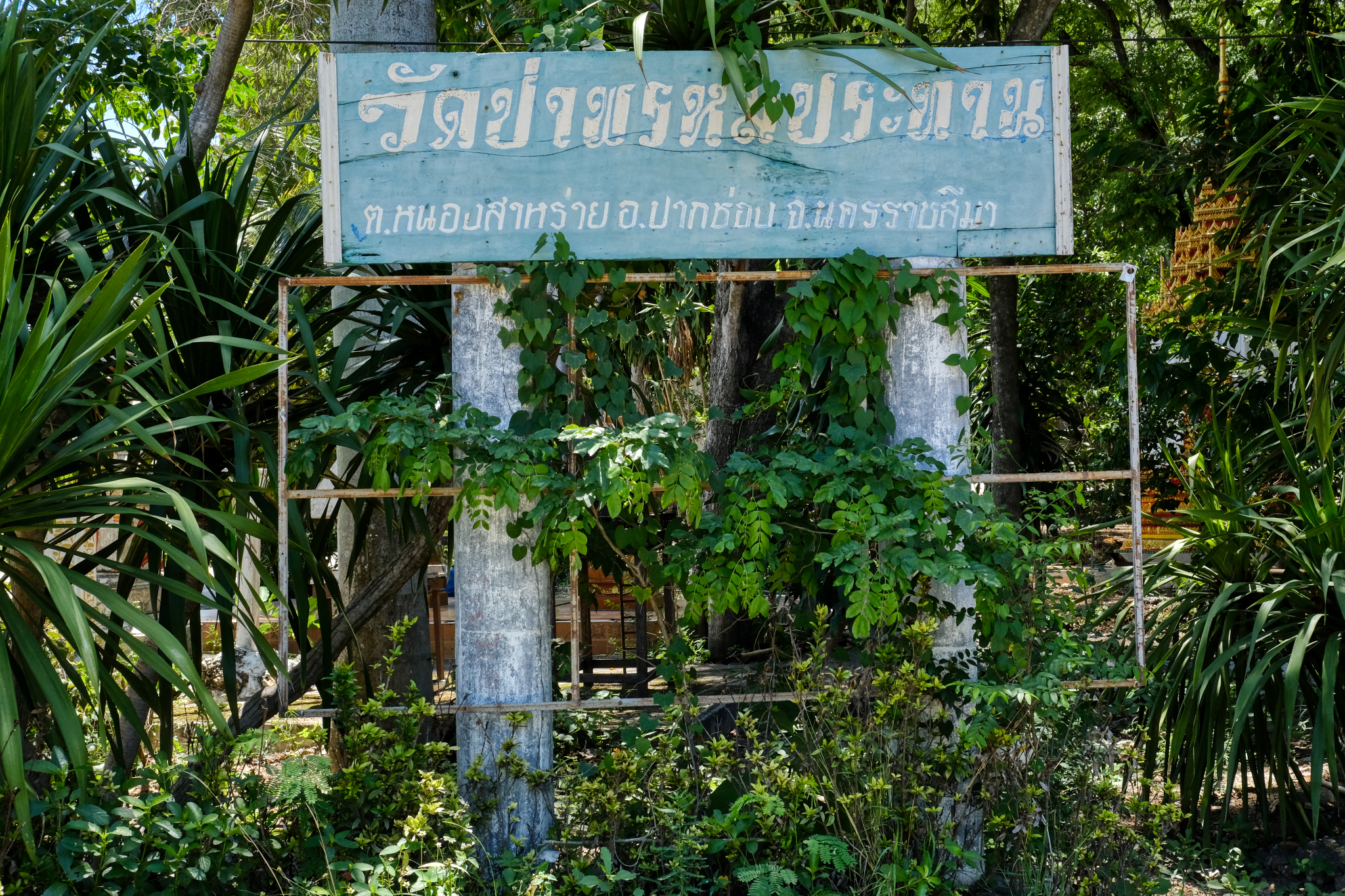 This small sign caught my eye . . . It must be a wat . . .
This small sign caught my eye . . . It must be a wat . . .
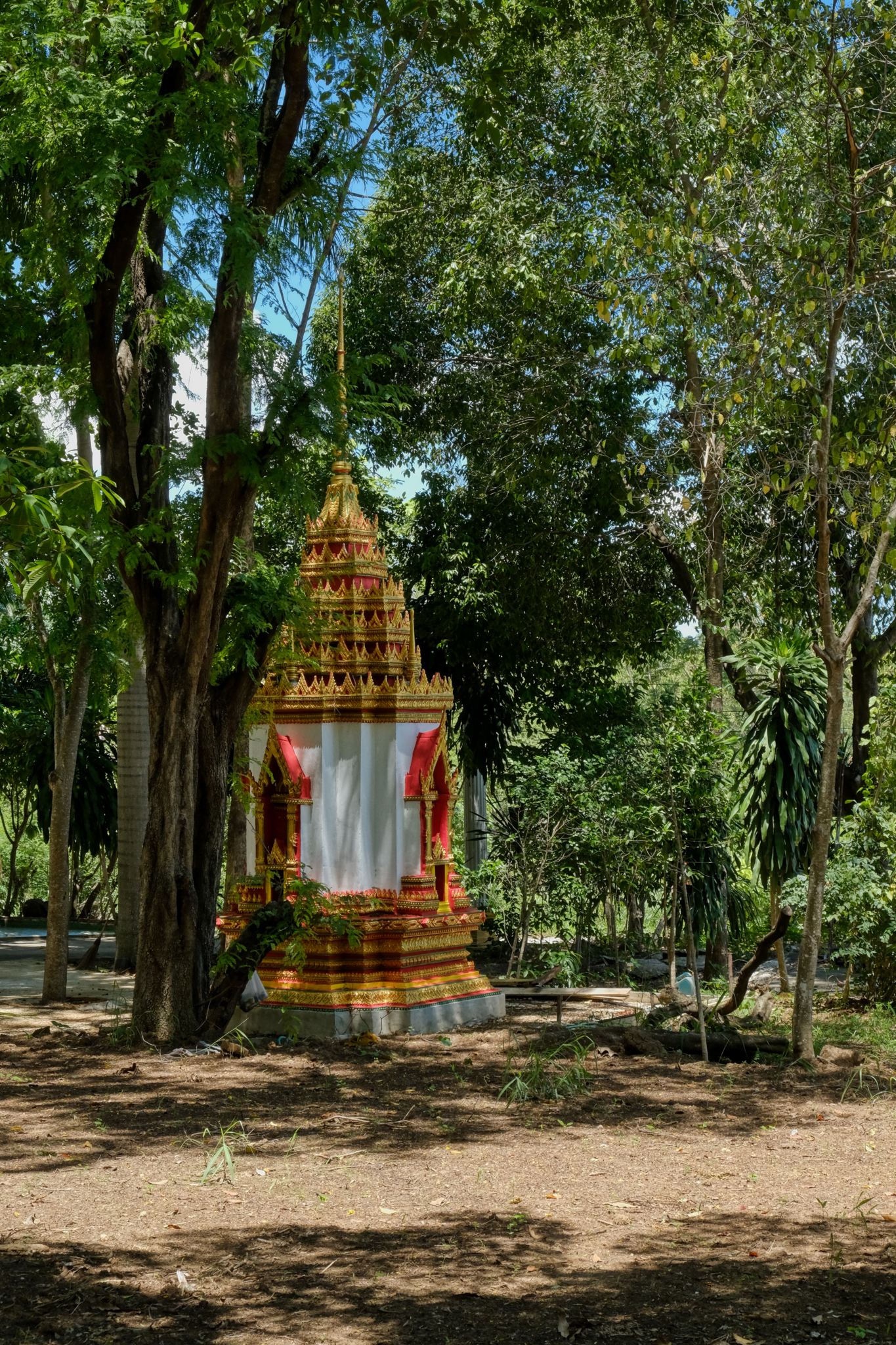 While driving into the wat grounds I did not notice anything unusual at first.
While driving into the wat grounds I did not notice anything unusual at first.
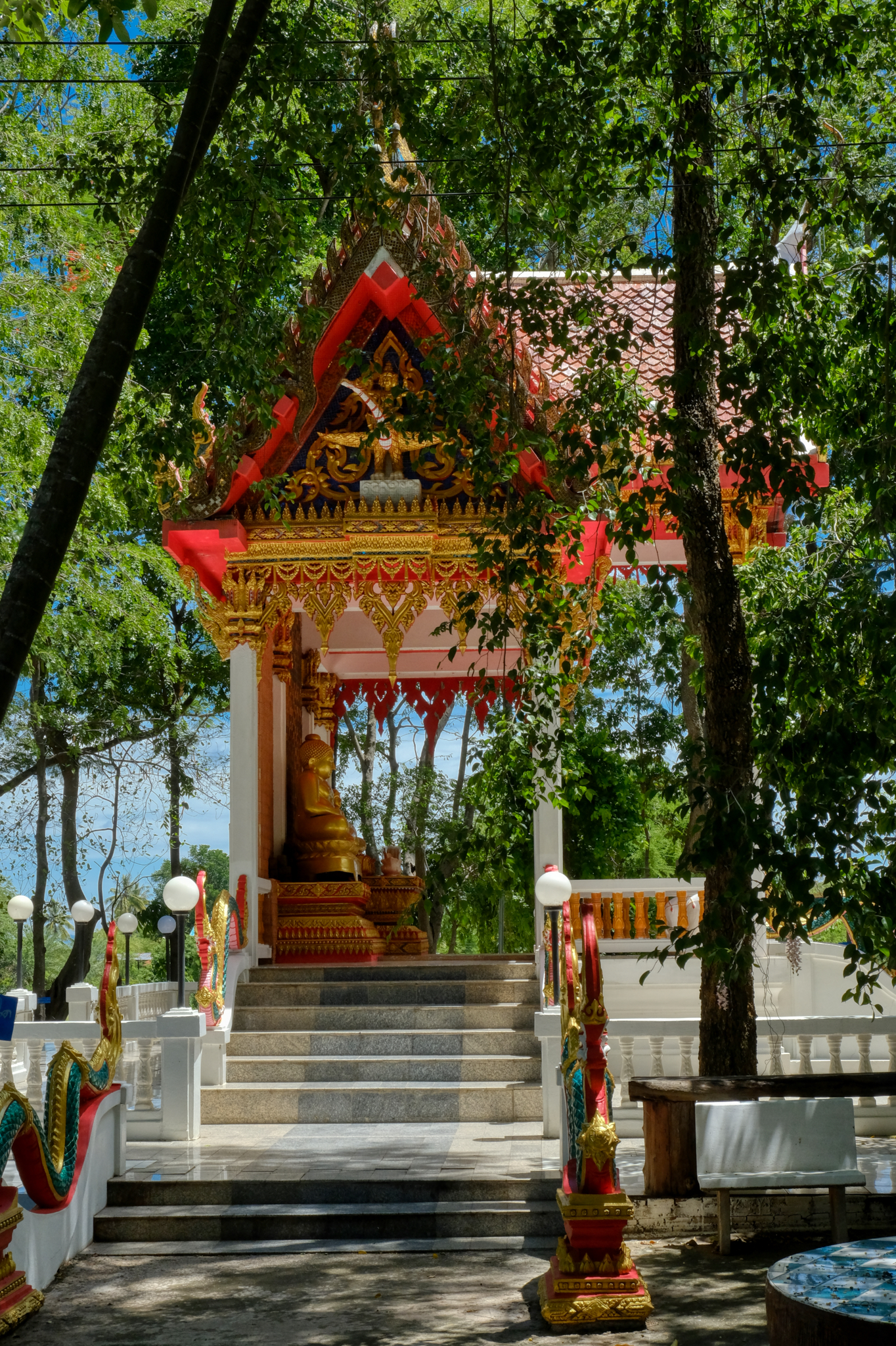 For such a deeply rural wat in a forested area, the salas and monuments seemed especially wonderful.
For such a deeply rural wat in a forested area, the salas and monuments seemed especially wonderful.
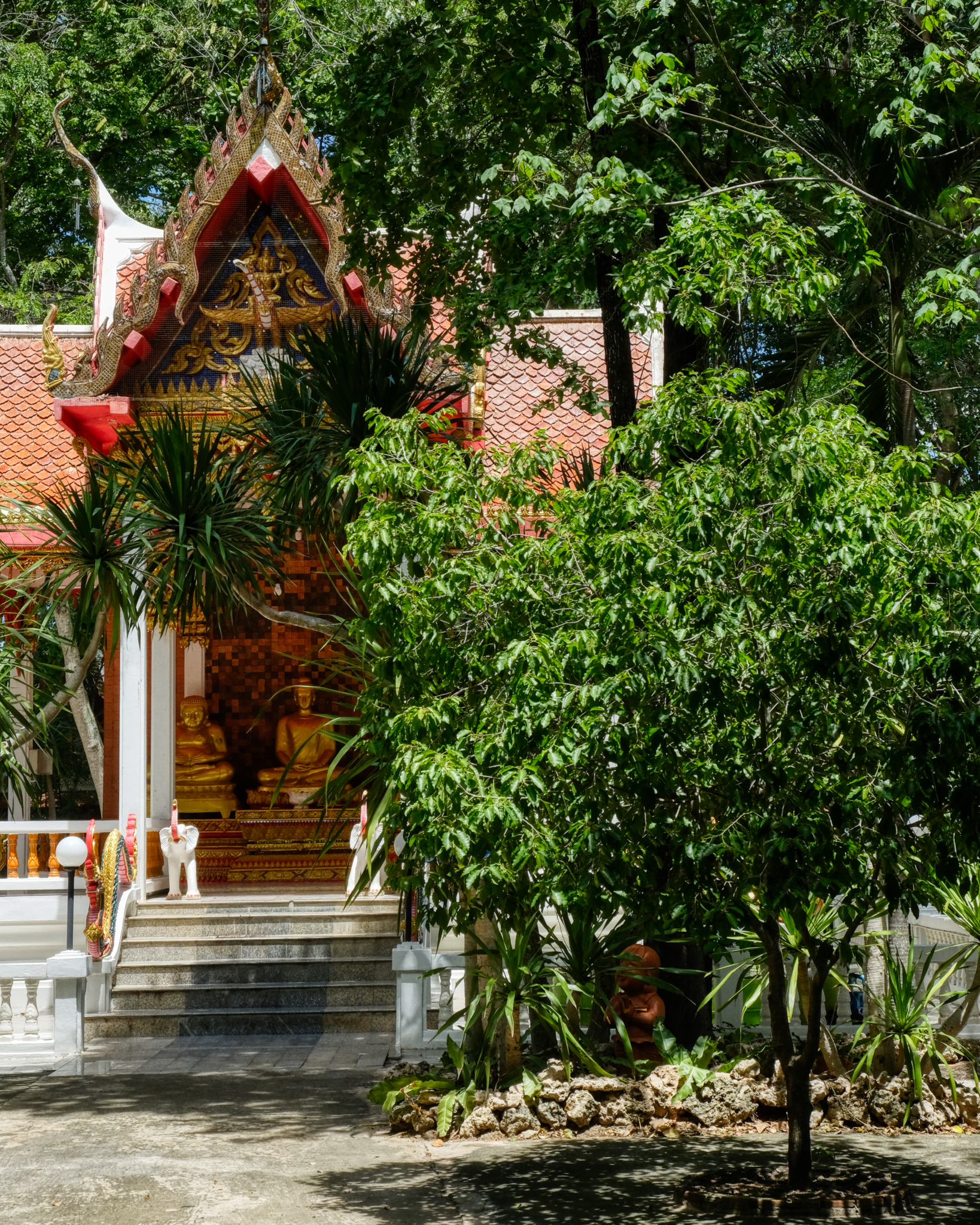 Such a wonderful Buddha sala . . .
Such a wonderful Buddha sala . . .
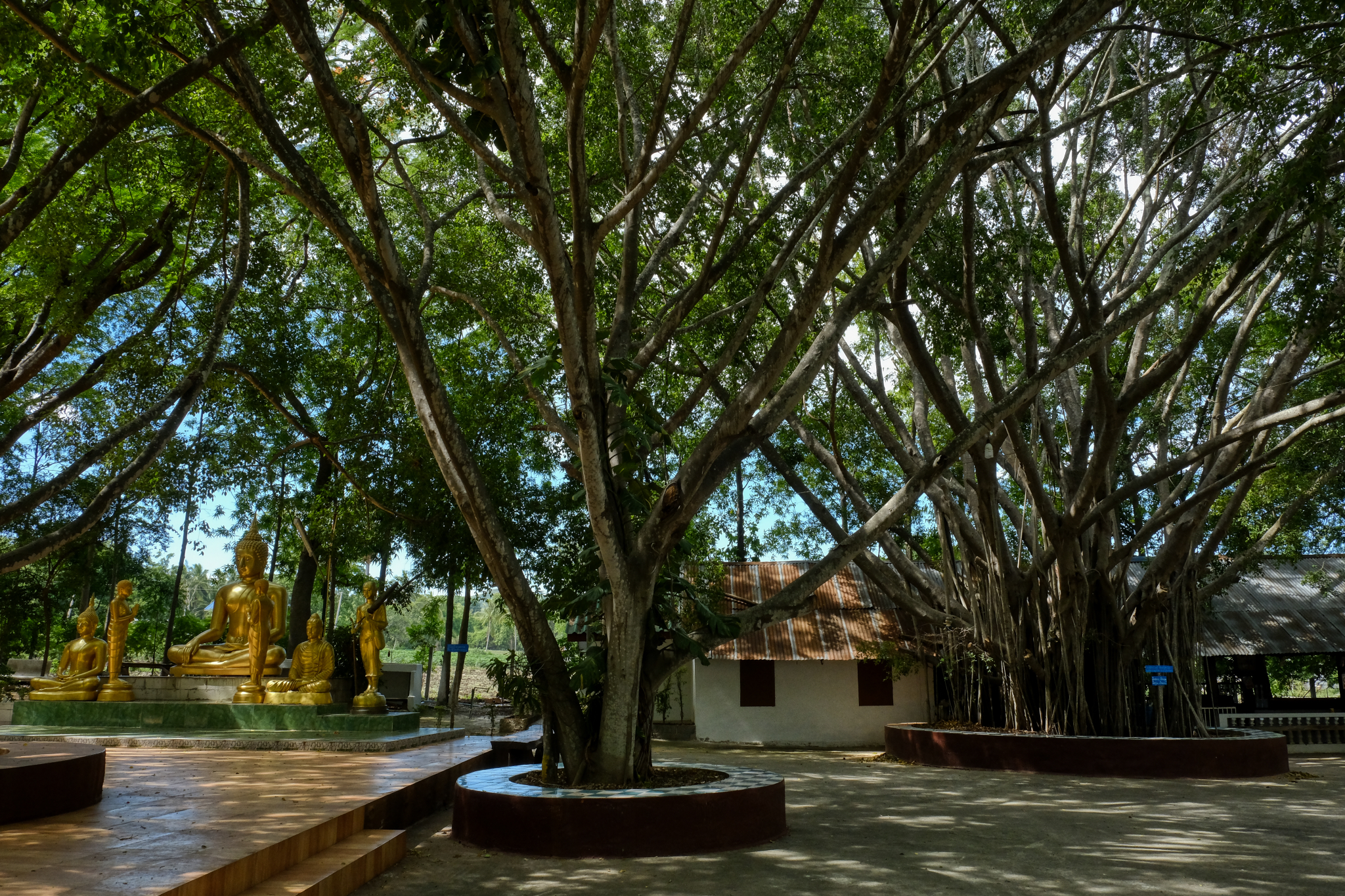 I found a place to park and as I stepped out of the car this is what I saw! Remarkable!
I found a place to park and as I stepped out of the car this is what I saw! Remarkable!
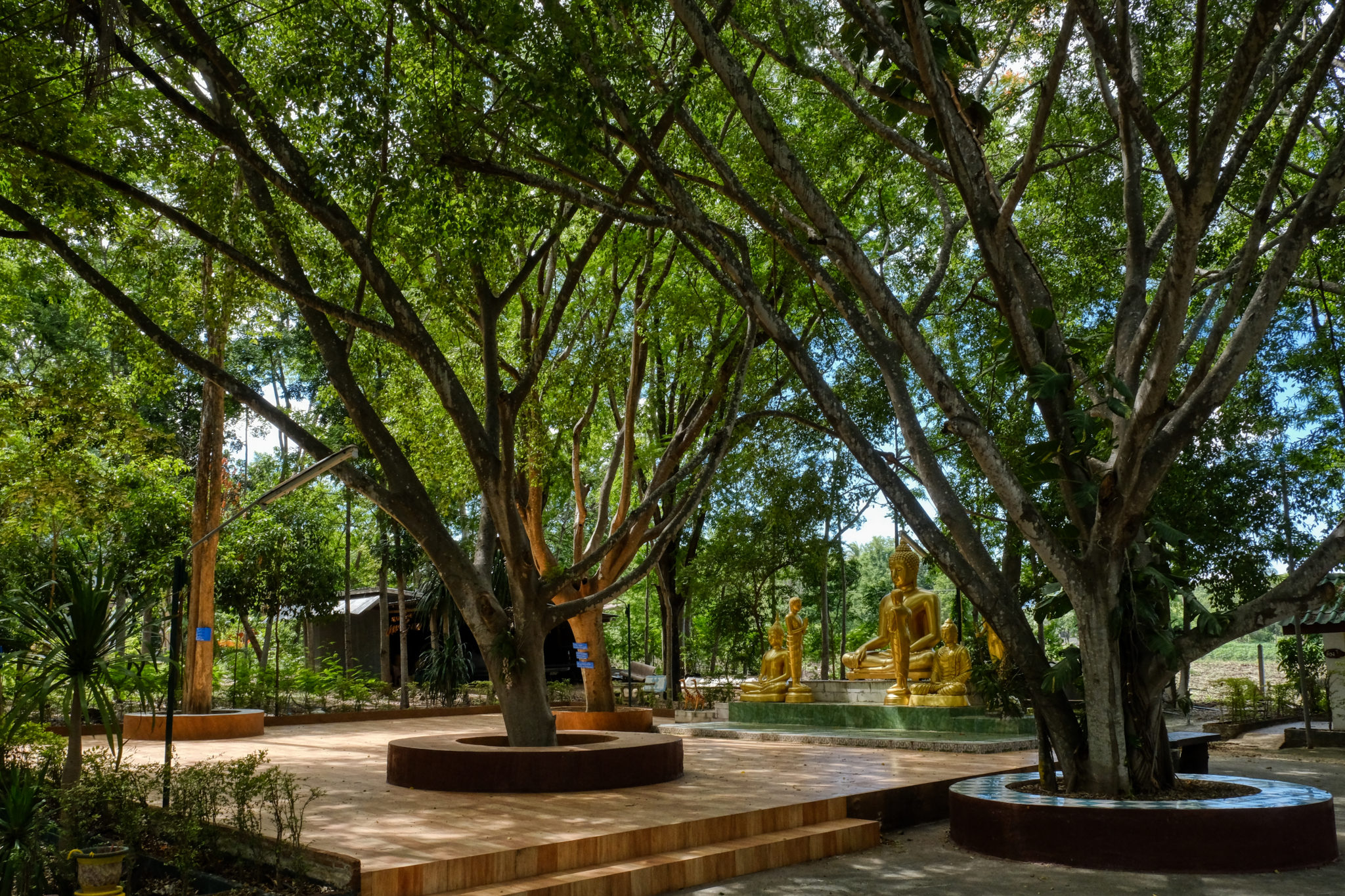 There was a powerful spiritual presence in this place.
There was a powerful spiritual presence in this place.
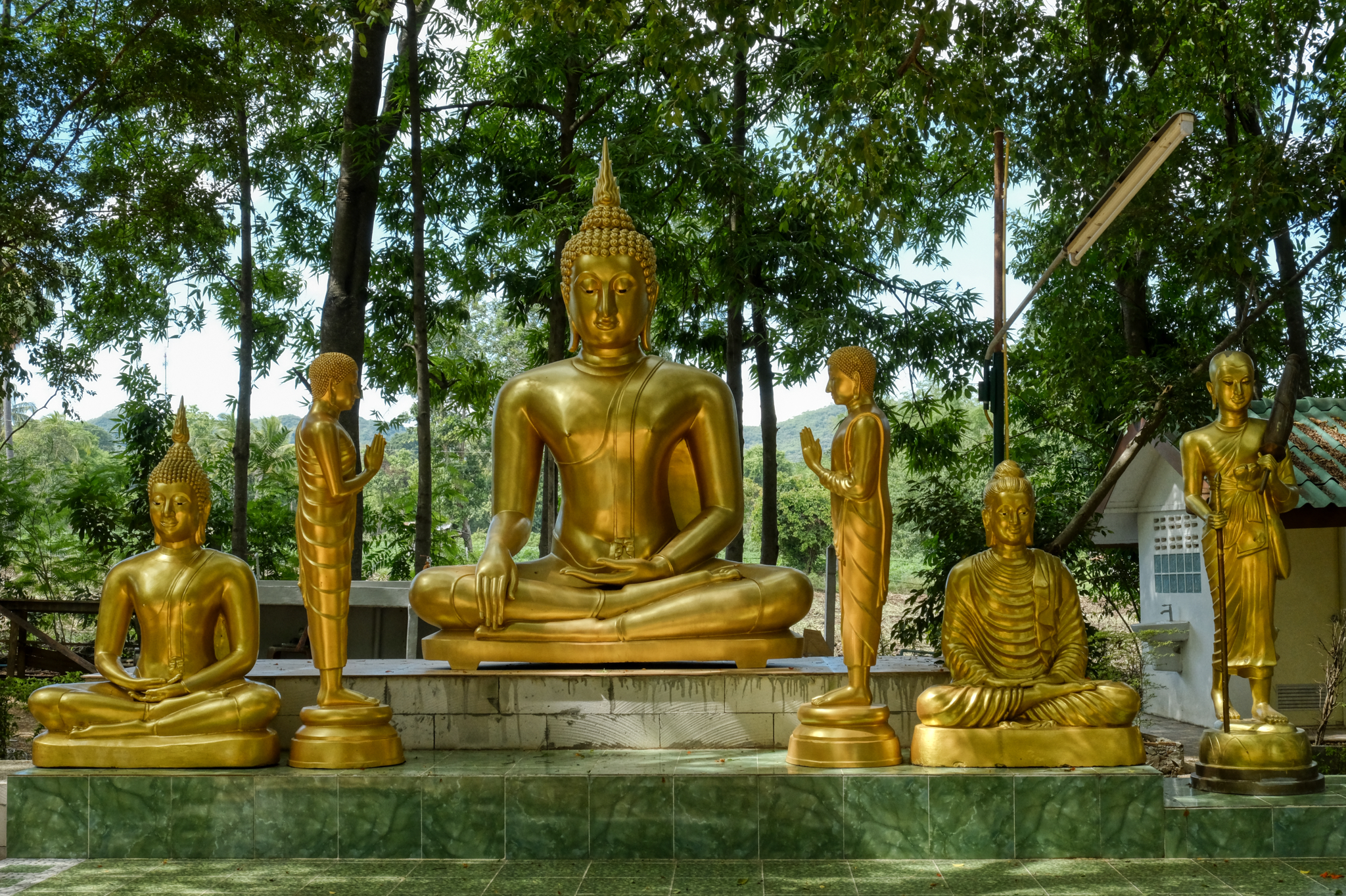 I sat here for quite awhile . . . and lost myself . . .
I sat here for quite awhile . . . and lost myself . . .
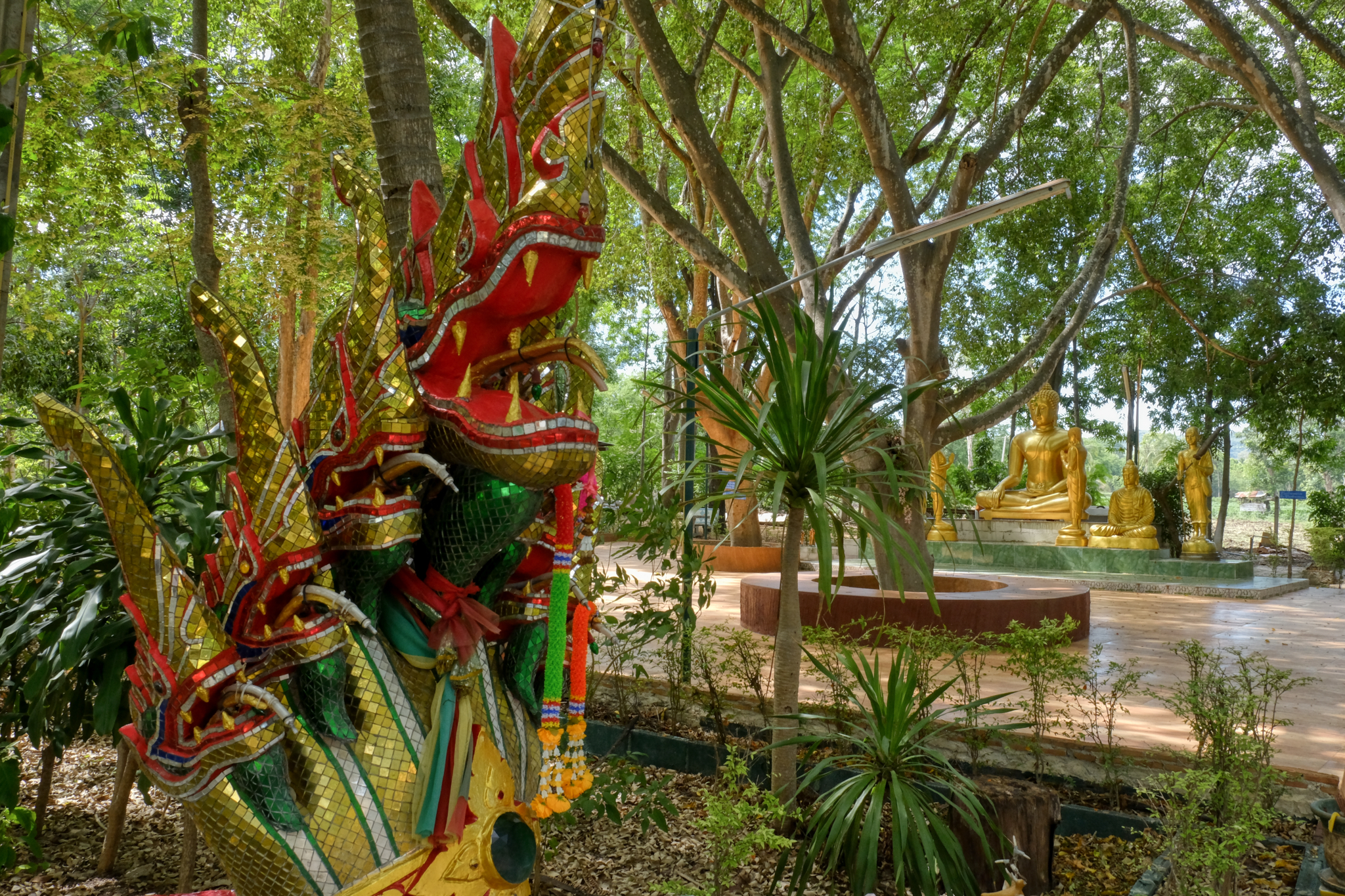 After sitting . . . I went for a walk to appreciate the spiritual environment I had fortunately found.
After sitting . . . I went for a walk to appreciate the spiritual environment I had fortunately found.
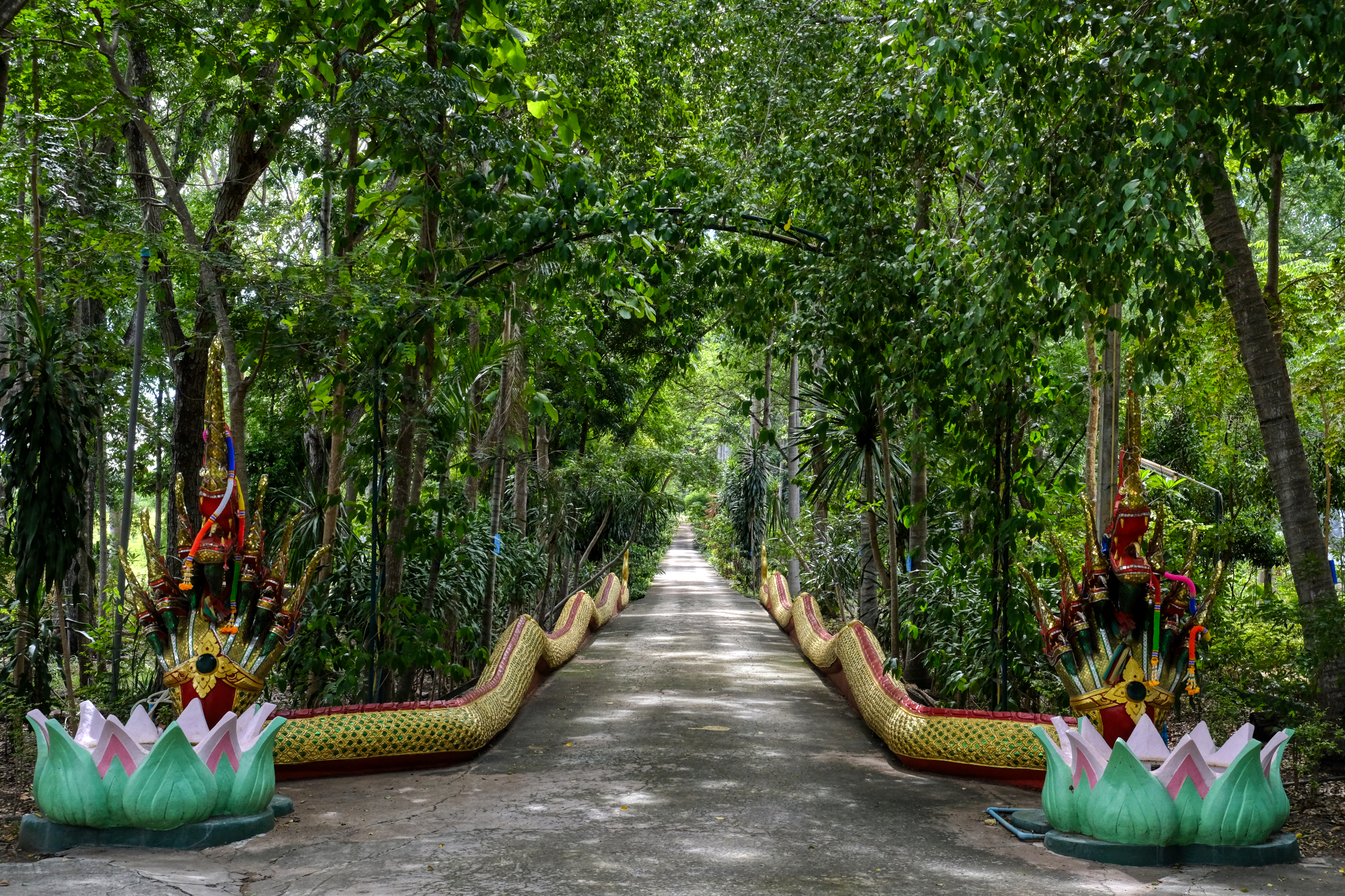 When I spotted this inviting road, I had to find out what was up there . . .
When I spotted this inviting road, I had to find out what was up there . . .
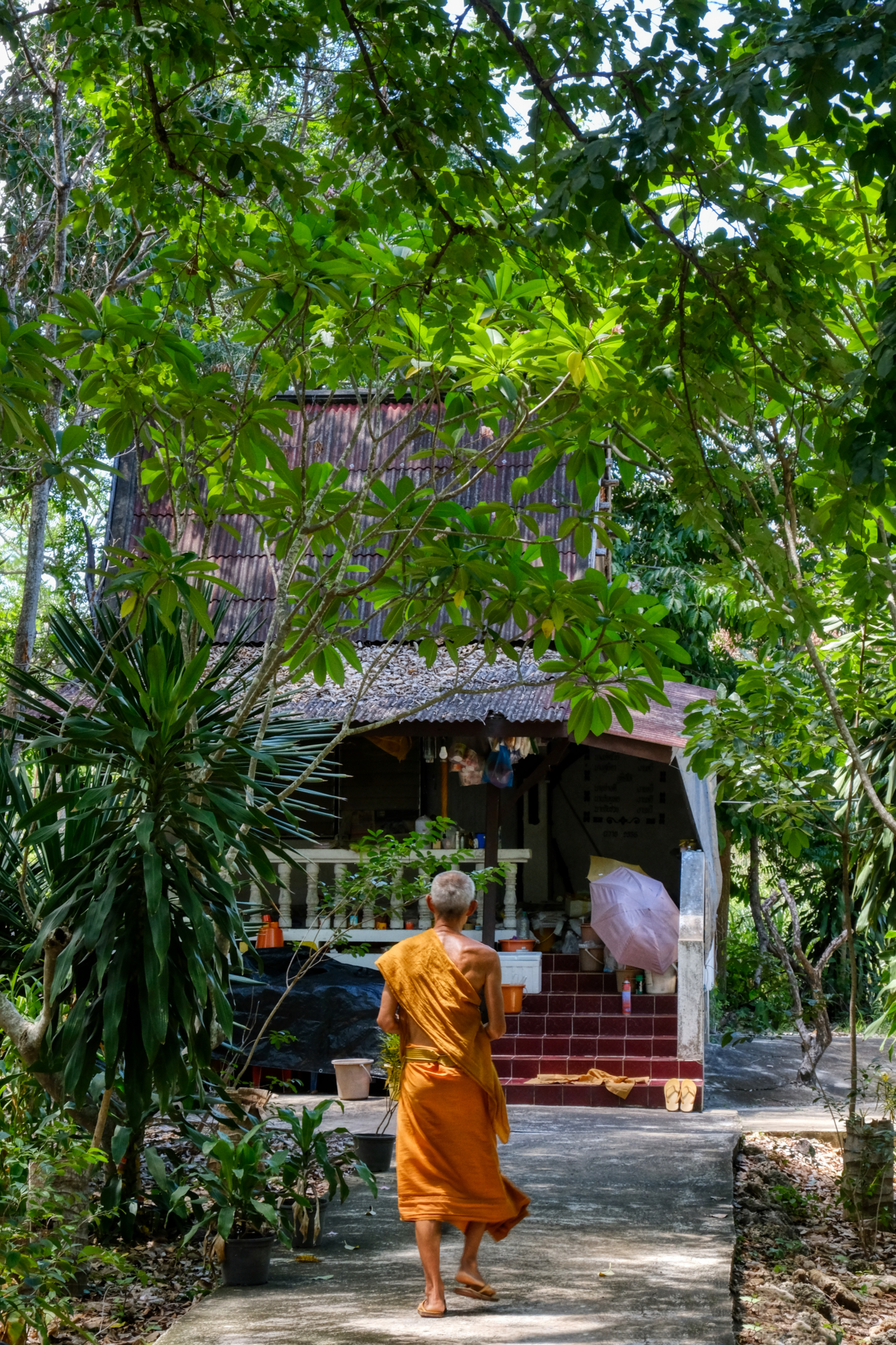 What I found at first were several very sweet monks' houses set in the trees.
What I found at first were several very sweet monks' houses set in the trees.
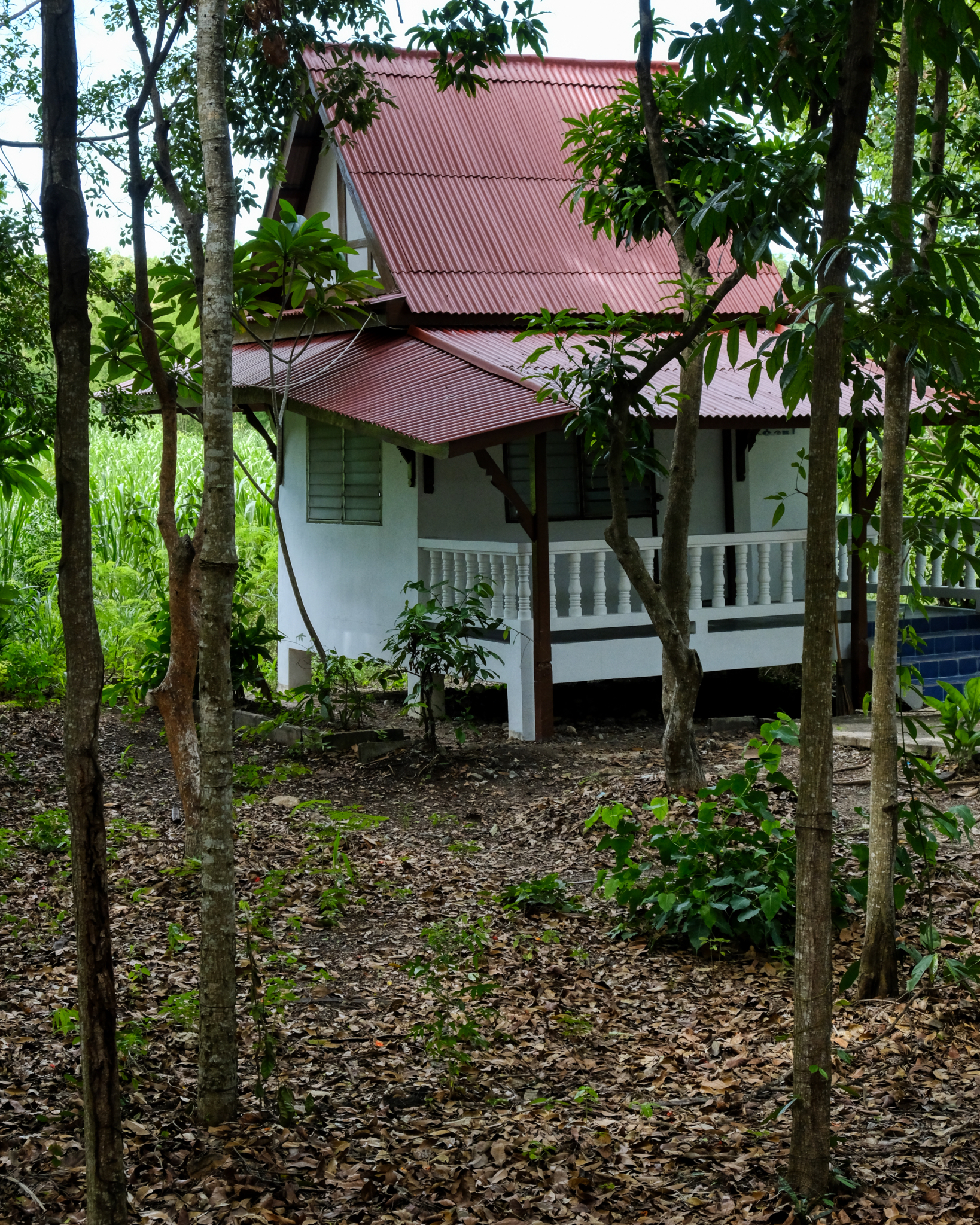 A simple, but attractive, monks quarters.
A simple, but attractive, monks quarters.
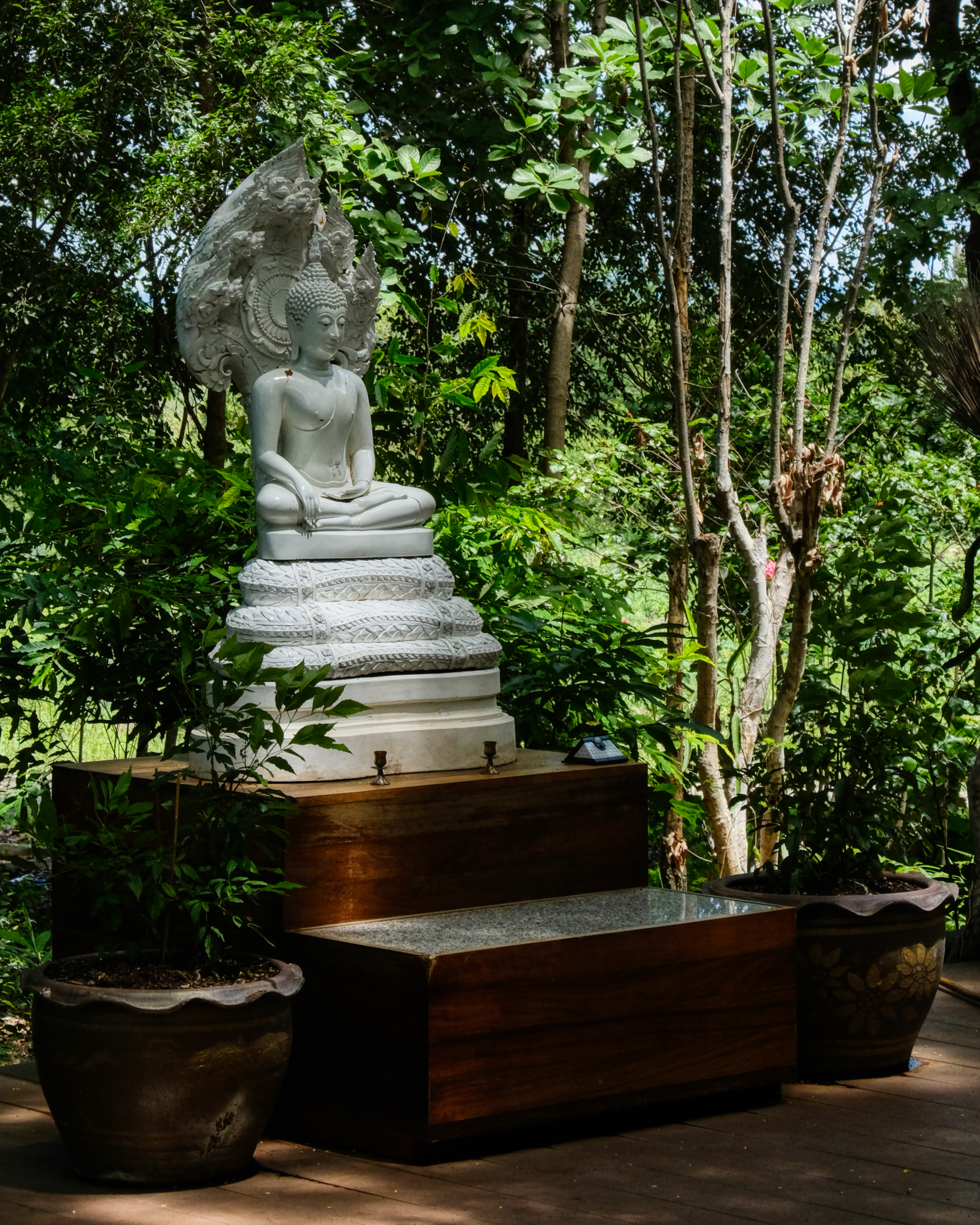 This remarkable Buddha was outside one of the modest monk's quarters.
This remarkable Buddha was outside one of the modest monk's quarters.
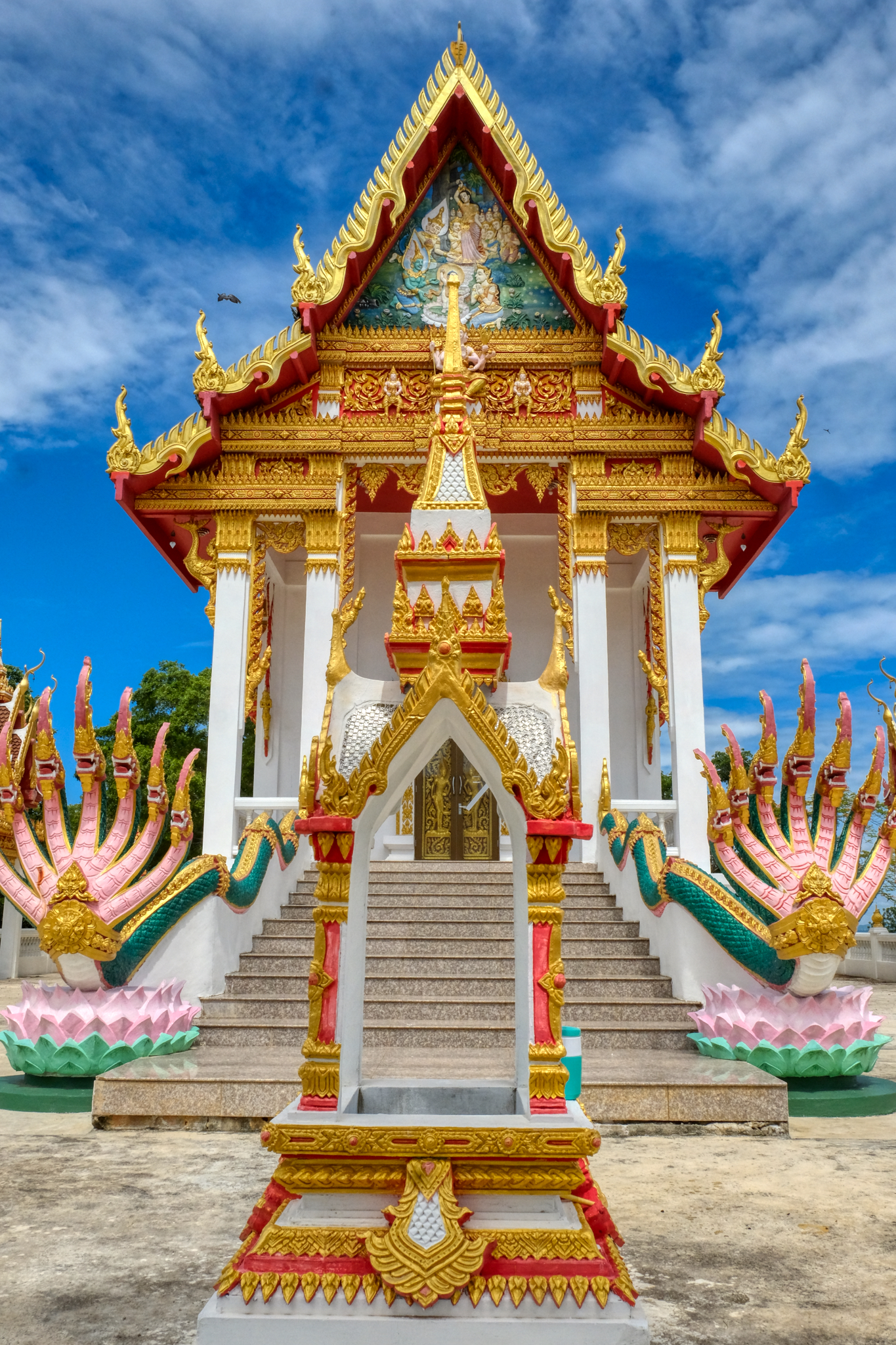 My long walk up the hill was rewarded with this view of a new wat building nearing completion. A brand new Thai Buddhist Temple, Wat PA Phrom Prathan.
My long walk up the hill was rewarded with this view of a new wat building nearing completion. A brand new Thai Buddhist Temple, Wat PA Phrom Prathan.
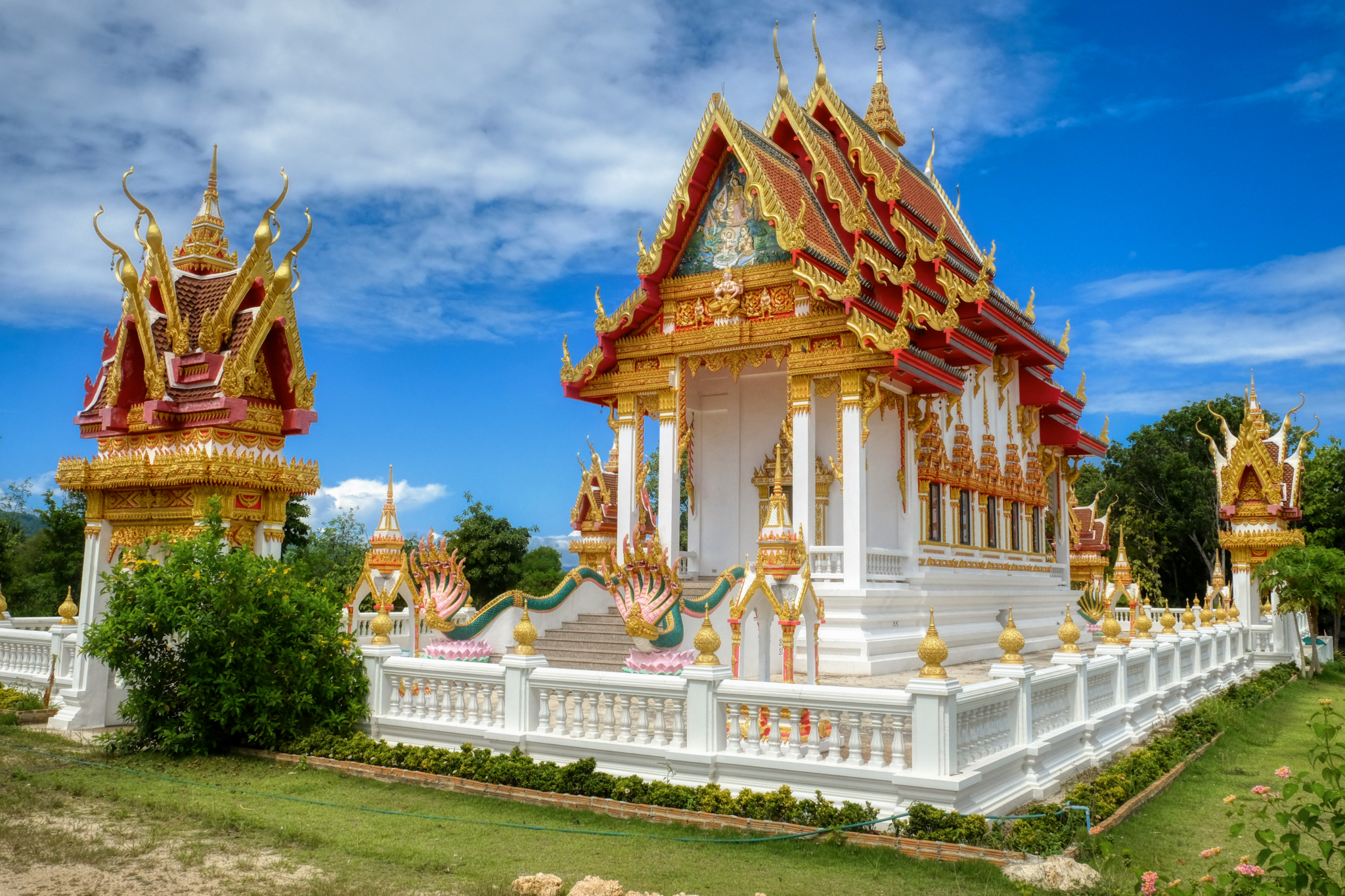 The new wat sat high on a hill over the valley. I walked around the site several times marveling at its fresh, pristine beauty.
The new wat sat high on a hill over the valley. I walked around the site several times marveling at its fresh, pristine beauty.
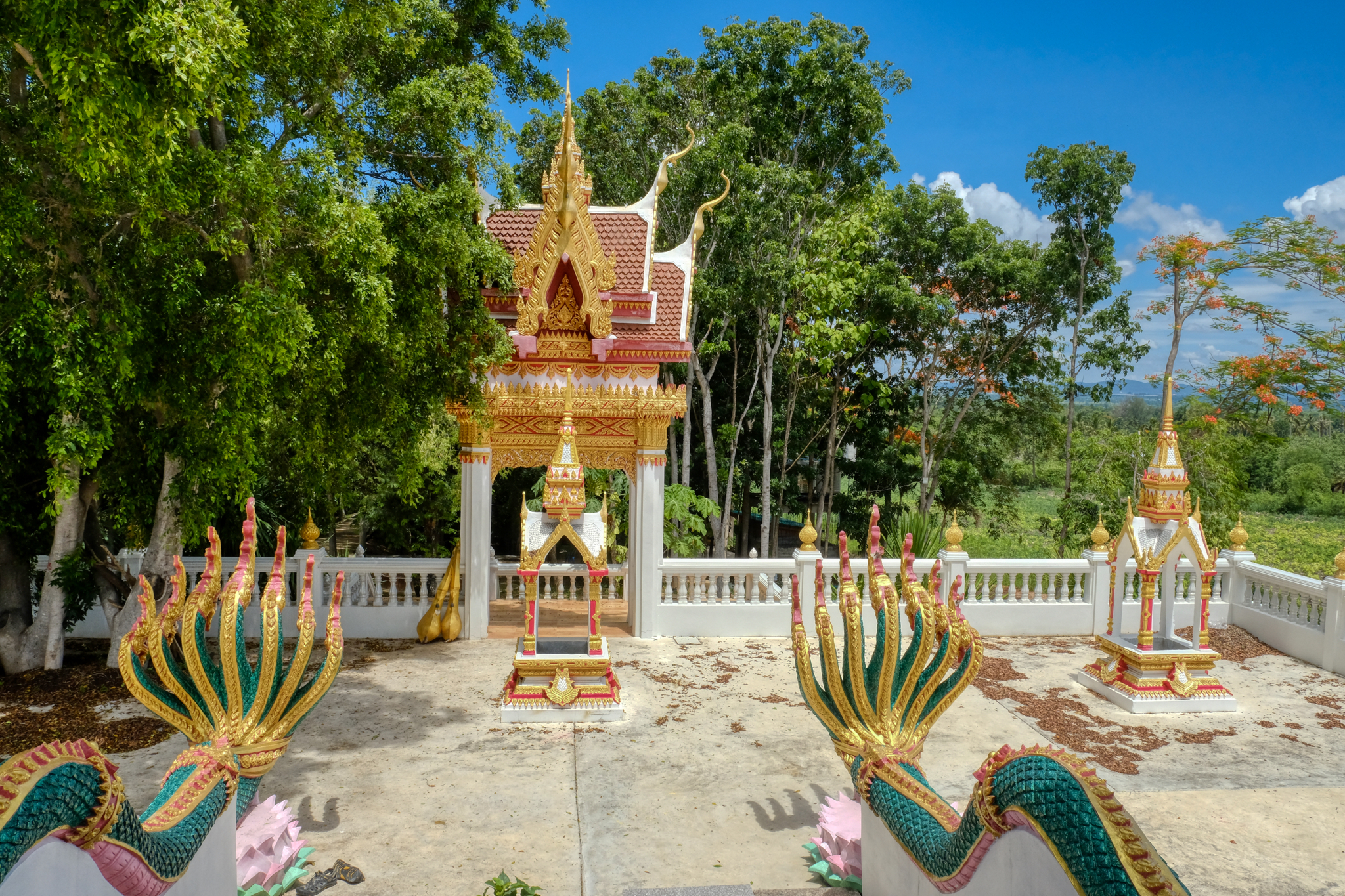 I noticed that the inner spaces of the wat were not swept or tiled . . . I knew this meant that they had not officially moved in . . . they were still working on it. The door was ajar, so I peaked in . . .
I noticed that the inner spaces of the wat were not swept or tiled . . . I knew this meant that they had not officially moved in . . . they were still working on it. The door was ajar, so I peaked in . . .
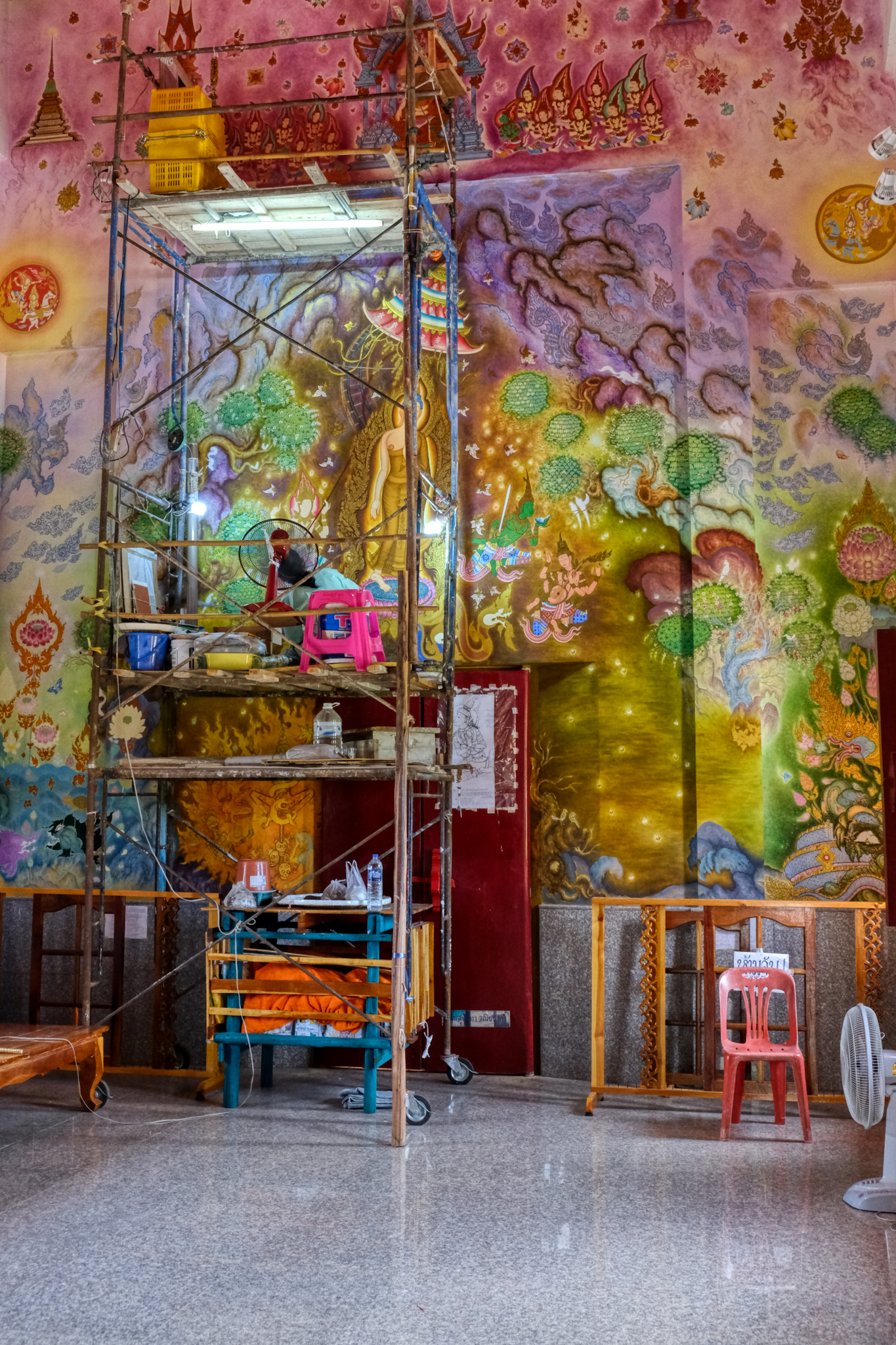 And this is what I saw when I opened the door . . . an artist on scaffolding painting an amazing mural on the far wall. WOW!
And this is what I saw when I opened the door . . . an artist on scaffolding painting an amazing mural on the far wall. WOW!
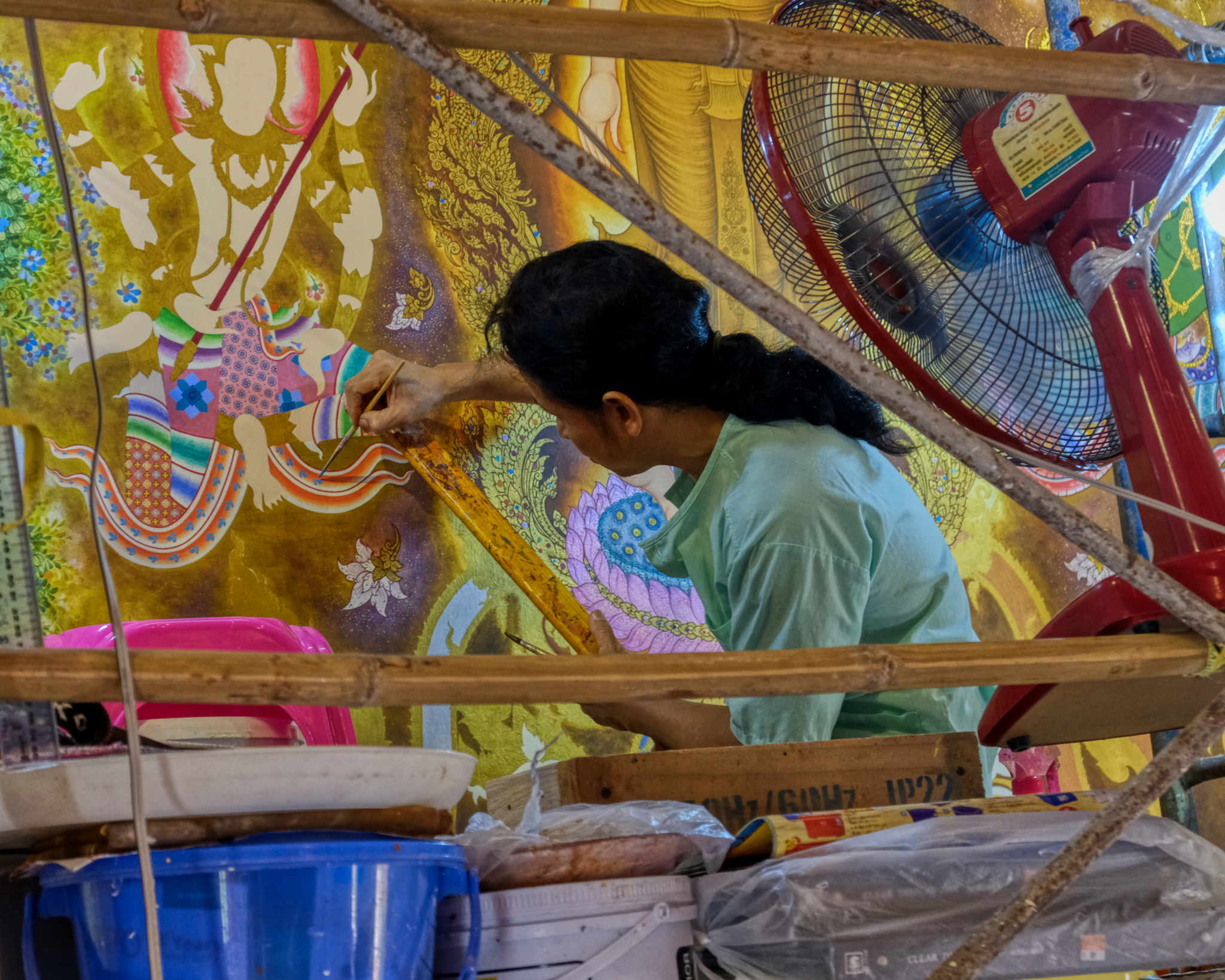 The artist at work.
The artist at work.
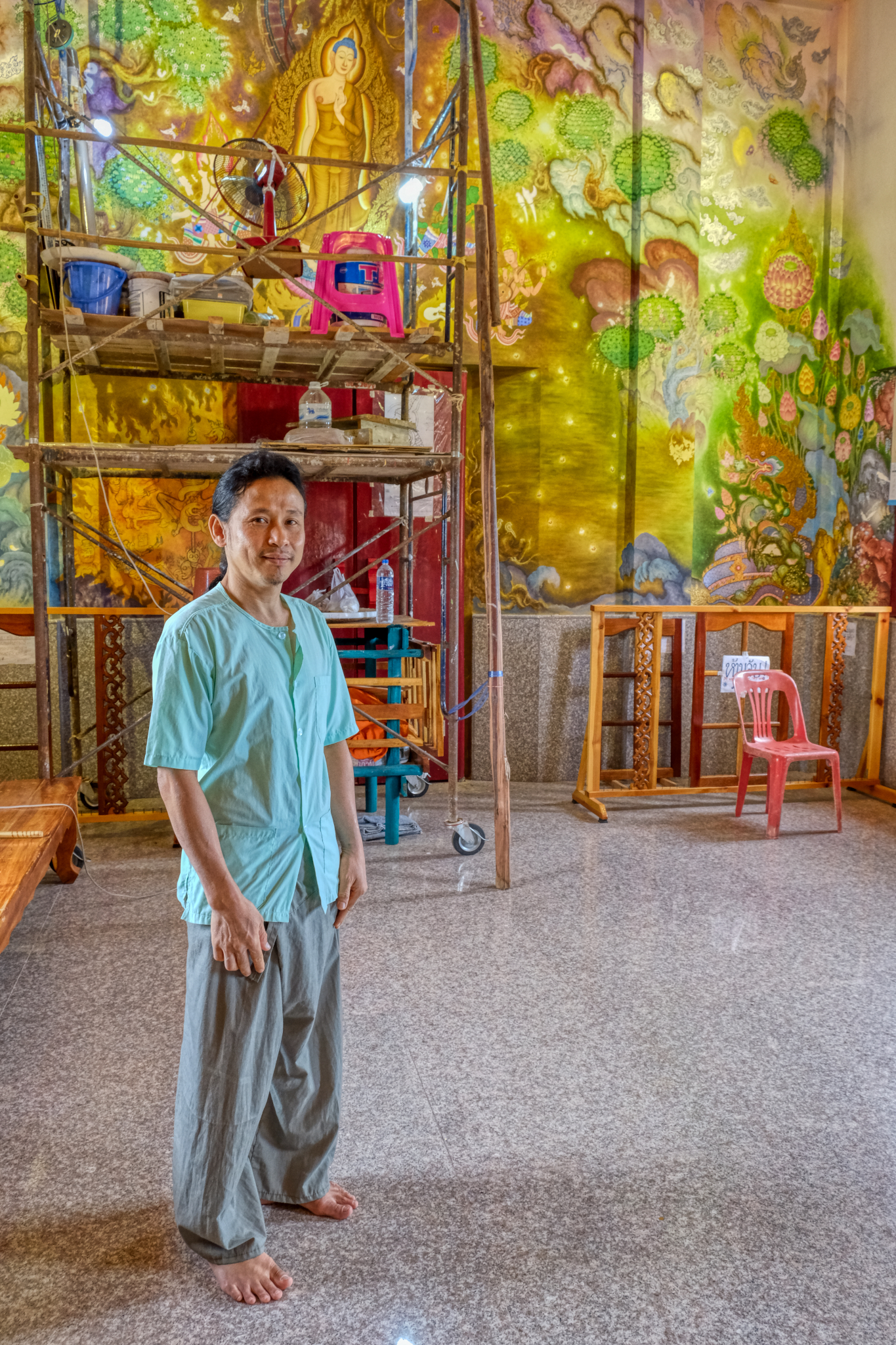 The artist came down off the scaffolding to offer me some water. I declined as I had my own. We chatted for a while. He said he had been working on that wall for three years already and that there were two or three more years left to finish the rest of the interior.
The artist came down off the scaffolding to offer me some water. I declined as I had my own. We chatted for a while. He said he had been working on that wall for three years already and that there were two or three more years left to finish the rest of the interior.
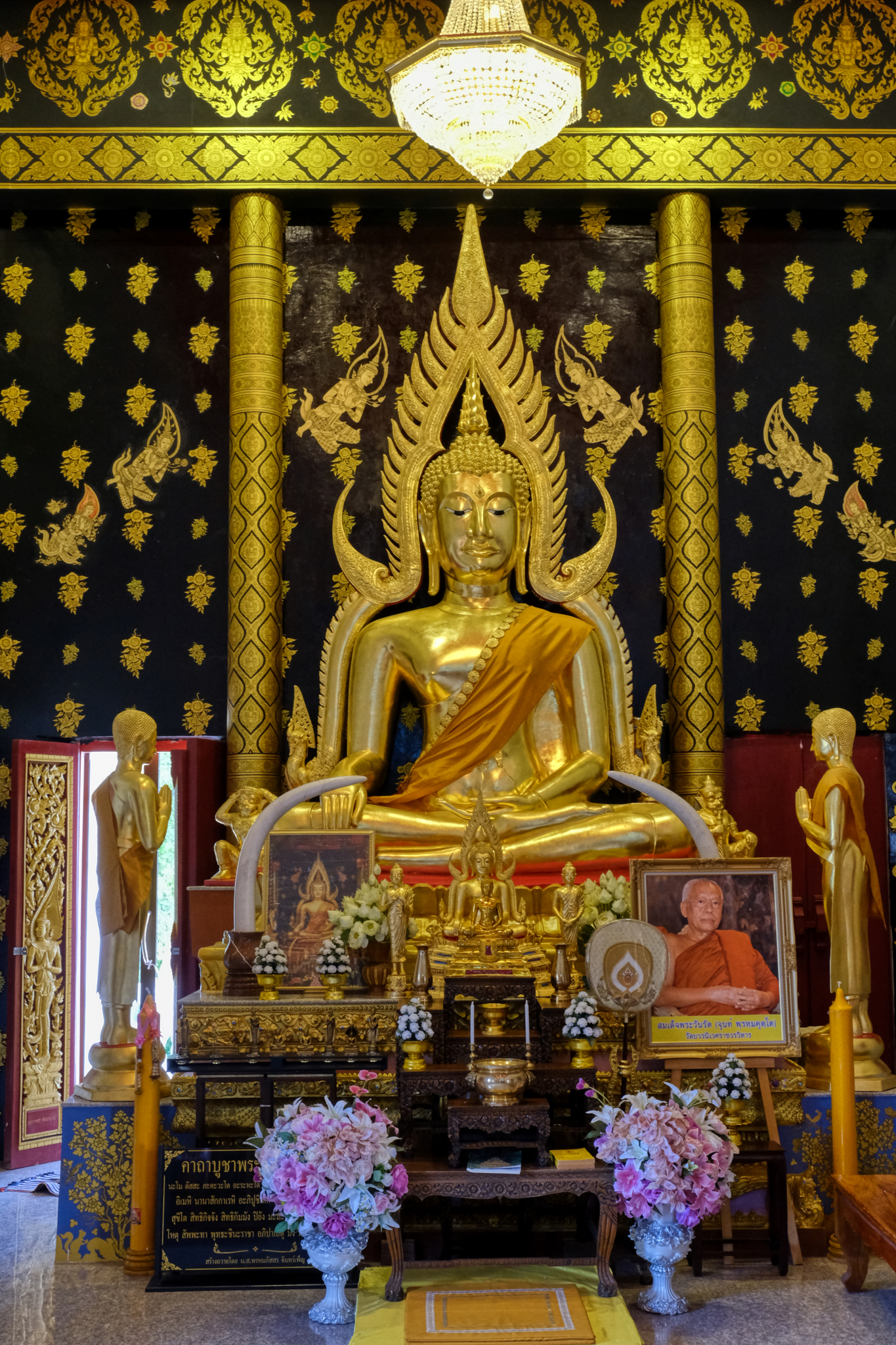 This altar faced the wall he was currently painting. He said that this wall only took six months to paint.
This altar faced the wall he was currently painting. He said that this wall only took six months to paint.
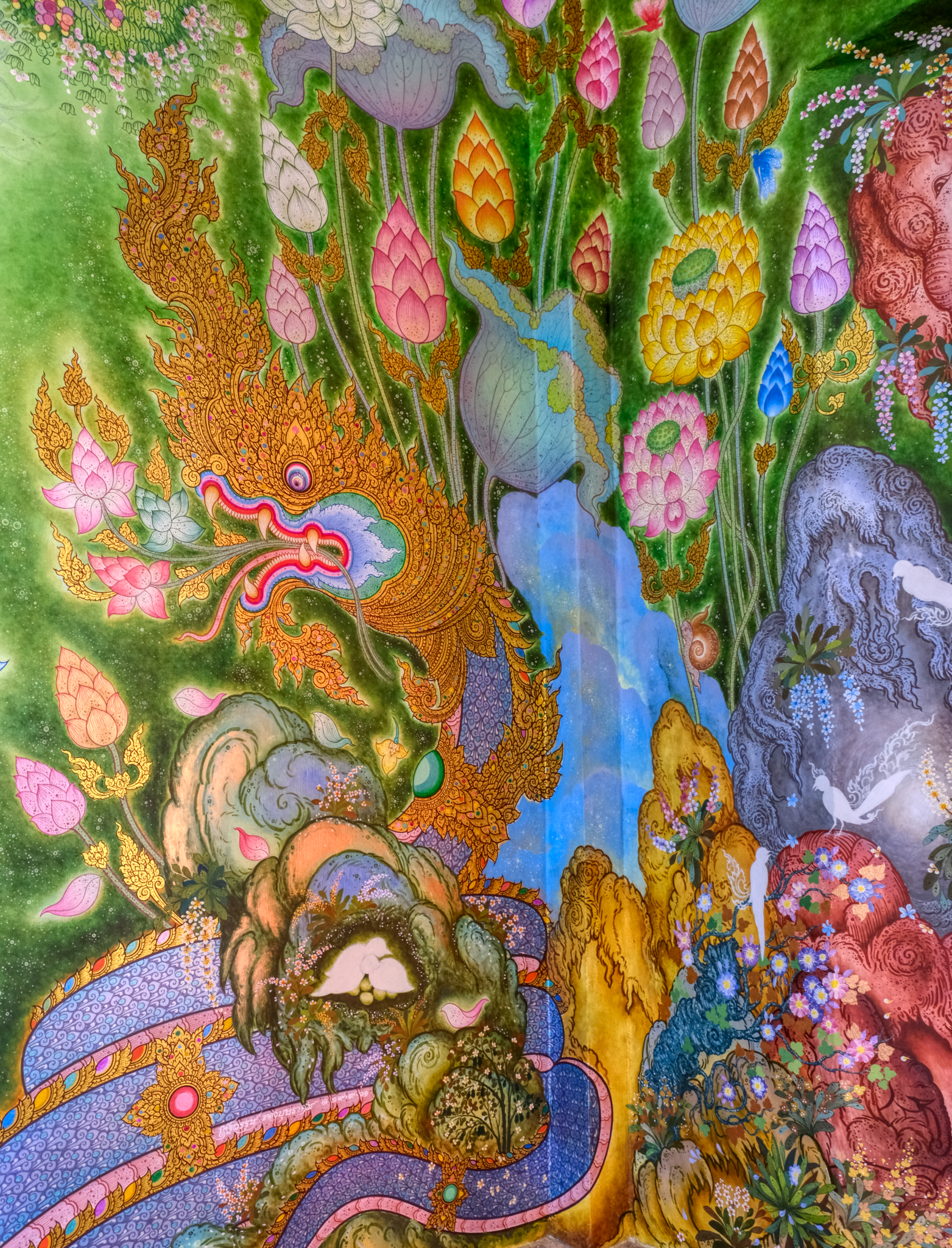 The artist's work and workmanship were masterful.
The artist's work and workmanship were masterful.
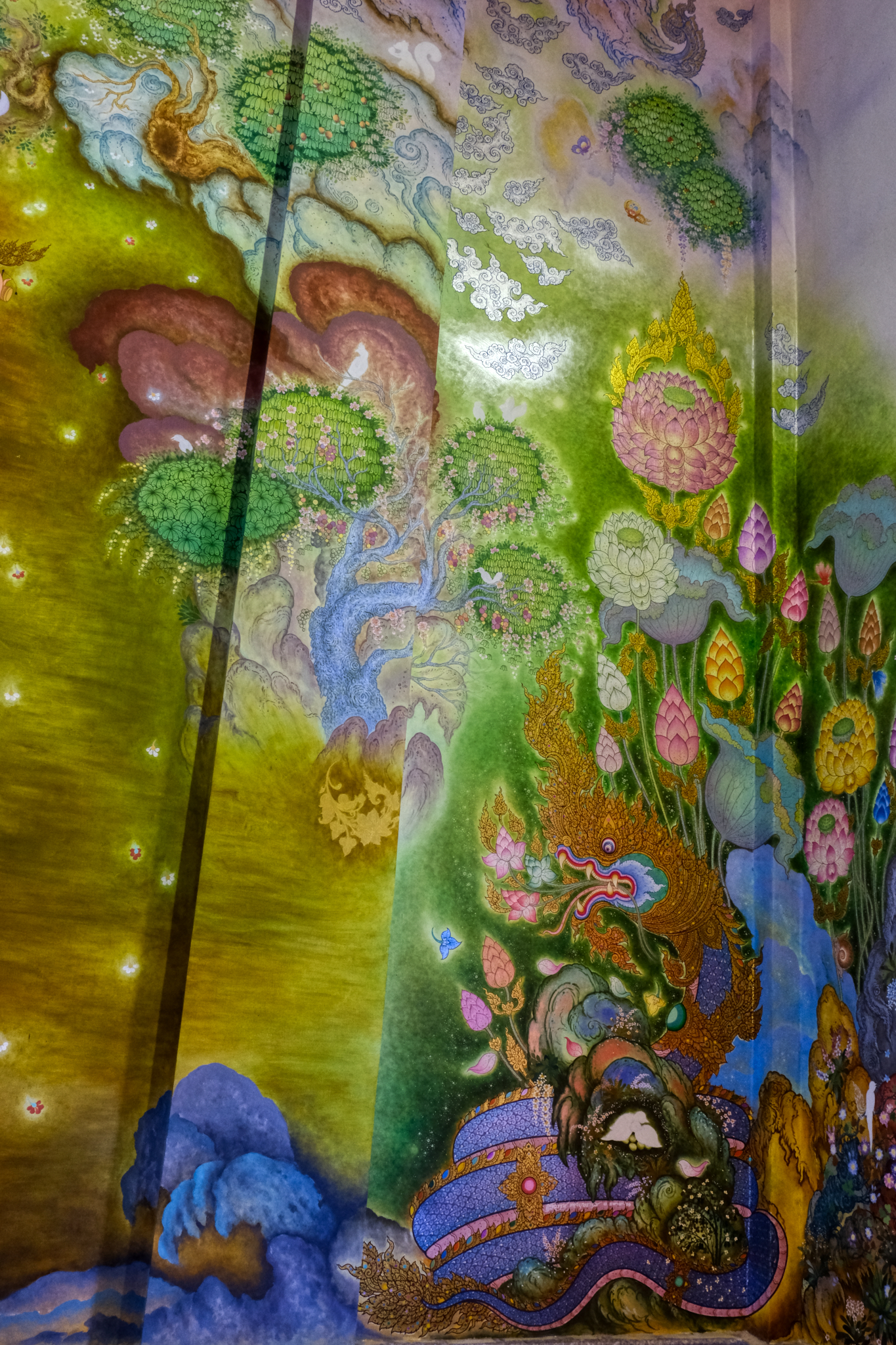 The huge mural depicted Buddhist and Thai iconography, as well as scenes from the life of the Buddha Gotama.
The huge mural depicted Buddhist and Thai iconography, as well as scenes from the life of the Buddha Gotama.
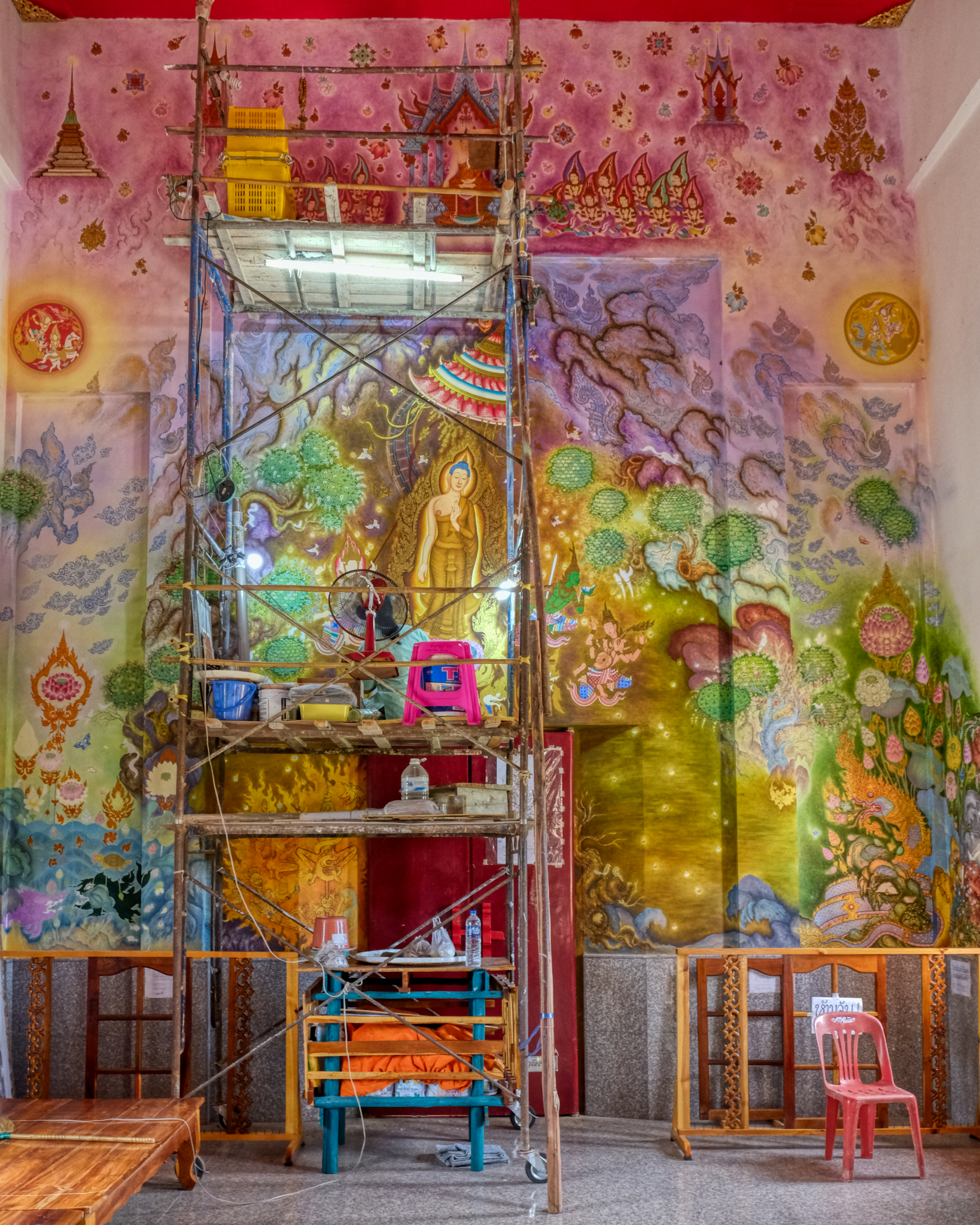 After we spoke he climbed back up to his platform and resumed painting. I sat watching him paint for quite awhile.
After we spoke he climbed back up to his platform and resumed painting. I sat watching him paint for quite awhile.
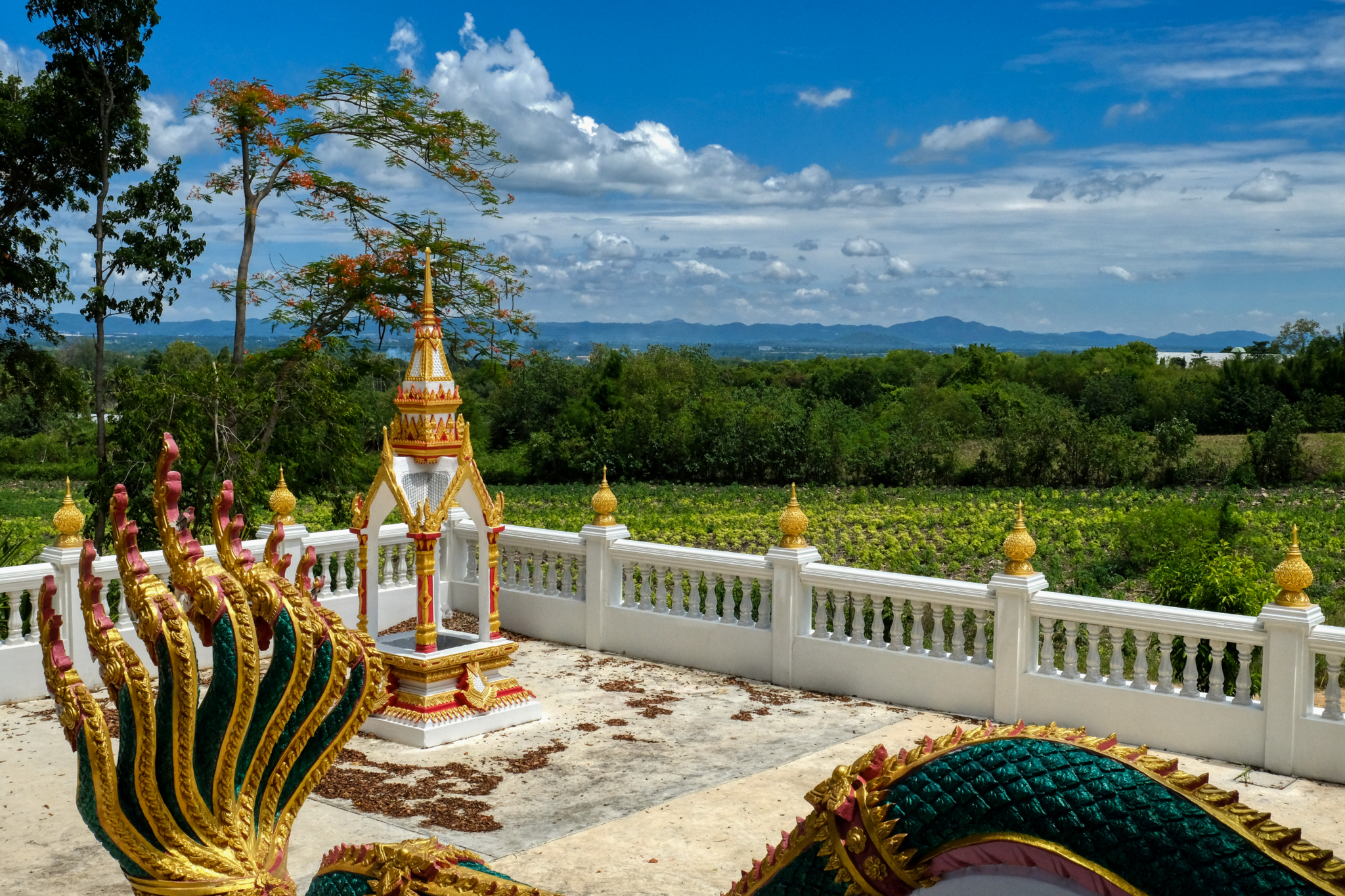 Standing outside the new wat enjoying the hilltop view out over the agricultural landscape of Khao Yai.
Standing outside the new wat enjoying the hilltop view out over the agricultural landscape of Khao Yai.
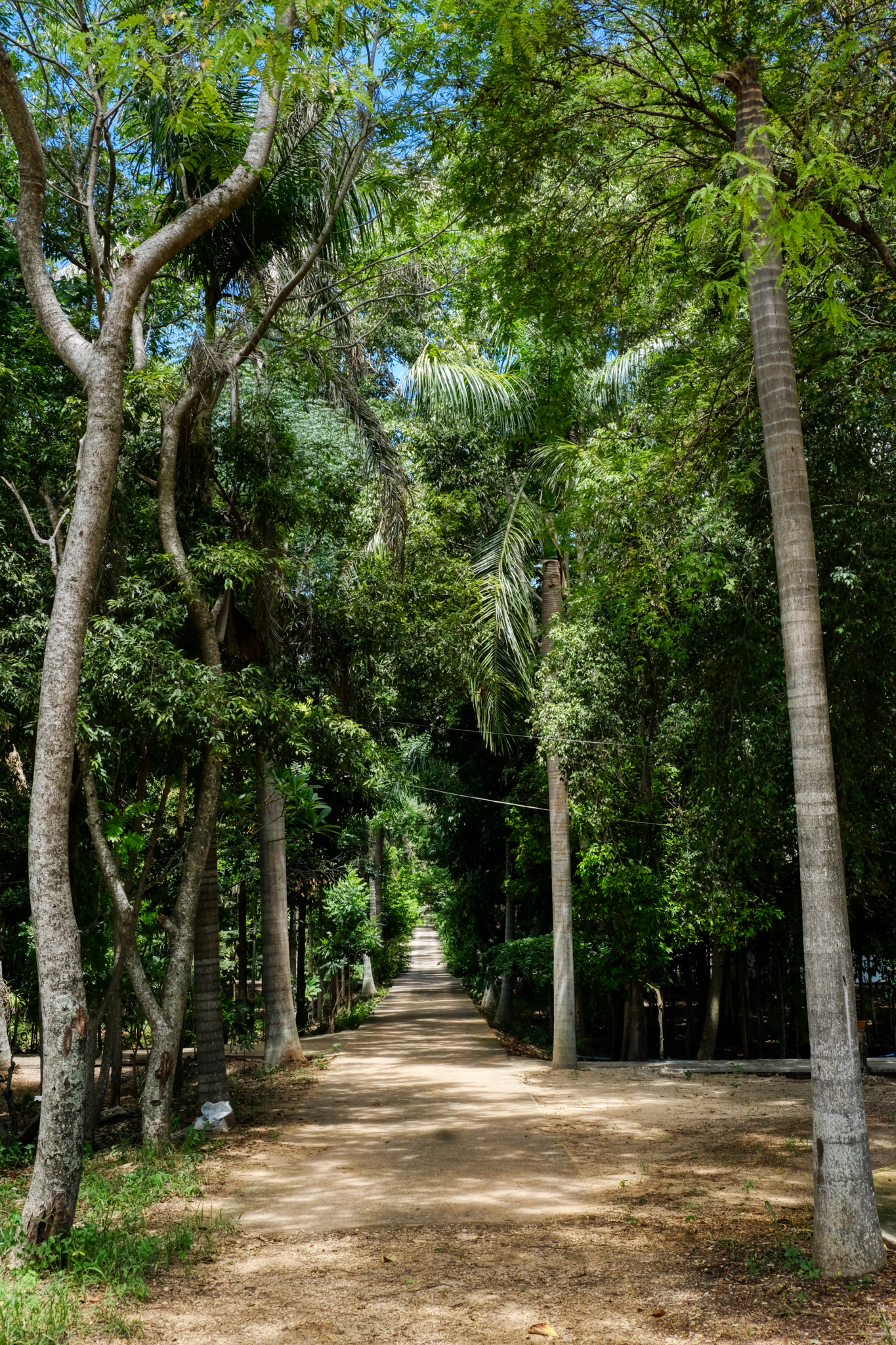 I walked back down the wooded land past the many monks cabins.
I walked back down the wooded land past the many monks cabins.
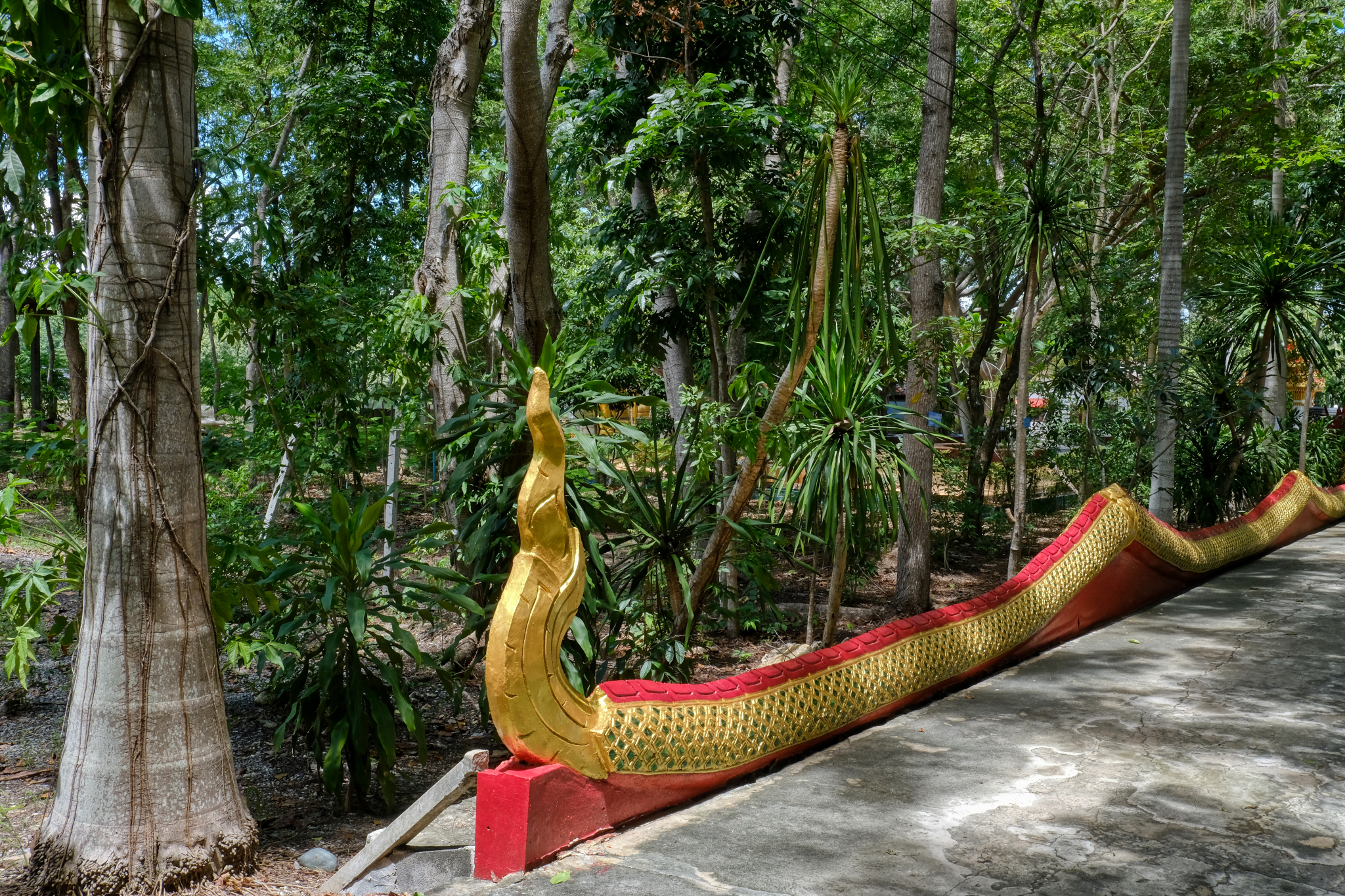 On the way back down I stopped at the tail of the many-headed dragon-snake that had welcomed me when I started up the hill.
On the way back down I stopped at the tail of the many-headed dragon-snake that had welcomed me when I started up the hill.
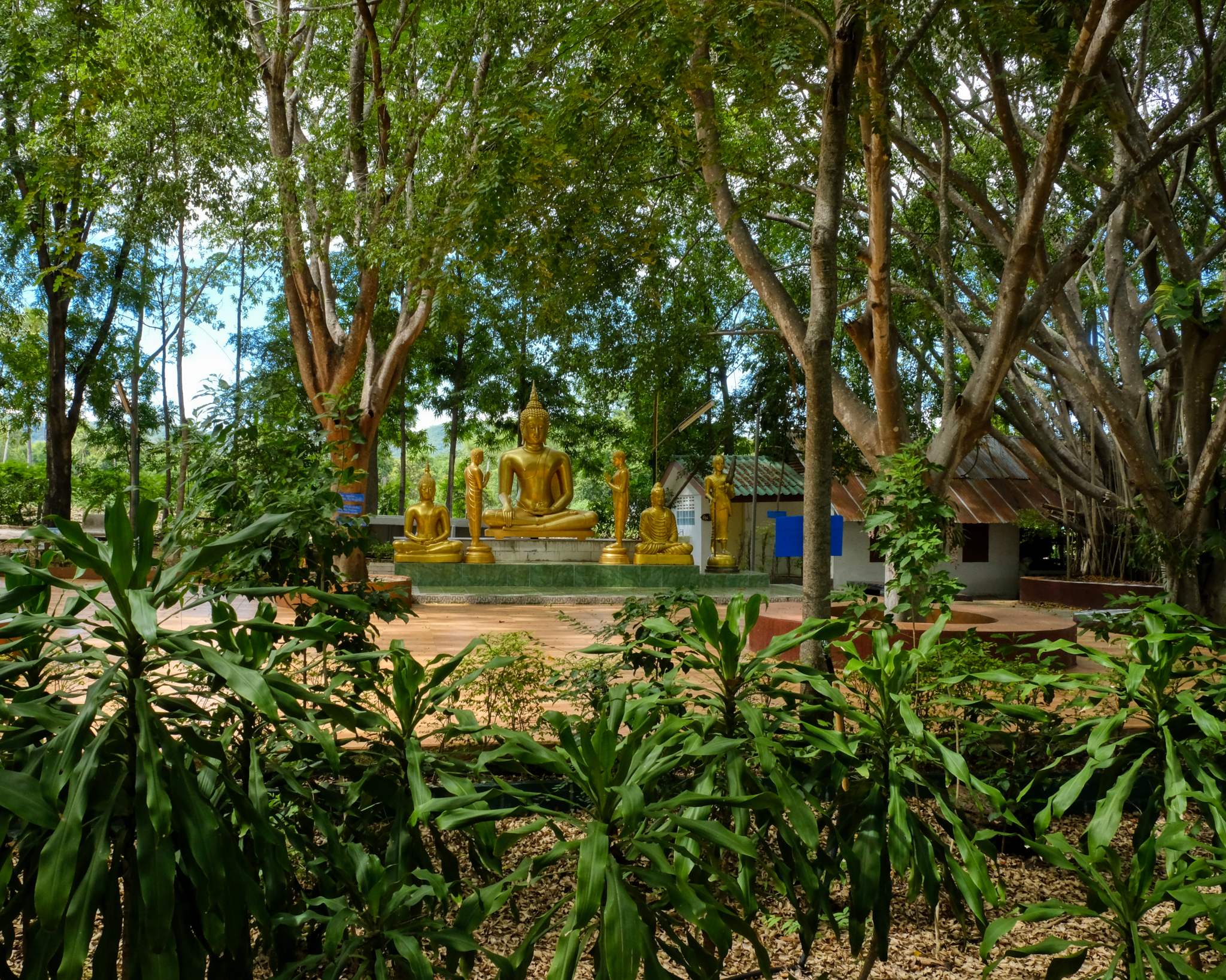 Back where I started, at the tree sheltered Buddha altar.
Back where I started, at the tree sheltered Buddha altar.
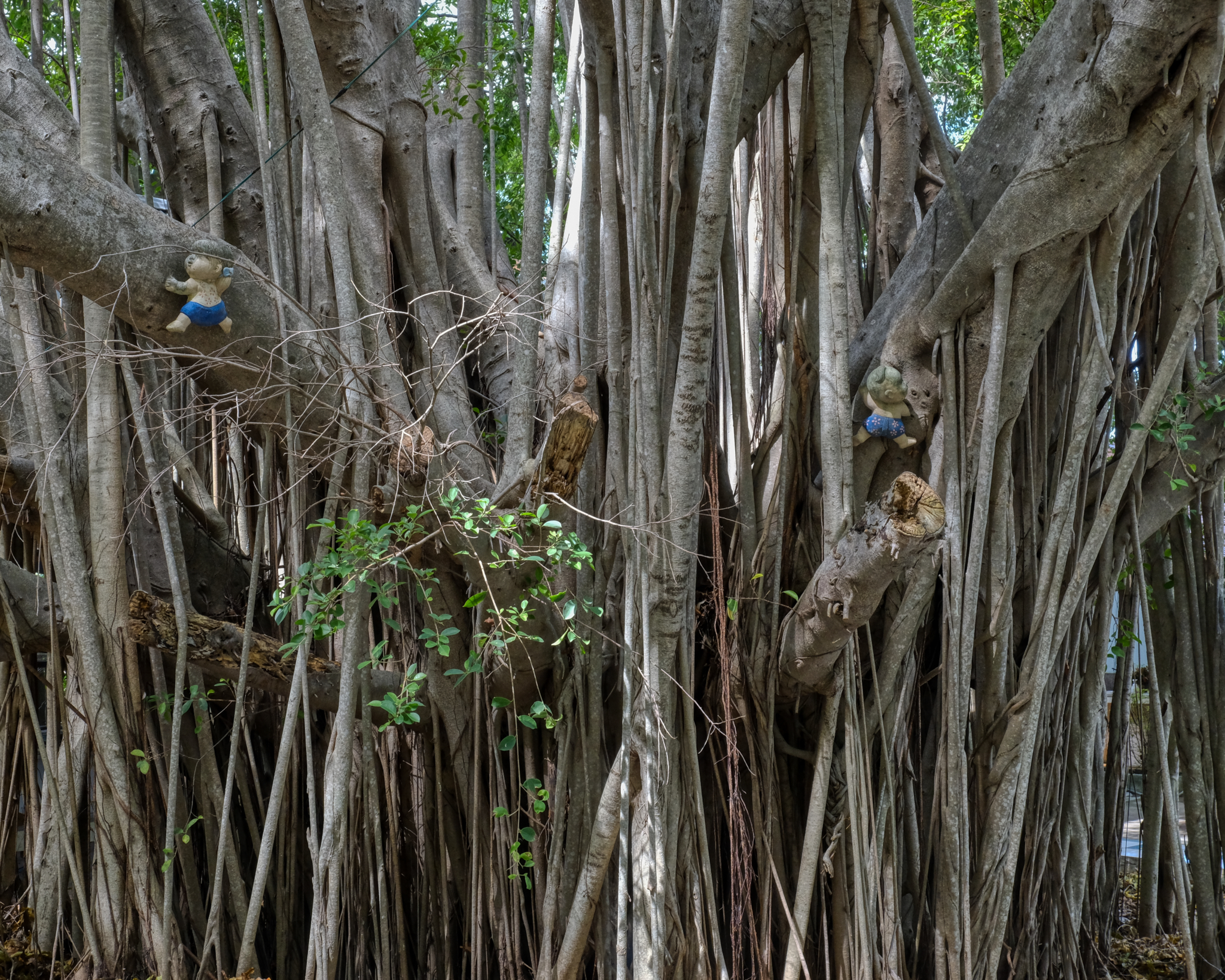 Extraordinary 'bodi' trees at this wat.
Extraordinary 'bodi' trees at this wat.
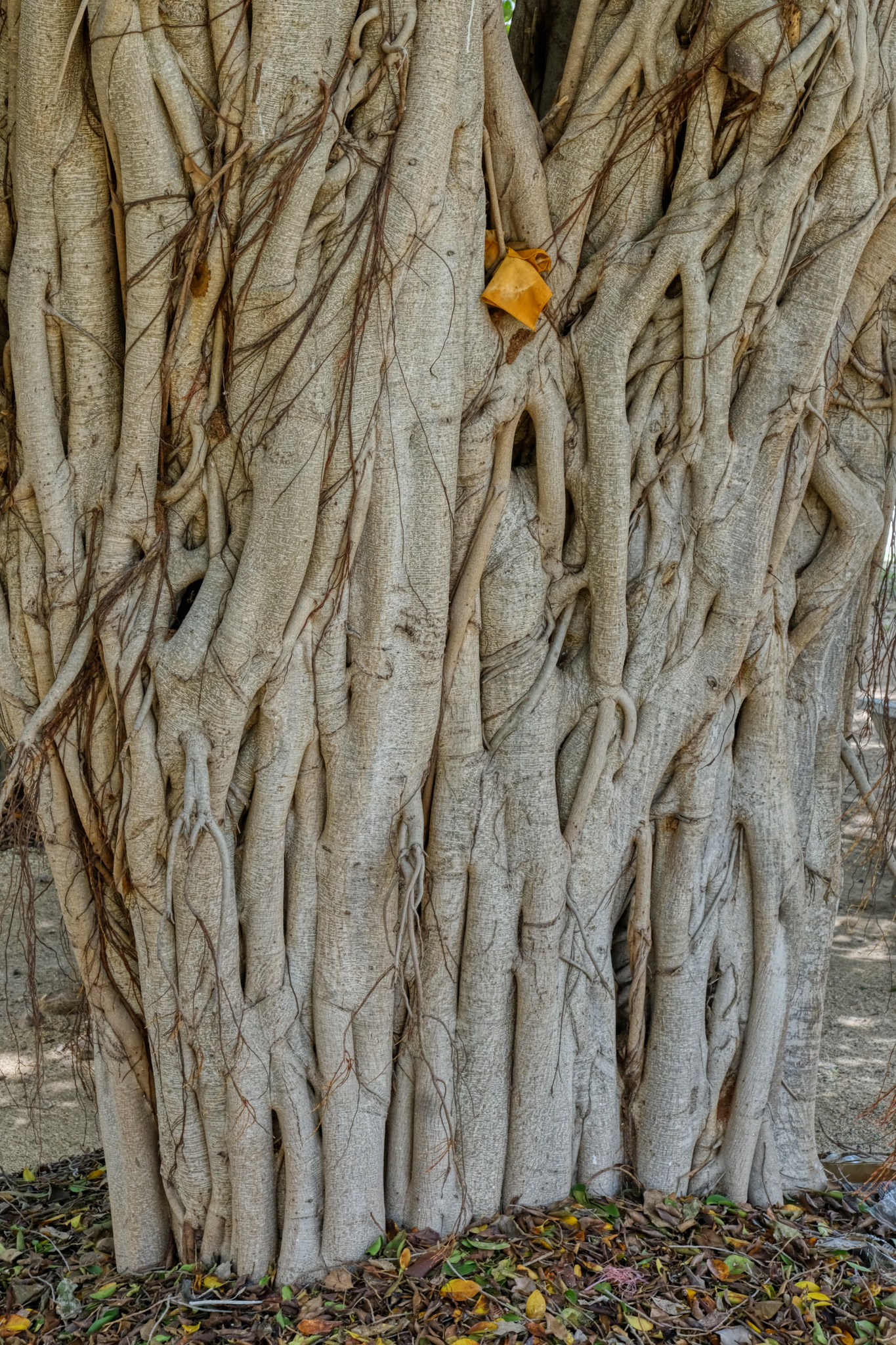 These trees!!!
These trees!!!
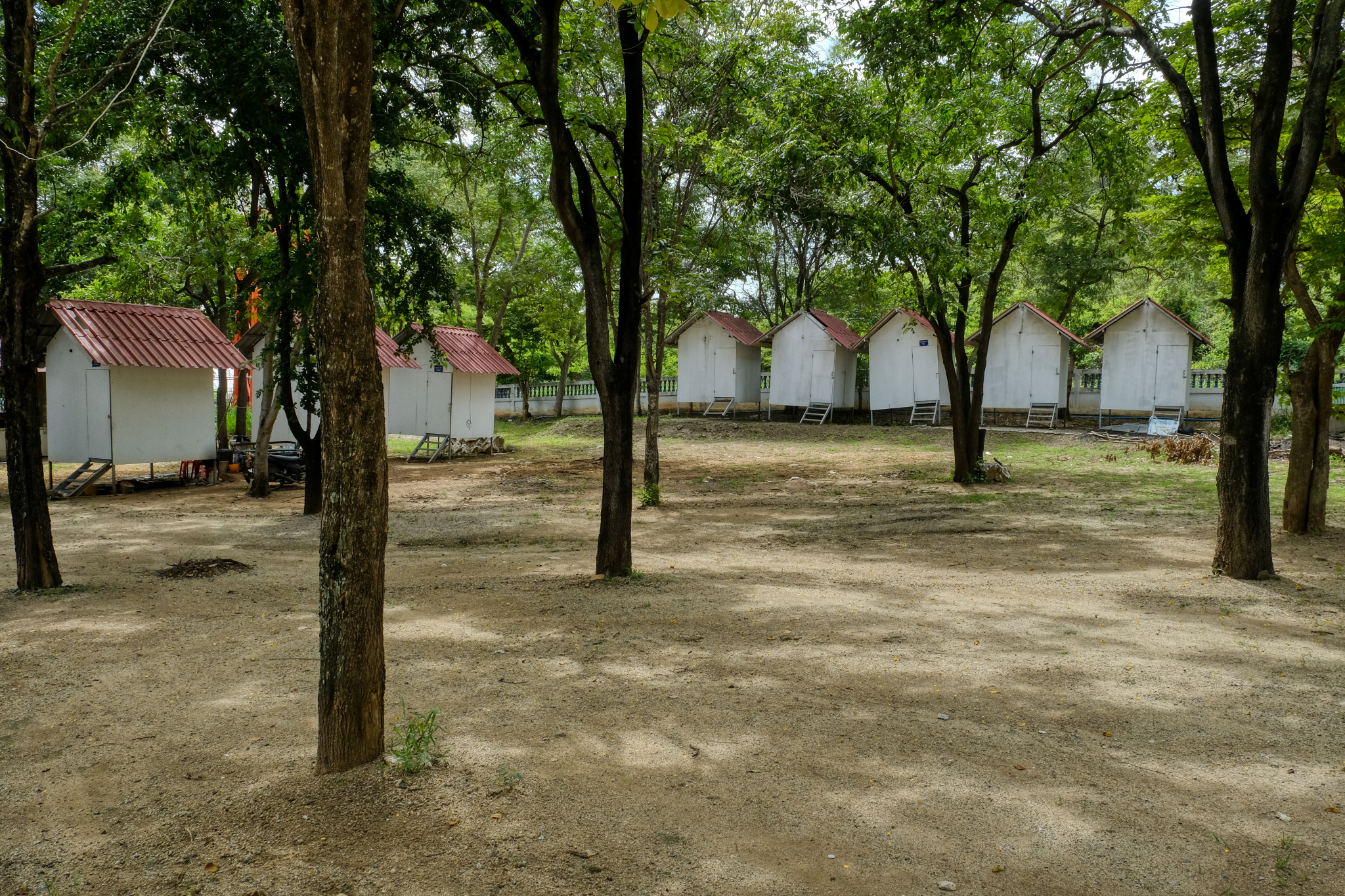 I strolled around the rest of the temple grounds and came upon these monks' cells. I assume this was a wat that took in novice/new monks and trained them here. Very austere . . .
I strolled around the rest of the temple grounds and came upon these monks' cells. I assume this was a wat that took in novice/new monks and trained them here. Very austere . . .
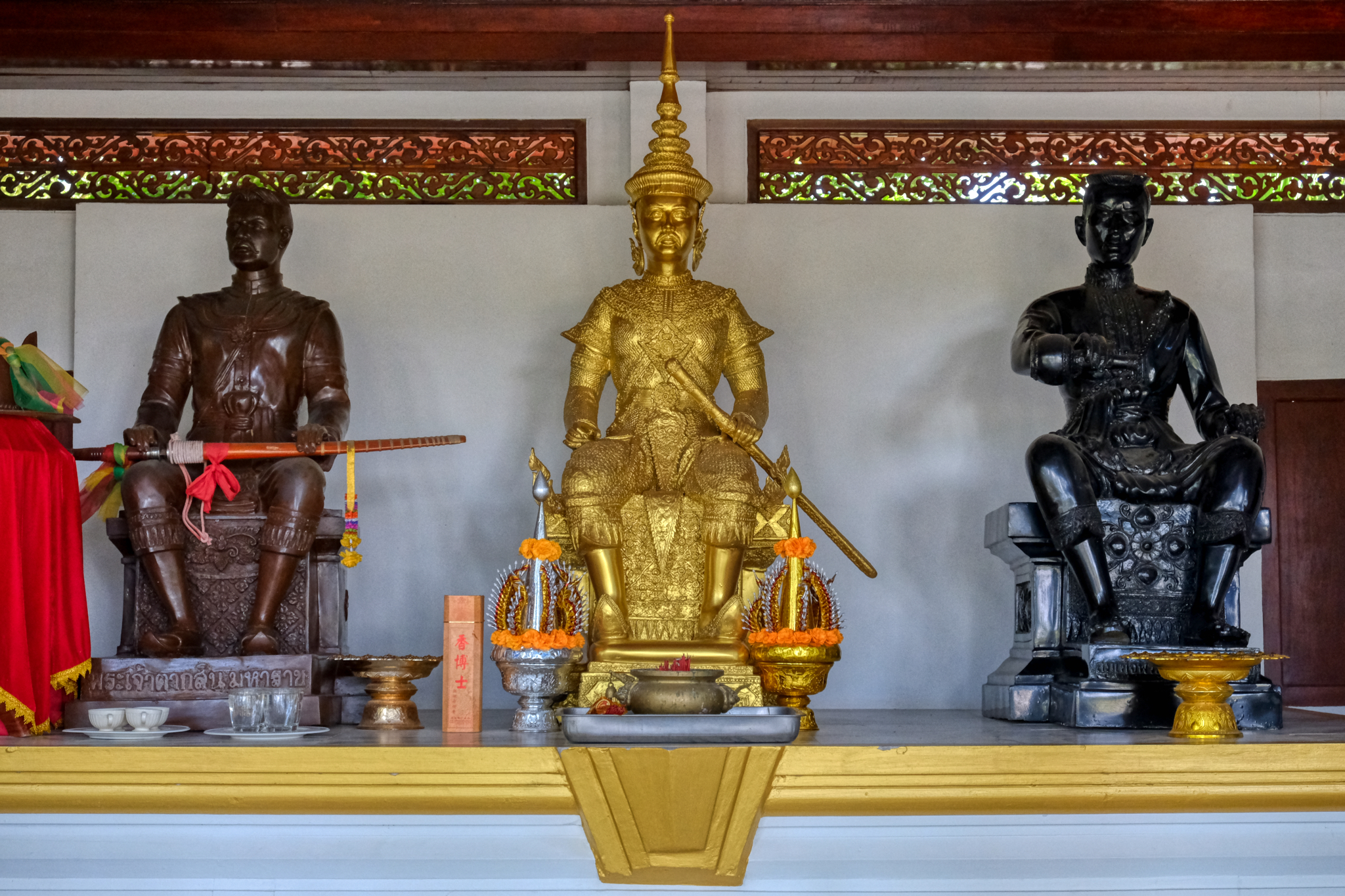 Someone had built a very nice sala with statues of three ancient Thai Kings. Sweet.
Someone had built a very nice sala with statues of three ancient Thai Kings. Sweet.
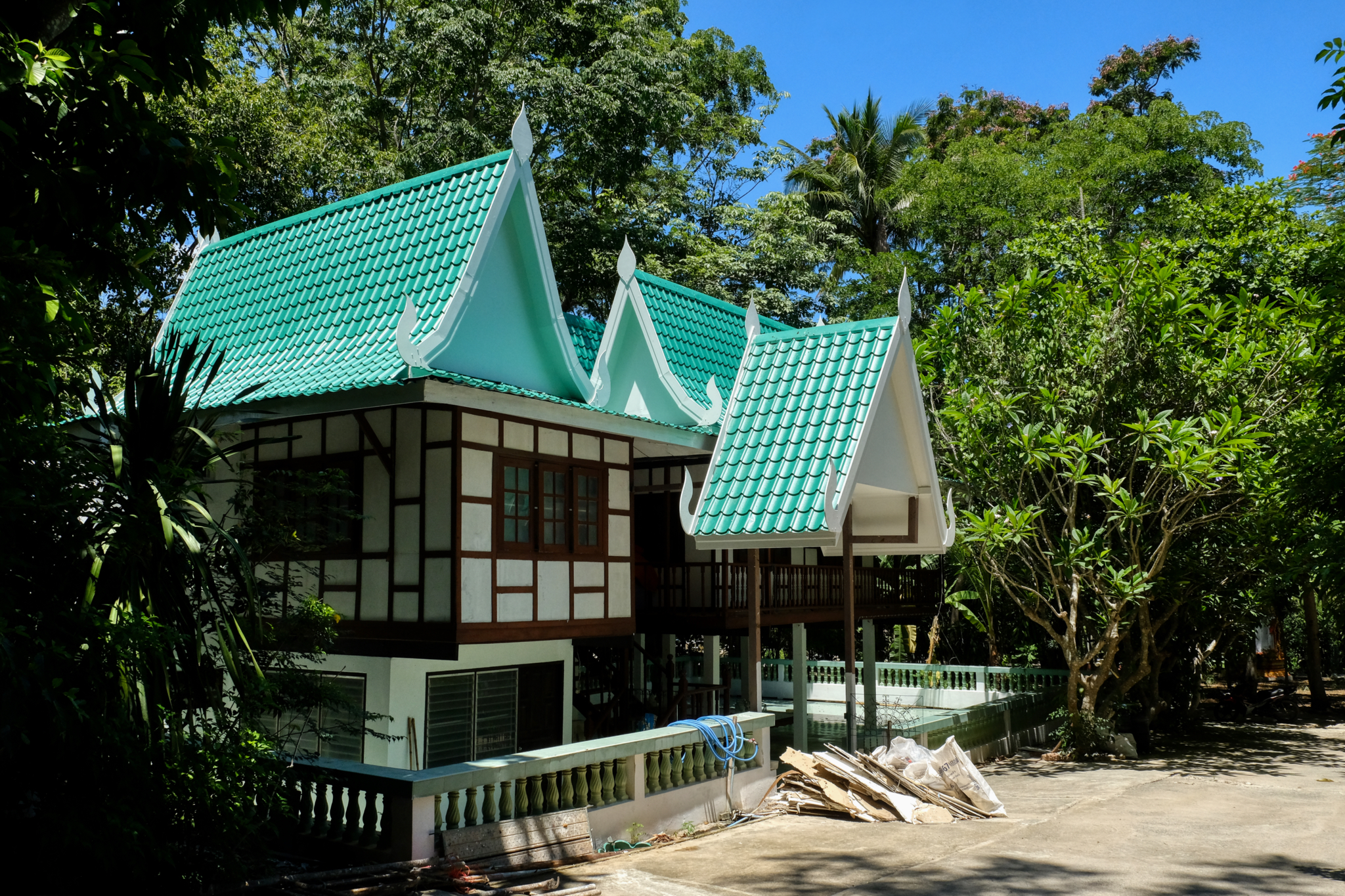 What I assumed to be the head Abbot's house getting the finishing touches on a new roof.
What I assumed to be the head Abbot's house getting the finishing touches on a new roof.
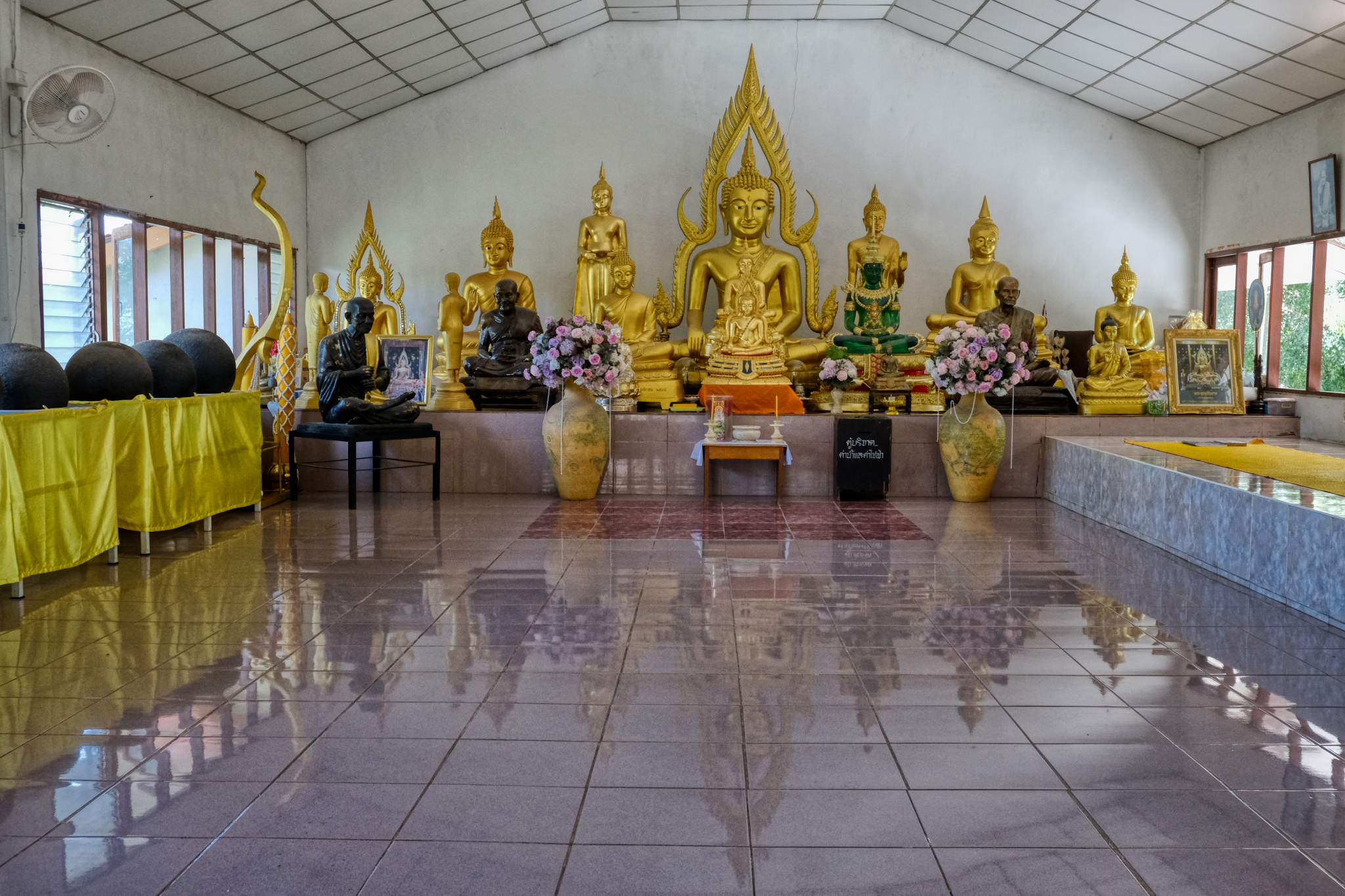 The current main hall where the monks daily meet to meditate and chant. The door was open and I went in. I had been looking for the donation box and I found it here. I left a substantial donation toward the construction and maintenance of this wonderful place.
The current main hall where the monks daily meet to meditate and chant. The door was open and I went in. I had been looking for the donation box and I found it here. I left a substantial donation toward the construction and maintenance of this wonderful place.
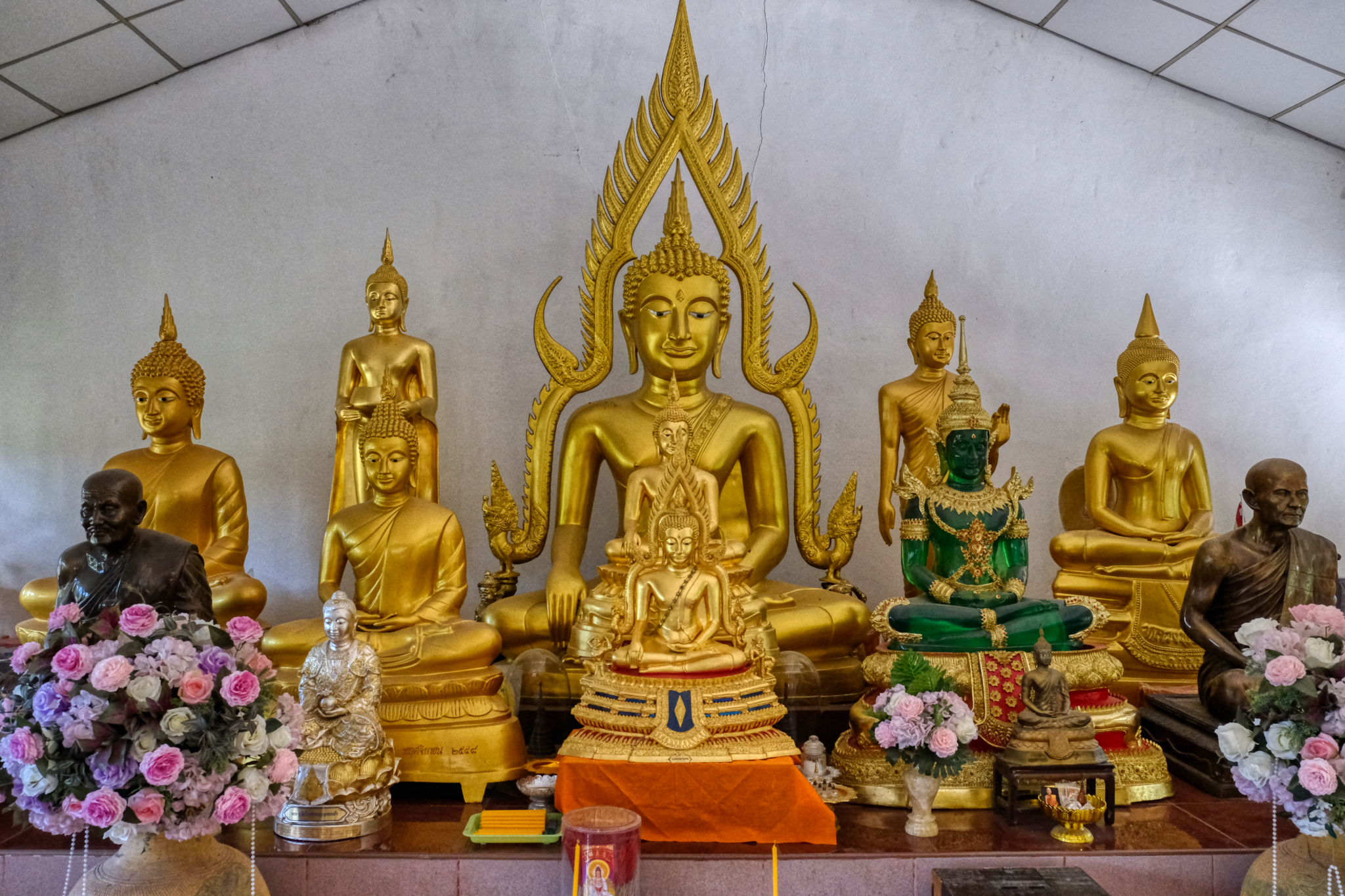 I left this wat after many hours exploring its beauty and spirituality.
I left this wat after many hours exploring its beauty and spirituality.
